- Things To Do
- Entertainment
- Food Travel
- Travel Tips
- Travel News
- Packing Tips

Three Passes Packing List – What You Need For The Three Passes & EBC Trek
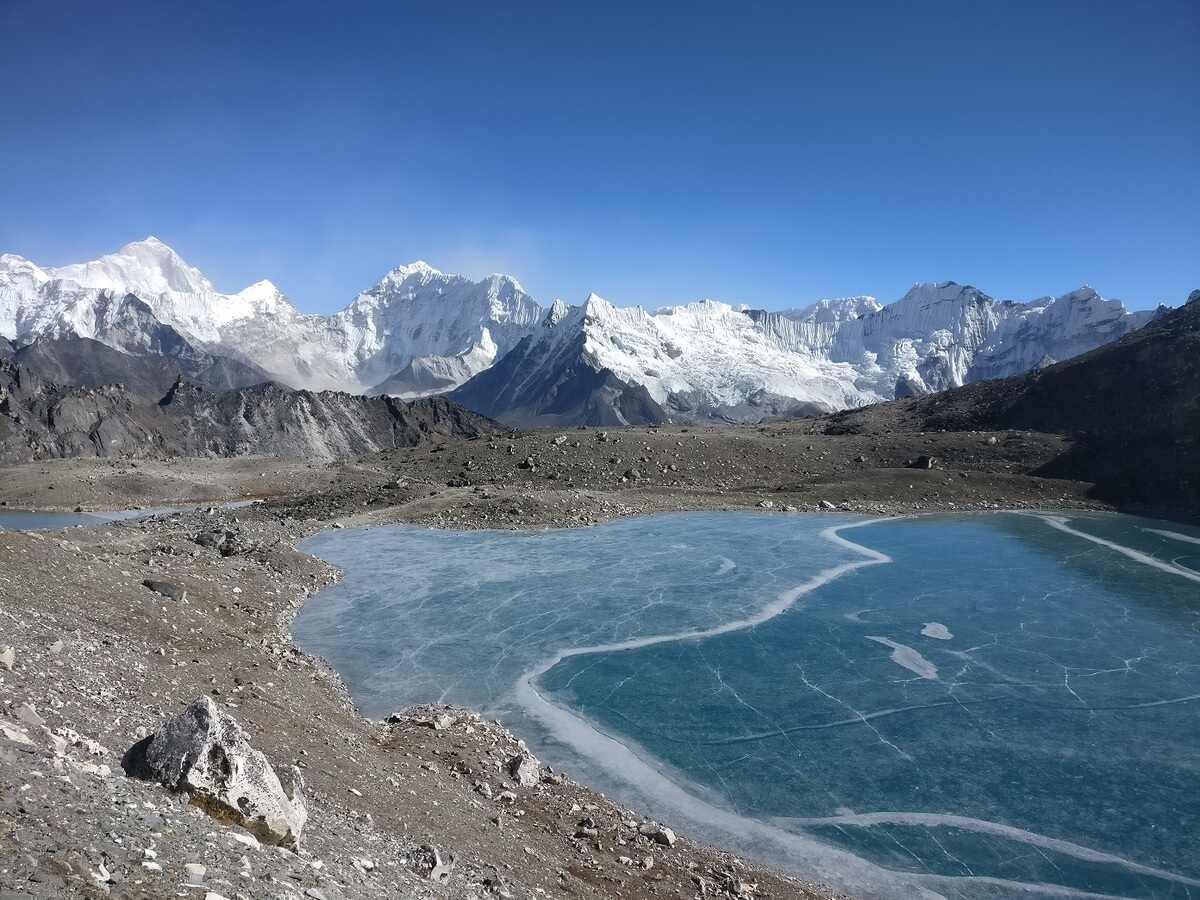
Introduction
The Three Passes trek in the Everest region of Nepal is a challenging and rewarding adventure that takes you through some of the most stunning landscapes on the planet. This trek combines the classic Everest Base Camp route with three high passes – Kongma La Pass, Cho La Pass, and Renjo La Pass, offering breathtaking views of the Himalayas and a true sense of achievement.
As you embark on this epic journey, it’s crucial to be well-prepared and pack wisely to ensure your safety, comfort, and convenience throughout the trek. This comprehensive packing list will guide you on what essential gear and equipment you’ll need, as well as providing some optional items that can enhance your overall experience.
Keep in mind that the packing list may vary depending on the time of year you plan to undertake the trek, as well as your personal preferences. It’s always a good idea to check with your trekking company or tour operator for any specific recommendations they may have.
Now, let’s dive into the essential gear and items you’ll need for a successful Three Passes and Everest Base Camp trek.
Essential Gear
When it comes to essential gear for the Three Passes and Everest Base Camp trek, it’s important to prioritize functionality, durability, and weight. Here are some key items you should include in your packing list:
- Trekking Boots: Invest in a good pair of sturdy, waterproof, and well-fitting trekking boots. They will provide the necessary support and protection for the challenging terrain.
- Backpack: Opt for a backpack with a capacity of around 60-70 liters for carrying your clothes, gear, and other essentials. Make sure it has a comfortable hip belt and adjustable straps.
- Sleeping Bag: Choose a high-quality sleeping bag that is rated to withstand low temperatures. It’s essential for a good night’s sleep during the cold nights in the mountains.
- Layered Clothing: Pack a combination of lightweight and warm clothing to handle the varying temperatures and weather conditions. Include base layers, mid-layers, fleece jackets, and a waterproof shell.
- Headlamp: A headlamp is crucial for navigating during early morning starts, late evenings, and in case of power outages. Don’t forget to bring extra batteries.
- Trekking Poles: Trekking poles provide stability and reduce the strain on your knees during steep descents and challenging ascents. They are especially useful while crossing the high passes.
- Water Bottles: Carry at least two water bottles with a total capacity of 2-3 liters. Staying hydrated is vital during the trek, so consider using a water bladder for easy access to water.
- Sunglasses, Hat, and Sunscreen: Protect yourself from the harsh sun rays with sunglasses, a broad-brimmed hat, and sunscreen with a high SPF.
- First Aid Kit: A basic first aid kit is essential for any trek. Include band-aids, blister pads, pain relievers, antiseptic creams, and any personal medications.
- Snacks and Energy Bars: Keep yourself fueled and energized with lightweight snacks such as nuts, energy bars, chocolate, and dried fruits.
Remember, packing light is key to a comfortable trek. Try to minimize unnecessary items and focus on essentials that will contribute to your safety and well-being during the journey.
Choosing the right clothing for the Three Passes and Everest Base Camp trek is crucial for both comfort and protection from the elements. Here are some essentials to consider when packing your clothing:
- Base Layers: Pack lightweight, moisture-wicking base layers that can help regulate your body temperature. Long-sleeved tops and bottoms made of merino wool or synthetic materials work best.
- Mid-Layers: Include fleece or down jackets for added insulation during colder parts of the trek. These layers can be easily added or removed as the temperature changes throughout the day.
- Insulated Jacket: Bring a warm, insulated jacket or a down jacket to provide extra warmth during the chilly nights at higher altitudes.
- Hiking Pants: Opt for quick-drying, durable hiking pants that offer zip-off or roll-up options for versatility in changing weather conditions.
- Waterproof Shell: A waterproof and windproof jacket and pants are essential to protect you from rain, snow, and wind.
- Headwear: Pack a warm beanie or hat for colder temperatures, as well as a lightweight hat or cap for sun protection during sunny days.
- Gloves: Insulated, waterproof gloves are a must for protecting your hands from the cold. Consider bringing a lightweight pair of liner gloves for added warmth.
- Socks: Pack several pairs of moisture-wicking and comfortable hiking socks to prevent blisters. Merino wool or synthetic blend socks are recommended.
- Gaiters: Gaiters are useful for keeping snow, rocks, and debris out of your boots, particularly when crossing snowy or muddy terrains.
- Swimwear: If you plan to take a dip in the hot springs along the trek, don’t forget to pack a swimsuit or trunks.
Remember to layer your clothing to adjust to the changing temperatures and weather conditions. This allows for easy adaptation and ensures you stay comfortable throughout your journey.
Choosing the right footwear for the Three Passes and Everest Base Camp trek is crucial for a comfortable and safe trekking experience. Here are some essential footwear options to consider:
- Trekking Boots: Invest in a pair of sturdy and waterproof trekking boots with good ankle support. Make sure they are well broken-in before the trek to prevent blisters and discomfort.
- Comfortable Hiking Shoes: As an alternative to trekking boots, you may consider lightweight hiking shoes if you prefer a more flexible and breathable option for lower elevation walks or when you are not carrying a heavy load.
- Sandals or Camp Shoes: It’s also recommended to pack a pair of comfortable sandals or lightweight shoes to wear around the teahouses and campsites during the evenings, giving your feet a break from boots.
- Extra Socks: Don’t forget to pack extra pairs of moisture-wicking and cushioned hiking socks. Having clean, dry socks to change into can help prevent blisters and keep your feet comfortable.
- Gaiters: Gaiters can be handy for keeping debris, snow, and water out of your boots, especially during snow-covered sections of the trek.
Regardless of the footwear you choose, it’s important to take the time to break them in before the trek to avoid unnecessary discomfort and blisters. Make sure they fit well and provide sufficient support for the rugged terrain you’ll encounter along the way.
Sleeping Gear
Having proper sleeping gear is essential to ensure a comfortable and restful sleep during the Three Passes and Everest Base Camp trek. Here are some essential items to include in your sleeping gear:
- Sleeping Bag: Choose a high-quality sleeping bag that is rated to withstand low temperatures. Look for a bag that can handle temperatures well below freezing, as temperatures can drop significantly during the night at higher elevations.
- Sleeping Mat or Pad: A lightweight and insulating sleeping mat or pad is recommended for added comfort and insulation from the cold ground. Opt for a mat that is compact and easy to carry.
- Pillow or Pillowcase: While some teahouses provide pillows, they may not be as comfortable as you would like. Consider bringing a small inflatable pillow or a pillowcase filled with extra clothing to provide extra comfort and support.
- Sleeping Sheet: A lightweight sleeping sheet can provide an extra layer of cleanliness and warmth, particularly if you prefer a barrier between your sleeping bag and your skin.
It’s important to choose a sleeping bag that suits the weather conditions of your trek. Check the temperature rating and insulation type to determine the most suitable option for the expected temperatures along the trail.
Remember to maintain your sleeping gear properly during the trek, keeping it dry and clean to ensure maximum comfort and longevity.
Backpack and Bags
Choosing the right backpack and bags for the Three Passes and Everest Base Camp trek is essential to ensure you can carry all your gear comfortably and efficiently. Here are some important considerations when it comes to your backpack and bags:
- Trekking Backpack: Opt for a backpack with a capacity of around 60-70 liters to accommodate your clothing, gear, and other essentials. Look for a backpack with adjustable and padded shoulder straps, a hip belt, and multiple compartments for organized packing.
- Daypack: Bring a smaller daypack or backpack with a capacity of 20-30 liters to use for day hikes and excursions from your teahouse. This allows you to carry essentials such as water, snacks, extra layers, and camera gear during shorter trips.
- Duffel Bag: Consider bringing a sturdy duffel bag for your porters to carry during the trek. This allows you to keep your trekking backpack lighter and more comfortable while the bulk of your gear is transported separately.
- Waterproof Bag Cover: It’s wise to invest in a waterproof cover or liner for your backpack to protect your gear from rain and snow. Alternatively, you can use large plastic bags to keep your belongings dry.
- Compression Sacks and Packing Cubes: Utilize compression sacks or packing cubes to organize and compress your clothing and gear, making it easier to fit everything in your backpack while keeping it organized and accessible.
- Travel Locks: Bring travel locks to secure your backpack and duffel bag when they are not in your sight. This adds an extra layer of security for your belongings during the trek and while in teahouses or lodges.
When packing your backpack, prioritize heavier items at the bottom and closer to your back for better weight distribution. Keep frequently used items in easy-to-reach compartments for convenience.
Remember to pack smart and efficiently, only bringing essential items and considering the weight and size limitations set by your trekking company or tour operator.
Trekking Poles
Trekking poles are invaluable companions for the Three Passes and Everest Base Camp trek, providing stability, balance, and support on challenging terrains. Here’s why you should consider including trekking poles in your gear list:
Improved Stability: The uneven and sometimes slippery trails of the Everest region can be demanding, especially while ascending or descending steep sections. Trekking poles help distribute your weight, increase stability, and reduce the strain on your legs and knees, making it easier to navigate the terrain.
Reduced Impact: By using trekking poles, you can lessen the impact on your joints during descents. The poles come in handy, especially when going downhill on rocky or uneven surfaces, by providing additional points of contact with the ground.
Enhanced Uphill Support: During steep ascents, trekking poles allow you to engage your upper body muscles, sharing the workload and providing a boost of power. They can help push you forward, making uphill climbs more manageable and efficient.
Balance on River Crossings: In the Everest region, you will encounter numerous river crossings on suspension bridges. Trekking poles help maintain balance and stability while navigating these crossings, especially when the bridges sway or are slippery.
Extra Support on Snowy Sections: When crossing snowy or icy terrain, trekking poles provide added support and stability. They can help you test the stability of the snow or locate hidden hazards beneath the surface, allowing for safer passage.
When choosing trekking poles, look for lightweight and adjustable options that suit your height and hiking style. If possible, opt for poles with shock-absorbing mechanisms to reduce strain on your wrists and elbows.
Remember to use the wrist straps properly, allowing your wrists and hands to relax while the straps provide additional security. Adjust the pole length according to the gradient of the terrain, and always keep the poles planted firmly on the ground.
Trekking poles can significantly enhance your trekking experience, providing support and stability in challenging conditions. Don’t overlook their value when preparing for the Three Passes and Everest Base Camp trek.
First Aid Kit
A well-stocked and readily accessible first aid kit is an essential component of your gear for the Three Passes and Everest Base Camp trek. While it’s essential to bring a comprehensive first aid kit, it’s also important to have basic knowledge of first aid to address minor injuries and illnesses. Here’s what your first aid kit should include:
- Medications: Carry a supply of common medications such as pain relievers, anti-diarrhea medication, antihistamines, and altitude sickness medication. Consult your healthcare provider for specific recommendations.
- Band-Aids and Bandages: Bring assorted sizes of adhesive bandages for minor cuts, blisters, and abrasions. Include sterile gauze pads and adhesive tape for larger wounds.
- Blister Treatment: Pack moleskin or blister patches to provide relief and protection for blisters. Additionally, include antiseptic ointments and alcohol wipes for wound cleaning.
- Tweezers and Scissors: These tools are handy for removing splinters, cutting tape or bandages, and other minor medical procedures.
- Sterile Gloves: Pack a pair or two of sterile gloves to protect yourself and others when administering first aid.
- Thermometer: A lightweight and digital thermometer is useful for monitoring fever or illness symptoms.
- Personal Medications: If you have any pre-existing medical conditions or require specific medications, ensure you bring an ample supply and keep them in an easily accessible and waterproof container.
It’s essential to familiarize yourself with the contents of your first aid kit and how to use them properly. Consider taking a basic first aid course before your trek to increase your preparedness and confidence in emergency situations.
Remember to regularly check and restock your first aid kit, removing expired medications and replenishing used supplies.
While a first aid kit is crucial, prevention is key. Take necessary precautions to minimize the risk of injury or illness, such as staying hydrated, wearing appropriate gear, practicing good hygiene, and trekking at a reasonable pace.
Hydration and Water Treatment
Staying hydrated is crucial during the Three Passes and Everest Base Camp trek, as proper hydration helps maintain energy levels, prevent altitude sickness, and support overall well-being. Here are some essential tips for maintaining hydration:
- Water Bottles: Carry at least two water bottles with a total capacity of 2-3 liters. Look for lightweight and durable bottles that are easy to refill and have leak-proof features.
- Water Bladder: Consider using a hydration bladder with a drinking tube for easy access to water while on the move. It can be conveniently stored in your backpack and allows you to stay hydrated without having to stop and retrieve your water bottle.
- Water Treatment: While water sources are abundant along the trek, it’s crucial to treat the water before consumption to avoid waterborne illnesses. Options for water treatment include water purification tablets, water filters, or portable water purifiers.
- Steripen or UV Sterilizer: Steripen or UV sterilizers use ultraviolet light to kill waterborne bacteria and viruses. These compact devices are easy to use and can provide safe drinking water in as little as 90 seconds.
- Water Purification Tablets: Carry water purification tablets as a backup option for treating water. Follow the instructions on the packaging for proper dosage and wait time.
- Boiled Water: The tea houses along the trail offer boiled water, which is generally safe to drink. However, it’s still recommended to treat it with water purification tablets or a UV sterilizer to ensure complete safety.
Remember to drink water frequently, even if you don’t feel thirsty, to stay properly hydrated. Avoid drinking untreated water from streams or sources that may be contaminated.
Additionally, to support your hydration efforts, consume electrolyte-rich beverages, such as sports drinks or electrolyte powders, to replenish essential minerals lost through sweat.
By prioritizing hydration and treating your water properly, you can minimize the risk of waterborne illnesses and ensure a healthier and more enjoyable trekking experience.
Personal Care Items
Personal care items are essential for maintaining hygiene and comfort during the Three Passes and Everest Base Camp trek. Here are some personal care items to include in your packing list:
- Toiletries: Pack travel-sized essentials such as toothbrush, toothpaste, soap, shampoo, and a small towel or washcloth. Consider biodegradable options to minimize the impact on the environment.
- Hand Sanitizer: Carry a small bottle of hand sanitizer for sanitizing your hands when water and soap are not readily available. It’s important to maintain good hand hygiene to prevent illnesses.
- Wet Wipes: These can be useful for freshening up, wiping your face, or cleaning your hands in between washes. Opt for biodegradable wipes to minimize environmental impact.
- Toilet Paper: Carry a small roll of toilet paper in a waterproof bag. While teahouses along the trail generally provide toilet paper, it’s always a good idea to have some backup for emergencies.
- Sunscreen and Lip Balm: Protect your skin and lips from the intense mountain sun with a high SPF sunscreen and a moisturizing lip balm. Choose products that are water-resistant and offer broad-spectrum protection.
- Insect Repellent: Depending on the time of year and location, insects can be a nuisance. Bring a reliable insect repellent to protect yourself from mosquitoes and other biting insects.
- Personal Medications: If you take any regular medications, ensure you have an ample supply for the duration of your trek. Keep them in a waterproof container and easily accessible.
- Menstrual Products: If applicable, pack an adequate supply of menstrual products. Consider environmentally friendly options such as menstrual cups or reusable pads.
- Extra Eyeglasses or Contact Lenses: If you wear glasses or contact lenses, bring an extra pair in case of loss or damage during the trek.
Remember to store your personal care items in waterproof bags or pouches to protect them from moisture and potential leakage.
While it’s essential to prioritize lightweight packing, personal care items are crucial for your well-being and comfort during the trek. Tailor your selection based on your specific needs, and consider the environmental impact of the products you choose.
Electronics and Communication
While you’ll be disconnected from the bustling digital world during the Three Passes and Everest Base Camp trek, some electronics and communication devices are still essential for safety and convenience. Here are some electronics to consider when preparing for the trek:
- Mobile Phone: Bringing a mobile phone can be handy for emergency communication. While network coverage may be limited along the trail, it’s still worth carrying a fully charged phone with important numbers saved.
- Portable Power Bank: Ensure you have a reliable power bank to charge your electronic devices on the go. Consider one with a high capacity to meet your power needs throughout the trek.
- Camera and Spare Batteries: Capture the stunning landscapes with a lightweight and durable camera. Make sure to bring spare batteries or a portable charger to keep your camera charged throughout the trek.
- Headlamp or Flashlight: Trekking in the dark is sometimes necessary, especially during early morning starts or evening hikes. Bring a headlamp or flashlight with extra batteries to light your way.
- Portable Bluetooth Speaker: If you enjoy some music during your downtime, a small and portable Bluetooth speaker can add entertainment to your evenings at the teahouses. Be mindful of others and keep the volume low.
- Adapters and Converters: If you plan to charge your devices in teahouses, you may need plug adapters and voltage converters, as the electrical outlets may have different configurations and voltage levels.
While electronics can enhance your experience, it’s important to use them sparingly and be mindful of the impact on the environment and other trekkers. Respect quiet zones and prioritize immersion in nature.
Additionally, protect your electronic devices by storing them in waterproof and shockproof cases or bags to safeguard them from the elements.
Remember that the focus of the trek is the natural beauty and the experience of being present in the mountains. Balance your use of electronics to ensure they enhance rather than overshadow your connection to the environment and your fellow trekkers.
Navigation Tools
Proper navigation tools are essential for the Three Passes and Everest Base Camp trek, as it’s important to stay on the right path and avoid getting lost. Here are some navigation tools to consider including in your gear:
- Trail Map or Guidebook: Carry a detailed trail map or a guidebook specifically designed for the Everest region. These resources provide valuable information on the trail, landmarks, elevation profiles, and important points of interest.
- Compass: While the trails along the route are well-marked, having a compass can help you orient yourself and provide a sense of direction if needed.
- GPS Device or Smartphone App: Consider using a GPS device or downloadable smartphone app that provides accurate tracking and mapping of your trek. These tools can help you stay on track and monitor your progress along the trail.
- Whistle: Bring a whistle to signal for help in case of an emergency. It is a lightweight and effective tool for attracting attention and alerting others to your presence.
- Extra Batteries and Chargers: Ensure you have extra batteries and chargers for your navigation devices. It’s crucial to keep them powered up to avoid running out of battery while on the trail.
Familiarize yourself with the use of these navigation tools before your trek to ensure you can use them effectively. Study the map and the trail details to have a general understanding of the route and the key landmarks you’ll encounter.
It’s important to note that weather conditions and terrain can be unpredictable, so it’s always a good idea to rely on multiple navigation tools and have backup plans in case of unexpected circumstances.
Remember, proper navigation tools provide peace of mind and ensure you stay on track in the vast and beautiful landscapes of the Everest region.
Food and Snacks
Proper nutrition is crucial for maintaining energy levels and staying fueled during the Three Passes and Everest Base Camp trek. While teahouses along the trail provide meals, it’s also important to carry some of your own food and snacks. Here are some considerations for your food and snack choices:
- Energy Bars and Granola Bars: Pack a variety of energy bars and granola bars to provide quick and convenient fuel during the trek. Look for options that are high in carbohydrates and healthy fats to sustain your energy levels.
- Nuts and Dried Fruits: Nuts, such as almonds, cashews, and walnuts, are excellent sources of protein and healthy fats. Dried fruits like raisins, apricots, and mangoes provide natural sugars and essential nutrients.
- Chocolate and Candy: A small stash of chocolate or candy can provide a quick energy boost and a much-needed morale boost during challenging sections of the trek.
- Snack Packs: Consider pre-packaged snack packs that include a combination of nuts, dried fruits, and seeds. These packs provide a mix of nutrients and are convenient for on-the-go snacking.
- Peanut Butter or Nut Butter: Bring small packets of peanut butter or other nut butter, which are rich in protein and healthy fats. They can be spread on crackers or bread for a satisfying and nutritious snack.
- Rehydration Powders or Electrolyte Drinks: Consider bringing rehydration powders or electrolyte drink mixes to replenish essential minerals lost through sweating. These are especially important for strenuous sections or high-altitude trekking.
While teahouses and lodges along the trail provide meals, having some of your own food and snacks ensures you have options that suit your preferences and dietary needs. It’s important to maintain a balanced diet and consume enough calories to support your energy demands during the trek.
Remember to pack your food and snacks in sealed, waterproof bags to protect them from moisture and potential damage.
Keep in mind that it’s crucial to respect the environment and avoid littering. Dispose of your food packaging properly and leave no trace behind.
By strategically choosing food and snacks that provide sustained energy and nourishment, you’ll be well-prepared to tackle the challenges of the Three Passes and Everest Base Camp trek.
Miscellaneous Items
Aside from the essential gear and equipment, there are several miscellaneous items that can enhance your overall trekking experience on the Three Passes and Everest Base Camp trek. Consider including these miscellaneous items in your packing list:
- Trekking Watch or Altimeter: A watch with altimeter capabilities or a dedicated altimeter can help you track your elevation gain, monitor your ascent rate, and estimate your position along the trail.
- Reusable Water Bottle with Filter: To reduce your environmental impact and ensure access to safe drinking water, bring a reusable water bottle with a built-in filter. This allows you to refill your bottle from natural water sources along the trek.
- Portable Solar Charger: A lightweight and portable solar charger can be a handy backup for charging your electronic devices when there is no access to electrical outlets. It harnesses the power of the sun to keep your devices powered up.
- Multi-tool or Swiss Army Knife: A versatile multi-tool or Swiss Army knife can come in handy for various tasks such as cutting, opening cans, repairing gear, and more. Make sure it has essential tools like a knife, scissors, screwdriver, and bottle opener.
- Portable Clothesline: A compact and portable clothesline allows you to hang wet clothes or towels to dry after washing. It can be easily hung between trees or in your room at the teahouse.
- Journal and Pen: A journal and pen can be a meaningful way to document your journey, capture memories, and reflect on your experiences along the trail.
- Trekking Towel: A quick-drying and lightweight trekking towel can be useful for drying off after a shower, wiping away sweat, or as an extra layer of insulation while sleeping.
- Extra Cash: While most teahouses accept cash, it’s always a good idea to carry some extra cash for unexpected expenses, tips, or purchases along the way.
These miscellaneous items can add convenience, functionality, and practicality to your trekking experience. However, it’s important to pack only what you truly need to keep your backpack lightweight and manageable.
Before heading out on your trek, double-check your packing list to ensure you have included these important miscellaneous items that can enhance your comfort and preparedness along the Three Passes and Everest Base Camp trail.
Optional Gear
In addition to the essential gear, there are a few optional items that you may consider including in your packing list for the Three Passes and Everest Base Camp trek. These items can enhance your comfort and convenience based on your personal preferences and specific needs:
- Trekking Gaiters: Gaiters provide added protection to your lower legs and boots, shielding them from snow, water, and debris. They can be particularly useful during snowy or muddy sections of the trail.
- Down Jacket: While many teahouses provide blankets and thick comforters, having a warm down jacket can add an extra layer of insulation during chilly evenings and higher elevations.
- Buff or Neck Gaiter: A versatile and lightweight buff or neck gaiter can be used as a scarf, headband, or face mask to protect against cold temperatures, wind, and dust.
- Portable Bluetooth Speaker: If you enjoy music while trekking or want to share your favorite tunes with your fellow trekkers, a small and portable Bluetooth speaker can add some entertainment to your evenings at the teahouses.
- Travel Pillow: If you value extra comfort during your rest breaks or while traveling, a compact travel pillow can provide neck and head support during long journeys.
- Binoculars: If you’re a nature enthusiast or wildlife lover, a pair of lightweight binoculars can allow you to appreciate the breathtaking mountain vistas and spot rare bird species along the trail.
- Earplugs and Eye Mask: If you’re a light sleeper or sensitive to noise and light, earplugs and an eye mask can help you get a more restful sleep in the teahouses, which can be lively and have thin walls.
- Travel Pillowcase: To add a personal touch and maintain hygiene standards, consider bringing a travel-sized pillowcase to cover the provided pillows in teahouses.
While these items are optional, they can add convenience and comfort to your trekking experience. Remember to consider the weight and size of these items, and only bring the ones that align with your preferences and space limitations.
Before deciding on any optional gear, assess your personal needs and preferences while keeping in mind the importance of packing lightly. This will ensure that you have a pleasant and comfortable trekking experience along the Three Passes and Everest Base Camp trail.
Preparing for the Three Passes and Everest Base Camp trek requires careful planning and a well-thought-out packing list. By considering the essential gear, clothing, footwear, and other items discussed in this article, you’ll be equipped to tackle the challenges and embrace the beauty of this remarkable adventure in the Himalayas.
Remember to prioritize functionality, durability, and weight when selecting your gear. Pack clothing suitable for varying temperatures and weather conditions, and invest in reliable trekking boots that provide stability and support. Don’t forget to bring essential items like a sleeping bag, backpack, and first aid kit to ensure your safety and well-being throughout the trek.
Stay hydrated by carrying water bottles and using water treatment methods to ensure safe drinking water along the trail. Pack personal care items to maintain hygiene and comfort, and consider including navigation tools for proper path finding and orientation.
Lastly, it’s important to respect the environment, local customs, and fellow trekkers. Pack out your trash, be mindful of the impact you leave behind, and follow the Leave No Trace principles. Embrace the experience, immerse yourself in the natural beauty of the region, and create memories that will last a lifetime.
As you embark on this incredible journey, remember that this packing list serves as a guide, and it’s important to adapt it to your own preferences and needs. Consult with your trekking company or tour operator for any specific recommendations they may have, and prepare yourself mentally and physically for the challenges ahead.
Enjoy every step of your Three Passes and Everest Base Camp trek and cherish the breathtaking landscapes, the camaraderie with fellow trekkers, and the sense of accomplishment as you conquer the high passes and reach Everest Base Camp. May your journey be filled with adventure, inspiration, and unforgettable memories.
LEAVE A REPLY Cancel reply
Save my name, email, and website in this browser for the next time I comment.
- Privacy Policy
- Advertising
- Affiliate Disclosure

Essential Packing List For EBC And Three Passes Trek (5 Kg ONLY)
Spread the Word!
Everest Base Camp (EBC) Trek! This phrase has excited us for the longest time, and finally, the dream of completing the trek became a reality. The journey was nothing short of fantabulous, and calling it a treat for a trekking enthusiast and an explorer would be an understatement. The mountains, natural habitat, and almost everything about the trek left us mesmerized.
Although the trek was challenging, what came to our rescue were the things we packed. We completed the EBC, Kalapathar, and the three passes trek without any guide or porter. We carried our belongings for the 16-day journey and managed to keep the backpack weighing about 5 Kg without water.
So, if you plan to do the Everest Base Camp and the three passes trek , here’s the complete packing list of items that you must carry. There are a few optional items that we didn’t carry, but you can carry them based on your needs.
Packing List For EBC & Three Passes Trek
Table of Contents
1. Clothes/ Body Gear

- Three breathable underwears
- Three breathable bras (for women): We prefer merino wool underwear and innerwear as they are breathable, odour-resistant, and temperature-regulating.
- A set of thermal wear (top + bottom): Useful while sleeping at higher altitudes
- A down jacket: We carried a 0° down jacket, which was enough in September.
- One fleece (Optional): Carry depending on the season in which you do the trek.
- Breathable trekking full-hand tees (2 and preferably merino wool): Avoid cotton tees. Full-hand tees will help you protect yourself from the sun and the cold.
- One pair of convertible trekking pants: Extremely helpful during rain when it can be converted to shorts or trousers.
- A pair of lightweight trekking full pants: Serves as a backup to the convertible pants. You can use these pants during acclimatization hikes or when the other needs to be dried due to dampness or the smell. We recommend using lightweight and loose-fitting pants.
- Raincoat/ Poncho: A must-have gear while trekking. Raincoat or poncho is always a debate, but choose whichever you’re comfortable with.
2. Head & Face Gear

- Regular hat or cap with sun shield: The hat safeguards your face from direct sun rays, while the sun-shielded cap also covers the back part of your neck and ears. The brim will guard your face, keeping the rain out of your eyes. You’ll be wearing them on all the days of your trek.
- UV-protected sunglasses: This is essential as it will protect your eyes from UV rays and to look at the snow-clad mountains.
- Neck gaiter or bandana: The gaiter and bandana cover your face, mouth, and ears from the harsh UV rays, cold air, and dust. We wore one throughout the trek.
- Winter hat or beanie: These are helpful at higher altitudes where the temperature is low, especially at night. We used it when it snowed at the Chola pass and for our hike to Kalapathar.
- Headlight: The headlight will come to your rescue when you hike at night or early morning, like Kalapathar (a sunrise/ sunset hike done from Gorakshep). It is also helpful when the solar-powered light in the tea houses is dim or not good.
3. Hand Gear
- One pair of inner gloves: These gloves prevent your hands/fingers from getting cold and enable you to perform ordinary tasks such as hiking with trekking poles in your hands.
- One pair of outer insulated gloves: These are waterproof and serve as a lifesaver during morning treks when the temperature is drastically low. They are also used in tea houses and at night while you camp at higher altitudes.
It is an added advantage if the gloves have touch sensitivity to operate the mobile phones. It will save you the hassle of removing and wearing them whenever you need to use your phone to look at the offline maps and navigate.
4. Footwear
- One pair of trekking boots: Trekking boots are crucial for hiking as they safeguard your feet and legs. The best boots would ideally be lightweight, waterproof, and provide great ankle support. Please avoid the newly worn and over-used poor-quality boots.
- One pair of sandals: An alternative footwear that you’ll use once you remove your boots. Useful for wandering to tea houses and while using restrooms. You can layer up with socks if the temperature is too cold.
- Two pairs of hiking socks: Avoid cotton. Socks play an important role as you’ll be wearing them every day and reuse them a lot. We used Injinji toe socks and the Quechua hiking socks (one pair each). It didn’t smell as we get to air dry them every night after removing the shoes.
- One pair of winter or thermal socks: At higher altitudes, when the temperature drops, winter socks are a savior. You must carry at least one pair with you.
- One pair of microspikes: If you’re doing the three-pass trek, microspikes are a must to cross the frozen hard snow while crossing the Chola Pass. We had microspikes with us, but we didn’t use them. It is highly recommended to have one for the three-pass trek.
5. Sleeping Gear
You don’t need a sleeping mat or a sleeping bag. The tea houses provide good blankets to withstand the frigid temperature. If you need an additional blanket, you can request one at the tea houses. Layer up before you sleep to add extra warmth.
- Sleeping liner (Optional): The sleeping blankets at the tea houses are not washed frequently. If you are concerned about cleanliness, carry a lightweight silk sleeping liner.
6. Toiletries
- Sunscreen (50 grams): Your sunscreen must have a minimum SPF of 50 with UVA and UVB protection. Apply it every day before stepping outdoors and once every 3-4 hours during the day, even if you can’t feel the sun.
- Moisturizing cream (50 grams): The moisturizer will protect your skin from getting dry and offer protection from the mountain winds. Apply on all days.
- Lip balm (Small): Moisture your lips often. Dried lips often lead to wounds around them. It’ll be more advantageous if you have a lip balm with an SPF of 25 or above.
- Toilet paper (One roll per person. Subject to usage): The toilets in tea houses have only cold water. If you don’t like using them, toilet paper can come in handy. Make sure to dispose of them responsibly.
- Hand sanitizer (50 grams): Water won’t always be accessible when you’re on a trek. In such times, hand sanitizer is what will come to your rescue.
- Wet tissue (10-15 per person): To wipe off the sweat and dirt from the body once every 2-5 days (if you don’t shower every day).
- Towel: A quick-dry trekking towel of a small size is more than enough.
- Toothbrush & Paste: A lightweight toothbrush and a small toothpaste for everyday use.
- Shower gel and Shampoo (Optional): You have the option to pay and shower at most of the tea houses.
7. Electronics & Entertainment
- Mobile phone & charger
- 10000 mAh Power bank: Charging your devices is expensive as you gain altitudes. A 10000 mAh power bank is enough to cover your whole trek if you take pictures and videos but are not connected to the internet. However, it also depends on your usage and your mobile battery capacity. We were able to manage with 10000 mAh per person. Solar-powered power banks are lightweight and better alternatives to traditional power banks.
- Camera, lenses, and chargers (optional): We understand that you are trekking on a scenic route, and it is a once-in-a-lifetime opportunity to click memorable pictures. So you can carry your DSLRs and relevant equipment. However, this is optional if you have a good phone. That way, you save yourself from carrying so much weight. We had iPhones and photographed picturesque landscapes to relive the memories.
- Books/Kindle (optional): A few tea houses have books even at higher altitudes at Gorakshep. To be honest, we were too tired to read. We slept super early and woke early. If you’re an avid reader, you can carry a couple of books or a Kindle.
- Dairy & pen (optional): If you are an artist who draws frequently or a regular journal writer, you can bring a notebook and a pen to scribble your thoughts.
- Portable games (optional): Cards, ludo, monopoly, etc. Alternatively, you can also download the gaming apps on your mobile phones.
8. Medicine
The medicines mentioned below are just a checklist you can use to carry the right tablets and medicines you might require on your trek. Since you’re going through remote regions, these medicines will help you in an emergency. We carried all of the below-mentioned medicines with us. Make sure a professional prescribes your dosage.
We didn’t mention the name of the medicines as the name differs for different countries. Carry medicines for the following purposes:
- Diamox or Acetazolamide – for altitude sickness
- Blister tapes
- To control vomiting
- To prevent diarrhoea
- To avoid nose blockage
- Cold and cough
- Paracetamol – for mild headaches and body pain
- For sore throat
- Cotton roll
- Dressing gauze
- Pain killer
- Digestion tablets
- Water purification tablets
- Your prescribed medications, if you were taking any before
- 30L backpack: A 30L backpack is enough to carry all the essentials mentioned on the list. For the day hikes or acclimatization hikes, we would drop all the unnecessary belongings back at the tea houses and carry whatever is needed: Rain gear, trekking poles, snacks, and water. Carrying a separate day pack adds up the weight.
- Rain cover: To protect your backpack and belongings from rain and snow.
10. Other Accessories

- 2 reusable water bottles of 1 L capacity: It is extremely necessary to keep yourself hydrated while trekking. A lightweight water bottle, waterbag, or hydration bladder is recommended.
- Water filter: We used Sawyer , a water purification filter that we used to filter the tap water from tea houses and also from the streams. We saved a huge amount of money on the trek.
- Five reusable plastic bags: One to put the used laundry and the other to pack lunch while crossing the passes (if you’re doing the three passes trek). An additional one is to dispose of sanitary waste for women. One to put the cash and another to put electronics.
- A pair of trekking poles: There are numerous benefits to carrying a trekking pole, and we highly recommend carrying them, especially if you are carrying your own bag.
- Eatables: Chocolates, protein bars, dry fruit mix, and electrolytes. Make sure to carry a mix of carbs and proteins.
- Documents: Passport, VISA, money, credit card, travel insurance, permit card and trek card.
- Fanny pack: Easy access to the documents like passports, cash, energy bars, chocolates, etc.
- Physical map: Although you have your offline maps downloaded on your mobile phones, it is highly recommended to have a physical map with you. It’ll help you in emergencies when your mobile phone runs out of battery, for instance.
Additional Tips

- Sunscreen, moisturizing cream, hand sanitizer, and paste can be shared if you’re going in a group. We kept the common sharing items on the waist belt and took turns carrying it.
- Chocolates and most toiletries can be bought at the village shops and tea houses.
- Hiking gear and basic medicines are available at Namche. It is hard to find at higher altitudes.
- We didn’t carry a travel adapter as Nepal and India have similar plug types. In Nepal, they use types C, D, and M. Make sure to cross-check with your country plug types.
Related Posts
- How much did we spend on the EBC trek?
- What are tea houses and how do they work?
- Here are the must-do acclimatization hikes along the EBC and 3 passes trek .
We hope this packing list is useful for you guys. If you have any queries, make sure to drop them in the comments or feel free to drop an email to [email protected]
For more such interesting blogs, show us your support by subscribing to the newsletter and following us on social media – Instagram , YouTube , and Pinterest .
You may also like
Everest base camp (ebc) & 3 passes trek in photos, frequently asked questions about ebc & 3 passes trek – part 2, frequently asked questions about ebc & 3 passes trek – part 1, ebc: all possible routes explained in detail (with map), 3 things we wish we knew before doing ebc & 3 passes..., everest base camp (ebc) + 3 passes trek detailed cost breakdown, nepal tea houses: what to expect & how do they work, glacier crossing – the most challenging part of ebc & 3 passes..., 10 must-do side treks/ acclimatization hikes along the ebc & 3-passes trail, trek on a budget: 7 money-saving hacks that actually work in nepal, leave a comment cancel reply.
Save my name, email, and website in this browser for the next time I comment.

Everest Three Passes Trek Packing List
- Last Updated on Sep 24, 2023
The Three Passes Trek is one of the most difficult treks in the Everest Region . You will cross the three high passes, Renjo La (5,360 m), Cho La (5,420 m), and Kongma La (5,535m), on this challenging journey. During the trekking tour of the Everest three passes, you will come across the mani walls, prayer flags, chortens, and yak trains.
Table of Contents
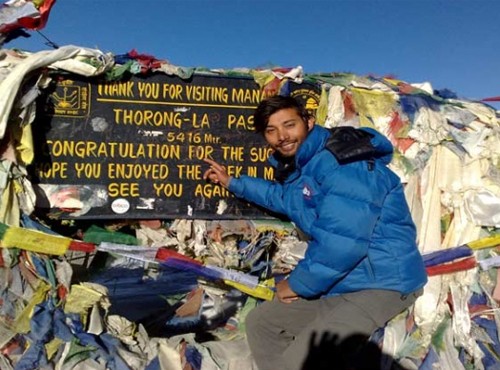
Annapurna Circuit Trek - 13 Days
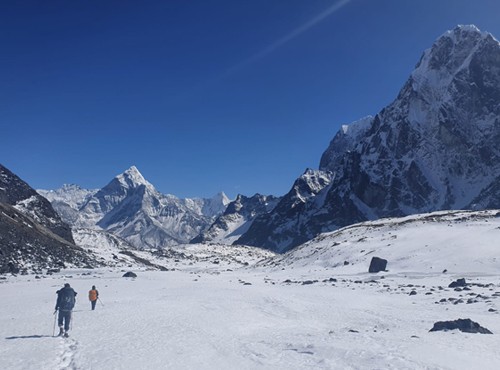
Everest Three passes Trek - 21 Days
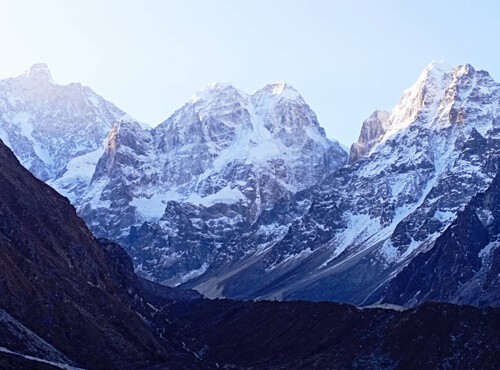
Kanchenjunga Circuit Trek - 19 Days
Are you wondering what to bring for a Three Passes trek? Here is a list of everything you will require to embark on the Three High Passes Trail.
The packing list is among the most crucial things you should consider before beginning this adventure. All required gear for the walk, including clothes, footwear, first aid kits, and other trekking supplies, should be prepared by hikers before the Everest Three Passes Trek . Moreover, the trekking season also has an impact on the packing list. You should only bring what is required.
If the Three Passes trek is your first great Himalayan trek, I'm sure this helpful packing list guidance operates as the core for your equipment setup. To learn more about the Three Passes Trek packing list and details related, continue reading.
Essential Packing Lists for Everest Three Passes Trek:
1) clothing.
The high-altitude trekking requires appropriate clothing. The clothes for trekking should be cozy, warm, and moisture-absorbing.
Also, you should pack smartly, so that you can adjust your layering based on the weather. The packing list for the hike is affected by the season.
- Upper Body
You need warm, breathable clothing for your upper body while trekking. Remember to get lightweight stuff. The required attire is listed in the section below. You either decrease or increase the number of items based on your needs.
- 2 full sleeves and 1 half-sleeve shirt
- Thermal tops. The Everest region may experience very low temperatures. Also, wearing many thermal tops will keep you warm.
- A windproof jacket is essential.
- A pullover.
- Don't forget to bring a down jacket.
- Waterproof jacket
- Lower Body
You will quickly become chilled in your lower body. Be careful not to bring anything that can make your skin uncomfortable.
- Undergarments
- Thick Hiking pants
- Thin hiking pants
- Hiking trousers
- Thermal Set
- one pair of wool trousers
- Waterproof shell pants
- Leggings
You should always keep your head warm. You wouldn't want to get a temperature or a headache that may hamper your trekking plan.
- Pack a headscarf. A bandana might also be a great option. Dusty paths are perfect for them.
- A wool hat that is warm and protects your ears.
In most situations, you must leave your hands free. You must keep them firm and heated at the same time. Here are some essential items for your hands to bring.
- Woolen gloves
- Gloves with a poly lining
- Mittens. Sometimes even the gloves are insufficient to keep your hands warm. Under such circumstances, mittens are required.
Make sure your feet stay dry. Take off your hiking boots and give them relaxation when you reach the teahouses/lodges. Always wear dry socks and check your socks.
- 3 pairs of light, thin wool socks
- 2 pairs of thick woolen socks
- 1 pair of hiking boots with thick soles (waterproof and good ankle support)
- 1 pair of running shoes (optional)
- 1 pair of crocs
- Toiletries
Basic supplies like toiletries are necessary for day-to-day hikes which include the following:
- Toilet paper, nail clippers, and antibacterial hand wash
- An average-sized towel
2) Trekking Gear and Equipment
The following complete hiking supplies and gear are required for the Everest Three Passes Trek:
- Daypack or Backpack for Hiking
To keep all of your trekking equipment and apparel together, you must have a hiking backpack or daypack. For the sake of your belongings' security, the backpack has to be waterproof.
A backpack is ideal for trekkers and travelers who don't pack heavily. With the daypack, you may store your first aid supplies, important papers, toiletries, and other essentials.
- Hiking bag with a capacity of 50 to 70 liters
- Rain Covers for backpack
- Duffle Bags in case you are walking with porters
- Hiking poles
During the trek across the difficult, rocky terrain, trekking poles are a necessity. They offer stability and ease the strain on the hikers' knees.
- Headlamps
For walking in low light, a headlamp is appropriate. Several of the itineraries to the Three Passes Trek call for early morning treks before sunrise. As a result, headlamps enable hassle-free, safe hiking. When you reach the location after dark, these headlights are extremely helpful.
- Raincoats
Wearing a raincoat will help you stay dry when hiking in the rain and snow. A backpack rain cover is also necessary to shield your stuff.
- Electronic Devices to Take on the Three Passes Trek
You may communicate and make memories while on the walk with the help of electronic devices. You should bring the following electronic devices:
- Camera, charger, and additional batteries
- A backup charger and a power bank
- Battery charger external
- Headphones
- Using a smartphone with a Nepali SIM card
- Every adapter, outlet plug, and charging cable
Important Advice for the 3 Passes Trek Gear List
- Get yourself either a daypack or a big backpack.
- Should pack according to the seasons of the travel
- Layer your clothing when traveling.
- Pack only what is essential.
- Female hikers walk with feminine care items.
- Before the hike, you should stretch in your shoes. You should also bring quick-drying and absorbent clothing.
- Avoid unnecessary stuff.
- You can hire gear like sleeping bags and down jackets that you just intend to use on your hike.
- Remember to include a disposable plastic bag to store your trash items as you are packing.
Three Passes Hike Considerations and Packing List
Trekking season.
The packing list for the 3 Passes Trek should be dependent on the seasons of the journey. Autumn and spring are when trekking is most popular. The best part of the walk during these seasons is the consistent weather and clear skies. In addition, the area experiences moderate daytime temperatures and much less rainfall. So, you should bring the necessities only when you pack.
If you trek during the winter or monsoon, you bring warm clothing, rain coverings, and extra equipment. Additionally, the monsoon season brings the most precipitation and heat. In the high-altitude routes, the winters are pretty cold. Hence, during these seasons, raincoats, umbrellas, and additional down jackets are necessary.
Where to buy Trekking Gear and Essentials?
Not every trekker plans to visit Nepal only. You may go to the country near the sea or live in a place where it is quite hot all around the year, so you may not need the hiking equipment over there.
You can purchase or hire reasonably priced trekking supplies and equipment for the Everest Three Passes Trek at Thamel, Lukla, or Namche Bazaar.
What should be the weight of the luggage for Three Passes Trek?
Your luggage weight shouldn't be more than 10 kg for the backpack and 5 kg for the hand carry for taking on Lukla Flight. A porter can handle about 15-25 kg of the backpack. As a result, weight is another element to consider while packing for the Three Passes Trek.
- Altitude Sickness
- Trekking Tips
- Himalaya Trails
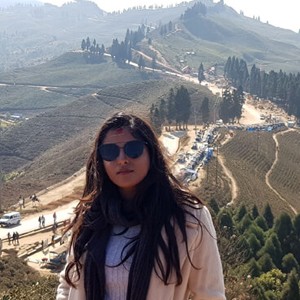
Benjila Dhital
Benjila has been an integral part of the Nepal Nirvana Trails as she writes passionately and learns about new spots, people, cultures, and languages. With a Bachelor's Degree from the reputed college NATHM in Bachelors of Tourism and Travel Management lately, she has been engaging in authoring web content and familiarizing new locations with the tourist out there.
Drop a message
Recent posts.
- Can you trek to Everest Base Camp in April?
- Trekking in Nepal in March 2024
- Unveiling the Hidden Gems of Kanchenjunga: Trekking Guide for Adventure Enthusiasts
- Best Time For Manaslu Circuit Trek
- Family-Friendly Trekking in the Annapurna Region: Creating Lasting Memories with Loved Ones
- Langtang Valley Trek: A Serene Himalayan Escape for Nature Lovers
Related Posts
Travel guides.
- Annapurna Region Trek Guide
- Everest Three Passes Trek Guide
- Kanchenjunga Trek Guide
- Langtang Region Trek Guide
- Manaslu Region Trek Guide
- Nepal Travel Info
- Things to Do
- Travel Blog

Are you looking for the Nepal holiday? or need help to plan a trip, please do not hesitate to get in touch with us.
We use cookies to ensure that we give you the best experience on our website.

EVEREST THREE PASSES TREKKING ROUTE

EVEREST THREE PASSES
ROUTE GUIDE

Pin Tweet Share WhatsApp
A GUIDE TO THE TRAIL
In this guide we share detailed trail notes about the Everest Three Passes trekking route. This includes section distances and estimated trekking times, plus info about food, services, and accommodation options along the way. There is also a description of the trail and we offer a downloadable route map for online or offline use. As a visual accompaniment to this written guide you can watch our Everest Three Passes film, and for everything else you need to know to plan your trek, check out our Essential Guide To The Everest Three Passes Trek .
TREK OVERVIEW THREE PASSES FILM MAP & GPX DOWNLOAD THREE PASSES ITINERARY ELEVATION PROFILE
TREKKING ROUTE LUKLA → MONJO MONJO → NAMCHE BAZAAR NAMCHE ACCLIMATISATION DAY NAMCHE → PANGBOCHE PANGBOCHE → DINGBOCHE NANGKARTSHANG HIKE DINGBOCHE → CHUKHUNG CHUKHUNG RI HIKE CROSSING KONGMA LA LOBUCHE → GORAK SHEP KALA PATTHAR HIKE EVEREST BASE CAMP GORAK SHEP → LOBUCHE LOBUCHE → DZONGLHA CROSSING CHO LA DRAGNAG → GOKYO GOKYO RI HIKE CROSSING RENJO LA THAME → MONJO MONJO → LUKLA
*Some of the links in this post are affiliate links – if you purchase a product or service via these links, we may earn a small commission at no extra cost to you . This helps offset the cost of running this blog and keeps us travelling so that we can continue to produce great content for you. We greatly appreciate your support!*
EVEREST THREE PASSES TREK OVERVIEW
- DISTANCE | Approx 160 km (incl. acclimatisation/day hikes)
- DURATION | 17 – 22 days (incl. flying to/from Lukla)
- START/END | Lukla
- PERMITS REQUIRED | Khumbu Trek Card 2000 NPR; Sagarmatha National Park Fee 3000 NPR (SAARC nationals 1500 NPR / Nepali nationals 100 NPR)
- TREKKING SEASON | Best Seasons: April to Mid-May , October to Mid-November ; Shoulder Seasons: March, Late May, September, Mid-November to December ; Avoid: June to August, January to February
- TREK DIFFICULTY | Challenging
- ELEVATION GAIN/LOSS | +/- approx 13500 metres (incl. acclimatisation/day hikes)
- MAX ALTITUDE | 5611 m (Kala Patthar) or 5514 m (Kongma La)
- GUIDE MANDATORY? | Khumbu Pasanglhamu Rural Municipality has stated that it is NOT mandatory to trek with a guide in the Khumbu region
- ACCOMMODATION | Teahouses/Guesthouses in villages along the trail
- TREK COST | $34 – $140 USD per person, per day (budget independent trekker to fully inclusive package)
- RECOMMENDED TREKKING AGENCY | Himalayan Masters , Quote HOGG5 for 5% discount
DISTANCE Approx 160 km (incl. acclimatisation/day hikes)
DURATION 17 – 22 days (incl. flying to/from Lukla)
START/END Lukla
PERMITS REQUIRED Khumbu Trek Card 2000 NPR Sagarmatha National Park Fee 3000 NPR (SAARC nationals 1500 NPR, Nepali nationals 100 NPR)
TREKKING SEASON Best Season April to Mid-May October to Mid-November Shoulder Seasons March, Late May, September Mid-November to December Months To Avoid June, July, August January and February
TREK DIFFICULTY Challenging
ELEVATION GAIN/LOSS +/- approx 13500 metres (incl. acclimatisation/day hikes)
MAX ALTITUDE 5611 m (Kala Patthar) or 5514 m (Kongma La)
GUIDE MANDATORY? Khumbu Pasanglhamu Rural Municipality has stated that it is NOT mandatory to trek with a guide in the Khumbu region
ACCOMMODATION Teahouses/Guesthouses in villages along the trail
TREK COST $34 – $140 USD per person, per day (budget independent trekker to fully inclusive package)
OUR RECOMMENDED TREKKING AGENCY Himalayan Masters , Quote HOGG5 for 5% discount
EVEREST THREE PASSES TREKKING FILM
Get a sense of the Everest Three Passes trekking route in our ‘silent hiking’ style ambient film.
Watch the behind the scenes version of our Everest Three Passes trek on Instagram stories
Watch the behind the scenes version of our three passes trek on instagram stories .
Everest Three Passes Trek Stories
MAP & GPX DOWNLOAD
EVEREST THREE PASSES TREKKING ROUTE //
We have created a detailed Everest Three Passes digital trekking map to accompany this guide. The full trekking route is marked, including Everest Base Camp and Gokyo Lakes, along with day hikes around Namche Bazaar and Gokyo, and to Nangkartshang, Chukhung Ri, Kala Patthar, and Gokyo Ri. Alternative routes avoiding the passes are also marked, as is the overland route between Salleri and Lukla.
Detailed stats and an elevation profile are included for each route section. Guesthouse settlements and tea shops are also marked, as well as key sights and practical info such as checkpoints, hospitals, and transport hubs. Guesthouses as per our own trek itinerary are marked, including info about prices and services, phone numbers (where possible), and a copy of the menu. Photos are included with almost every pin.
You can use the digital map online, or download it for offline use with a mapping app such as Organic Maps, Maps.me or Gaia GPS. This is very helpful for navigation assistance on the trail. It allows you to quickly pinpoint key places and services along the way and calculate distances and elevation differences between destinations.
Note that while we’ve tried to be as accurate as possible when recording and mapping the route, changes on the ground are inevitable (especially on routes crossing glaciers) and this map should not be solely relied upon for navigation.
EVEREST THREE PASSES TREK ITINERARY
TREK ITINERARY
We have outlined below what we feel is an ideal itinerary for the Everest Three Passes trekking route. This is a 19 day itinerary which includes flying to and from Lukla. We have noted the trekking distance and an approximate trekking time for each day (excluding lunch stops, breaks, etc), as well as stats on elevation gain/loss and sleeping altitude.
Note that this itinerary outlines an anti-clockwise trekking route, crossing Kongma La first, and Renjo La last. You can read more about our thoughts on why this is the best direction to trek in the ‘Is it best to do the Everest Three Passes trek clockwise or anti-clockwise?’ section of our guide.
For a few alternative route options which you may wish to consider, check out this section of our guide .
If viewing on a mobile device or tablet, scroll to the right to see the full table or flip your screen to landscape mode
*On days 10 and 11 the standard itinerary that most people follow is to visit EBC after lunch at Gorak Shep, then hike up Kala Patthar in the dark for sunrise the next morning (when it is bitterly cold). If you swap these two around as per the above suggested itinerary, you are guaranteed to have a less busy experience at both EBC and on the trail up Kala Patthar. As the skies are usually clearer in the morning you are also likely to have better views at EBC, however it is possible that the views from Kala Patthar will be obscured by afternoon clouds. If you’re lucky and have clear afternoon skies, then you will be treated to a fiery sunset glow on Everest and the surrounding mountains. If you hike up Kala Patthar in the morning, your mountain views will be brief as the sun rises directly behind Everest and you’ll soon be looking directly into the sun.
OUR RECOMMENDED TREKKING AGENCY
We partnered with Himalayan Masters for our Langtang Valley, Gosainkunda, and Everest Three Passes treks, and found them to be very professional and committed to a high level of service
To enquire about booking your own trek, get in touch via email at [email protected] and mention the code HOGG5 to get a 5% discount off the cost of your trip
EVEREST THREE PASSES TREK ELEVATION PROFILE
ELEVATION PROFILE
The image below shows the elevation profile of the Everest Three Passes trek, starting and ending in Lukla and going in an anti-clockwise direction, crossing Kongma La first, Cho La second, and Renjo La third. The route shown here includes the various acclimatisation and side hikes outlined in this guide. Elevation is displayed in metres and distance in kilometres.

3D ROUTE MAP
Watch our 3D relief map video of the route to visualise the landscape and get a sense of the Everest Three Passes trek.
EVEREST THREE PASSES TREKKING ROUTE BREAKDOWN
ROUTE BREAKDOWN AND TRAIL DESCRIPTION
Below is the breakdown of the Everest Three Passes trekking route as outlined in the itinerary table above. Each day includes an overview, distances, elevation gain and loss, estimated trekking times without breaks, a detailed description of the trail, and info about food, services, and accommodation options.
The following route breakdown starts and ends in Lukla. For detailed information about the various ways of getting to/from Lukla, check out the the ‘How to get to Lukla’ section of our guide.
DAY 1: LUKLA → MONJO
Everest three passes trekking route day 1:, lukla → monjo, 12.6 km | + 1117 m / – 1148 m | 4.5 hours, + 1117 m / – 1148 m.
Today is a straightforward introduction to the trek. There are no lengthy ascents or descents and mostly wide stone paths to walk on, although there are plenty of short ups and downs throughout the day. There are a couple of checkpoints along the way and regular villages with guesthouses where you can eat or stop for tea. You’ll no doubt encounter plenty of pack mules and yaks – when letting them pass, be sure to wait on the side of the trail without a drop-off.

PLACES ON THE LUKLA TO MONJO ROUTE
The table below details the main guesthouse villages and services available along the route from Lukla to Monjo. On this section, there are also many smaller settlements and guesthouses that lie between those mentioned in the table. The distances and times noted cover the sections between the stops, not the total from the start.
If viewing on a mobile device or tablet, scroll to the right to see the full table or flip your screen to landscape mode.
Lukla → Phakding
7.5 km | + 472 m / – 687 m | 2.5 hours, + 472 m / – 687 m.
From the airport, the route leads through the town of Lukla, a bustling place with shop-lined streets and plenty of guesthouses and restaurants. Pass through the Pasang Lhamu Gate (celebrating the first Nepali woman to summit Everest) and at the bottom of the steps you’ll reach the Khumbu Trek Card registration desk.
It takes around 2 hours to trek from here to Phakding. The route leads downhill from Lukla before climbing towards Phakding, although there are plenty of flatter sections and some short ups and downs. The trail is mostly on wide stone paths, with a few bridges to cross along the way. You’ll pass through villages regularly and there are plenty of options for tea or food stops. There are also a number of mani stones and prayer wheels – be sure to walk on the left when passing these.
Phakding is a busy lunch spot and also a popular overnight stop for trekkers heading to Namche Bazaar. You’ll come to the main part of the village first, with a few more guesthouses situated across the bridge on the opposite side of the Dudh Koshi. Phakding is bigger than Monjo and tends to be the busier accommodation option. Continuing to Monjo means less people to share the trail with come morning.

Passing mani stones on the left between Lukla and Phakding

Phakding → Monjo
5.1 km | + 645 m / – 461 m | 2 hours, + 645 m / – 461 m.
The trail from Phakding to Monjo includes more uphill sections than before Phakding, but it isn’t too challenging. The route is similar: passing through various villages, walking on stone paths, and crossing a couple of bridges. There is another Khumbu Trek Card checkpoint at Toc Toc.
The village of Monjo is situated on a hillside and there are numerous guesthouses spread throughout, most with good views looking towards the impressive tree-covered cliffs opposite.
OUR MONJO ACCOMMODATION
NAME | Hotel Mini Tibet
ROOM | Two single beds, table, sheet and pillow, blanket + attached bathroom
ROOM COST | 1000 NPR
BATHROOM | Attached bathroom; sit down toilet; hot shower (solar)
DAL BHAT | 600 NPR (see full menu in our e-map )
SHOWER | 300 NPR for gas shower (no charge for solar shower in attached bathroom)
CHARGING | 200 NPR
WIFI | 300 NPR
PHONE SIGNAL | Phone signal, weak data
DAY 2: MONJO → NAMCHE BAZAAR
Everest three passes trekking route day 2:, monjo → namche bazaar, 5.1 km | + 983 m / – 390m | 3 hours, + 983 m / – 390m.
Today you’ll enter Sagarmatha National Park. You can enjoy lovely river and forest views and get to experience the thrill of crossing the 125 metre high Hillary Suspension Bridge (along with a couple of others). There is only one village along the way, Jorsale, which is around 40 minutes’ walk from Monjo. There are no teahouses after this however pop-up vendors can be found at a couple of spots on the climb to Namche, serving soft drinks, biscuits, fruit, face masks, strepsils, cigarettes… all the essentials ; ) Make sure you have enough water with you to last until Namche Bazaar.

PLACES ON THE MONJO TO NAMCHE BAZAAR ROUTE
Climb up through Monjo and you’ll reach the Sagarmatha National Park entrance on the edge of the village, where your permit will be checked.
Pass through the decorative gate and descend the wide stone staircase before crossing the Dudh Koshi on a suspension bridge and entering the small village of Jorsale. There are a few guesthouses, small shops, and cafes here.
Shortly after Jorsale you’ll cross a second suspension bridge and follow a wide trail alongside the river where you can enjoy increasingly beautiful views. About 1 km from the second suspension bridge you’ll reach a wonderful viewpoint where you can look up at the Hillary Suspension Bridge, the third and most impressive of the day.

The Hillary Suspension Bridge as seen from the valley floor, with the old bridge still in place below

From here you’ll be climbing all the way to Namche Bazaar, an ascent of about 700 metres. A wide stone staircase leads up to the bridge, where you may need to wait a few minutes depending on how busy the trail is. The Hillary Bridge can be pretty nerve wracking to cross, given its height from the ground (125 metres), and also if it’s especially windy and/or crowded.
After the bridge the climb continues up through pine forest on a rock and dirt trail which can get quite dusty, and which is also fairly steep in parts. This section can be a bit of a bottleneck, with lots of yak and mule trains, porters, and groups of trekkers moving in both directions. Look out for a convenient side trail favoured by porters which leads slightly uphill to the right shortly after the public toilets. This route runs parallel to the main trail for a while before rejoining it near the top, and it’s usually less busy. You’ll need to show your Khumbu Trek Card at the checkpoint on the outskirts of Namche, after which it’s just a short distance to the town itself.
Namche Bazaar has a mix of guesthouses and local homes, dotted up the terraced hillsides in a horseshoe shape. It’s a bustling place and the main hub for the region, with trekkers and climbers converging here on the way up and down to Everest Base Camp, the Three Passes, Gokyo Lakes, and elsewhere. There are lots of shops, bakeries, cafes, and even an ATM or two (although it’s best not to rely on this and bring cash from Kathmandu). If you need to pick up any extra gear, there are at least three genuine gear shops stocking Icebreaker, Osprey, Sea to Summit, Black Diamond, Salomon, La Sportiva, Katadyn, The North Face, etc, plus the usual fake gear shops.
OUR NAMCHE BAZAAR ACCOMMODATION
NAME | Hotel 8848
ROOM | Two single beds, table, sheets and pillows, blanket + attached bathroom
ROOM COST | 1500 NPR (attached bathroom); 1000 NPR (shared bathroom)
BATHROOM | Attached bathroom; sit down toilet; hot shower (solar and gas)
DAL BHAT | 750 NPR (see full menu in our e-map )
SHOWER | Free (rooms with attached bathroom); 500 NPR (rooms with shared bathroom)
CHARGING | Free in room with attached bathroom
WIFI | Free
PHONE SIGNAL | Yes
OTHER | Comfortable; great rooms (with attached bathroom) on top floor
DAY 3: NAMCHE BAZAAR ACCLIMATISATION DAY
Everest three passes trekking route day 3:, namche bazaar acclimatisation day, 5.6 km – 9.1 km | +/- 550 – 740 m | 3 – 6 hours, 5.6 km – 9.1 km, +/- 550 – 740 m, 3 – 6 hours.
It’s important to acclimatise properly throughout your Everest Three Passes trek. This allows your body time to get used to the ever-increasing altitude as you ascend to 5000 metres and above. Building in rest days, staying well hydrated, and going on acclimatisation hikes (where you climb higher during the day but sleep lower at night) are all good ways of helping your body acclimatise. Unless you are already acclimatised (for example you have been at altitudes of 4000 metres and higher within the previous week), spending a second night at Namche Bazaar is highly recommended, even if it seems like you feel physically fine. Use the extra day to go on an acclimatisation hike (no big backpack required!) and take the time to rest and hydrate.

The most common destination for an acclimatisation hike from Namche Bazaar is the Hotel Everest View (3880 m) , where you can get lunch or a drink and enjoy fantastic views from the terrace. It takes around 3 hours to hike up to the hotel and back down again.

Morning view of Namche Bazaar from the northeast

A must-visit on the way is Sagarmatha Next , a learning/experience/visitor centre and gallery championing waste management solutions for the Khumbu region. There are exhibitions on local culture, geography, history, climbing and trekking, flora and fauna, and the environmental challenges facing the region. There is also an art gallery showcasing artwork made from waste, a film salon showing documentaries, a VR experience, and a shop selling upcycled souvenirs made from waste plastic from the Khumbu, designed by Super Local. Check out this video to learn more about the great design project. At the Waste Lab artists and product designers work on upcycling projects, and workshops are held regularly. There is a cafe, too.
If you are interested in extending your hike for the day and seeing more of the local area, doing a loop via Khumjung village is a great option. Khumjung is the largest Sherpa village in the region, with an impressive monastery and a school founded by Edmund Hillary in 1960. The original classroom is now the Sir Edmund Hillary Visitor Centre , another great place to visit and learn about the Khumbu region. The loop hike (including Hotel Everest View) is around 7.5 km, and you should allow up to 5 hours for the hike. If you are interested and have the energy you could also include a visit to Khunde village (home to another monastery). This would extend the route to around 9.1 km and you should allow up to 6 hours.
SEE MORE FROM NEPAL

Everest Base Camp Trek: The Essential Guide

Everest Three Passes Trekking Route Guide

Everest Three Passes Trek: The Essential Guide

Gosainkunda Helambu Trekking Route Guide

Gosainkunda Trek: The Essential Guide

Langtang Valley Trekking Route Guide

Langtang Valley Trek: The Essential Guide

What To Pack For Trekking In Nepal

Upper Mustang Trek: The Essential Guide

Upper Mustang Trek Itinerary: A Day By Day Account

Annapurna Circuit Trek: The Essential Guide

Annapurna Circuit Trek Itinerary: A Day By Day Account

Manaslu Circuit Trek: The Essential Guide

Manaslu Circuit Trek Itinerary: A Day By Day Account
Day 4: namche bazaar → pangboche, everest three passes trekking route day 4:, namche bazaar → pangboche, 13.6 km | + 1541 m / – 1020 m | 6 hours, + 1541 m / – 1020 m.
This day offers fantastic mountain scenery and a beautiful trekking trail, with a mix of open hillside and forest paths. The start and end of the day is mostly straightforward, with a big climb in the middle section between Phunki Thanga and Tengboche. The monastery in Tengboche is well worth visiting, so be sure to allow enough time if you are interested.

PLACES ON THE NAMCHE BAZAAR TO PANGBOCHE ROUTE
Namche bazaar → tengboche, 9.5 km | + 1197 m / – 753 m | 4.5 hours, + 1197 m / – 753 m.
After climbing the steep steps through Namche Bazaar, the trail follows a fairly flat, wide dirt path that leads around the hillside. There is a bit of up and down but it’s generally easy going up until Kyangjuma (about 4 km). You’ll pass the Tenzing Norgay memorial chorten on the way, a great spot where you can see Ama Dablam, Lhotse, Everest, and other famous peaks. There are a few guesthouses in Kyangjuma and the views are nice. This makes a good tea stop, or a quieter alternative to overnighting in Namche.

Trekkers enjoy mountain views from the Tenzing Norgay memorial chorten

From Kyangjuma to Phunki Thanga it’s mostly downhill on a pleasant forest trail, passing through the small teahouse village of Lawi Schyasa a little beyond the halfway point. The options for food and accommodation are better at Phunki Thanga, and this is a common early lunch stop, good for fueling up before the big climb to Tengboche.
From Phunki Thanga, cross the Dudh Koshi on the suspension bridge and stop at the checkpoint before tackling the big climb. It’s around a 600 metre ascent up to Tengboche, a mixture of open hillside and forest. This can take about 2 hours. The first half is quite steep on dusty switchbacks while the second half is a bit more gradual.
Tengboche is dominated by the large gompa (monastery), with just two guesthouses in the village. The Tashi Delek bakery serves excellent cakes and real coffee along with the usual food menu items. The views from the balcony are wonderful, looking over to the monastery and up the mountainous valley. You can visit the monastery daily from 7am – 8am, 9am – 11am, and 1pm – 5:30pm. You can witness the monks chanting at 3pm, an option for those who choose to stay overnight in Tengboche.

The large monastery complex at Tengboche

Tengboche → Pangboche
4.1 km | + 344 m / – 267 m | 1.5 hours, + 344 m / – 267 m.
From Tengboche the trail descends about 150 metres to Deboche, a small settlement with a handful of guesthouses. From here the trail is fairly flat before climbing gently on a wide path through lovely forest, with trees dripping in Old Man’s Beard and views over the Dudh Koshi. After crossing a suspension bridge you’ll climb an open hillside on a mixture of paths and stone staircases, the final stretch to Pangboche.
Pangboche is a good sized village, quite attractive with a mix of teahouses and homes, and lots of farming fields stretching towards the river. There are fantastic mountain views when the skies are clear.
OUR PANGBOCHE ACCOMMODATION
NAME | Om Kailash
ROOM COST | 1000 NPR (attached bathroom); 500 NPR (shared bathroom)
BATHROOM | Attached bathroom with sit-down toilet and sink but no shower
DAL BHAT | 695 NPR (see full menu in our e-map )
SHOWER | 700 NPR for gas shower
CHARGING | 300 NPR (full battery charge)
WIFI | 600 NPR (Airlink for 24 hours)
DAY 5: PANGBOCHE → DINGBOCHE
Everest three passes trekking route day 5:, pangboche → dingboche, 5.7 km | + 602 m / – 250 m | 2.5 hours, + 602 m / – 250 m.
This is a short and easy day with wonderful views throughout. The trail climbs gently up the valley between the two villages of Pangboche and Dingboche. There are just a couple of short steeper sections, before Shomare and after the bridge.

PLACES ON THE PANGBOCHE TO DINGBOCHE ROUTE
Leaving Pangboche, a dusty trail climbs gently up the valley across scrubby hillside, with the river below and fantastic mountain views above. It takes about an hour to reach Shomare, with a bit of a climb at the end. Here you’ll find a number of teahouses.
The gentle climb continues and in less than 1 km you’ll reach the lone Sunrise Lodge, situated in a broad valley with braided trails approaching it. These eventually funnel back into a single trail which leads to a small metal bridge at the confluence of the Lobuche and Imje Khola rivers.

The trail leads down to a small bridge then climbs up and around the next hillside until Dingboche is revealed

The trail climbs a little more steeply after the bridge, up and around the hillside, but soon becomes a gentle incline once again. About 30 minutes beyond the bridge you’ll catch your first sight of Dingboche and arrive in the village shortly after.

First sight of Dingboche, a village with many guesthouses where people stay two nights for acclimatisation

First sight of Dingboche, a big village with many guesthouses where people stay two nights for acclimatisation
There are many guesthouses in Dingboche, as well as local houses, and the views of Ama Dablam from the village are wonderful. There are a few bakeries showing mountain-related films in the afternoon. Good options include the cosy Cafe Himalaya, which shows Sherpa at 2:30pm and has lots of old mountaineering photos and gear on display inside, and Cafe 4410, which has a large modern interior, a big food menu, and shows Sherpa and Everest from 2pm. The French Bakery (which also has a pharmacy) shows Free Solo , Meru , and a film about Helicopter rescues in the Himalaya on alternate days. Most of them also offer free device charging if you spend 400 rupees, which is more or less what it will cost to charge at your guesthouse.
OUR DINGBOCHE ACCOMMODATION
NAME | Mountain Heritage Inn
ROOM | Two single beds, sheets, pillows, blankets, carpeted room; spacious window ledge (no table); attached bathroom
ROOM COST | 1500 NPR (attached bathroom)
BATHROOM | Sit-down toilet and sink in attached bathroom, but no shower
DAL BHAT | 1000 NPR (see full menu in our e-map )
SHOWER | 800 NPR for gas shower
CHARGING | 500 NPR per device
WIFI | 24 hr/48 hr Airlink cards (700 NPR / 1500 NPR)
PHONE SIGNAL | No
OTHER | Spacious dining room and spacious rooms too; extra blanket charged at 200 NPR
DAY 6: NANGKARTSHANG PEAK DAY HIKE
Everest three passes trekking route day 6:, nangkartshang peak (5039 m) day hike, 5 km | +/- 766 m | 4 hours.
The hike up to Nangkartshang Peak (5039 m) offers fantastic views. It is also great for acclimatisation as you will climb high but descend to sleep at around 4300 m again. There is a clear path all the way to the top. The 766 metre climb should take around 2.5 – 3 hours, with the descent about half that. It’s best to start early (around 7:30am) for the best chance of clear views and calm conditions. Ensure you have plenty of water, snacks, and warm layers.

The climbing starts immediately from Dingboche, with the trail leading up from behind the French Bakery and Mountain Heritage Inn. You’ll pass under two white stupas with painted eyes near the start, then reach a series of small chorten on the ridge. From here you can see the classic Everest Base Camp trekking trail heading northwest to Lobuche. Alternative trails from the upper part of the village also lead to the chorten, skipping the stupas.
Continue climbing steadily uphill and you’ll pass some small prayer flags and rock cairns at various points. The views are fantastic, looking northeast up the valley towards Chukhung, across to Ama Dablam (6812 m), and to numerous other mountains all around. The final section to the top is a little steep so take your time, and there are some big rocks around the prayer flags with a steep drop-off on the eastern side, so take care.
After enjoying the views, follow the same route back down to Dingboche.

Trekkers climbing towards the second stupa above Dingboche

People rest and take in the views from the prayer flags (5039 m) on Nangkartshang

Fantastic view of Ama Dablam (6812 m)
COME JOIN US ON INSTAGRAM

DAY 7: DINGBOCHE → CHUKHUNG
Everest three passes trekking route day 7:, dingboche → chukhung, 5 km | + 451 m / – 19 m | 2.5 hours, + 451 m / – 19 m.
Today you will depart from the classic Everest Base Camp trekking route, so you can expect the trail to be much less busy until you rejoin the EBC route at Lobuche. It is a short trekking day. You’ll climb gently up the valley on a dirt trail through scenic rocky, scrubby landscape to the small teahouse village of Chukhung, situated at 4730 m. There are no other villages or teahouses on the route, so be sure to have enough water with you for the duration of the walk.

Start today’s walk by heading up through Dingboche to reach the extensive terraces of walled fields at the northeastern edge of the village. Leaving Dingboche behind, the trail climbs gradually up the valley, with the Imja Khola flowing to the right. Ama Dablam takes on a different look with her two distinct peaks appearing side by side, and Island Peak will come into view as you get closer to Chukhung.

A memorial to climbers who lost their lives on Lhotse, with Island Peak in view behind and to the right

A memorial to climbers who lost their lives on Lhotse, with Island Peak behind to the right
There are just a handful of teahouses at Chukhung, and it’s usually much less busy than Dingboche as it’s off the EBC trail.
OUR CHUKHUNG ACCOMMODATION
NAME | Yak Land Lodge
ROOM | Two single beds, sheets, pillows, blankets; spacious window ledge to store stuff (no table)
ROOM COST | 1000 NPR (shared bathroom option only)
BATHROOM | Shared Bathroom: 1 x squat toilet, 1 x sit-down toilet, separate shower room; kept very clean; no indoor sink
DAL BHAT | 745 NPR (see full menu in our e-map )
SHOWER | 650 NPR for bucket shower; gas shower not working when we stayed
CHARGING | 500 NPR (phone); 1500 NPR (power bank)
WIFI | 24 hr Airlink cards (700 NPR)
OTHER | Very nice owners; warm dining room; highly recommend
DAY 8: CHUKHUNG RI DAY HIKE (5380 m or 5516 m)
Everest three passes trekking route day 8:, chukhung ri day hike (5380 m or 5516 m), 4.9 – 5.9 km | +/- 645 – 810 m | 3 – 5 hours, 4.9 – 5.9 km, +/- 645 – 810 m, 3 – 5 hours.
This is a fantastic day hike for both views and acclimatisation. The main viewpoint is at 5380 m, with a higher viewpoint at 5516 m. Both are accessed from the same saddle, with the lower viewpoint to the southwest and the higher viewpoint up a steeper and narrower rocky ridge trail to the northeast. Expect it to take around 2 to 3 hours to climb to the viewpoint at 5380 m, and around 1 hour to descend via the same route. It should take about an hour extra if you want to continue to the upper viewpoint at 5516 m. Leaving early in the morning gives you the best chance of clear views, and you can aim to return to Chukhung for lunch. Ensure you have plenty of water, snacks, and warm layers.

Head northeast out of Chukhung and cross a small metal bridge. The trail continues up the scrubby hillside, climbing steadily on a dirt trail for around an hour. After ascending approximately 240 metres, you’ll reach an open plateau where you can take a moment to appreciate the views.
Heading north, the trail climbs gently before becoming steeper on the far side of the plateau. From here you’ll climb to the saddle 200 metres above, on a long straight trail that turns to switchbacks nearer the top. The saddle is marked by numerous cairns and the ground here is made up of large slabs of shale. It’s absolutely worth continuing the short distance up the trail to the southwest (left) viewpoint, marked by more flags, cairns, and complete with stunning 360° views. In clear weather you’ll see Lhotse, Nuptse, Island Peak, Ama Dablam, and numerous other majestic snowy peaks. It’s a wonderful spot to relax for an hour or so and soak it all up.

Stopping to appreciate the views after the initial climb up from Chukhung

Looking up at the south face of Nuptse from the main Chukhung Ri viewpoint (5380 m)

Looking southwest down the valley towards Dingboche and beyond, from the main Chukhung Ri viewpoint (5380 m)
If you are confident on such terrain and have the energy, you can continue up to the higher viewpoint (5516 m). To get there, return to the saddle and follow the trail climbing northeast up the narrow rocky ridge (very steep towards the end).
When you’re done, descend to Chukhung the same way you came.
HOW ABOUT TACKLING THE MANASLU CIRCUIT?

THE ESSENTIAL GUIDE

DAY BY DAY ACCOUNT
DAY 9: CHUKHUNG → KONGMA LA (5514 m) → LOBUCHE
Everest three passes trekking route day 9:, chukhung → kongma la (5514 m) → lobuche, 9.8 km | + 973 m / – 792 m | 8 hours, + 973 m / – 792 m.
Today you’ll cross Kongma La (5514 m), the first (and highest) of the three passes on the Everest Three Passes trek. The day involves a long but beautiful ascent, followed by a steep and tiring descent, with a moraine glacier crossing at the end. Make sure you have plenty of water and snacks, and take a packed lunch with you. Leave early (around 6am) to have the best chance of clear views and less windy weather, and to ensure you arrive in Lobuche well before dark.

Chukhung → Kongma La
5.8 km | + 870 m / – 90 m | 5 hours, + 870 m / – 90 m.
From Chukhung, cross the bridge heading west and start climbing the scrubby hillside. It’s a fairly steep and steady climb, flattening out a bit at around 4750 m and then climbing again. The trail flattens out once more at around 5000 m, following the contour line of the hillside and curving into the next valley. From here, a gradual climb up the valley (with a few short steep sections) leads to an open expanse of grass where a big lake lies cradled by surrounding mountains.
Have a break and a snack here because the next section is the steepest climb of the day! The trail becomes narrow and climbs 150 metres on tight switchbacks over a distance of just 400 metres. From the top of the climb the trail heads north and becomes much more gradual until the final section immediately before the pass. There are a number of lakes up here, often frozen earlier in the year, and the views are wonderful. The final stretch up to the pass (marked by a cluster of prayer flags) is on a very narrow trail of loose dirt and shale, a fairly steep climb up the rocky slope.

The section before the final climb to the pass is fairly flat and offers the chance to catch your breath and use a bit less energy

The view of Kongma La as you approach from the east; the pass is at the lowest point of this ridge, reached by a short but steep rocky climb
The pass is fairly narrow but there’s still plenty of room, with lots of big rocks to sit on and soak up the incredible views. To the southeast, you can still see the distinctive form of Ama Dablam, to the north is the imposing Nuptse Lhotse massif, and to the northwest, you can see Lobuche far below on the western side of the Khumbu Glacier, a moraine glacier you’ll have to cross to reach your guesthouse for the night.

The eastern view from Kongma La, looking down over the route just trekked

Resting, having lunch, and enjoying views at Kongma La, with Nuptse visible to the north

The way down begins steeply on jumbled rocks before a clearer path descends to the valley floor and leads up onto the glacier, which you must cross to reach Lobuche
Kongma La → Lobuche
4 km | + 103 m / – 702 m | 3 hours, + 103 m / – 702 m.
The initial 200 metre descent from Kongma La is very steep. Care and concentration is required on the loose dirt, shale, and small rocks which can slide away underfoot. The next part of the descent (approx 400 metres) is still steep and slippery, but less challenging. It takes around 1.5 – 2 hours to reach the valley floor (4900 m). From here, there is a 50 metre climb up onto the rocky Khumbu Glacier. The route through this jumble of rocks and glacial lakes is marked by cairns and flags. It follows narrow dirt trails and crosses big boulders between two lakes, with a fair bit of up and down. When you reach the other side, it’s just a short descent down the grassy hillside to Lobuche.

The route down onto the glacier, where flags and small cairns mark the way

There are about eight guesthouses in Lobuche, a small teahouse settlement on the main EBC trail, situated below Lobuche East peak. It’s a busy place, packed with trekkers and climbers in peak season, and you should aim to arrive as early as possible to secure a room. If you are trekking with a guide, they may be able to call ahead and book a room for you, and if you are trekking with a porter, they may be able to go ahead and secure a room for you.
OUR LOBUCHE ACCOMMODATION
NAME | New EBC Guest House
ROOM | Two single beds, sheets, pillows, blankets; spacious room with table and big window
BATHROOM | Shared toilet (sit-down, bucket flush); sink with running water; toilet and sink on each floor
CHARGING | 500 NPR (phone); 1000 NPR (power bank)
OTHER | Large, warm dining area; comfortable rooms on top floor
DAY 10 (PART 1): LOBUCHE → GORAK SHEP
Day 10 (part 1):, lobuche → gorak shep, 4.5 km | + 316 m / – 70 m | 2.5 hours, + 316 m / – 70 m.
Altitude aside, the walk to Gorak Shep is pretty straightforward, although the up and down through the moraine glacier towards the end can be quite tiring. It’s common to check into a guesthouse, eat lunch, and then head off to Everest Base Camp in the afternoon, with most people climbing Kala Patthar for sunrise the next morning. However, if the weather is clear, we’d suggest climbing Kala Patthar for sunset (see Day 10: Part 2) and walking to EBC and back the following morning (see Day 11: Part 1) . This way you will avoid the crowds on both routes, and enjoy the best views.

PLACES ON THE LOBUCHE TO GORAK SHEP ROUTE
The initial 3 km is pretty gradual as you head up the valley from Lobuche, with one notably steep part towards the end of this section. You’ll pass the turn off for the Pyramid Hotel (also a research centre) about 900 metres beyond Lobuche. The Pyramid Hotel is a 15 minute walk off the main trail. It’s then possible to continue on a high trail from the hotel to rejoin the main route further up the valley.
Shortly after the steep section, you’ll set out across the moraine glacier. There is a fair bit of up and down on a narrow trail through rocky terrain, but spectacular mountain views abound. When you reach the edge of the glacier you’ll arrive at Gorak Shep, the highest settlement on this trek.

The route to Gorak Shep leads across a rocky and undulating path on a moraine-covered glacier

The route to Gorak Shep leads across a rocky, undulating path on a moraine-covered glacier
Gorak Shep is a small teahouse settlement with just four guesthouses. It can get very busy as almost everyone trekking to Everest Base Camp stays here. There is no good water supply, with water to serve all the guesthouses being carried from a small spring nearby. Therefore, you are unable to fill and treat water here. Instead you’ll need to carry enough with you from Lobuche or buy bottled water (approx 500 NPR per bottle). The elevation and lack of a good water supply unfortunately contributes to poor sanitation and services here.
DAY 10 (PART 2): KALA PATTHAR HIKE (5611 m)
Day 10 (part 2):, kala patthar hike (5611 m), 3.8 km | + 495 m / – 495m | 3.5 hours, + 495 m / – 495m.
Kala Patthar, translating as ‘Black Rock’, rises above Gorak Shep and offers wonderful views of Everest and other impressive mountains around here. It is the highest point you will hike to on the Everest Three Passes trek. It’s common for people to start the climb before dawn, watching the sun rise behind Everest from the top. It can be bitterly cold though, and once the sun has appeared you will be looking directly at it, obscuring the good views of Everest, Nuptse, and so on. A good alternative in clear weather is to climb Kala Patthar in the afternoon, for sunset, when the white peaks will be illuminated with an orange magic hour glow. A lack of crowds is an added bonus on an afternoon Kala Patthar hike.

Whether you decide to hike up Kala Patthar for sunset or sunrise, the climb starts directly behind Gorak Shep, with the trail leading steeply up the hillside above the settlement’s one water source. It soon levels out on a wide open hillside at about 5270 m, and Everest can now be seen from here.
Carry on up the trail, which climbs gradually for a while before a steeper section leads up to the flags at the first viewpoint. From here the final 30 metre ascent becomes rocky and difficult under foot. The top, at 5611 m, is festooned with prayer flags and there is also weather radar apparatus.

Climbing the Kala Patthar trail; the blue roofs of Gorak Shep can be seen far below, sitting alongside the extensive Khumbu Glacier

Close to the high point of Kala Patthar (the prayer flags and antenna can just be seen on the left), with Pumori (7161 m) rising majestically behind
The clouds parting to reveal the massive bulk of Mount Everest, about 30 minutes before sunset
It takes about 2 – 2.5 hours to get to the top, and about an hour to descend the same way.
OUR GORAK SHEP ACCOMMODATION
NAME | Himalaya Lodge and Restaurant
ROOM | Two single beds, sheets, pillows, blankets
BATHROOM | Basic shared squat and sit-down (that you wouldn’t actually want to sit down on) toilets; not clean; bucket flush
SHOWER | No shower facilities due to scarcity of water
CHARGING | 350 NPR per hour or 2000 NPR for full charge of a power bank
PHONE SIGNAL | Phone signal; weak data
OTHER | Very basic accommodation; very unpleasant toilet facilities
DAY 11 (PART 1): EVEREST BASE CAMP
Day 11 (part 1):, everest base camp, 6.3 km | + 255 m / – 255 m | 2.5 hours, + 255 m / – 255 m.
Start the day with a return hike to Everest Base Camp (or Kala Patthar if you visited EBC yesterday).

Head northeast out of Gorak Shep, climbing gradually up the valley. You’ll soon reach the western edge of the Khumbu Glacier, which you’ll follow the whole way to base camp. The trail is rocky in places and there is a bit of up and down, but it’s a mostly gradual climb.
Fantastic views open up towards the Khumbu Icefall, and during the spring climbing season, a sea of yellow tents can be seen spreading up the glacier to the west. As you near base camp, a trail leads downhill onto the glacier, passing small glacial lakes and perhaps some striking blue ice pinnacles.

Everest Base Camp on an April morning during the spring climbing season

After a short climb you’ll reach the ‘Everest Base Camp’ rock, which sits at an altitude of about 5280 m (not the 5364 m painted on the rock). This should be quiet enough in the morning, but expect long queues for a photo in the afternoon! You can explore further up the glacier, wandering between tented camps during climbing season in April and May.
It takes about 1.5 hours to get to EBC and around 1 hour for the return to Gorak Shep, following the same route.
DAY 11 (PART 2): GORAK SHEP → LOBUCHE
Day 11 (part 2):, gorak shep → lobuche, 4.5 km | + 68 m / – 312 m | 1.5 hours, + 68 m / – 312 m.
Retrace your steps back down the valley to Lobuche.

The return route to Lobuche follows the same trail as the day before, traversing the rocky moraine near Gorak Shep then following an easier trail for the last 3 km to Lobuche.
PLAN A TREK IN THE LANGTANG VALLEY

PLAN YOUR LANGTANG VALLEY TREK WITH OUR COMPLETE GUIDE

DETAILED TRAIL NOTES AND OTHER INFO FOR THE LANGTANG TREK
DAY 12: LOBUCHE → DZONGLHA
Everest three passes trekking route day 12:, lobuche → dzonglha, 6.6 km | + 230 m / – 321 m | 2.5 hours, + 230 m / – 321 m.
The route from Lobuche to Dzonglha is scenic and easygoing, with moderate elevation gain and loss, and straightforward terrain. It’s a day with plenty of opportunity to rest. This is welcome after a few strenuous days, and it will give you the chance to prepare for the following morning when you’ll start early to cross your second pass – Cho La. There are no villages or teahouses along the way, so be sure to have enough water and snacks for the duration of your walk.
It’s possible to combine Days 11 and 12 if you don’t need the rest, you’re pushed for time, or the weather is due to turn bad. See here for more info.

The route to Dzonglha follows the classic EBC trail southwest of Lobuche for the first 1.2 km or so, after which the trail to Dzonglha branches off to the right – a signpost marked ‘Cho La’ points the way. Follow the trail around the hillside and cross the open expanse to reach the trail leading up the opposite hillside.
After an initial short climb, the trail becomes very easygoing for the next 2 km, curving around the hillside, undulating a bit, but mostly sticking to the 4850 m contour line. It then drops down a little into a valley, climbs up the other side, and continues again on a straightforward trail around the hillside.
After another kilometre or so, you’ll spot Dzonglha on the hilltop to the left. The trail leads down through an open expanse with large rocks and climbs 50 metres or so to the small teahouse village. There are 6 guesthouses here and the mountain views are fantastic.

The clouds part to reveal Taboche (6495 m) at sunset

Clouds part to reveal Taboche (6495 m) at sunset
Climbing the hill behind Dzonglha offers a great view of the village, and even better views of the surrounding mountains.
OUR DZONGLHA ACCOMMODATION
NAME | Cholatse Guesthouse
ROOM | Two single beds, sheets, pillows, blankets; spacious room
BATHROOM | Shared toilets: 1 x squat, 1 x sit-down; sink for hand washing inside; clean
DAL BHAT | 950 NPR (see full menu in our e-map )
SHOWER | Gas shower 800 NPR
CHARGING | Phone 800 NPR; power bank 1000 NPR – 1500 NPR (depending on size)
WIFI | 24 hr Airlink cards 600 NPR
PHONE SIGNAL | None
OTHER | Cosy dining room; well kept space and toilets; recommended
DAY 13: DZONGLHA → CHO LA (5368 m) → DRAGNAG
Everest three passes trekking route day 13:, dzonglha → cho la (5368 m) → dragnag, 8.6 km | + 653 m / – 803 m | 6 hours, + 653 m / – 803 m.
Today you’ll cross the second pass on the Everest Three Passes trekking route – Cho La (5368 m). The climb to the pass is a nice mix of gradual and steep rocky trail, with an impressive icy glacier to cross just before the pass. The surrounding landscape is hugely impressive, with jagged peaks and flashes of red stone across the dramatic rock faces. From the pass, the descent is steep and rocky initially, after which a gradual climb leads up onto the ridge of a hill. From here, the final stretch leads steadily downhill to Dragnag (also known as Thangnak or Thagnak).
It’s a good idea to pack microspikes for the glacier crossing to ensure good footing and rule out any potential slips. Be sure to have plenty of water and snacks with you as there are no villages or teahouses along the way. You might want to take a packed lunch too, although there’s every chance you’ll be in Dragnag/Thangnak by lunch time. Leave early (eg. by 6:30am) to ensure you have the best chance of clear and calm weather for crossing the pass.

Dzonglha → Cho La
4.1 km | + 557 m / – 22 m | 3 hours, + 557 m / – 22 m.
Head west out of Dzonglha and climb the trail up the hillside. This soon flattens out and turns a corner, heading north. The route leads gradually up the valley for about 45 minutes before starting to climb. You’ll gain about 100 metres of elevation before the trail becomes gradual once again. You’ll then gain another 50 metres by climbing a very steep rocky trail, after which another gradual climb awaits. At the top of the next steep section, the glacier comes into view.

Impressive scenery as you head up valley from Dzonglha

Impressive scenery as you head up valley
Follow the rocky trail to the right of the valley as it climbs gently to the edge of the glacier. The route across the glacier is marked by metal poles and a well trodden path is visible. The ice is usually crunchy and not too slippery, but microspikes definitely make this crossing (680 metres distance, 80 metres elevation) less taxing. The glacier ends just below the pass and a short steep rocky climb leads up to it, with a metal rope there to assist if needed.
The pass is fairly flat, not too narrow, and is marked by a ‘Cho La’ rock and the usual prayer flags.

Crossing the glacier towards Cho La

Climbing the final rocky section up to the pass
Cho La → Dragnag
4.5 km | + 96 m / – 781 m | 3 hours, + 96 m / – 781 m.
From Cho La, the initial descent (approx 250 metres) is very steep and rocky, although a welcome metal rope is there to aid you. This steep section then ends rather abruptly, after which a flat dirt trail leads you to a boulder field which is crossed via a mixture of trail and rock-hopping.

Passing a group of trekkers ascending from the west; the trail descends steeply from Cho La for about 250 metres, crosses the valley, and climbs about 100 metres to reach the next ridge

A fairly flat trail leads across the rocky valley at the bottom of the steep descent from the pass
Beyond the rocks, follow the trail up the hillside (you have about 100 metres to climb). After this it’s downhill all the way to Dragnag/Thangnak, via a narrowing grassy valley with jumbled rocks and a stream running through it.
Dragnag has five guesthouses.
OUR DRAGNAG (THANGHAK) ACCOMMODATION
NAME | Mountain Paradise Lodge
ROOM | Two single beds, sheets, pillows, blankets; spacious room with table
BATHROOM | Shared squat toilets; sink for hand washing inside; clean
SHOWER | 700 NPR
- CHARGING | Phone 500 NPR; power bank 1200 NPR
CHARGING | Phone 500 NPR; power bank 200 NPR
DAY 14: DRAGNAG (THANGNAK) → GOKYO
Everest three passes trekking route day 14:, dragnag (thangnak) → gokyo, 3.8 km | + 184 m / – 112 m | 3 hours, + 184 m / – 112 m.
A short day but with plenty of up and down as you traverse the expansive Ngozumpa Glacier that separates Gokyo from Dragnag/Thangnak. This part of the route varies over time due to changes in the glacier, but the trail is mostly rock and dirt, with no icy sections to cross. Gokyo lake makes a spectacular end point. There are no villages or teahouses along the route so be sure to have enough water with you for the duration of the walk.
It’s possible to combine Days 13 and 14 if you don’t need the rest, you’re pushed for time, or the weather is due to turn bad. See here for more info.

From Dragnag, take the trail heading northwest around the hillside. The trail climbs gradually for about 1.1 km before reaching the edge of the glacier. From here the view towards Gokyo Ri reveals just how expansive the glacier is. You need to traverse it for about 2 km and there is a lot of up and down.

Heading down onto Ngozumpa Glacier the morning after fresh snowfall

Cairns mark the route, but the route can and does change over time due to shifts in the glacier. In heavy snow it would be very difficult to find the way, unless a track has already been made by others. There is a steep descent to get onto the glacier and a steep ascent to get off it, with an undulating trail in between. You’ll pass by numerous lakes, some likely frozen, with others a brilliant blue.
After climbing up and off the glacier, the trail curves around the hill and a spectacular view of Gokyo Lake is revealed. Beyond the lake (west) is Renjo La and looming over its northern side is Gokyo Ri, with the guesthouses of Gokyo to the right, clustered around its northeastern corner.

First sight of Gokyo Lake: Renjo La is lost in the clouds, the bulky sloping hill is Gokyo Ri, while Gokyo village lines the shore on the far right

Gokyo Lake: Renjo La is lost in the clouds beyond the lake, the bulky sloping hill is Gokyo Ri, while Gokyo itself lines the shore on the far right
There are lots of guesthouses in Gokyo and a few bakeries too. Gokyo village sits on the shore of Gokyo 3rd lake, Dudh Pokhari (commonly referred to as Gokyo Lake), which is the largest in a string of six lakes dotted up the valley. The 1st and 2nd lakes are a little to the south and the 4th, 5th, and 6th lakes are to the north, all of them running parallel to the Ngozumpa Glacier.
OUR GOKYO ACCOMMODATION
NAME | Fitzroy Inn
ROOM | Two single beds, sheets, pillows, blankets; table and chairs; lake view; attached bathroom with solar shower
ROOM COST | 3500 NPR (attached bathroom, free in-room charging, hot shower: solar or gas if too cold); 500 NPR (room with shared bathroom)
BATHROOM | Attached bathroom with sit-down toilet, sink, solar shower; shared bathroom facilities include gas shower, sit-down toilets, and indoor sinks
DAL BHAT | 900 NPR (see full menu in our e-map )
SHOWER | 700 NPR for gas shower (free if paying for attached bathroom)
CHARGING | Phone 500 NPR, power bank 1000 NPR (free in-room charging if paying for room w/attached bathroom)
WIFI | 24/48 hrs Airlink cards (600/1000 NPR)
PHONE SIGNAL | No
OTHER | Lake view from dining room and some bedrooms
DAY 15: CLIMBING GOKYO RI (5340 m)
Everest three passes trekking route day 15:, climbing gokyo ri (5340 m), 3.6 km | + 605 m / – 605 m | 3 hours, + 605 m / – 605 m.
A fantastic hike offering one of the best views in the Khumbu, taking in Gokyo Lake, the Ngozumpa Glacier, and four peaks over 8000 metres (Everest, Lhotse, Makalu, and Cho Oyu). It’s not to be underestimated though, with the 600 metre ascent entirely on a steep zig-zagging trail that climbs the hillside over a distance of 1.8 km. Hiking up for sunrise is a popular option, but if you can’t face the pre-dawn cold, an early morning climb in the warmth of the sun is spectacular too. Just don’t leave it too late as the clouds are likely to obscure your view and the wind will pick up as the morning progresses.
Be sure to take warm layers and plenty of water and snacks, plus a headtorch if you’re departing before dawn. Further hikes up to Gokyo 4th and 5th lakes are also a possibility later in the day if you have the energy and inclination.

Gokyo Ri sits on the northern side of Gokyo Lake, the trail clearly visible and the trailhead clearly marked by a signpost. To start, walk around the lakeside from the village, cross the makeshift bridge of large stones near the helipad, and soon you’ll come to the signpost. From here the climb starts, a relentlessly steep dirt trail all the way to the top. The views are wonderful throughout, and you’ll likely hear (and perhaps see) snowcocks if you and any fellow trekkers are quiet.
The area at the top is quite spread out and is extensively covered in prayer flags. You can weave your way around the rocks to get various views in all directions.

Looking down on Gokyo Lake from just below the summit of Gokyo Ri

Prayer flags and mountain views atop Gokyo Ri

A hazy view of Mount Everest (back right)
The climb takes around 2 hours. If you’re fast you can descend in about 30 – 40 minutes, otherwise allow about an hour.
If you are keen to explore more today, a good option is to walk north to Gokyo 4th lake , a 5 km return hike from Gokyo which takes around 1.5 hours, or to the 4th and 5th lakes, a 12.5 km return hike which can take up to 5 hours. If you are planning to add a third night at Gokyo onto your trek itinerary, this hike to the 4th and 5th lakes is a great option for the morning of your extra day.
PLAN YOUR GEAR WITH OUR PACKING GUIDE

WHAT TO PACK FOR YOUR TREK
DAY 16: GOKYO → RENJO LA (5388 m) → THAME
Everest three passes trekking route day 16:, gokyo → renjo la (5388 m) → thame, 20.6 km | + 909 m / – 1872 m | 8.5 hours, + 909 m / – 1872 m.
The climb to Renjo La is largely straightforward, with just a couple of steep sections amidst a generally gradual ascent. We can’t testify to the views from the pass (having crossed in falling snow), but they are supposed to be spectacular in clear weather, with Gokyo Lake and the Everest Range on display. The descent from the pass is also largely straightforward, with an initial steep section on a wide stone staircase followed by a gradual trail down the valley, and a final short steep section before Lungden.
If you have the time and energy, we’d recommend continuing to Thame after having lunch at Lungden. It’s a relatively easy walk down the valley and shouldn’t take more than 3 hours. Thame is a large, attractive village with more comfortable guesthouses than at Lungden, and at 3800 m, it’s the lowest (and warmest!) you’ll have been in nearly two weeks! As with the other high pass days, it’s advisable to leave early (6:30 am) to ensure you have the best chance of clear and calm weather. Be sure to carry enough water and snacks to last until Lungden.

PLACES ON THE GOKYO TO THAME ROUTE
Gokyo → renjo la, 4.5 km | + 706 m / – 77 m | 3 hours, + 706 m / – 77 m.
From Gokyo follow the path along the northern side of the lake. Bypass the trail to Gokyo Ri, taking the left fork and continuing straight for Renjo La. The first couple of kilometres are gradual, climbing alongside the lake to a covered shelter. Shortly after the shelter, the trail climbs steeply, gaining 240 metres in elevation over a distance of 620 metres. It then levels out, climbing gently for about 1 km and curving round to the right in a northerly direction. After this you’ll come to a steeper section once again.
The location of the pass itself isn’t obvious until the final approach, which is on a steep and rocky switchback trail. You’ll emerge at a small flat area covered in the usual prayer flags.

Approaching Renjo La, the pass isn’t the obvious dip ahead but is hidden from view; the trail leads up across the rocky section and round to the right

Resting and refueling at Renjo La
Renjo La → Lungden
6.8 km | + 59 m / – 1080 m | 2.5 hours, + 59 m / – 1080 m.
The initial descent from Renjo La is on a wide stone staircase, dropping quite steeply for around 200 metres before the trail becomes more gradual. Although steep, the steps make it relatively easy and this is the least difficult descent of the Three Passes when trekking in an anti-clockwise direction.
After the steps, the route passes a large lake and continues down the valley. About 3.5 km beyond the lake you’ll reach a notable mound of stones with a few flags. From here the trail drops down to the left and descends more steeply for the last 2 km to Lungden. There are a handful of basic teahouses in Lungden offering meals and overnight accommodation. This makes a good lunch stop if continuing to Thame.
Lungden → Thame
9.3 km | + 144 m / – 715 m | 3 hours, + 144 m / – 715 m.
From Lungden the trail descends gradually down the valley to Thame, passing through, and by, numerous scenic villages surrounded by stone-walled farming fields. These are local villages and there are just a couple of guesthouses along the route – the River View Lodge just beyond Marulung, and the Yeti Valley Guesthouse shortly before Tarangar.
There is a little bit of climbing, but the trail is mostly downhill, sticking to the right side of the Bhote Koshi after crossing the bridge at Marulung. As the altitude decreases, shrubs and trees start to appear once again. Shortly after the stupas on the southern side of Hungmo, you’ll climb to the top of a rise where Thame comes into view below. Picturesquely situated in a narrow valley, it’s a lovely village with mountains rising behind and a gompa perched on the northern hillside.

The sizeable village of Thame (3800 m), its trees and green fields a welcome sight after so many days above 4000 m

The village of Thame (3800 m), its green fields a welcome sight after so many days above 4000 m
A short downhill walk takes you into Thame where there are lots of guesthouses and plenty of local homes too.
OUR THAME ACCOMMODATION
NAME | Yak Hotel
ROOM | Two single beds, sheets, pillows, blankets; table; shared bathroom
ROOM COST | 500 NPR (rooms with shared bathroom only)
BATHROOM | Two self-contained shared bathrooms, each with a sit-down toilet, gas shower and sink
DAL BHAT | 650 NPR (see full menu in our e-map )
SHOWER | 5 00 NPR
CHARGING | 500 NPR (according to menu) but there were free-to-use working sockets in the bedrooms
WIFI | Free (not very good)
OTHER | Very nice owners, excellent food, cosy dining room; recommended; porters also allowed to sleep and eat at the guesthouse which is unusual in the Khumbu region
DAY 17: THAME → MONJO
Everest three passes trekking route day 17:, thame → monjo, 13.9 km | + 910 m / – 1872 m | 5 hours, + 910 m / – 1872 m.
There is plenty of up and down on the trail between Thame and Namche Bazaar, but the route is very scenic, passing through numerous Sherpa villages and lovely forests. From Namche onwards you’ll retrace your route from the first couple of days of this Three Passes trek, descending steeply to the Hillary Bridge, then more gradually down the valley to Monjo.

PLACES ON THE THAME TO MONJO ROUTE
Thame → namche bazaar, 8.7 km | + 517 m / – 879 m | 3 hours, + 517 m / – 879 m.
Head down through the village to return to the main trail, following the path above the river. Pass through the decorative gate and stick to the left trail curving around the hillside, ignoring any other trails that branch off to the opposite side of the valley. You’ll reach a new suspension bridge over the Bhote Koshi, crossing above the old bridge and three paintings of Guru Rinpoche on the cliff face below. The trail sticks to the northern side of the river all the way to Namche.
You’ll pass through a number of scenic Sherpa villages as you work your way down the valley. The trail descends at first and then becomes more undulating before finally rising towards Namche. Keep a look out for the Himalayan Monal, the strikingly colourful national bird of Nepal, which can be commonly spotted between Thame and Phurte. There are also beautiful sections of rhododendron and pine forest to appreciate, along with a number of gompas, mani walls, and other cultural points of interest.
As you round the hillside by the Namche Helipad, you’ll be greeted by a wonderful view of Namche Bazaar, curving around the sloping hillside in amphitheatre-like fashion. After descending to the town (and stopping for lunch) the remainder of the trek (this day and the next) involves retracing your steps from Day 1 and Day 2, all the way back to Lukla.

The view of Namche Bazaar from the west as you round the corner near the helipad

Namche Bazaar → Monjo
5.2 km | + 393 m / – 993 m | 2 hours, + 393 m / – 993 m.
Shortly after leaving Namche Bazaar you’ll reach the Sagarmatha National Park checkpoint. From here, you’ll descend 550 metres on the 2 km forest trail back to Hillary Bridge. Memories of this steep climb on Day 2 will no doubt be jogged by the many sweaty out-of-breath trekkers coming the opposite way as they start their own trek. This section can be a bit of a bottleneck, with traffic jams caused by yak and mule trains. Look out for the convenient side trail favoured by porters, leading slightly uphill to the left near the start of the descent. This route is usually less busy and runs parallel to the main trail for a while before rejoining it near the public toilets.
After crossing the Hillary Bridge, descend the stone steps and follow the scenic riverside trail to the next suspension bridge, leading to Jorsale village. On the southern side of Jorsale, cross the final suspension bridge of the day and climb the steep stone stairs to the national park entrance. From here it’s a short walk to the many guesthouses in Monjo.
NAME | Mount Kailash Lodge
ROOM | Two single beds, sheets, pillows, blankets; table; attached bathroom
BATHROOM | Sit-down toilet; sink, solar shower
DAL BHAT | 700 NPR (see full menu in our e-map )
SHOWER | 500 NPR for gas shower (free solar shower if staying in room with attached bathroom)
CHARGING | 300 NPR (phone); 500 NPR (power bank)
WIFI | 300 NPR
OTHER | Nice coffee shop attached to guesthouse
DAY 18: MONJO → LUKLA
Everest three passes trekking route day 18:, monjo → lukla, 12.6 km | + 1155 m / – 1123 m | 4 hours, + 1155 m / – 1123 m.
Today you’ll repeat the trail from Day 1 of this Everest Three Passes trekking route, a section with plenty of up and down on stone pathways. You could easily make it to Lukla in time for lunch, or you could choose to stop at Cheplung or one of the many other villages along the way, before ending your trek in Lukla in the early afternoon.

PLACES ON THE MONJO TO LUKLA ROUTE
From Monjo the trail descends to Chumoa then crosses the suspension bridge to Benkar. There is a bit of up and down on stone paths as you work your way around the hillside to the permit checkpoint at Toc Toc. Descend the steps to the metal bridge and up the other side, continuing on to the next bridge at Phakding. It takes around 1.5 – 2 hours to reach the numerous guesthouses at Phakding, likely too early for lunch. The undulating trail continues to the small villages of Ghat, Thadokoshi, and finally, Cheplung, a good lunch stop before the final 45 minute climb to Lukla.
OUR LUKLA ACCOMMODATION
NAME | The North Face Resort
ROOM | Deluxe room: double and single beds, sheets, pillows, blankets; table; large attached bathroom
ROOM COST | 2000 NPR (deluxe, 24/7 hot water); 1500 NPR (attached bathroom, solar shower); 500 NPR (shared bathroom)
BATHROOM | Large attached bathroom (deluxe room), hot shower, sink, flushing sit-down toilet
SHOWER | 500 NPR for gas shower if staying in room with shared bathroom
CHARGING | In room (no cost)
That’s it for our guide to the Everest Three Passes trekking route. We hope you found it useful. If you’ve any thoughts or experiences to share, or any questions about this trek, drop them in the comments below.
THANKS FOR READING!
If you’ve found this guide helpful, please consider leaving us a small tip. Your support is greatly appreciated and helps cover the costs of running this blog.
Kim and Del Hogg
If you’ve found this guide helpful, please consider leaving us a small tip.
Your support is greatly appreciated and helps cover the costs of running this blog.
ORGANISE YOUR TRIP
Still not sorted your travel insurance it’s not too late get a quote now.
Liked This Guide? Pin It For Later!
3 leave a reply.
Great information. Whats the situation with the teahouses on the three passes trek? First come first served? Book in advance? Is booking in advance even possible? These question are all assuming hiking in season.
Thanks, glad you’ve found it helpful. Guides will often call ahead and book a teahouse in advance, or porters might go ahead of the rest of their trekking group and secure rooms. If you’re trekking independently it’s not so easy to call ahead (you might not have a number, there may be a language barrier, etc.) so it tends to end up being a first come first served situation for independent trekkers and you might need to try a few different teahouses to get a room. Sometimes, especially in places with fewer teahouses such as Lobuche and Gorak Shep, you … Read more »
Thank you for the information.

WORK WITH US
We use cookies to ensure we give you the best possible user experience on Going the Whole Hogg. By continuing to browse this site, we assume you're happy with this.
Cookie and Privacy Settings
We may request cookies to be set on your device. We use cookies to let us know when you visit our websites, how you interact with us, to enrich your user experience, and to customize your relationship with our website.
Click on the different category headings to find out more. You can also change some of your preferences. Note that blocking some types of cookies may impact your experience on our websites and the services we are able to offer.
These cookies are strictly necessary to provide you with services available through our website and to use some of its features.
Because these cookies are strictly necessary to deliver the website, refusing them will have impact how our site functions. You always can block or delete cookies by changing your browser settings and force blocking all cookies on this website. But this will always prompt you to accept/refuse cookies when revisiting our site.
We fully respect if you want to refuse cookies but to avoid asking you again and again kindly allow us to store a cookie for that. You are free to opt out any time or opt in for other cookies to get a better experience. If you refuse cookies we will remove all set cookies in our domain.
We provide you with a list of stored cookies on your computer in our domain so you can check what we stored. Due to security reasons we are not able to show or modify cookies from other domains. You can check these in your browser security settings.
We also use different external services like Google Webfonts, Google Maps, and external Video providers. Since these providers may collect personal data like your IP address we allow you to block them here. Please be aware that this might heavily reduce the functionality and appearance of our site. Changes will take effect once you reload the page.
Google Webfont Settings:
Google Map Settings:
Google reCaptcha Settings:
Vimeo and Youtube video embeds:
You can read about our cookies and privacy settings in detail on our Privacy Policy Page.

Classic EBC Trek
- EBC + Gokyo Trek
- Jiri to EBC
- 3 Passes Trek to EBC
- Island Peak and EBC
- Acclimatisation
- Packing List
Get a Trek Quote
Three passes trek to everest base camp .
This guide covers the clockwise variation of the Three Passes Trek circuit by providing a detailed itinerary, route maps as well as answering questions on cost, packing, best times to trek and more.
The Three Passes Trek to Everest Base Camp is arguably the most complete trek in Nepal as it covers most of the Everest region on its circular route. The trek is more challenging than the classic Everest Base Camp Trek and its other variations as it involves traversing the three high passes that lend the trek its name – Renjo La, Cho La and Kongma La – each over 5,000m.
The trek begins in the popular starting point of Lukla before heading north along the classic trek to Namche Bazaar. Here, the route veers west as it splits from the main trek and heads up the Dudh Koshi valley, where you will encounter the first of the Three Passes – Renjo La (5,370m). After reaching the high point, the trail descends to the idyllic Gokyo Lakes and further on to the village of Gokyo .
The route then turns east as you make your way to Everest Base Camp by crossing the second pass called Cho La Pass (5,420m). After the second pass you will have the opportunity to explore the intricacies of Everest Base Camp life as well as soaking up some of the best views of Everest and the surrounding peaks when you climb the iconic viewpoint of Kala Patthar .
The inwards leg of the trek involves traversing the final of the Three Passes – Kongma La Pass (5,545m) – to join up with the classic Everest Base Camp Trek route that will take you down to Lukla, where the trek ends.
We do not sell tours, we simply provide impartial advice . If you would like an exact quote from our recommended tour operator click Get a Quote.
[adinserter block="2"]
Three Passes Trek
Regional map.
The Three Passes Trek is situated in the Everest or Khumbu region of Nepal as indicated by the orange block on the map below. Your journey will begin with a flight into the international airport in Kathmandu, the capital city, followed by a domestic flight to Lukla where the actual trekking begins.

Instead of flying to Lukla – an experience itself – you can trek the Jiri to Everest Base Camp variation . This involves taking a bus from Kathmandu to Jiri where you trek through the Solu Khumbu Valley up to Lukla before re-joining the main trek. This variation can be used for any trek that starts in Lukla, but will add at least 6 days onto the trek.
[adinserter block="3"]
Trekking Map
This simplified map below shows the Three Passes Circuit and the major towns and villages it goes through. Both the clockwise and anticlockwise variations of the trek start with the 2-day trek to Namche Bazaar where you will spend a day exploring to acclimatise to the high altitude .
The clockwise variation, detailed in this guide, follows the route north-west through the Dudh Koshi valley and the village of Thame before reaching the first pass – Renjo La. You will pass through Gokyo as you move east towards the second pass of Cho La, which takes you to the town of Lobuche. From Lobuche you will trek north to Gorak Shep – your base while you visit Everest Base Camp and Kala Patthar viewpoint.
The trek back to Lukla crosses the third and final pass of Kongma La, reaching Chhukung before joining up with the classic route back to Lukla. The last few days of the trek involve the relatively easy descent back to Lukla where your flight will be waiting to take you back to Kathmandu.
[adinserter block="4"]
Recommended Guidebooks
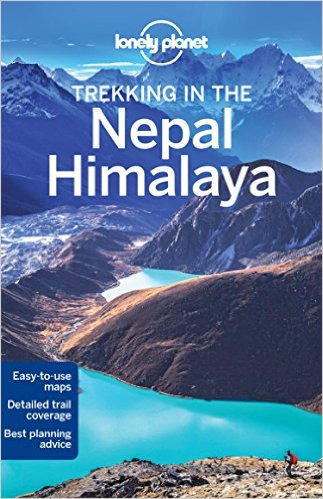
The Three Passes Trek is quite challenging as it involves traversing very high passes over 19 days of trekking. For this reason, we do not recommend trekking solo or without a guide who will have extensive knowledge and experience of trekking in the region.
A good guide book with a map, however, can be very useful when wanting to learn more about the area or when searching activities to do on your rest or acclimatization days.
The Lonely Planet Trekking in Nepal Himalaya guide is a regularly updated and informative guide that will include maps and sightseeing opportunities for a variety of treks in the region.
In terms of a map we recommend Nepa Maps – Three Passes and Everest Region map.
Detailed Itinerary
As with all treks, your journey to trek the Three Passes will start with an international flight into Kathmandu. A short flight to Lukla will precede the start of the trek that takes you through the Dudh Koshi valley before looping around through Gokyo and heading to Everest Base Camp. The inwards leg will take you east over your final pass and back to Lukla.
Most tour operators will list the Three Passes Trek as an 18/19-day trek. Of these days, usually 15 will be spent trekking with a further 1 or 2 acclimatization days, meaning 14 days of actual trekking can be expected.
Day 1: Arrive in Kathmandu
Arrive in the capital of Kathmandu after what is sure to be a long flight from home. Make your way to the hotel where you can relax for a bit before setting out to explore some of the vibrant city.
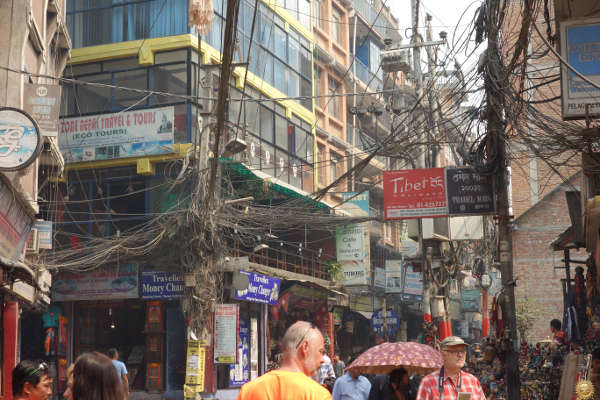
Vibrant streets of Thamel, Kathmandu
Day 2: Fly from Kathmandu to Lukla. Trek to Pkadking
An early morning flight will take you to Lukla, the starting point of the trek. Despite being only 35 minutes, the flight is a memorable one! Try to sit on the right-hand side of the plane for the best views of Everest as you approach Lukla.
The trek starts with fairly short descent to Phadking, where you will pass stone walls decorated with prayer inscriptions – called Mani in the local language. You will spend the night in Phadking.
Day 3: Trek to Namche Bazaar
The trek to Namche Bazaar will see you enter the Sagarmatha National Park , a UNESCO World Heritage Site. The village of Namche Bazaar is the central trading post of the region and is always bustling with life.
Day 4: Acclimatisation Day
Day 4 is an acclimatisation day spent in Namche Bazaar. Explore the village, stock up on some much-needed snacks for the trek ahead and be sure to check out the bakery – one of the best! The market on a Saturday is also a major attraction.
Day 5: Namche to Thame
The trail now splits from the popular base camp route and heads north-west through the small Sherpa village of Thamo before reaching Thame, where you will be staying the night. Take some time to learn a bit about the local traditions and their intrinsic connection with the mountain on which you are standing.
Day 6: Thame to Lumde
4-5 hours of trekking will see you cross the Bhote Koshi river before heading up the valley to Lumde. As you start to gain altitude you should get some great views of the snow-capped peaks in the region.
Day 7: Lumde over Renjo La to Gokyo
Today you will encounter your first of the Three Passes – Renjo La. The route starts off easy but will soon turn into a hard day of hiking as you near the end of the ascent of Renjo La. Try to think of the magnificent views you will get at the top to motivate you!
After the pass, you will descend to the third of the Gokyo Lakes and then trek onto the village of Gokyo for the night. After some rest you can even climb up the ridge to get some amazing views of the lakes, the highest freshwater lake system in the world.
[adinserter block="5"]
Day 8: Gokyo Ri (Acclimatisation Day)
Today you climb your first peak Gokyo Ri for fabulous views of Cho Oyu. You will do this climb early and then have the rest of the day to rest.
Day 9: Gokyo to Thaknak
Cross the Ngozumpa Glacier – the largest glacier in Nepal – over the course of an easy day’s trekking. Once again, keep your camera close as you trek through this beautiful part of Nepal!
You will reach Thaknak where you will go on a small acclimatization hike before lodging for the night.
Day 10: Over Cho La to Zungla
Often considered the hardest day of the trek, today involves traversing the second pass of Cho La. At over 5,300m, reaching the top will require some effort.
You will spot the famous prayer flags as you near the top of the pass, after which you descend over the other side of the pass to reach Zungla.
Day 11: Zungla to Gorak Shep
Start the day with an easy downhill portion to reach Lobuche, one of the major stops on the classic Everest Base Camp Trek. Join up with the crowds of trekkers as you make your way to Gorak Shep.
You will be afforded great views of the famous Khumbu Glacier as well as the peaks of Everest, Lhotse and Nuptse. Spend the night in the busy Gorak Shep.
Day 12: Gorak Shep to EBC and back
A short trek following the ridge of the Khumbu Glacier will take you to the Everest Base Camp. Make the most of your time here, as trekking groups are not typically allowed to stay overnight at the base camp.
Feel the buzz and excitement of the place, packed with potential future summiteers of Everest! Descend later that day down the same ridge back to Gorak Shep for some much-earned rest and sleep.
Day 13: Kala Patthar hike and then onto Lobuche
An early morning start is needed to summit the trekking peak of Kala Patthar – the iconic viewpoint of Everest. After snapping some pics, head back to Gorak Shep for a quick meal before descending further to Lobuche for the night.

View of Everest, EBC and Khumbu Glacier from Kala Pattar
Day 14: Kongma La Pass and onto Chukkung
You leave the classic base camp route today as you head east through the Khumbu Glacier to reach the third and final pass of the trip – Kongma La Pass. At 4,700m the pass is the highest of the three and lacks any shops or tea houses along the way.
After a tiring ascent to the top, descend into the Chukkung Valley and eventually to the village of Chukkung where you will stay in the lodge overnight.
Day 15: Chukkung Ri and then to Dingboche
Today you will climb Chukkung Ri (5,550m) and trek to Dingboche (4,410m)This peak is the hardest of the three you can attempt on this treks and involves some easy scrambling near the summit. The views from the top down the Khumbu Valley are superb. You descend to Dingboche where you will stay in a lodge overnight
Day 16: Dingboche to Namche Bazaar
A downhill trekking day will take you through the verdant fields and rhododendron covered hillside on your way to Namche Bazaar. Pass through the village of Khumjung where you can eat lunch before completing the descent to Namche Bazaar where you will stay overnight.
Day 17: Namche to Phakding
You continue through Namche Bazaar, descend Namche Hill and cross the Dudh Koshi. You are now sauntering back along familiar paths to Phakding. Overnight lodge.
Day 18: Phakding to Lukla
The last day of trekking will take you through some lovely pine scented forests before reaching Lukla where a cold drink and a hot meal await you!
Day 19: Fly back from Lukla to Kathmandu
Weather permitting, catch the morning flight back to Kathmandu to end off what is sure to be the trip of a lifetime.
Day 20: Depart Nepal
After your last night in Nepal, make your way to the airport to hop onto your flight back home, where you can tell all your friends and family about the time you had!
Altitude Profile
The altitude chart below shows the typical progression of the Three Passes Hike through the major stopping points along the way. The three spikes of the passes are clearly visible along with the spike of Kala Patthar – the iconic viewpoint.
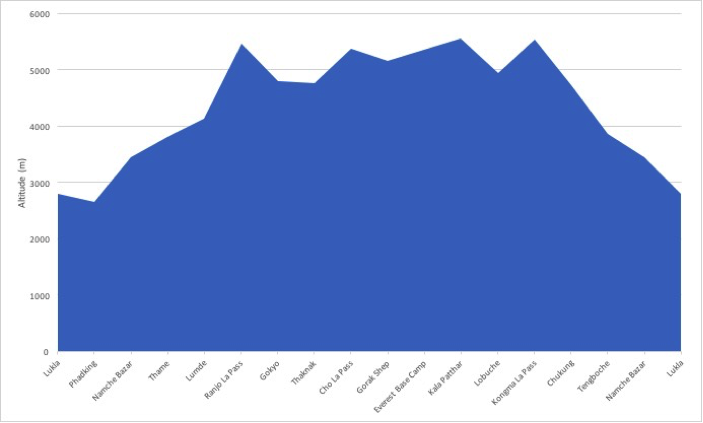
The ascent profile of this trek is slightly harder than the classic Everest Base Camp trek because it involves rapid ascents of the passes.
Three Passes Trek FAQ
How much does the three passes trek cost.
Tour operators will charge in the region of £1,200 to £2,500 for a guided Three Passes Trek. We definitely recommend using a tour operator for a trek of this difficulty and length – preferably a western tour operator whose guides and equipment will be of a higher standard.
The cost will include all board and lodging for the 18 days, all domestic travel and domestic flights, meals, shared equipment and knowledgeable guides. For a detailed breakdown of costs on the classic Everest Base Camp Trek, read our article here .
When is the best time to trek the Three Passes?
As with all treks in the Everest region, it is advisable to avoid the winter months as well as the peak summer months during the monsoon season. The shoulder months of February-May and September-October provide the most stable and dry weather conditions for trekking.
Our detailed article on the best time to trek in the Everest region will give a much more in-depth analysis of the conditions faced in different months.
How difficult is the trek?
The Three Passes Trek is considerably harder than the classic Everest Base Camp Trek so we recommend you have a good fitness level before embarking. Ascending the high passes involves long days of strenuous trekking that would not be encountered on the classic base camp trek and other variations.
6/7 hours of trekking per day is to be expected and altitudes of up to 5,500m are reached on the trek. That being said, the trek is still very popular among people wanting a bit more of a challenge. Read our training article to get an idea of how much you should prepare for a trek in Nepal.
Will I get altitude sickness?
Despite crossing some very high passes, the trek has been designed to follow the principle of trek high, sleep low. That means that you will not be spending extended periods of time at altitudes above 5,000m. The itinerary also has acclimatisation days as well as nights spent at lower altitudes to help the acclimatisation progress. If you follow the guide you should not have a problem.
That being said, altitude sickness can affect anyone regardless of age or level of fitness so we recommend doing some preparation reading. Our detailed article on altitude sickness and acclimatisation is a good starting point.
What gear should I pack for the Three Passes Trek?
The packing list for a trek of this length can look quite long! For this reason, we have dedicated an article to help you tackle the challenge that is packing. In our Everest Base Camp Trek packing list we provide list of clothing and equipment that you should bring, as well as some brands that we recommend based on our experience of using them.
What insurance do I need?
The short answer is yes. Trekking in Nepal at high altitudes comes along with various risks that are not covered by typical travel insurance. We recommend taking out insurance that covers trekking to altitudes up to 6,000m as well as medical evacuation from the mountain.
We have a detailed article to help to find the best policy that will suit your needs. Alternatively, use the quote calculator below from our recommended partner, World Nomads. They offer insurance that covers guided hikes up to 6000m and include a premium for Helicopter Evacuation in Nepal.
Route Variations
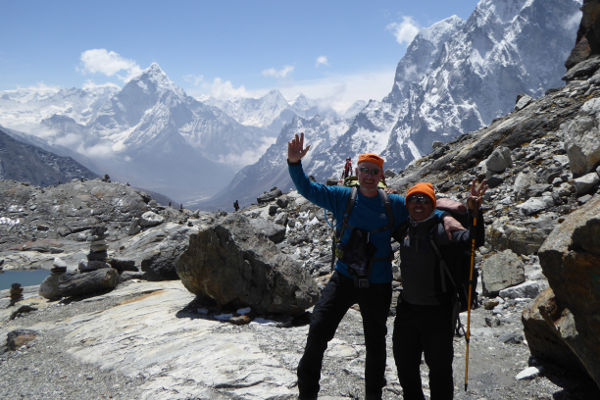
One of the more popular variations of the Everest Base Camp Trek , the Gokyo Lakes Trek, also starts at Lukla and follows the classic base camp trek to Namche Bazar where it forks north-west.
The trek proceeds through the towns of Dole and Machhermo before reaching the stunning Gokyo Lakes. From there you ascend to the peak of Gokyo Ri in the north, before traversing Cho La Pass and re-joining the classic trek at Lobuche.
The detour adds 2/3 days onto the trek but provides the wonderful opportunity to summit a peak while also avoiding some of the busier parts of the trek.
Gokyo Lakes Trek
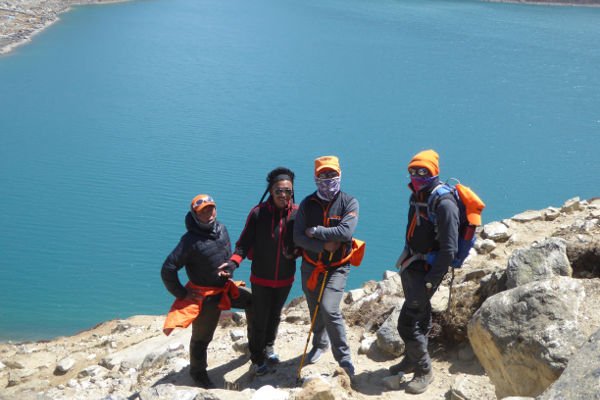
One of the more popular variations of the Everest Base Camp Trek, the Gokyo Lakes Trek, also starts at Lukla and follows the classic base camp trek to Namche Bazar where it forks north-west.
Jiri to Everest Base Camp

This variation of the classic trek offers an alternative to flying into to Lukla from Kathmandu to start the trek. The Jiri variation starts with an 8-hour bus ride from Kathmandu to Jiri, where the trek begins.
The variation adds an extra 5/6 days onto the trip as you trek through the Solu-Khumbu region and make your way past Lukla, where the trek then follows the same route as the classic Everest Base Camp Trek.
It involves a scenic, yet very long, bus ride as well as a lot more exposure to the Tibetan and Sherpa cultures. Expect to trek through more forests and streams as you start at the relatively low altitude of 1,800m and work your way up to Lukla and beyond.
Island Peak Climb

The variation trek that involves summiting Island Peak is significantly harder than the classic Everest Base Camp Trek. The climb to the peak is somewhat technical although and requires basic knowledge of using crampons and ice axes. Standing at just under 6,200m, however, altitude can be the real challenge.
Most climbers of Island Peak use the traditional base camp trek as a means of acclimatising before heading to the Island Peak Base Camp via Dingboche on the main trail, or by traversing the Chongma La pass. Summiting from the base camp typically takes two days and the whole variation will add around 4 days onto the classic trek.
Mark Whitman
Hi, I'm Mark! Welcome to EBC Trek Guide - the Web's No.1 Trekking Guide to Everest Base Camp. I have trekked all over Nepal, but the Everest region remains my favourite. I hope you find all the answers you are looking for on this site. If you have any questions don't hesitate to drop a comment below! Happy Trekking!
Leave a Reply
Your email address will not be published. Required fields are marked
Thank you. How slippery or rocky is the terrain on cho la pass? I don’t feel comfortable boulder hopping or walking on slippery terrain. You can train for uphill or distances but being able to balance on icy or scree surfaces is something else. We are looking at going in october . Any comments would be most welcome.
Hi Brigitte, the Cho La Pass consists of mix terrain that can vary quite considerably depending on prevailing weather conditions during the week you go. In general through you can expect mixed rock / scree terrain with areas that can be a little slippery with black / blue ice. Careful footing throughout is important. Show cover is quite likely too so it is worth taking basic yak tracks just in case you need additional grip. Hope this helps!
Is the path traveled and visible? Are there cairns, that Point the pass? Are there some kind of signs along the path? Is it easy to get accommodation for the night? Thank you
Hi Francisco, the three passes trek does follow a well defined route but it is not very well signposted. I would recommended taking a guide and / or getting a detailed map of the region. Accommodation throughout the route is not a problem, there are many small villages on the route and all have teahouse accommodation for trekkers. All the best!
What do you do for food along the route? The 3 peak pass in particular. Do you buy food for the day at every tea house? Thanks
Hi Frank, there are lots of teahouses along the Three Passes trek. In terms of lunch you can usually find a teahouse to stop at half way through your daily trek, or take a snack with you and only stop for dinner.
Thanks for the reply Mark!
Thanks for the useful information. Is this trek possible late December-early January? I did ACC last year late Dec-early Jan (including Tilicho), and it was wonderful, although desperately cold at higher altitudes. I assume this trek is colder as I would spend more time at higher elevation. I also appreciated that although less crowded that time of the year, there was good company in the higher teahouses and passes. Although I have no problem trekking alone, I would not feel completely comfortable spending days around 5000m completely alone. So my question would be, is this trek less crowded generally and colder than Annapurna Circuit?
Hi Daniel, I would say this trek will be colder than the Annapurna Circuit in Dec/Jan as you spend a lot more time at high altitude. The passes are also prone to closing in the winter if the weather is bad and there has been a lot of snow fall. I would definitely recommend taking a guide if you plan to trek the three passes.
I am planning for three pass trek in the first week of may. I have 15 days Itinerary. Is it possible to get it done including island peak. I am fit and I have plan to walk 9 hours per day. Plz let me know.
Thanks & Regards, Gopal
Hi Gopal, it’s possible to complete the 3 passes trek in 15 days, but the risk of altitude sickness (unless you are pre-acclimatised) is pretty high. Adding in Island Peak in addition would be a big ask, but doable if you are super fit and deal with the altitude well on the passes trek.
Hello there. I’m planning on attempting the 3 passes trek November 20-Dec 9 of this year. Is there a reason that you suggest clockwise? Most of the other places I have seen are suggesting counterclockwise. Any info would be greatly appreciated. Thanks!
Hi Murphy, thanks for getting in touch. I have no strong preference for either format. The reason why I suggest the clockwise route is because this is the I followed when completing the 3 Passes. The counterclockwise is equally as valid though.
Hi Mark, I am thinking about doing the Three Passes Trek. I have done Kilimanjaro one year before and further I do sport (mostly running, climbing, cycling) 3-4 times a week. However, I have never trekked for 19 days at high altitude and I don’t do a lot of trekking in my free time. Neither do I live in a place where my body is accustomed to higher altitude. I wonder if this is a trek I could do? Thank you in advance for your thoughts.
Hi Elene, you definitely sound fit enough to complete the 3 Passes. The key is to pace yourself, build in enough acclimatisation days to get accustomed to the high altitude, and make sure to look after your health with a good diet throughout. If you completed Kilimanjaro, you can definitely do the Three Passes. All the best!
Hi Mark thanks for all your useful information. I’m hoping to complete the Three Passes soon. I have years of experience. When would you suggest is the earliest I can expect to safely complete it. Mid-February OK?
Hi Rick, mid Feb can still be quite snowy and the passes may be closed. If you can push your dates a little bit further out – to mid March – then the probability of closed passes reduces (obviously there are no guarantees though). All the best!
Get a quote from the best local trek operator in Nepal!
- Three Passes Trek Packing List
- Everest Trek Guide
- Nov 30, 2020
- Index Adventure
The tall mountains look down on you, and you feel like mere dust in front of such a massive structure. But you do not go trekking to feel good about yourself, do you? Trekking is all about patience, about hard work, and the astounding views. You will suffer, you will cry, and you will not shower for weeks. All these are what you will feel in the three passes trek .
In this article, I am going to talk about the three passes trek packing list . You will not be able to enjoy your journey if you do not pack wisely. You need to pack light yet enough for three weeks. Yes, three weeks is what it will take you to complete this trek. Also, keep in mind that you will not be able to take a proper shower once you leave Namche behind. So hygiene becomes the major issue in these trekkings.
Here I am going to talk about some of the most important items you must pack. I will also be talking about the aftermath of not packing well. In this article, I am going to focus on both solo and group travelers.
Without further ado, let us explore the beauty of the three passes trek. Let us know everything there is to know about the three passes trek packing list. Let us embrace nature and what she has to offer.
Trek details:
Duration: 17 days
Start/end: Kathmandu/Kathmandu
Max altitude: 5643 (Kala Patthar)
Difficulty: Challenging
Accommodations: Few hotels and lots of tea houses
Minimum temperature: -15 degree Celsius
Related: Gokyo valley trek Everest three High pass trek Gokyo Ri trek Sagarmatha national park
For more detaild information about the treks please Contuct us .
Table of Contents
Primary stuff to pack.
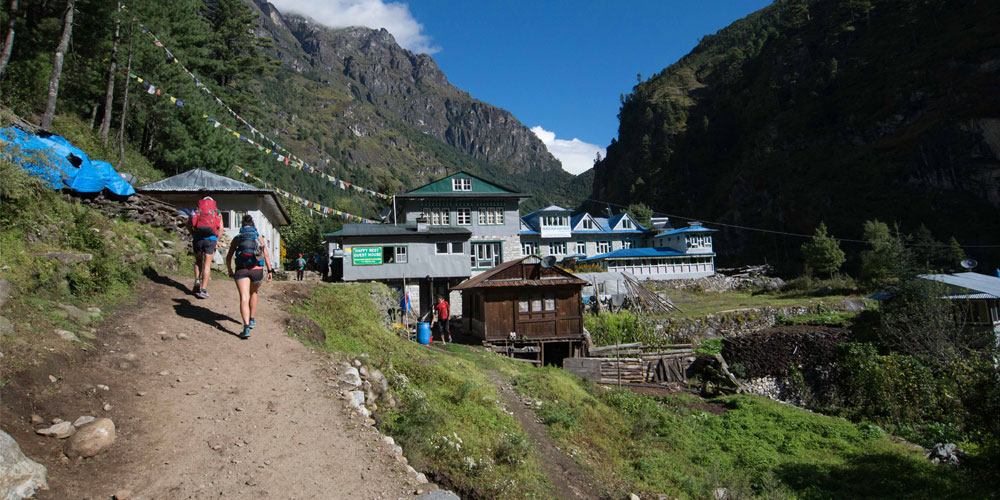
First of all , I suggest you do a health insurance . Some health insurance covers the emergency helicopter return up to 6000m. It will save you a few bucks.
Second, you would want to download Maps.me app on your phone. After that you have to download the map of the country you are visiting (in this case Nepal).
A high-capacity power bank is one of the most important items for you to pack. Charging your phone in Everest region can cost you more than accommodation.
You do not want your backpack to be heavy. This trekking route offers you one of the hardest paths. Also, you can complete this route without a guide or a porter. However, I suggest you get a guide and a porter if you are traveling solo or in groups. Make your backpack as light as possible. Even if you hire a porter, they are not superhuman.
Let me start with important documents and cards.
Many trekking routes in Nepal require permits for foreigners to get into. You will find a checkpoint at the entrance of Namche Bazaar. Make sure you have all the following items.
- Valid passport
- Any insurance papers if available
- Extra passport size photos
- Credit cards and bank ATM
- Cash to get a permit
- Get a sim card at Kathmandu.
You better make a copy of the important documents. Also, do not throw the permits away. There might be times when you have to show them.
Now that we have covered the important paper works let us go through the primary accessories and clothing.

Upper body:
Your upper body needs to be warm while resting and breathable while hiking. Do not forget to get lightweight items . The following list includes the necessary clothing. You can add or lessen the items according to your convenience.
- 1 half sleeves shirt
- 2 full sleeves shirt
- Thermal tops . I suggest you pack more than one thermal tops. The temperature in the Everest region can drop low. And multiple layers of thermal tops will make you warm.
- Wind stopper jacket is important. You can pack a pullover as well.
- Do not forget to pack a down jacket.
- Waterproof jacket
- 2 sports bra (for ladies)
Lower body:
The lower body is where you will get cold soon. Also, the lower body needs to be in proper hygiene. Make sure you do not pack anything that does not suit your skin.
- Enough underwear (non-cotton). I would suggest 5 underwears.
- 1 pair of convertible hiking pants
- 1 pair of lightweight hiking pants
- 1 pair of thermal trousers
- 1 pair of hiking trousers
- 1 pair of woolen trousers
- 1 pair of waterproof shell pants
- 1 pair of leggings
Everything starts with your head. You must keep your head warm at all times. You would not want to catch a fever or headache at such times.
- Make sure you pack a headscarf. A Bandana or a buff can be an excellent choice as well. These are great for dusty trails.
- A warm woolen hat that covers your ears
- Wide straw hat. It will protect you from the sun. Make sure your hat is foldable.
You need to make your hands free at most times. At the same time, you need to keep them warm and firm. Here are a few things you must pack for your hands.
- 1 pair of lightweight woolen gloves
- 1 pair of poly liner gloves
- 1 pair of mittens. Sometimes the gloves are not enough for your hands to stay warm. You will need mittens at such conditions.
Make sure you keep your feet dry. Remove the hiking shoes and let them try in the sun or by the fire. Check your socks and always wear the dry ones.
- 3 pair of thin woolen lightweight socks
- 2 pairs of heavy woolen socks
- 1 pair of lightweight hiking boots (must be broken-in and water-resistant)
- 1 pair of running sneakers
- 1 pair of sandals (optional)
Travel bags
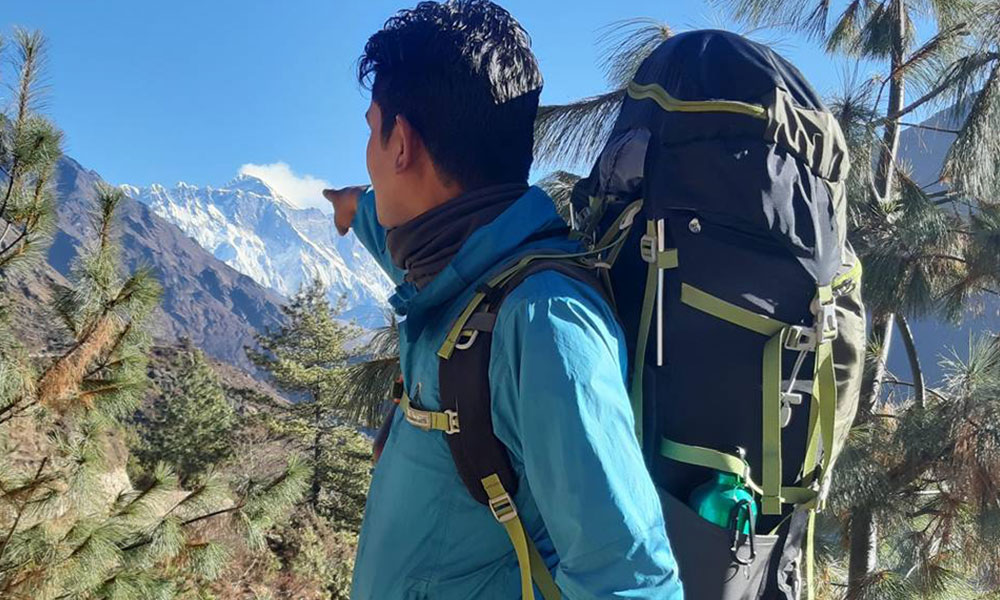
Carrying a travel bag depends upon different conditions. You need to consider if you are taking a porter with you or not. Many trekkers take porters with them. But there are many others who like to carry their weight themselves.
- 50 to 70 liters hiking bag (compulsory)
- A small backpack (only if you are taking a porter with you)
- Waterproof covers for your bags
All the lodges in Everest region offer you extra blankets. So it is not mandatory for you to pack a sleeping bag. Pack a waterproof, lightweight sleeping bag compatible with -10 degrees C (if you need to) .
You need to maintain your personal hygiene . The three passes trek involve the Everest Base camp trekking and the Gokyo lake trek. It is one of the longest if not the longest treks in Nepal.
And you will not be able to take a hot shower throughout the journey. There are some places that offer you a hot shower. But these places are expensive.
Also, this trekking route is one of the most challenging trekking routes in Nepal. Most of the times, you will be hiking over 4000 m altitude. All these passes are over 5000m from the sea level.
Altitude sickness is deadly and can happen to anyone. It’s better to pack measures for different sickness.
You might get wounded through the journey. Here is some medical stuff you must pack for this trek.
- Small first-aid kit (optional)
- Anti-headache pills
- Band-aids and first-aid tape
- High-quality bandages
- Knee pads or knee bandages (mandatory)
- Cold medicine
- Antibiotics
- You need to pack the water purifier tablets. You will be drinking tap water most of the times. A water purifier tablet is good to purify such water.
- Skin blister repair kit
- Medicines for your stomach. Anti-diarrhea medicines are necessary. Make sure you have tablets for acidity as well.
Most of these medicines are available in Kathmandu without prescriptions. But I suggest you visit your doctor beforehand. You must buy those medicines which suit your body.
Personal hygiene and toiletries
The Everest region is remote, and there are a few pharmacies in less remote parts. Also, maintaining your personal hygiene is hard in these regions. Your body does not meet its regular requirements.
Very less shower is what you will get in these regions. You will never know how well will your bowel movement be. So, personal hygiene and toiletries are a must in the three passes trek packing list.
- Quick-drying lightweight towel
- Toilet papers are not available at high altitudes. You must have some of them.
- Toothbrush and toothpaste
- Biodegradable soap (organic)
- You will get sunburn even in the morning when you move towards the higher altitude. Therefore, do not forget to pack a sunscreen with at least 50 SPF.
- Hand and body moisturizer
- Sunblock lip care or chapstick
- Sanitary pads (female)
- Baby wipes are necessary. You will not want to or do not get to shower in such a region. Use baby wipes once you reach your destination.
Other accessories:
There are some other items you would need. Some of these are optional. You can pack according to your convenience.
- GPS tracker
- 1 pair of portable and retractable crampons
- Headlight with a strap
- You might need large ziplock in your journey. It is because you might want to leave your backpack at a hotel. The ziplock will secure your backpack.
- One small military folding Knife
- Waterproof speaker
- Portable high-capacity power bank to charge your mobile
- Multi-port USB fast charger
- An extra phone that lasts long in terms of battery charge
- Rechargeable camera batteries
Conclusion:
The three passes trek is one of the most challenging trekking routes in the world. This trekking offers you some of the best views one can get. You will be able to summit peaks that are over 5500m. You will walk on glaciers and across rivers.
This ultimate journey will be the best time of your life if you know the basics. You have to pack wisely for this journey. The three passes trek packing list is longer than other trekkings. This trekking is itself long and tiring.
You can buy most of these items in Kathmandu. They are cheaper in comparison. Plus, if you can bargain with the shop-owner, you will get the real items in much less price.
I hope this article is helpful.
Sagarmatha National Park is a world heritage site. This place is home to many animals and plants. Make sure you do not harm these rare species. Make sure you keep your environment clean. Do not make this beautiful place a dumping site. Make sure you follow the Nepal government and local rules.
Send an Inquiry
Recent post.
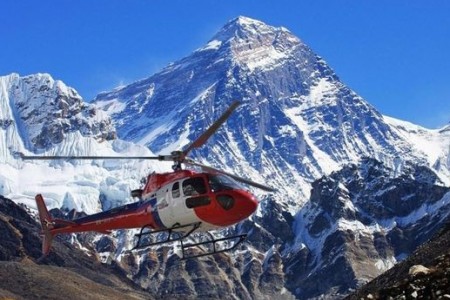
Why to choose EBC helicopter tour?
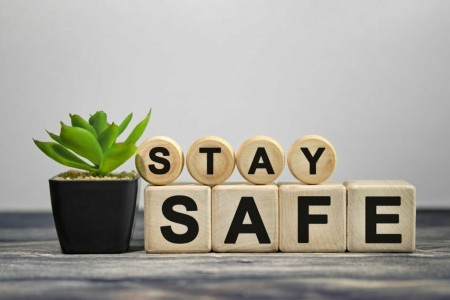
Safety tips for helicopter tour
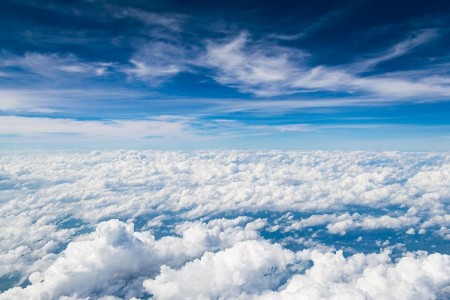
Flying to the top of the mount Everest
Related posts.
- 3 Days Trek To Everest Base Camp
- Everest Base Camp Packing List for October and November
- Everest Base Camp Luxury Lodge Trek - Ultimate Guide
- Gokyo Ri Trek Sagarmatha National Park
- Three Passes Trek Difficulty
- EBC Chola Pass Gokyo trek
- Gokyo Lake Trek Difficulty
- Gokyo Renjo La Pass Trek
- Adventure Activities
- Annapurna Trek Guide
- Bhutan Tour Guide
- Kanchenjunga Trek Guide
- Langtang Guide
- Manaslu Trek Guide
- Mardi Himal Trek
- Mustang Guide
- Peak Climbing
- Uncategorized
- Visit Nepal Year 2020
Index Adventure Pvt. Ltd.

Three Passes Trek Complete Overview | Kongma La, Cho La, Renjo La
By: Author Charles
Posted on February 3, 2023
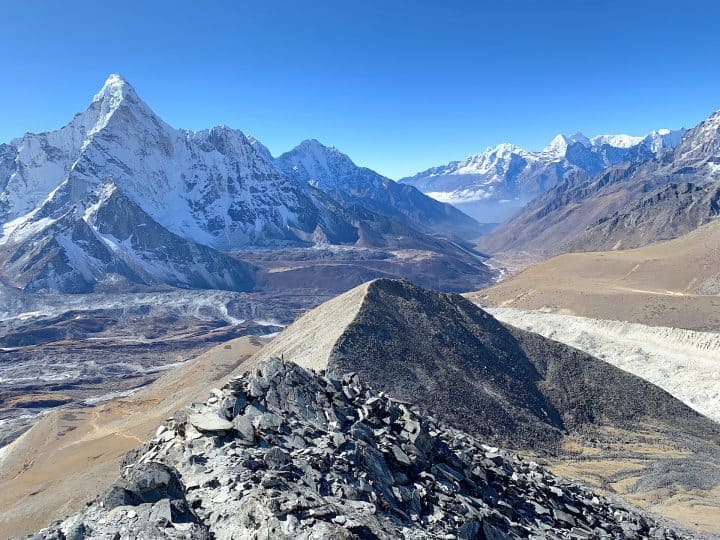
The Three Passes Trek of the Himalayas has to be one of the ultimate multi day hikes in the world. For nearly three weeks you will get to experience stunning landscapes, summit several high-altitude peaks, head over the majestic Three Passes, and even get to visit Mount Everest Base Camp.
There is just so much variety during the Three Passes Trek and once you finish your time in the Himalayas, you will be left with some truly one of a kind memories.
For any outdoor enthusiast who wants a little bit of everything and is willing to work for those views and experiences, then the Three Passes is for you.
The purpose of this guide will be to give you an absolute and complete detailed overview of what the trek entails. Everything from a day by day itinerary, costs & logistics, and helpful maps & trekking details, this guide will have it all.
As I am sure you may have some questions along the way, feel free to write them in at the end of this guide. Hope you enjoy the read!
* Affiliate Disclosure : This post may contain affiliate links, which means I may receive a commission if you make a purchase through the links provided, at no additional cost to you. Thanks for supporting the work I put into TripTins!
1) Trek Overview & Background
While most people who visit this region of the Himalayas just head on the classic 11-day Everest Base Camp (EBC) trek , there is also an option to extend the journey into a more holistic view of the region.
That is where the Three Passes Trek comes into play. You not only get to visit Everest Base Camp, but you also get to head over three stunning mountain passes (Kongma La, Cho La, and Renjo La), head to the Gokyo region, and take part of additional trekking peaks not on the classic EBC route.
This trek is not meant for everyone out there as it is a quite demanding journey to take part of. But if you have the time, the fitness, and the mindset, then I highly recommend you consider the Three Passes trek for your trip.
Below is a high-level breakdown of some of the main metrics of the trek. In the next couple of sections I will break this down into a day by day detail.
Trek Name : Three Passes Trek
What Are the Three Passes : Kongma La, Cho La, Renjo La
Location : Sagarmatha National Park | The Himalayas
# of Days : ~18 days
How Many Miles is the 3 Passes Trek : 112 miles / 181 km (including day hikes)
Elevation Gain of the 3 Passes Trek : 35,771 feet / 10,900 meters (including day hikes)
Duration : 4 – 10 hours per day (depending on fitness level)
You can see I mentioned “including day hikes”. That is because there are several “add on” acclimatization hikes / day hikes that can (and should) be added to your itinerary. You will see those listed out in the next section below as I dive into the day by day itinerary.
2) Three Passes Trek Itinerary
Below is the day by day Three Passes Trek itinerary that takes you from village to village around the region & on those additional day hikes. Note that there is not one size fits all itinerary.
The trip can be broken down in many different ways but I believe this is a fantastic option to start with.
Day 1 : Fly to Lukla & Lukla – Phakding
Day 2 : Phakding – Namche Bazaar
Day 3 : Acclimatization Hike to Hotel Everest View
Day 4 : Namche Bazaar – Tengboche*
Day 5 : Tengboche – Dingboche*
Day 6 : Acclimatization Hike to Nangkartshang peak
Day 7 : Dingboche – Chukhung**
Day 8 : Acclimatization Hike to Chukhung Ri
Day 9 : Chukhung – Kongma La Pass – Lobuche
Day 10 : Lobuche – Gorak Shep & Trek to Everest Base Camp
Day 11 : Kala Patthar & Gorak Shep – Dzongla
Day 12 : Dzongla – Cho La Pass – Gokyo
Day 13 : Hike up Gokyo Ri
Day 14 : Hike to the 4 th & 5 th Gokyo Lakes
Day 15 : Gokyo – Renjo La Pass – Lungde
Day 16 : Lungde – Namche Bazaar
Day 17 : Namche Bazaar – Lukla
Day 18 : Depart Lukla
* There is also the option to add a visit to Ama Dablam Base Camp to your trek as well . This would not add any additional days to the trek. On Day 4 you can trek from Namche to Pangboche (Pangboche is right between Tengnoche & Dingboche), and then on Day 5 you can visit Ama Dablam BC in the morning before heading to Dingboche in the afternoon.
» Read more about that experience in the Ama Dablam Base Camp trekking guide
**After arriving in the village of Chukhung, you could also opt for an afternoon day hike to Island Peak Base Camp.
Later on in the guide I will give a bit more overview of each day and include links to each day’s hiking guide if you would like even more detail.
3) Three Passes Trek Map
Now that you have an idea of what the day by day itinerary will look like, let me show you what that looks like on a map. I have included the Three Passes trek on a Google Maps view so you can zoom in and out of the map and explore each day’s route.
» The blue routes are the trekking routes from village to village along the trek. You can see each village pinpointed with a blue pin as well.
» In red, yellow and purple you can see the routes for the days that the trek crosses over each of the three passes (Kongma La – red; Cho La – yellow; Renjo La – purple).
» You can also see pinpointed in black are several hiking markers. These represent all of those acclimatization and side hikes you can add onto your overall trekking journey.
Note: some of the routes I had to hand draw in there since the map wasn’t picking up the walking routes. Please consider what you see below to be estimates of the exact trail location. I would recommend an app like Maps.me for a GPS guided route on the trail.
4) Clockwise vs Counter Clockwise
While we are on the subject of the itinerary and map, let’s talk about which direction the route should be completed in. As you can tell by now, I went about it in the counter clockwise direction (starting with Kongma La and ending with Renjo La).
However, there is also the option to complete the trek in the clockwise direction – starting with Renjo La and ending with Kongma La.
During my time on the trail, I would estimate that around 75% of people on the Three Passes were doing so in the counter clockwise direction. Looking back at my trek, I see pros and cons for both directions.
Counter Clockwise Pros / Clockwise Cons
» There is one main reason why most prefer to do the trek counter clockwise, and that is due to the overall acclimatization of the hike.
If you go clockwise, on day 6 you will already need to climb up to 5,360 meters / 17,585 feet on the Renjo La Pass and then sleep at 4,750 meters / 15,584 feet in Gokyo.
This is compared to getting Dingboche on day 5 at 4,410 meters / 14,469 feet, spending a couple nights there with an acclimatization hike to 5,083 meters / 16,676 feet on Nangkartshang Peak.
Overall, it is just a better acclimatization schedule going counter clockwise vs. clockwise.
» Another reason why going counter clockwise is said to be better is due to the Kongma La Pass. If going uphill over the Kongma La Pass in the clockwise direction (Lobuche to Chukhung), it will probably be the hardest single push of trekking on the entire trek . It is a very long and tedious section of trail, and I can see why more people would rather go down it than up it.
» And lastly, a third reason why counter is preferred is because the views between Namche Bazaar and Chukhung are much better in the counter direction than the clockwise . Going counter clockwise, you will have the Everest mountain range and Ama Dablam out in front of you – something you would miss if going clockwise.
Clockwise Pros / Counter Clockwise Cons
In my opinion the biggest reason to hike clockwise is that the best views will always be out in front of you on the passes themselves .
As you head clockwise over Renjo La, Mount Everest and Gokyo will be awaiting, over Cho La the glacier will be right in view, and over Kongma La you will be walking towards the turquoise lakes.
While you will still have all of these views to enjoy in the counter clockwise direction, you will need to turn around to see them. Since you will probably have several breaks along the way, this may not be too big of an issue. You will also be able to sit back and enjoy the views from a top the passes too.
But if you want the best views out in front of you as you descend the passes, then clockwise is the better option.
5) Elevation Gain Profile & Distance Breakdown by Day
I believe the chart below is one of the most helpful pieces of information you should study for your trip. It is a complete breakdown of the daily distance, elevation gain, and trekking times for each day of the journey.
This will give you a much more accurate representation of what to expect out on the trek compared to more high-level numbers you may come across.
I put together a similar chart for the Everest Base Camp trek distance & elevation gain if you are interested in checking that out as well.
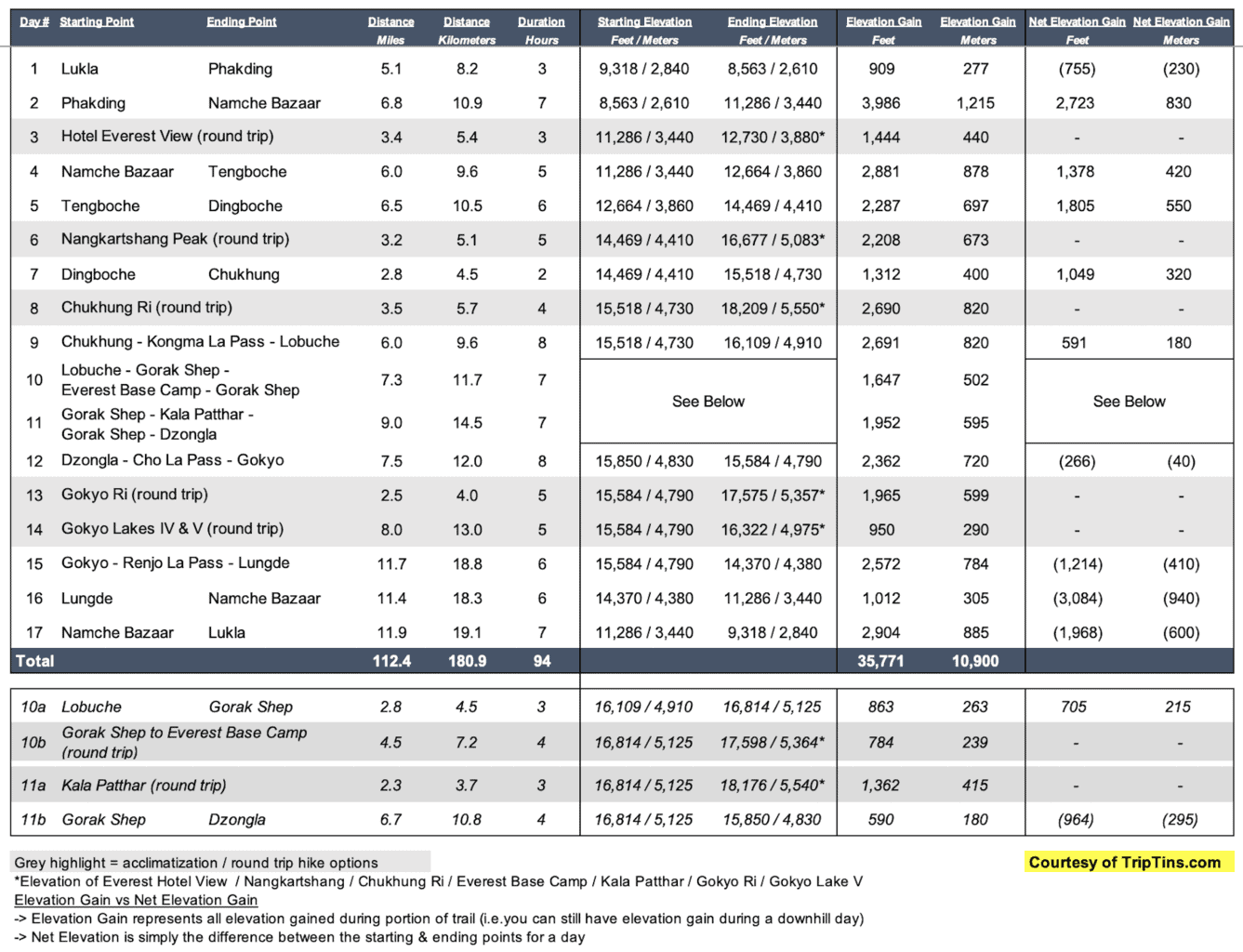
6) Three Passes Trek Cost Breakdown
There are a few different ways to go about the Three Passes Trek and depending on your choice, that can have a significant impact on the cost of your trip. The main options here include:
1) Fully Independent
This option really speaks for itself. You take care of all logistics, carry all your own gear, and head out into the Himalayas on your own.
2) Hire a Porter / Porter Guide / Guide (or multiple)
If you would like to support the local community a bit more, hiring a porter, porter guide or guide is a great way to go about the trek.
» A porter is someone who simply will carry your belongings from one village to the next while you may just carry a daypack. Porters usually do not speak any English at all.
» A porter guide is someone who will carry your belongings and speaks broken English.
» A guide is someone who speaks good English but will not carry any of your gear.
As you may imagine a porter is the cheapest option (+$15 per day), porter guide is in the middle ($20 per day), and a guide is in the most expensive ($30 per day). During my time on the trail I also saw small groups (2-4 people) who would hire a couple porters and a main guide, so you can opt for something like that too.
3) Join a Fully Guided Trek
The most expensive option here is to join a fully guided trek that will take care of all logistics for you from beginning to end. These costs usually include teahouses, food, porters, guides, logistics pre and post trek, flights, etc. For the most part, you can simply show up and be on your way.
These can really range in price. You can join a trek put together by a local trekking company which can cost around $1,500 or you can join a western based operator whose prices can reach well over $2,000.
If you don’t opt for the third option here, the below cost breakdown for an independent 17 day trek will get you going in the right direction. If you decide to hire a porter, porter guide, or guide then you simply can look at the bottom of the chart below (don’t forget about tipping your porter/guide too!).
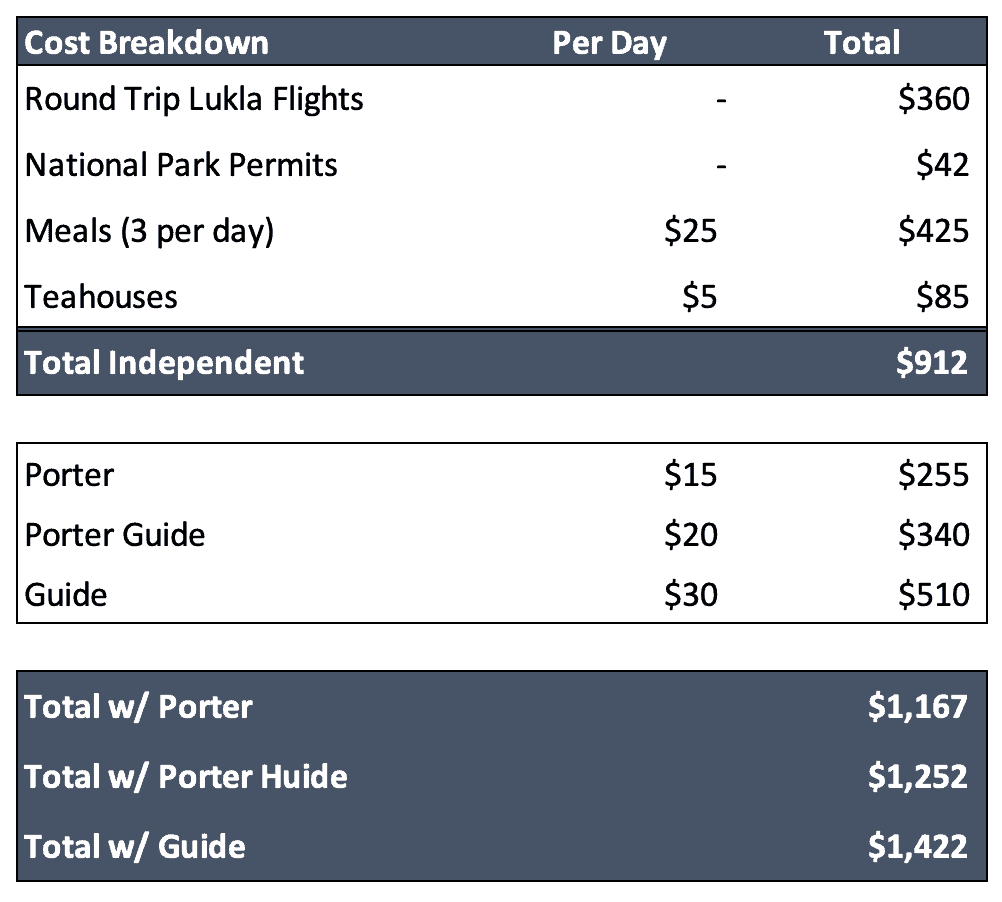
7) Himalayas Packing List
To have a successful Three Passes trek, you will need to come prepared with the right gear. Remember, this is an 18 day trek and it will very likely include some cold conditions along the way. By utilizing the packing list below, you should be in great shape with all necessary gear and other essentials.
The Everest Base Camp Trek Packing List I put together goes into detail about everything to bring along and will explain more thoroughly why certain items are recommended.
While the list is geared more towards the EBC trek, the only change I would make is to maybe bring a a couple additional pairs of base layer clothing.
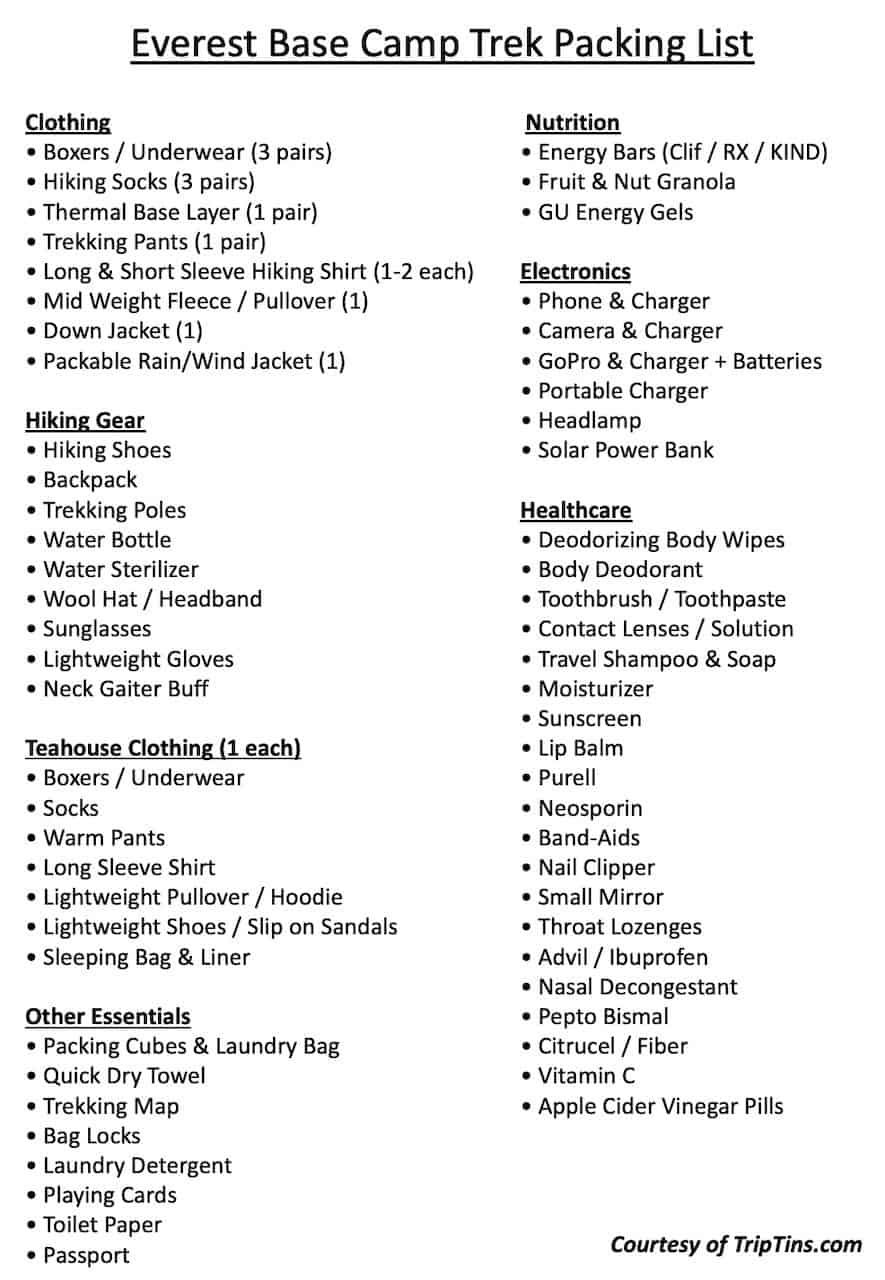
Here are a few additional tips when it comes to the packing list:
» All of your clothing should be made of moisture wicking materials such as Dri FIT, polyester, or wool. These types of materials do not trap moisture and instead keep you dry and comfortable as you are hiking the trails.
» Be sure to keep your electronics in your sleeping bag at night . If you did not know, leaving electronics out in the cold kills their batteries much faster than normal.
If you keep all your electronics / batteries in your sleeping bag at night, you have a better chance to preserve those much needed charges during the duration of the hike.
» You can rent a down jacket and sleeping bag in Kathmandu if you do not want to bring those two larger items with you from abroad. If you are missing any other items, you should also be able to find most of them in Kathmandu before you head off to Lukla.
» Bring along more cash than you will need . Cash is king on the trek and you will need to pay for all your food, accommodations, tips, and other purchases with local Nepalese Rupees (you may be able to pay with USD for permits but rupees will be needed otherwise).
Be sure to bring enough cash (and then some) from Kathmandu.
Considering travel insurance for the Three Passes Trek? World Nomads offers coverage for more than 150 adventure activities as well as emergency medical, lost luggage, trip cancellation and more. For years, World Nomads has been protecting, connecting & inspiring independent travelers, offering travel insurance & safety advice to help you travel confidently. Their mission is to support and encourage travelers to explore their boundaries . World Nomads has simple and flexible travel insurance that has been designed by travelers for travelers. Even if you leave home without travel insurance or your policy runs out, you can buy or extend out on the road. Get a quote for a World Nomads travel insurance policy today!
8) A Day by Day Breakdown
Below you will find a day by day breakdown of the Three Passes trek with a short overview of what to expect out on the trail on each day.
If you would like to learn more about certain days, check out the linked guides that will take you to articles I put together for each day of the trip.
» I took part of the trek in November, which is a month that offers plenty of sunshine and little rain. Feel free to check out this Everest Base Camp weather guide to learn more about why I choose this time of year to hike.
Day 1: Fly to Lukla & Lukla – Phakding
Starting Elevation : 9,318 feet / 2,840 meters
Ending Elevation : 8,563 feet / 2,610 meters
Distance : 5.1 miles / 8.2 km
Duration : 3 hours
Elevation Gain : 909 feet / 277 meters
Net Elevation Gain : (755 feet) / (230 meters)
After taking an early flight from Kathmandu to Lukla , it is time to begin the journey on the Three Passes Trek. Once you land, you can collect your bags and head off into Lukla to have some breakfast before taking off for the day.
Important Note : Flights sometimes only depart from Ramechhap, a 5-6 hour drive from Kathmandu. Be sure to check the latest flight schedules to better understand if Kathmandu offers departures during your trip.
Today will be an easy hike towards Phakding, and it is actually a net elevation loss. It is a perfect way to just get used to the altitude and get your body warmed up for what is yet to come.
» Learn more in the Lukla to Phakding guide up on the site
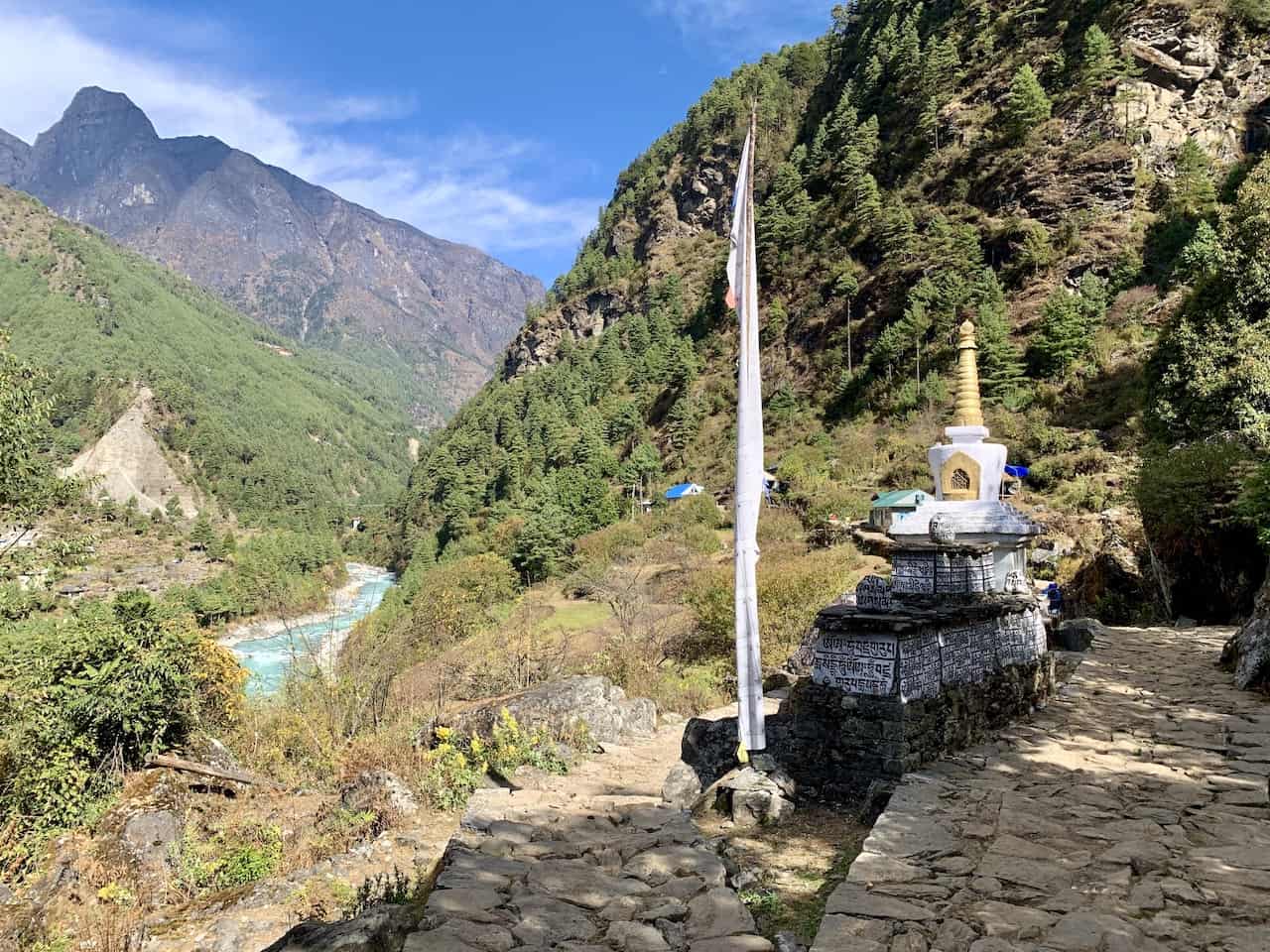
Day 2: Phakding – Namche Bazaar
Starting Elevation : 8,563 feet / 2,610 meters
Ending Elevation : 11,286 feet / 3,440 meters
Distance : 6.8 miles / 10.9 km
Duration : 7 hours
Elevation Gain : 3,986 feet / 1,215 meters
Net Elevation Gain : 2,723 feet / 830 meters
While the first day was nice and easy, day 2 will be one of the more difficult trekking days as you head all the way up to Namche Bazaar.
There will be quite a bit of elevation gain throughout the way as you head across suspension bridges, take in those first real mountain views, and even get a sneak peek at Mount Everest itself.
» Learn more in the Phakding to Namche Bazaar guide up on the site
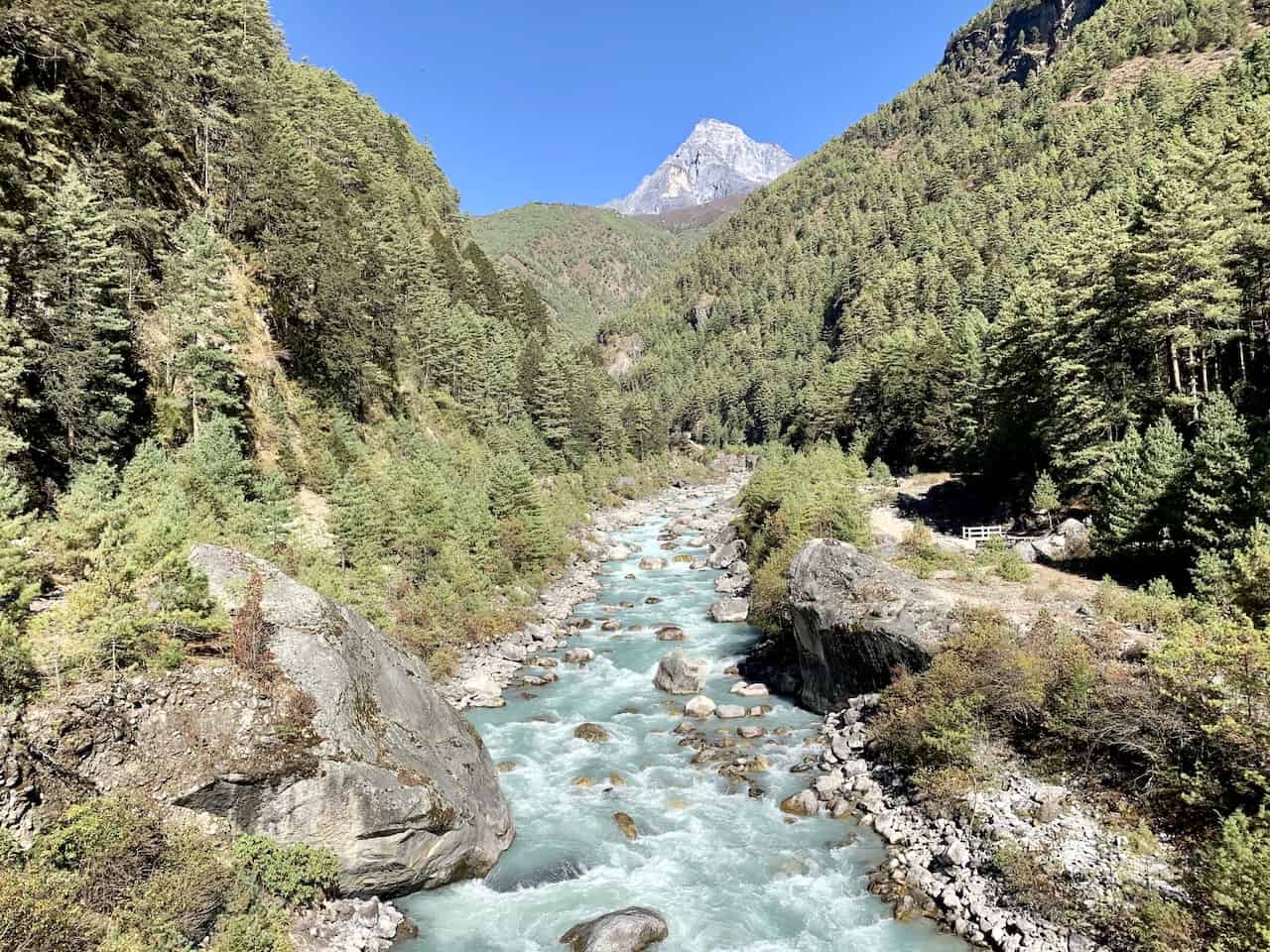
Day 3: Acclimatization Hike to Hotel Everest View
Starting Elevation : 11,286 feet / 3,440 meters
Hotel Elevation : 12,730 feet / 3,880 meters
Distance : 3.4 miles / 5,4 km
Elevation Gain : 1,444 feet / 440 meters
Net Elevation Gain : –
It is time to acclimatize as you spend your third day of the trek above the village of Namche Bazaar. You can leave most of your gear behind as you take a light day pack up to Hotel Everest View.
Along the way and at the hotel itself, you will get some nice views of the Everest mountain range way out in the distance.
Once all finished up and you have had some time to relax up top, follow the path back down to the village, where you will spend a second night in Namche.
» Learn more in the Hotel Everest View hiking guide up on the site
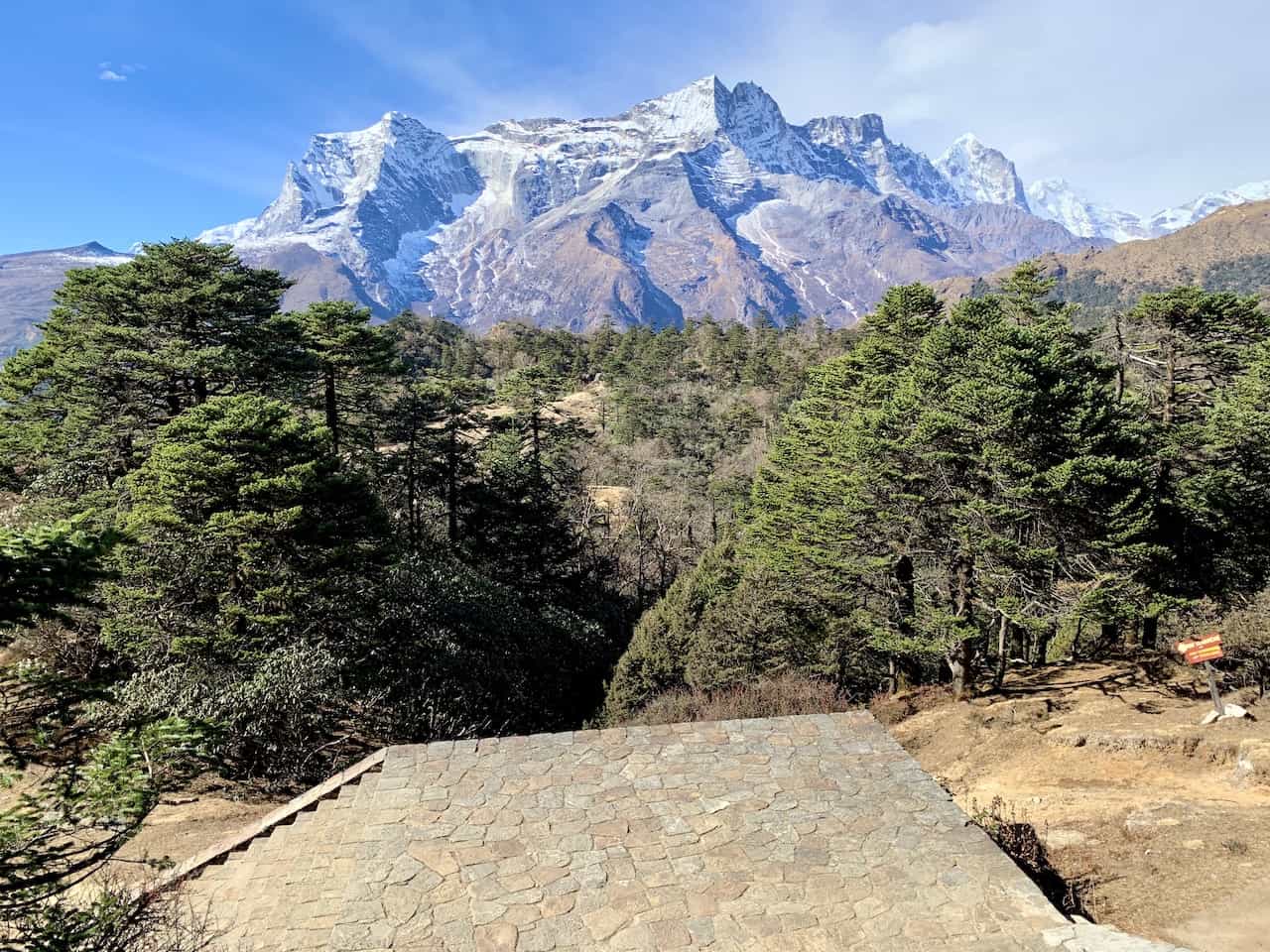
Day 4: Namche Bazaar – Tengboche
Ending Elevation : 12,664 feet / 3,860 meters
Distance : 6 miles / 9.6 km
Duration : 5 hours
Elevation Gain : 2,881 feet / 878 meters
Net Elevation Gain : 1,378 feet / 420 meters
Although you are netting 1,378 feet of elevation gain today, the total gain is closer to 2,900 feet due to the ups and downs of the trail between Namche and Tengboche.
During a good portion of today’s trail you should be able to see the top of Mount Everest as well as some one of a kind views of Ama Dablam.
Once you reach Tengboche, feel free to head to the village’s monastery, one of the most famous in the Himalayas.
» Learn more in the Namche Bazaar to Tengboche guide up on the site
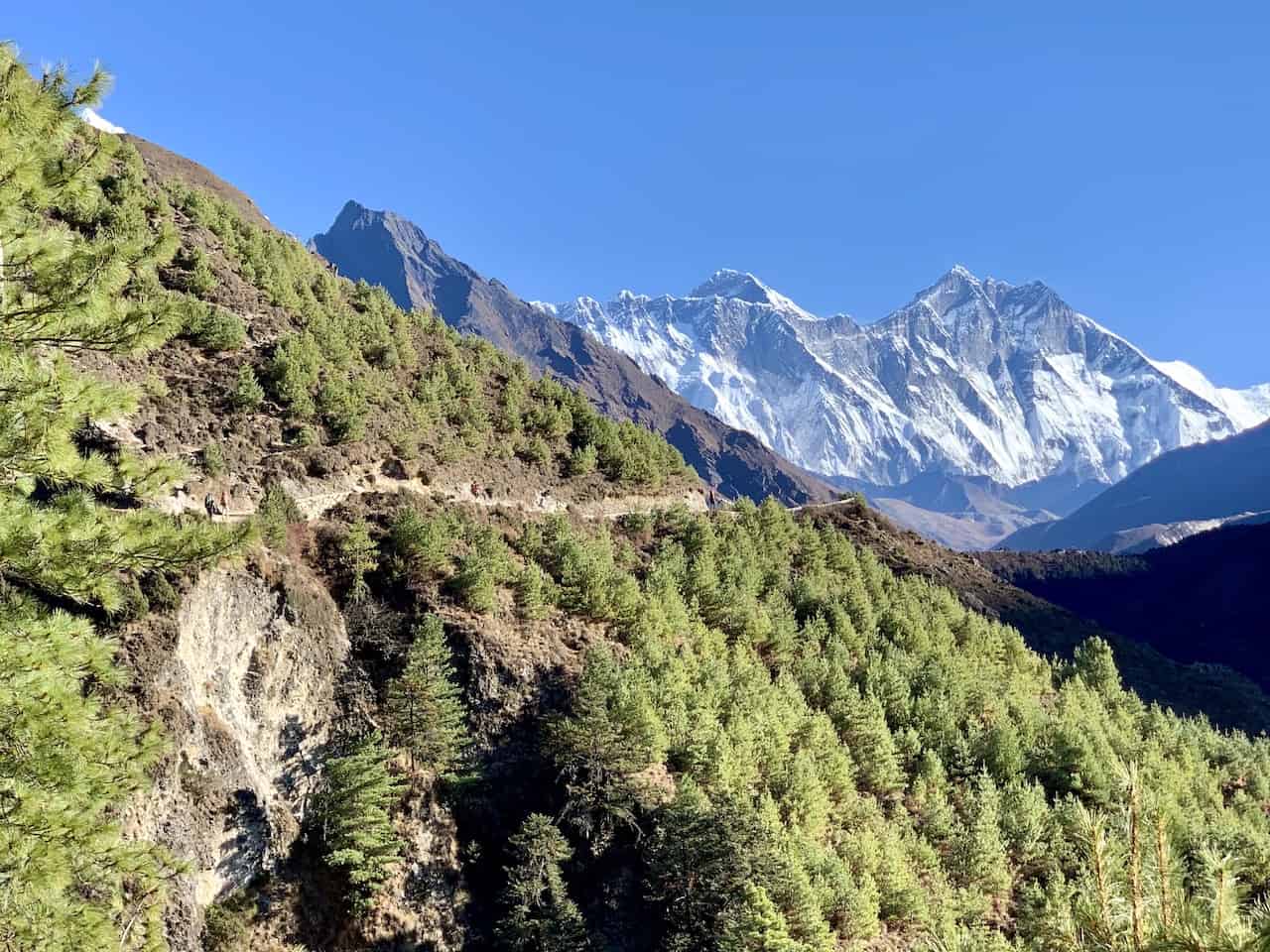
Day 5: Tengboche – Dingboche
Starting Elevation : 12,664 feet / 3,860 meters
Ending Elevation : 14,469 feet / 4,410 meters
Distance : 6.5 miles / 10.5 km
Duration : 6 hours
Elevation Gain : 2,287 feet / 697 meters
Net Elevation Gain : 1,805 feet / 550 meters
It is now further down the valley onwards to the village of Dingboche. Along the way you will pass Pangboche and the turn off for Ama Dablam Base Camp, if you decide to change up the itinerary a bit.
Today is a relatively easy day all things considered, as you gain a some more elevation on a slight incline all the way through and finish up in Dingboche, where you will stay a couple nights to better acclimatize.
» Learn more in the Tengboche to Dingboche guide up on the site
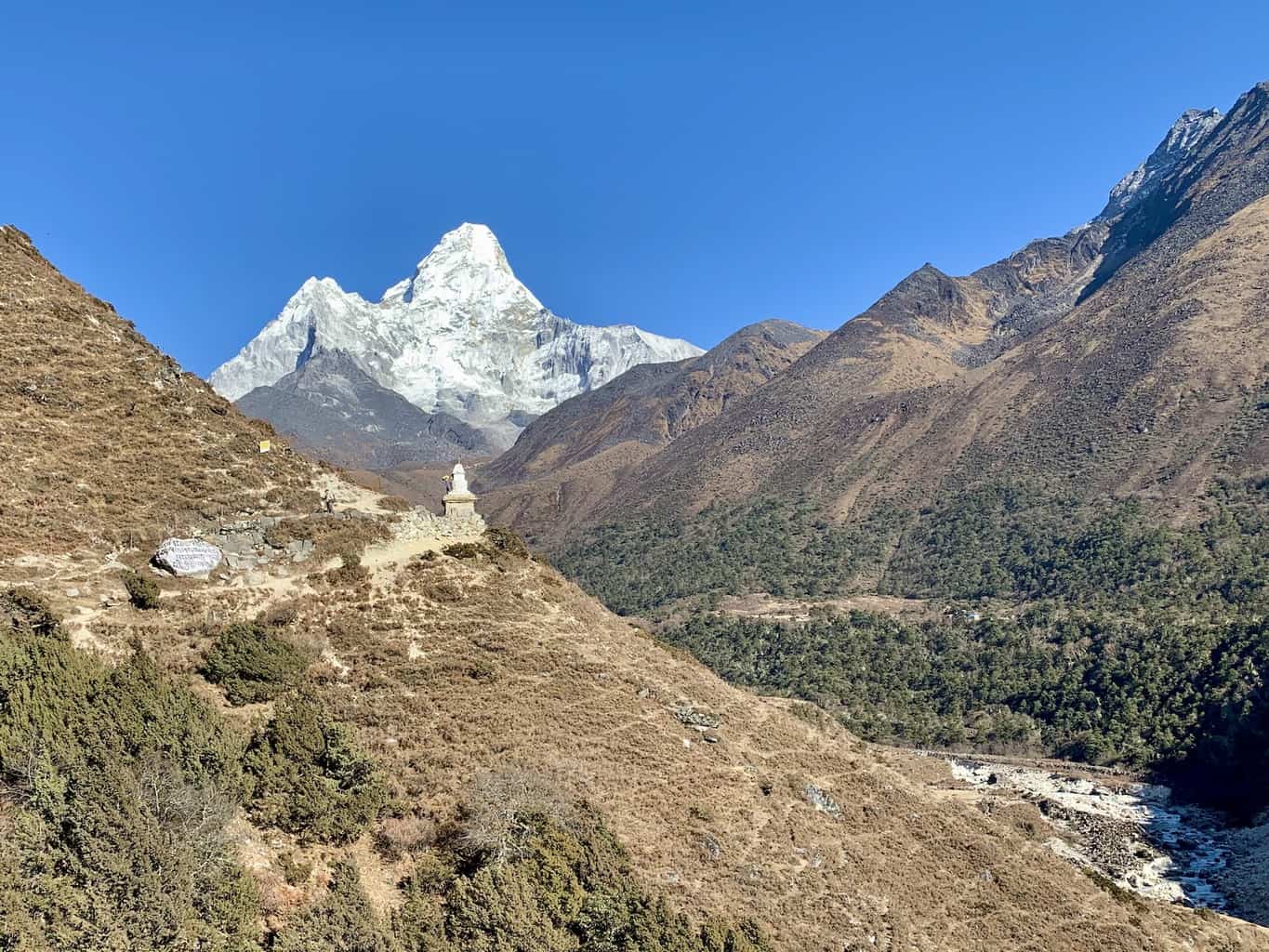
Day 6: Acclimatization Hike to Nangkartshang Peak
Starting Elevation : 14,469 feet / 4,410 meters
Peak Elevation : 16,677 feet / 5,083 meters
Distance : 3.2 miles / 5.1 km
Elevation Gain : 2,208 feet / 673 meters
Directly behind the village, you will see a winding trail up to Nangkartshang Peak. While a tough peak to conquer, you will get some of the best views you can ask for.
Off to your right will be Ama Dablam and to either side, the stunning valley with the mountains hovering up above.
» Learn more in the Nangkartshang Peak guide up on the site
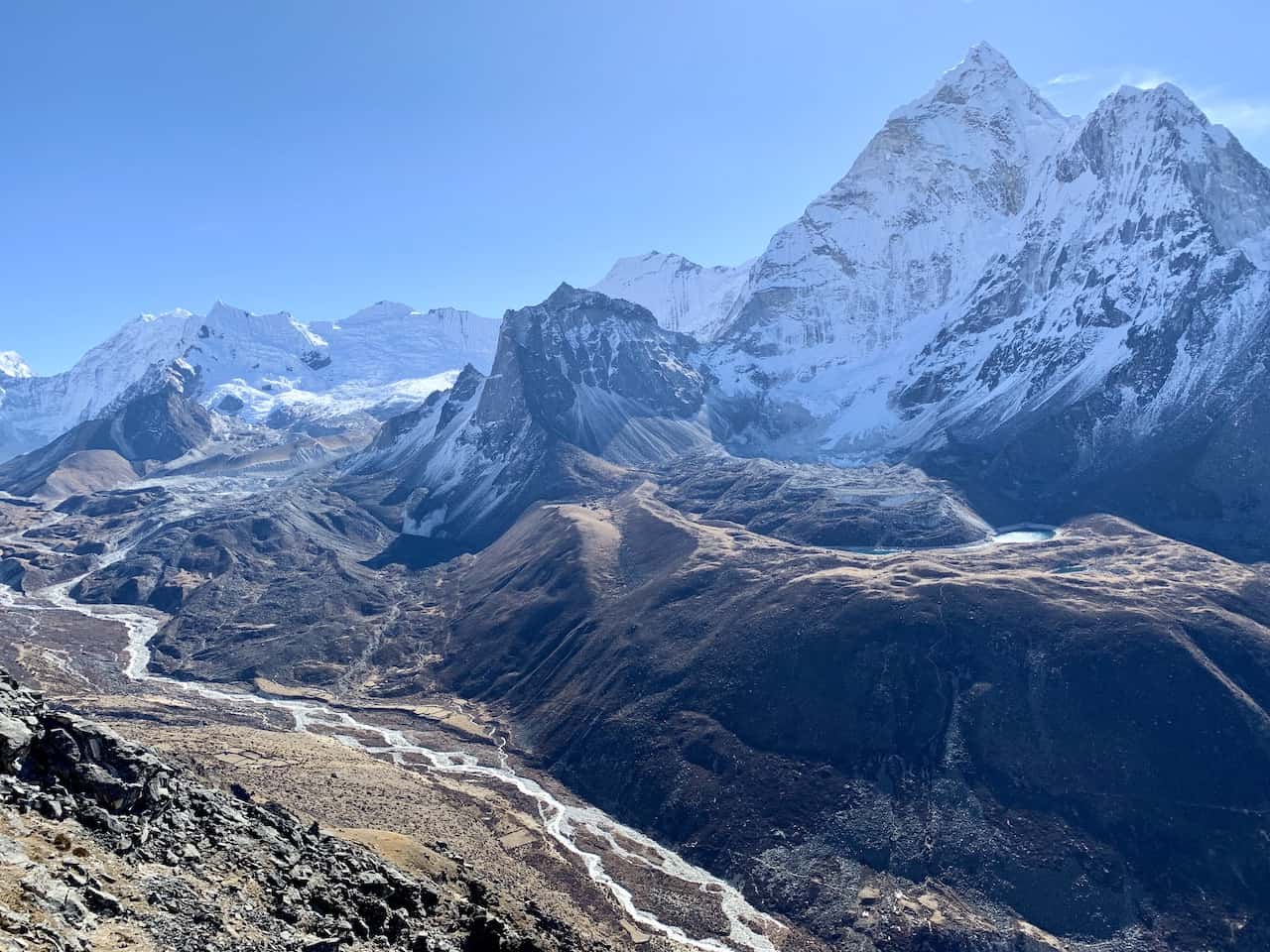
Day 7: Dingboche – Chukhung & Optional Hike to Island Peak Base Camp
Ending Elevation : 15,518 feet / 4,730 meters
Distance : 2.8 miles / 4.5 km
Duration : 2 hours
Elevation Gain : 1,312 feet / 400 meters
Net Elevation Gain : 1,049 feet / 320 meters
Here is where things veer off from the main Everest Base Camp route. Instead of heading to the western valley towards Lobuche, the Three Passes route heads to the eastern valley towards Chukhung.
This is going to be an easier day on the trail that should only take a few hours. If you want to take in more, you can opt for the 4 hour round trip hike to Island Peak Base Camp from Chukhung.
» Learn more in the Dingboche to Chukhung guide up on the site
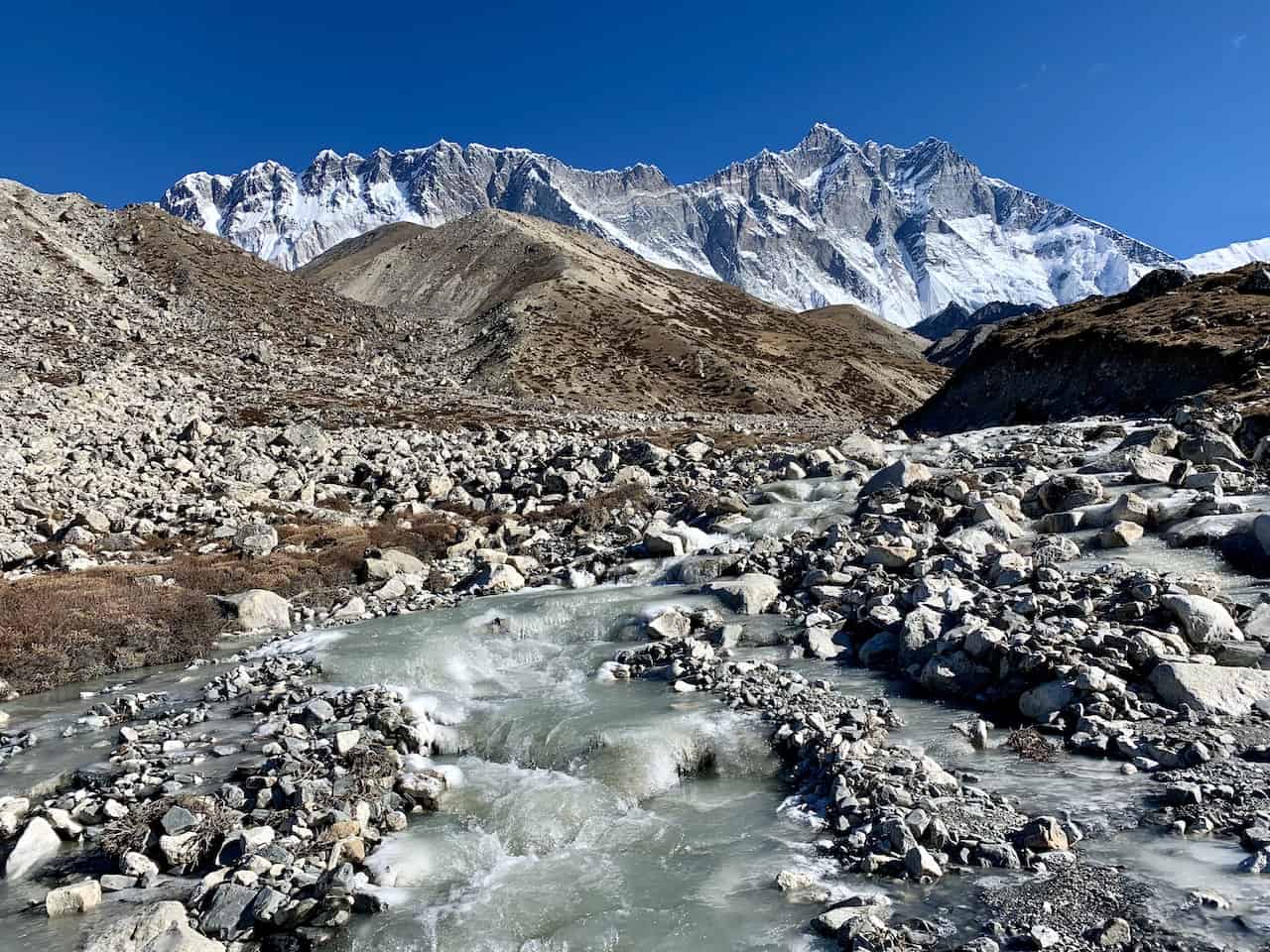
Day 8: Acclimatization Hike to Chukhung Ri
Starting Elevation : 15,518 feet / 4,730 meters
Peak Elevation : 18,209 feet / 5,550 meters
Distance : 3.5 miles / 5.7 km
Duration : 4 hours
Elevation Gain : 2,690 feet / 820 meters
While you don’t necessarily need to consider the trek up Chukhung Ri an acclimatization hike, it is an add on I would highly recommend. Behind the village of Chukhung you will find this peak at 18,209 feet in elevation (tied for highest point of the trek).
While a tough climb up to the top, it sure is a rewarding one. Staring down right in front of you from the top is the south face of Nupste, and behind you will be one of the coolest ridge views you can ask for.
Once back down in the village, be sure to rest those legs and get ready for one of the toughest days of the trek over the Kongma La Pass.
» Learn more in the Chukhung Ri guide up on the site
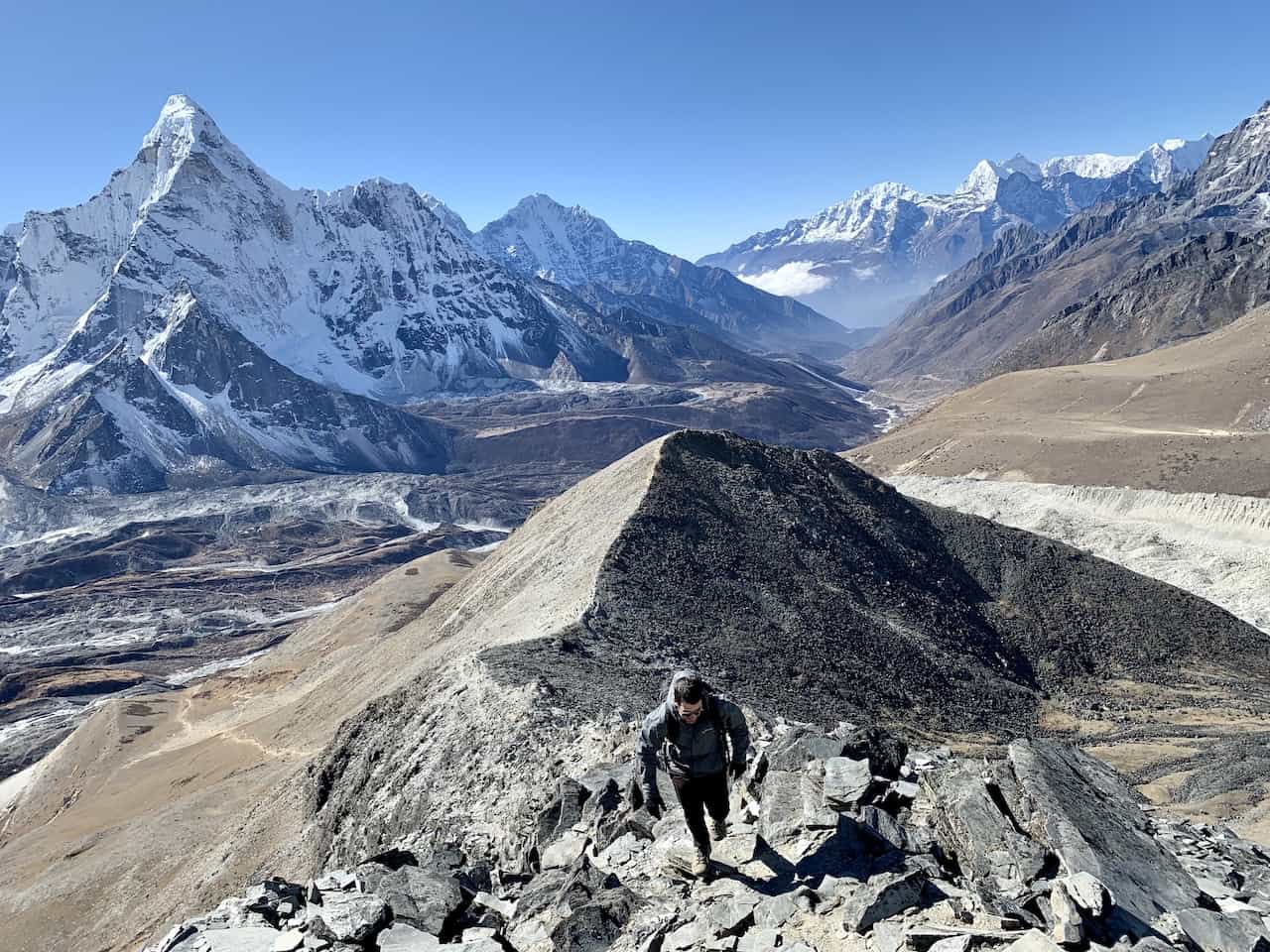
Day 9: Chukhung – Kongma La Pass – Lobuche
Ending Elevation : 16,109 feet / 4,910 meters
Duration : 8 hours
Elevation Gain : 2,691 feet / 820 meters
Net Elevation Gain : 591 feet / 180 meters
In my opinion, the hike over the Kongma La Pass is the most difficult out of any day of the Three Passes trek.
You not only gain 2,700 feet of elevation but you also lose 2,100 feet of elevation down to Lobuche. And the trek down is not an easy one either.
Over the course of this 8+ hour day, you will however get some very special views of the Himalayas. Most memorable is the one atop Kongma La, as you get to take in the absolutely breathtaking views of the turquoise lakes down below.
Once down in the village of Lobcuhe, you will officially be back on the standard Everest Base Camp route.
» Learn more in the Kongma La Pass guide up on the site
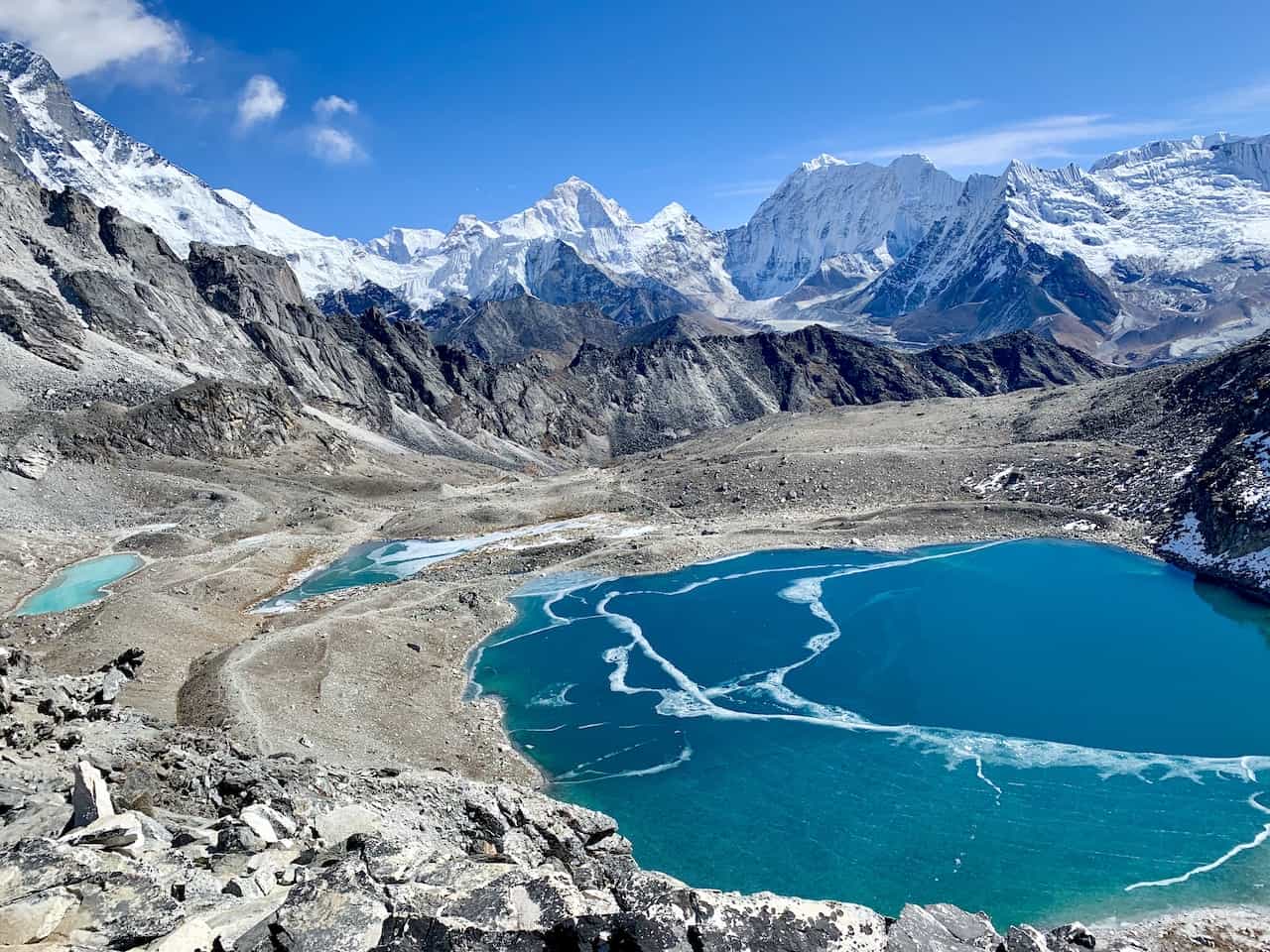
Day 10: Lobuche – Gorak Shep & Trek to Everest Base Camp
Starting Elevation : 16,109 feet / 4,910 meters
Ending Elevation : 16,814 feet / 5,125 meters
Distance : 7.3 miles / 11.7 km
Elevation Gain : 1,647 feet / 502 meters
Net Elevation Gain : 705 feet / 215 meters
Today is a big day as you will make it to Everest Base Camp itself. First it the 3 hour hike to Gorak Shep, where you can check into your teahouse and drop off your stuff.
It is then further down along the Khumbu Glacier until you reach Everest Base Camp! Spend some time exploring the area, taking some photos, and enjoying the views of the Khumbu Icefall.
Once all finished up there, head back towards Gorak Shep, where you will spend a night above 5,000 meters.
Trekking Tip: IF the forecast is looking clear in the late afternoon, you may want to swap Everest Base Camp to day 11 and head up to Kala Patthar for sunset on day 10. Getting to see the alpenglow hit Everest for sunset is quite the view to take in, however it is only worth it if the weather is clear.
» Learn more in the Lobuche to Gorak Shep & Everest Base Camp guides up on the site
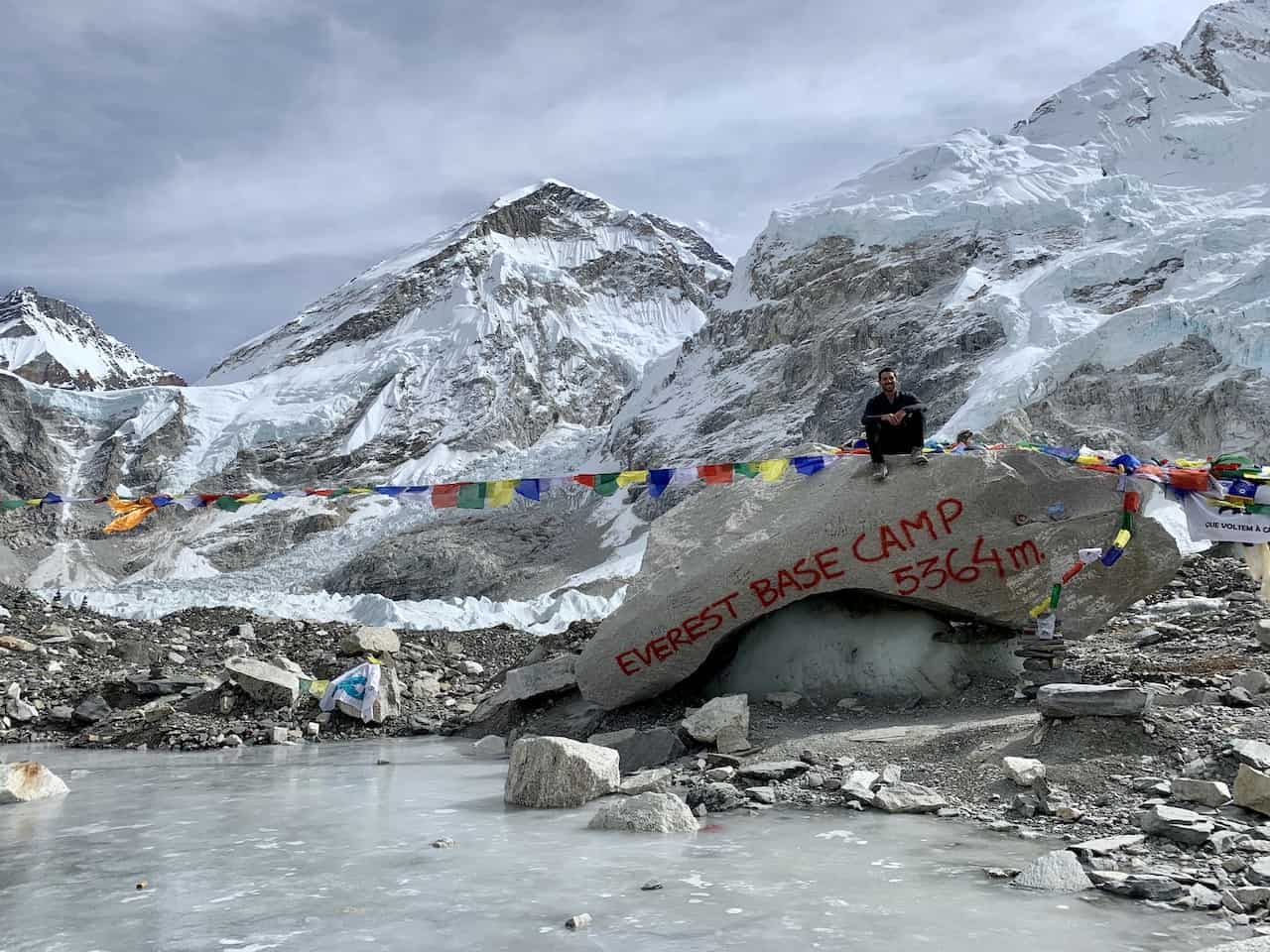
Day 11: Kala Patthar & Gorak Shep – Dzongla
Starting Elevation : 16,814 feet / 5,125 meters
Ending Elevation : 15,850 feet / 4,830 meters
Distance : 9 miles / 14.5 km
Elevation Gain : 1,952 feet / 595 meters
Net Elevation Gain : (964 feet) / (295 meters)
Sitting behind Gorak Shep lays Kala Patthar, home of one of the best views of the Everest region. Along the hike up and from up top you will get to see Mount Everest right out in front of you. This is essentially tied with Kongma La as the highest point of your trek.
Many people decide to head up for sunrise as the weather it clearer in the mornings and sunrise is also a pretty special experience.
Once back in Gorak Shep, pack up your bags and begin the walk back towards Lobuche. You can stop there for some lunch before continuing on to Dzongla. Be careful not to miss the turn here as you will be getting back off of the main Everest Base Camp route.
The trekkers on the main EBC route will be heading straight back towards the Dingboche/Pheriche area, while you will be heading right towards Dzongla to prepare for the Cho La Pass.
» Learn more in the Kala Patthar and Gorak Shep to Dzongla guides up on the site
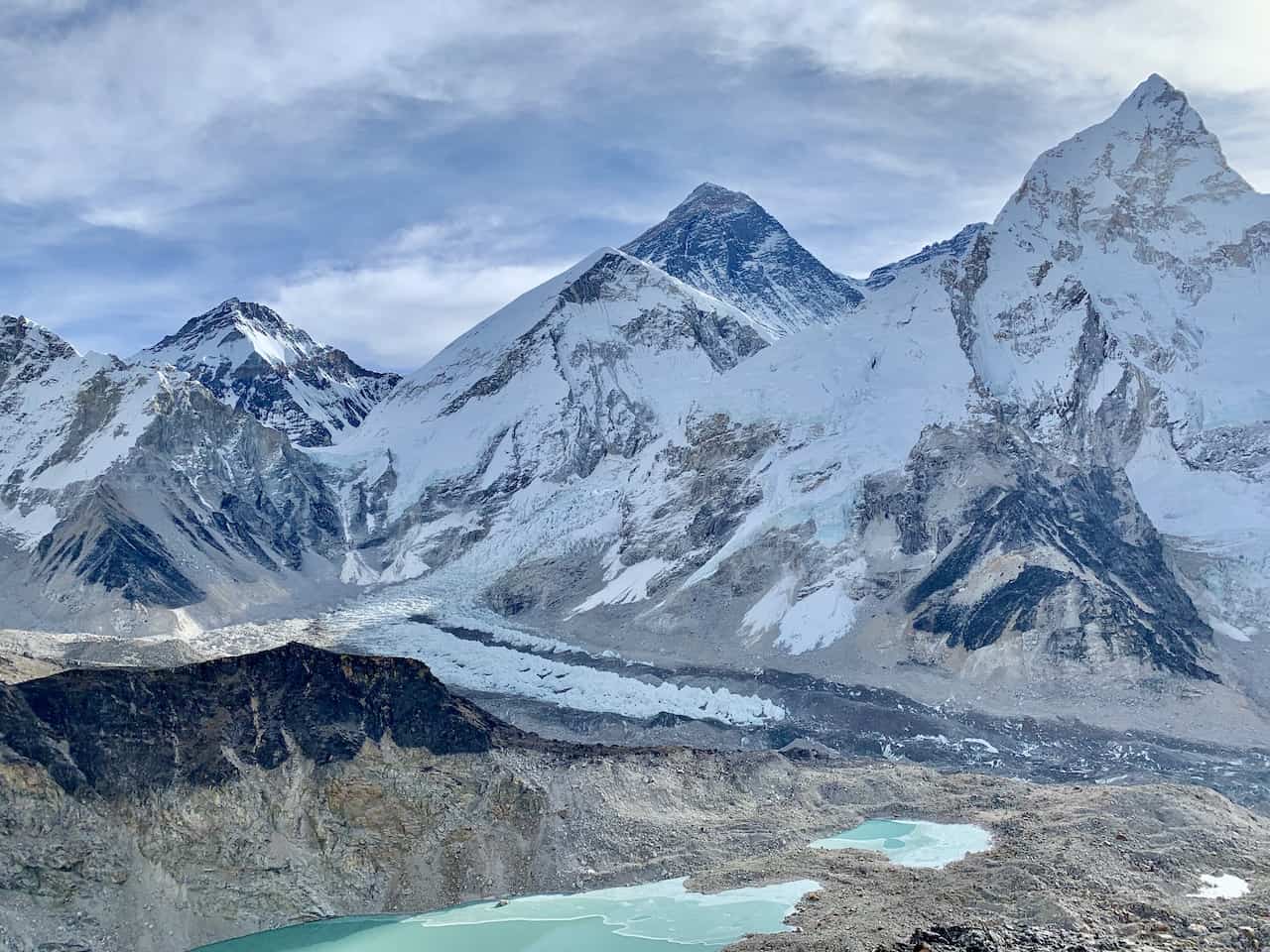
Day 12: Dzongla – Cho La Pass – Gokyo
Starting Elevation : 15,850 feet / 4,830 meters
Ending Elevation : 15,584 feet / 4,790 meters
Distance : 7.5 miles / 12 km
Elevation Gain : 2,362 feet / 720 meters
Net Elevation Gain : (266 feet) / (40 meters)
Out of the three passes, Cho La has to be the most unique in nature. That is because this is not just a simple hike. Once you reach the bottom portion of the pass, you will need to put on your micro spikes (beginner level crampons) to head across the glacier.
It is an experience like no other here as you get to enjoy this glacier walk up to the top of the Cho La Pass. The fun isn’t over yet though! Once down from the pass you will continue towards the small village of Thagnak, where you can enjoy some lunch.
From there the trek across the Ngozumpa Glacier begins as you make your way to the lakeside village of Gokyo. Note that you will not need the micro spikes for this glacier as it is mostly on the loose dirt/rock that sits on top of the glacier itself.
Gokyo will be home for the next three nights as you get to now enjoy some day hikes (or a rest day if needed) from the village.
» Learn more in the Cho La Pass guide up on the site
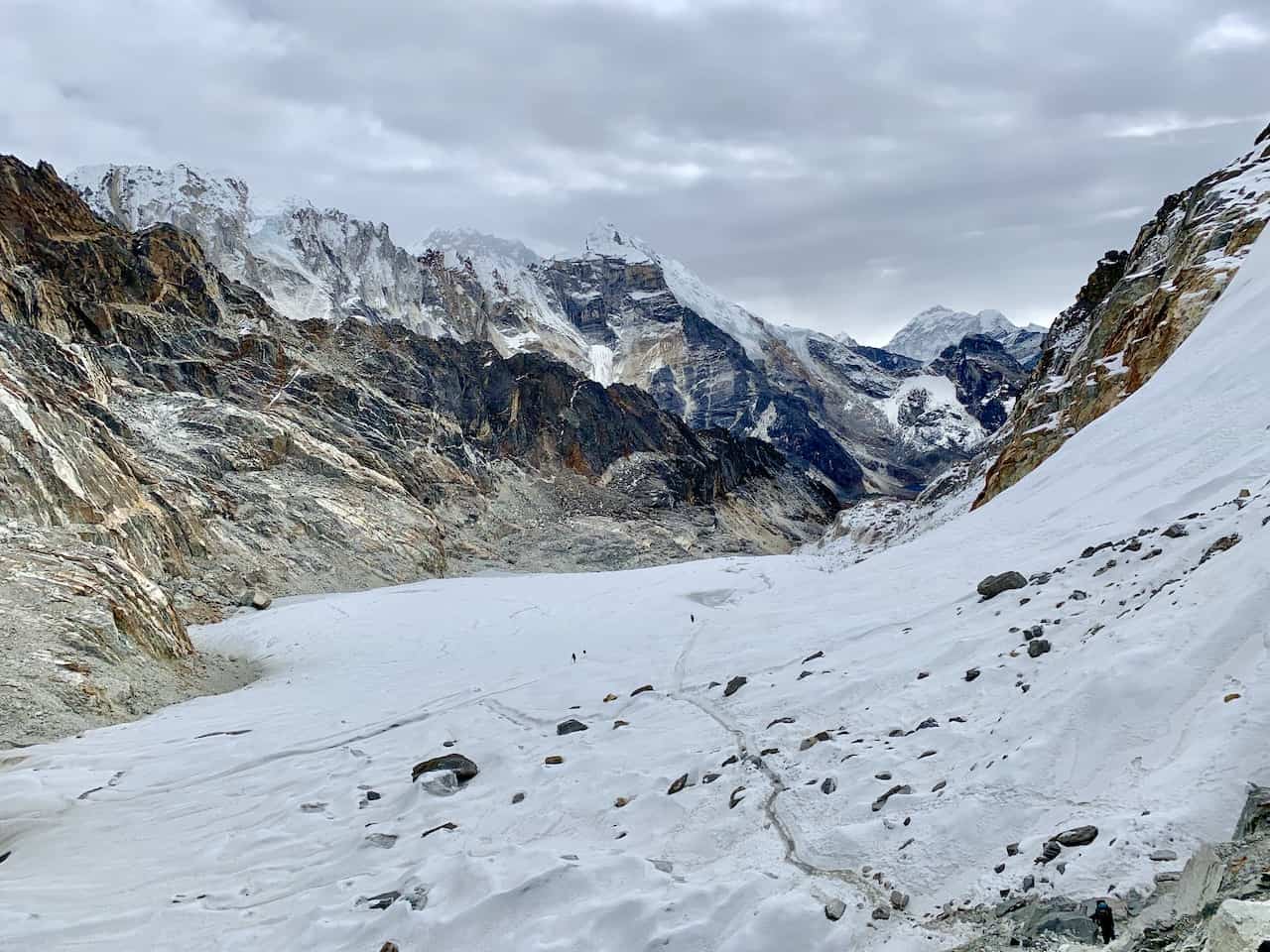
Day 13: Hike up Gokyo Ri
Starting Elevation : 15,584 feet / 4,790 meters
Peak Elevation : 17,575 feet / 5,357 meters
Distance : 2.5 miles / 4 km
Elevation Gain : 1,965 feet / 599 meters
Gokyo Ri towers above the village of Gokyo and its lakes. From the summit of this 17,575 foot mountain, you will get views of the Ngozumpa Glacier in both directions, a few of the Gokyo Lakes, mountains such as Cho Oyu and Makalu, and of course Mount Everest itself.
This is a definite must do hike for those that are spending some time in Gokyo.
» Learn more in the Gokyo Ri guide up on the site
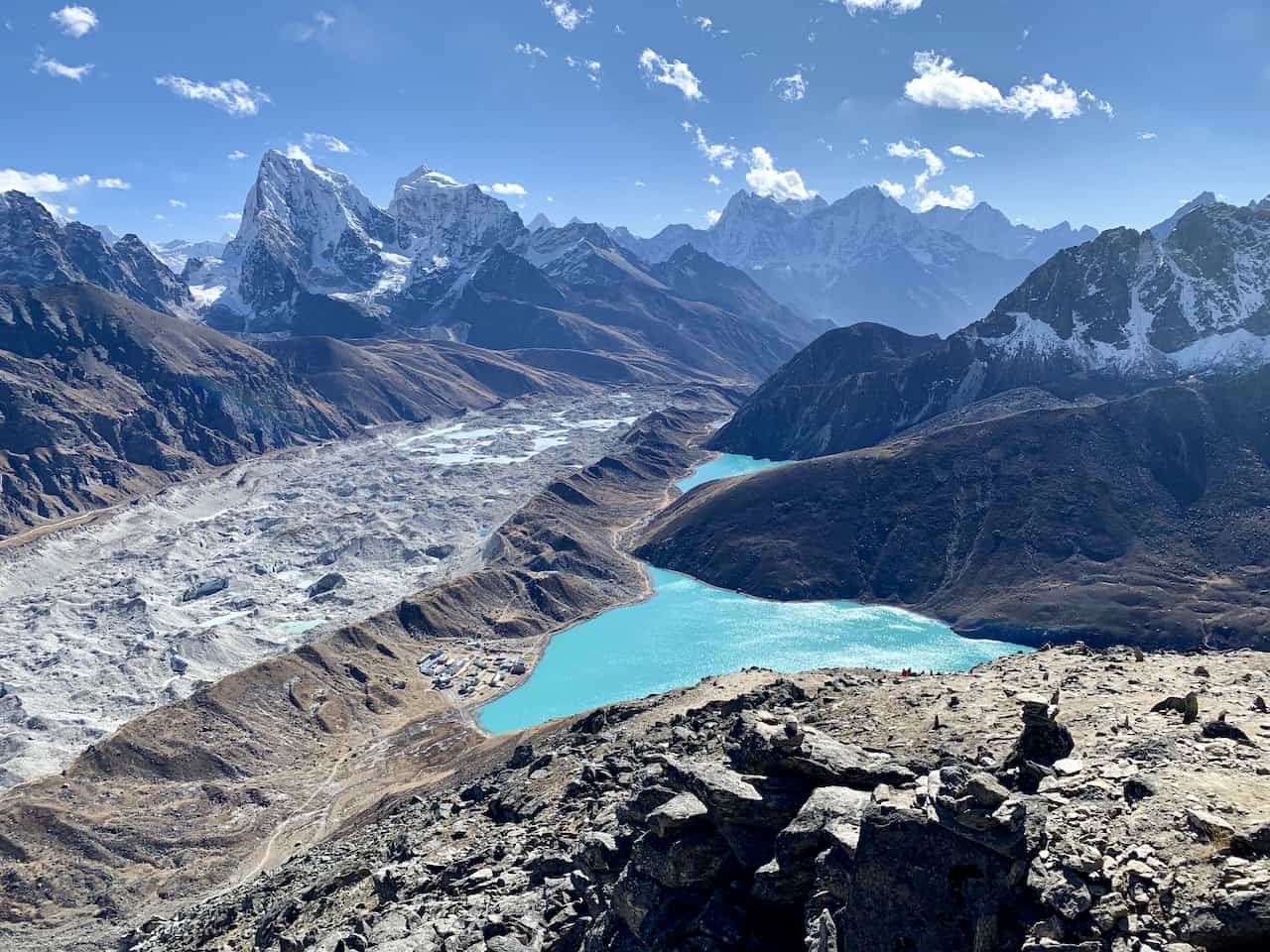
Day 14: Hike to the 4 th & 5 th Gokyo Lakes
Lake Elevation : 16,322 feet / 4,975 meters
Distance : 8 miles / 13 km
Elevation Gain : 950 feet / 290 meters
Understandingly so, you may want to have a rest day at some point, and I don’t think there is a better place to enjoy one than Gokyo. You can spend some time by the main lake, head up the short trail behind the village to take in some views, and just walk around the village.
But if you are up for it, then a trek towards the 4 th and 5 th Gokyo Lakes is also worth the extra day of hiking.
There is limited elevation gain here as you head alongside the Ngozumpa Glacier and towards the two lakes. Along the way too you will get the most unobstructed view of Mount Everest straight down the valley.
So, if you have it in you, it is certainly worth the effort.
» Learn more in the Gokyo Lakes guide up on the site
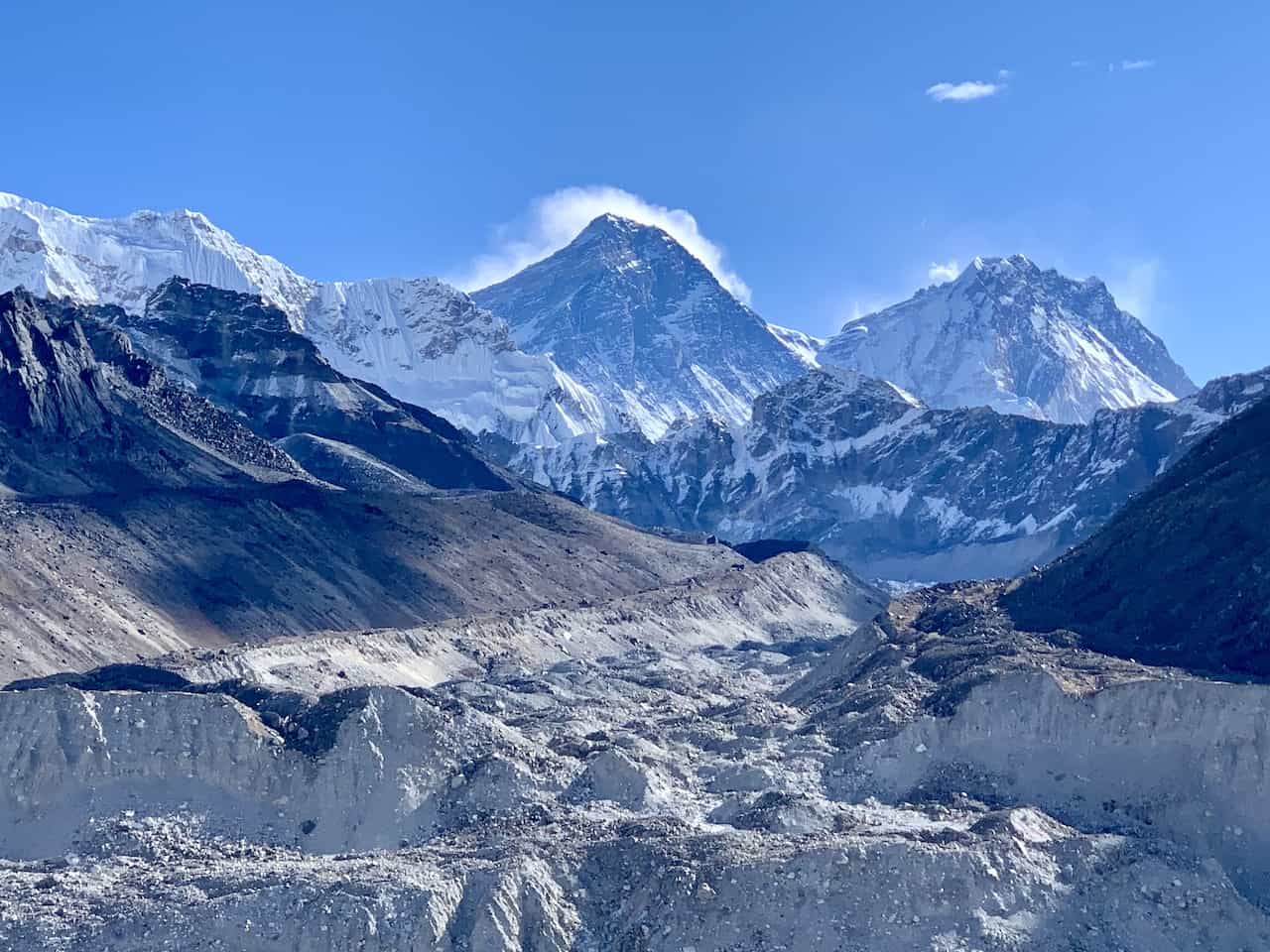
Day 15: Gokyo – Renjo La Pass – Lungde
Ending Elevation : 14,370 feet / 4,380 meters
Distance : 11.7 miles / 18.8 km
Elevation Gain : 2,572 feet / 784 meters
Net Elevation Gain : (1,214 feet) / (410 meters)
It is now time to leave Gokyo and head over the Renjo La Pass towards the other side of the valley to the village of Lungde. The trek over Renjo La will give you more spectacular views of the lakes, glacier and Mount Everest itself.
Once over the pass, it is a nice downhill trek through the valley towards Lungde, where you will spend the night.
» Learn more in the Renjo La Pass guide up on the site
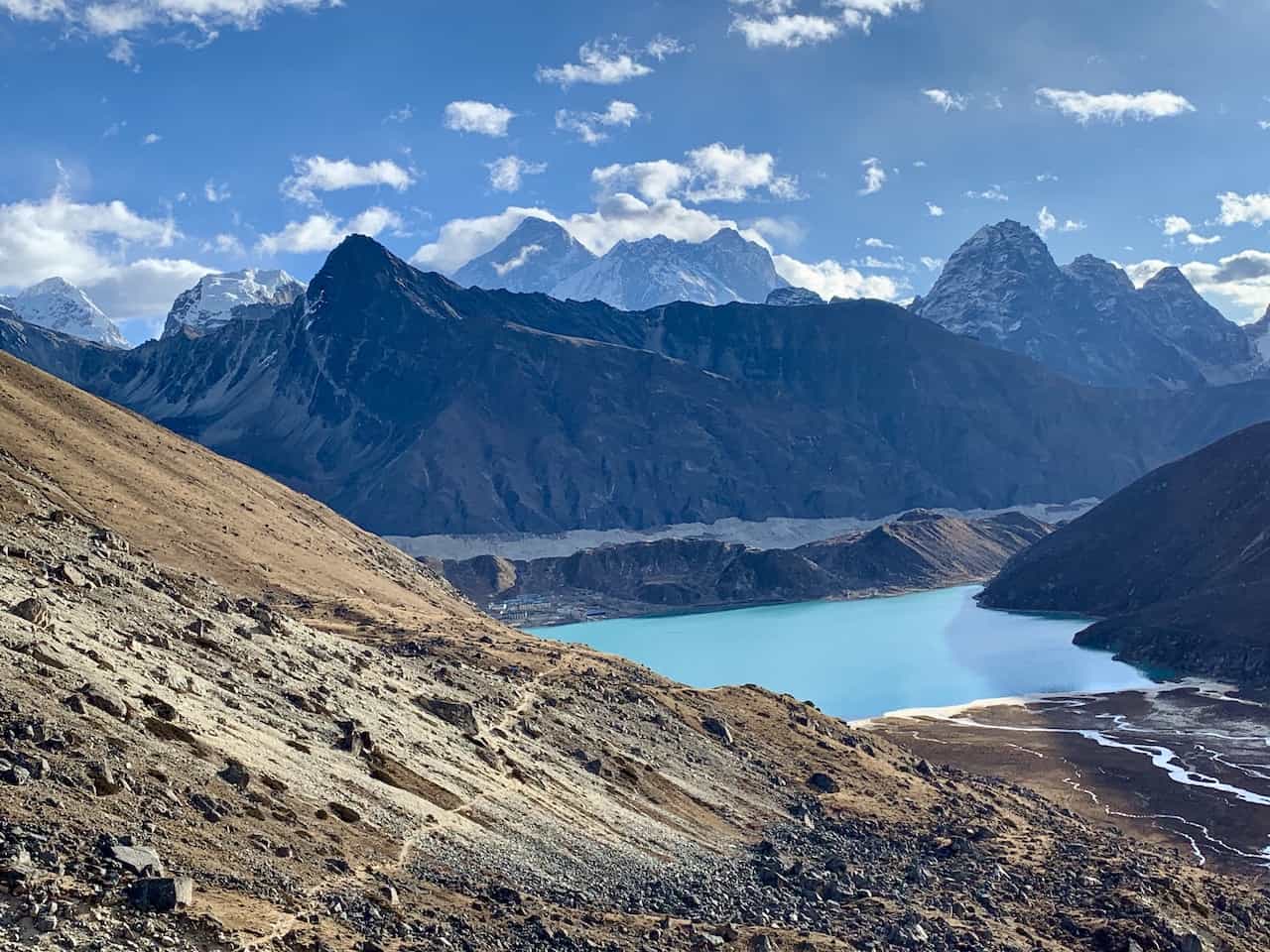
Day 16: Lungde – Namche Bazaar
Starting Elevation : 14,370 feet / 4,380 meters
Distance : 11.4 miles / 18.3 km
Elevation Gain : 1,012 feet / 305 meters
Net Elevation Gain : (3,084 feet) / (940 meters)
While a longer distance of a day, the trekking won’t be as strenuous. You will continuously lose elevation as you circle around towards Namche Bazaar.
Along the way you will cross some bridges, make your way past the village of Thame, and enjoy some of the last views of this side of the valley.
You will soon be welcomed to views of Namche Bazaar from above, and can then make your way down into the familiar village to spend the night.
» Learn more in the Lungde to Namche Bazaar guide up on the site
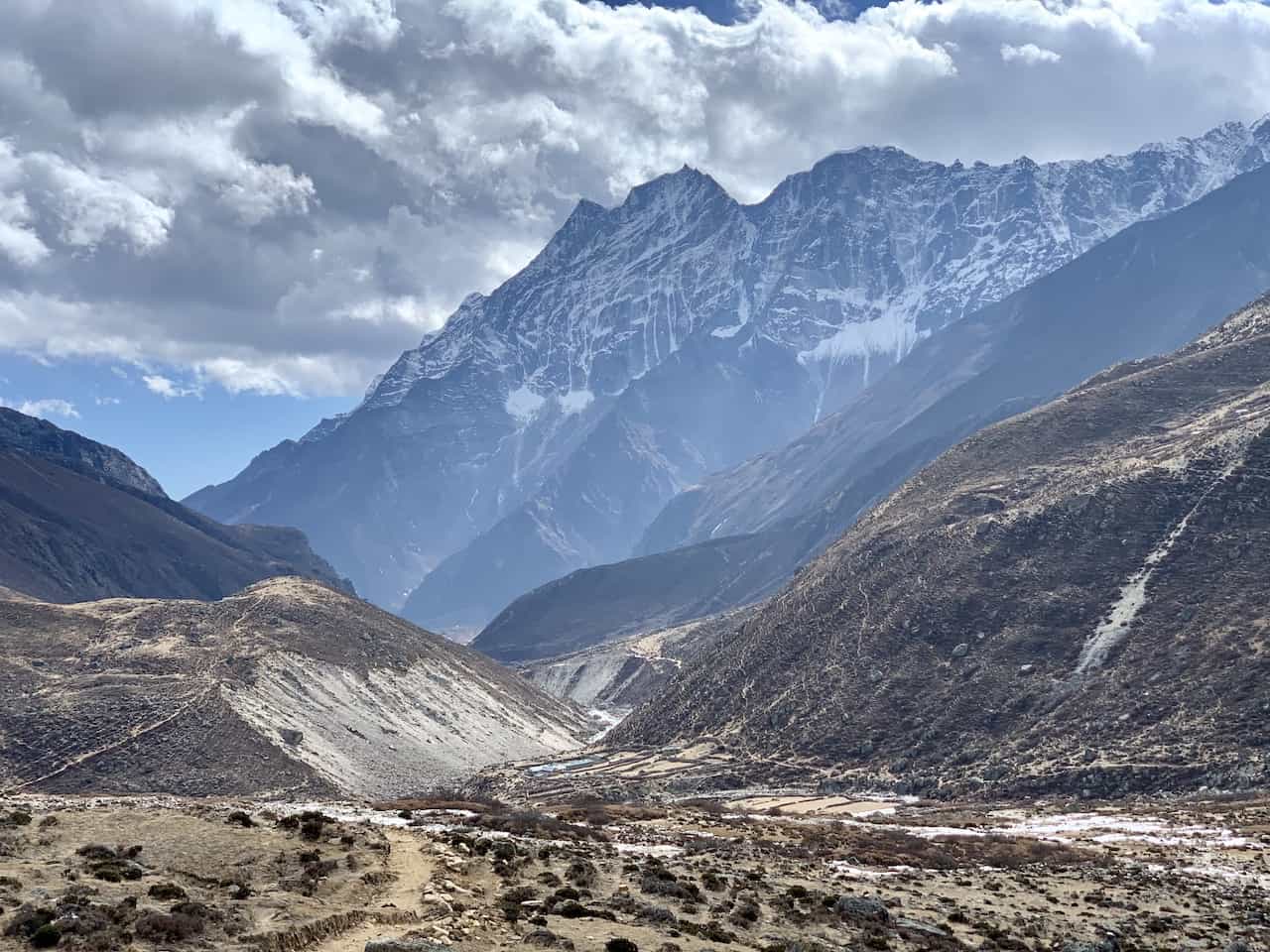
Day 17: Namche Bazaar – Lukla
Ending Elevation : 9,318 feet / 2,840 meters
Distance : 11.9 miles / 19.1 km
Elevation Gain : 2,904 feet / 885 meters
Net Elevation Gain : (1,968 feet) / (600 meters)
This is going to be the last day of trekking on the journey! It is now time to backtrack days 1 and 2 of the trek as you make your way from Namche all the way to Lukla as you pass Phakding along the way.
While you will be losing quite a bit of elevation throughout the day, remember that the portion of trail between Phakding and Lukla will actually be an elevation gain. Nothing like ending the trek with some uphill battles after 17 days of hiking.
Once you make it back to Lukla, head to your teahouse for the night, take a nice hot shower (hopefully), and get ready for your flight back in the morning.
» Learn more in the Namche Bazaar to Lukla guide up on the site
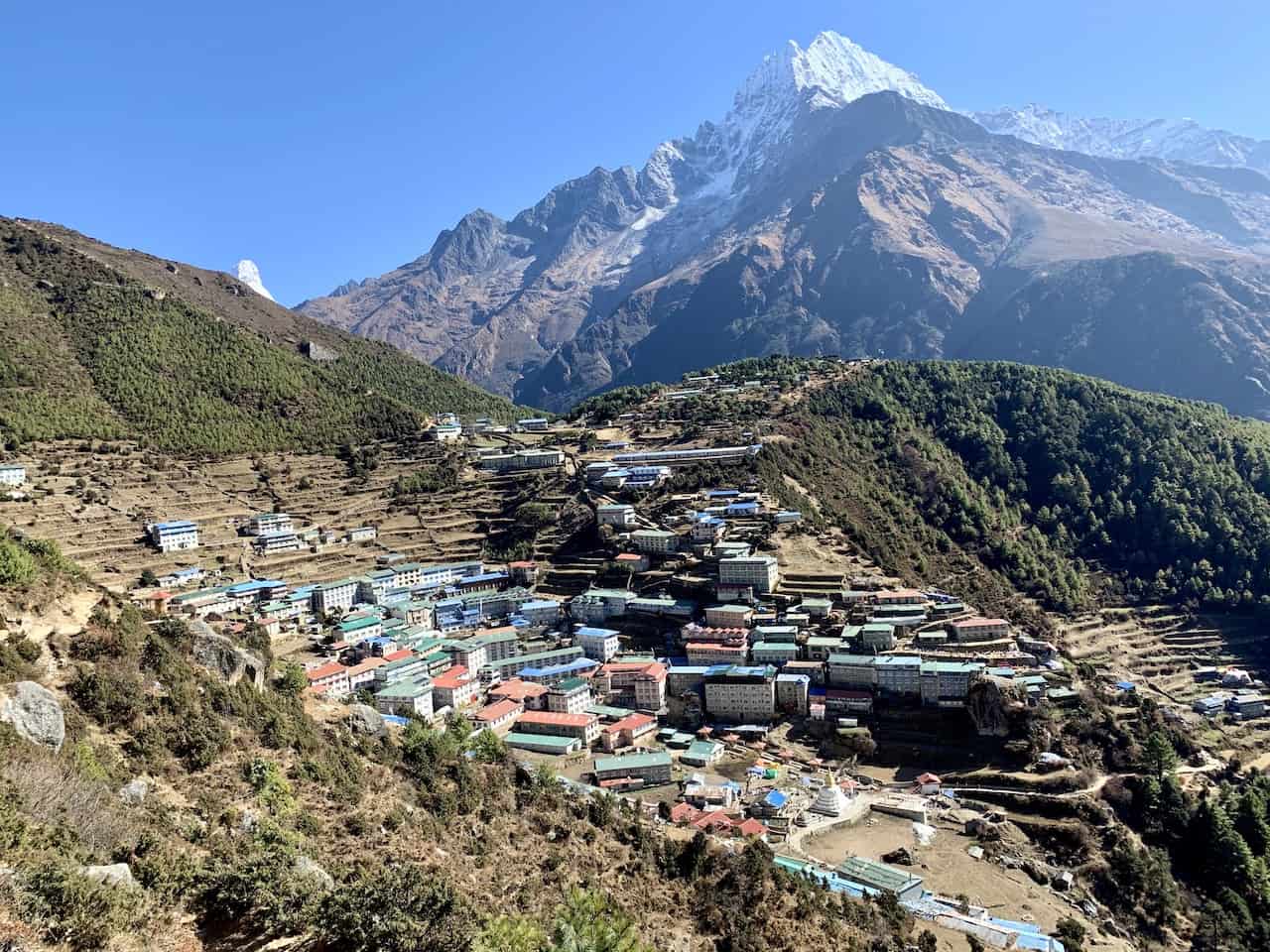
Day 18: Depart Lukla
It is now time to depart Lukla and head back to Kathmandu. Be sure to sit on the right side of the plane here so you can get those last views of the Himalayas outside your window.
Back in Kathmandu, go do some laundry, take some showers, and get some massages after a once in a lifetime trekking experience.
9) How Hard is the Three Passes Trek
The Three Passes Trek is quite demanding both physically and mentally. For about 2.5 weeks you will need to hike on average of 5-6 hours per day, covering 112 miles and nearly 36,000 feet of elevation gain.
And at the end of each day, you won’t have a nice hot shower and heated room to come back to (although you can pay for some warm showers in certain villages).
While the teahouses are some of the most hospitable places I have been to, they do not have hotel like amenities. So, while the physical toll is demanding, the mental toll is too.
But at the end of the day, we are talking about seeing and experiencing some of the most beautiful landscapes on this planet. And every day really does bring something new – whether that is a village, mountain peak, lake, or the uniqueness of Everest Base Camp.
If you think you are up for the challenge, I highly recommend the Three Passes Trek for your trip.
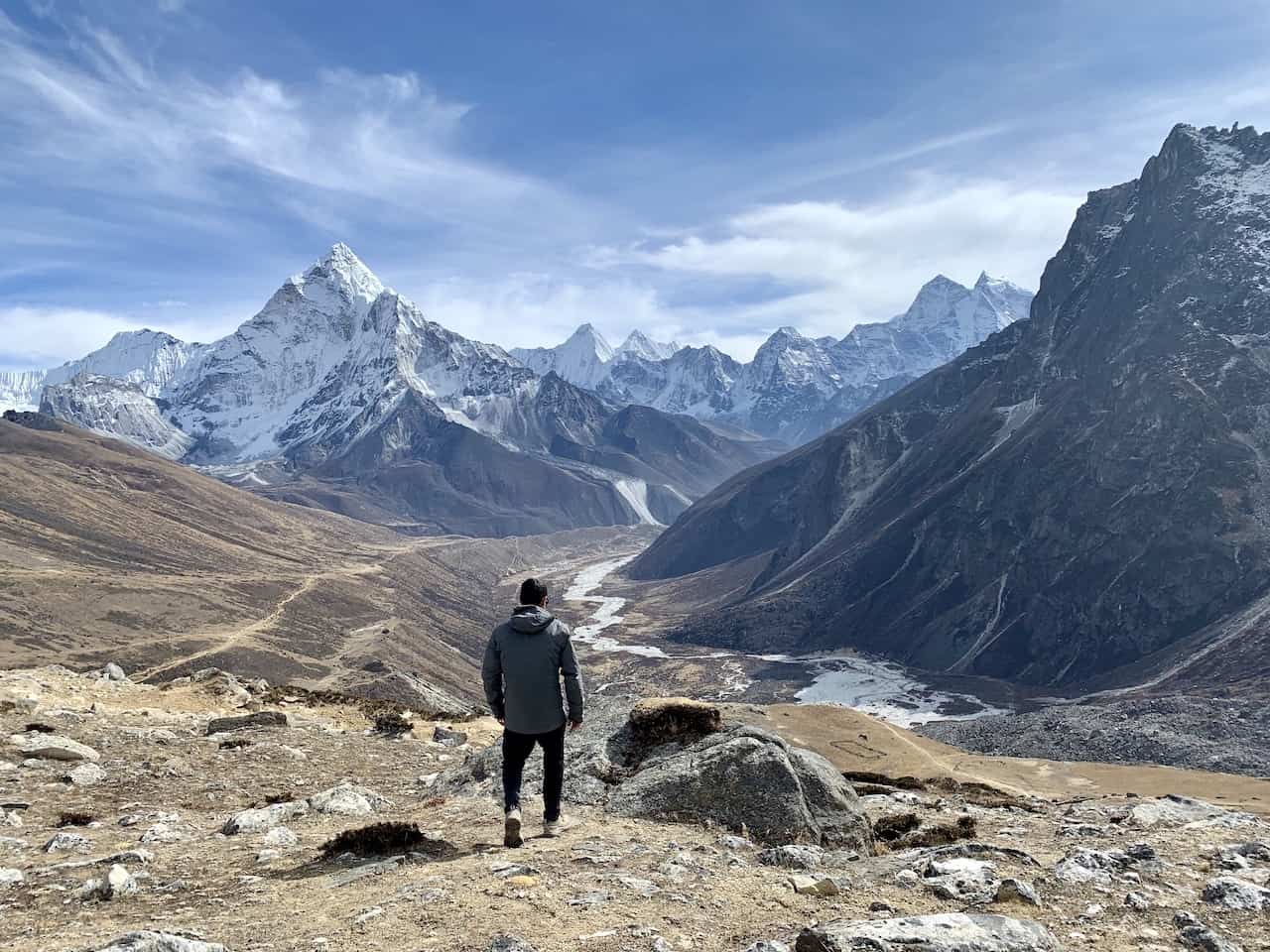
10) Three Passes Trek vs Everest Base Camp
A big question that is asked when going about a hike in the region is the difference between the Three Passes Trek vs Everest Base Camp.
From a pure statistics point of view, below is a chart that shows the main differences between the two treks – days, distance, elevation gain, and time on the trail.
The nice thing at the end of the day is that Three Passes Trek essentially covers 95%+ of the the standard Everest Base Camp trek.
The only portion of trail you would be missing out on is the walk between Dingboche and Lobuche (that is where you would be heading to Chukhung and then Kongma La Pass to Lobuche). Beyond that you get everything that the EBC trek offers.
If you think you have those extra days in you and you want to see more of this beautiful region, then opt for the Three Passes. On the other hand, if you are shorter on time and don’t want to hike for another week, then go for the EBC trek.
End of the day, it is hard to go wrong in this region and you certainly will enjoy it out there in the Himalayas.
» Learn more about the hike in the Everest Base Camp Trek guide on the site
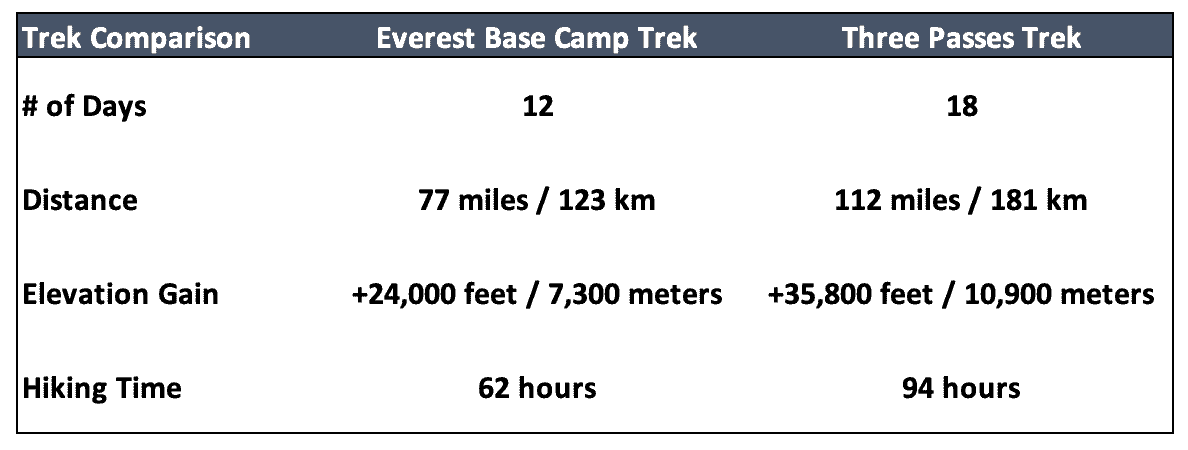
I really hope that this guide has given you all the information you need to fully prepare and enjoy the Three Passes Trek of the Himalayas. If you do have additional questions, feel free to add them in below.
Also, be sure to take a look at the other Nepal trekking guides up on the site.
Have fun out there and safe travels!
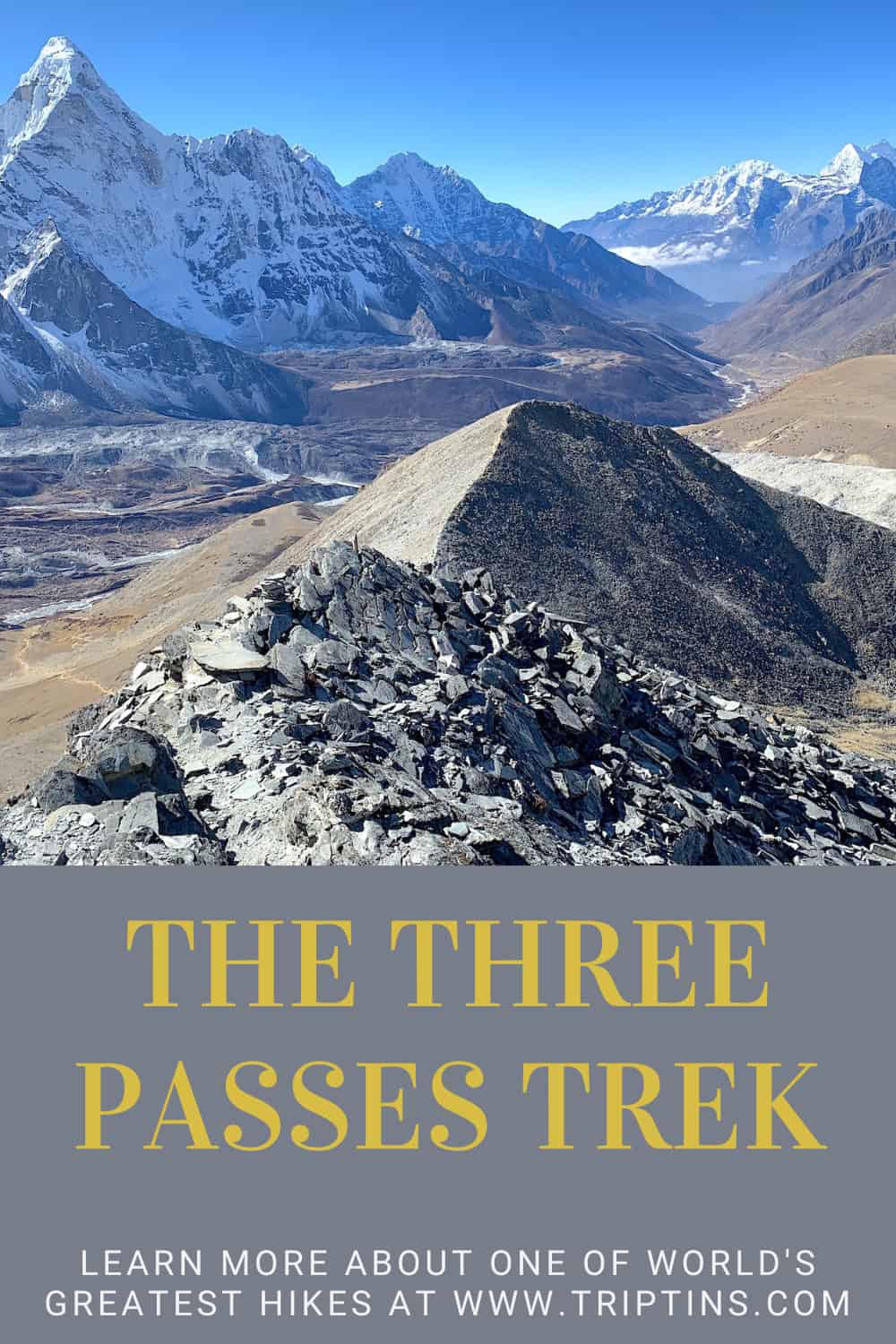
Related posts:
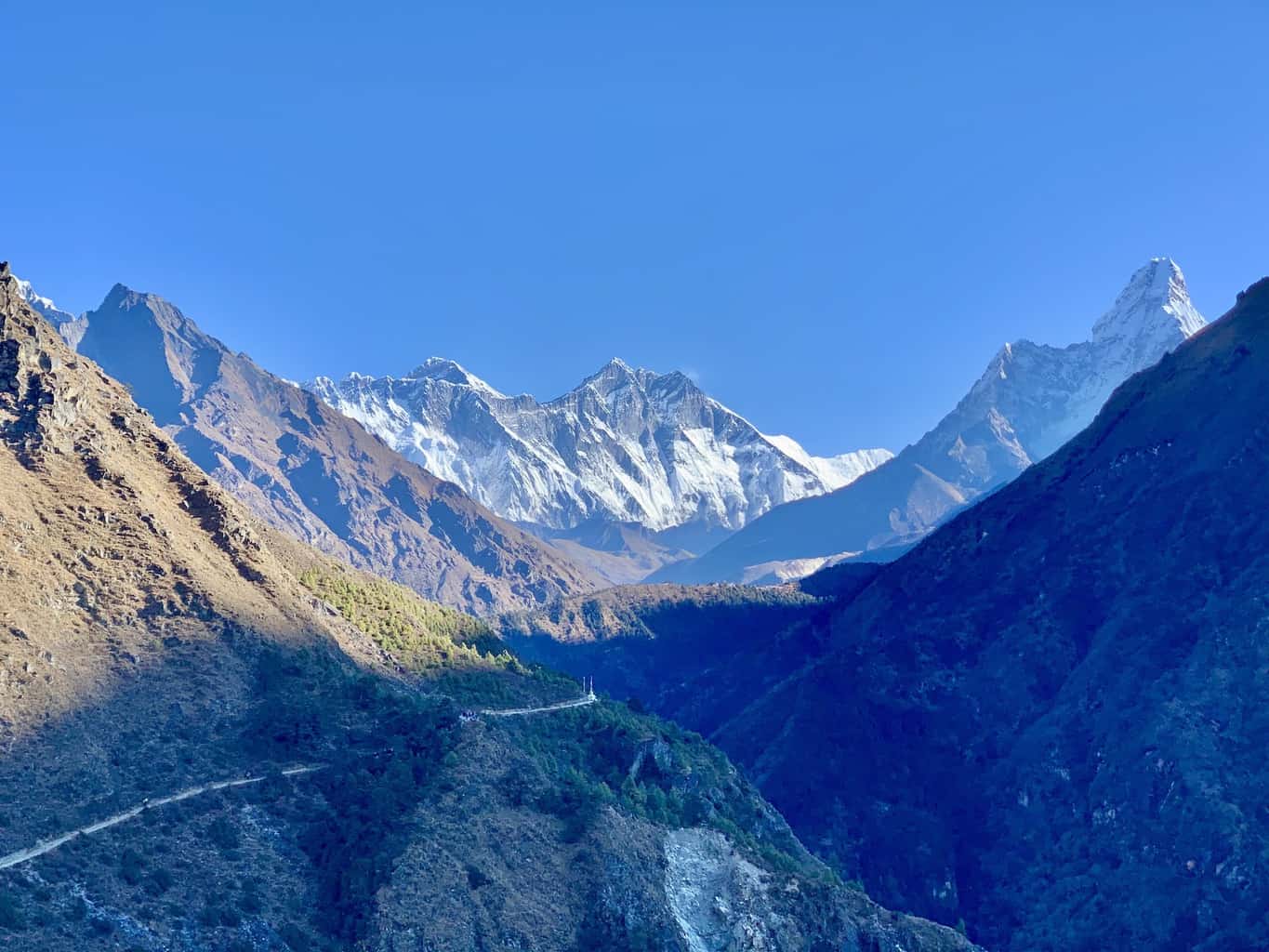
Sharing is caring!
Thursday 26th of January 2023
Just one quick question, can I do Three passes solo or I have to hire a guide, porter or both? There are some blogs which stated that for Everest Region, no solo trekking allowed anymore.
Lynton Smith
Sunday 28th of August 2022
Thanks for sharing. I am interested to know how you booked your internal flight ticks return to Lukla? Did you hire any porters on your trip and if so where from? Cheers Lynton
Monday 29th of August 2022
Hi Lynton - I booked my internal flights through the Yeti Airlines website a few months prior to my departure. I did up end having a porter guide with me for a portion of the hike that was set up for me when I was in Kathmandu.
Enjoy your time out in the Himalayas!
Halfway Anywhere
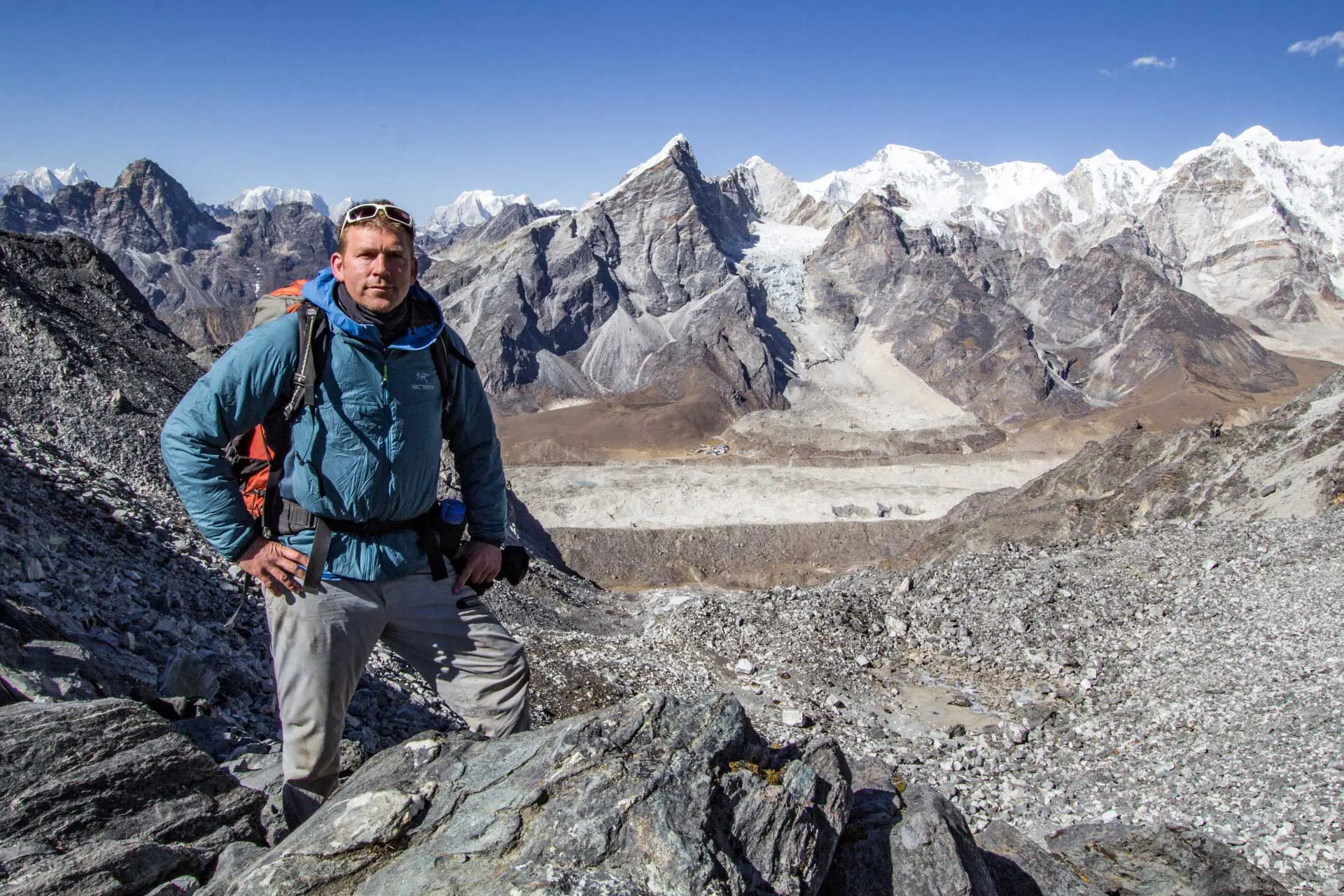
Guide to Nepal’s Three Passes Trek
The Three Passes Trek in Nepal is in the Everest Region (Sagarmatha National Park) and takes trekkers across three high passes, Kongma La (18,209 ft / 5,550 m), Cho La (17,782 ft / 5,420 m), and Renjo La (17,560 ft / 5,360 m) – hence, the Three Passes Trek. It’s a lollipop loop that can be done starting at Lukla (that scary mountain airport that you fly into) or further down the mountains at Jiri, Shivalaya, Salleri, or Phaplu (I recommend starting at Jiri if you have the time – it will also save you on having to buy plane tickets to/from Lukla).
If you’re only going to Nepal once in your life – as you should – and you’re intent on hiking (not doing a meditation retreat or growing dreads and hanging out in Pokhara), then you need to do the Three Passes Trek. And ideally, you need to hike in from Jiri. Fuck Everest Base Camp, fuck the Annapurna Circuit, fuck the Manaslu Circuit , and fuck Poon Hill. Three Passes Trek from Jiri. This is what you need to do. And if Everest Base Camp is really important to you, it can easily be done as a detour from the Three Passes Trek (normally this will add one day – if you’re slow, maybe two; if you’re fast, maybe none).
Are you required to have a guide for the Three Passes Trek? No. Do you need a guide for the Three Passes Trek? Not really (do not buy into all the fear-mongering in Kathmandu – these are just people trying to get you to hand over your rupees). Is hiking the Three Passes Trek expensive? No. Do you need to bring a tent, sleeping pad, or winter sleeping bag? No. Is it expensive to fly to Nepal? Usually, yes, but once you arrive, everything is cheap!
Three Passes Trek Facts
- (Unofficial) Capital: Namche Bazaar
- Language: Nepali
- Currency: Nepalese Rupee, NPR
- Time Zone: NPT (UTC+05:45)
- Calling Code: +977
- Drinking Age: 18
- Drinking In Public: Yes
- Drinking Tap Water: No
- Flushing Toilet Paper: No
- Vaccinations Required: CDC
- Credit Cards: Carry cash
- Tipping: Not expected
- Emergency Number: 100
- Outlets: Type C / D / M (230 V / 50 Hz)
- Visa Requirements: External Link!
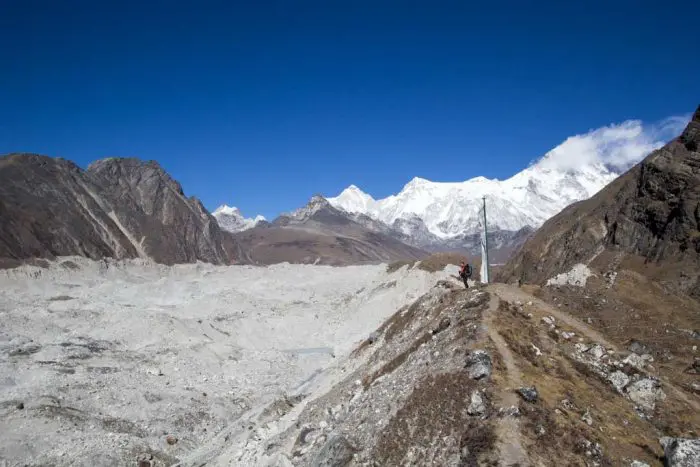
Three Passes Trek Basics
On the Three Passes Trek, almost everyone you meet will have some English language abilities (talk to the kids – they’re very interested in you), so don’t fret if your Nepalese or Hindi is rusty. The two words that you’ll need are namaste (hello) and dhanyabad (thank you). The Sherpa language, called Sherpa, is also spoken by some people. Sherpa is unwritten, which accounts for the various spellings of many of the villages (e.g. Dzonglha/Dzongla/Zonglha), so don’t worry if you’re confused by different spellings on your map versus the menu in your tea house versus your guidebook (which is probably too heavy to be carrying in the first place).
The route to the Three Passes Trek heads north into the mountains until Namche Bazaar. From here, hikers can choose to hike either clockwise or counterclockwise. Counterclockwise is the more common route and the one I recommend (particularly if it’s your first time at altitude). The Three Passes trek takes trekkers through four valleys in addition to the three passes, Kongma La (18,209 ft / 5,550 m), Cho La (17,782 ft / 5,420 m), and Renjo La (17,560 ft / 5,360 m). Kongma La is generally considered the most difficult (longest), Cho La requires you to cross a glacier (microspikes are helpful here), and Renjo La is commonly thought to be the easiest. Granted, this can all change depending on weather and conditions. For more on the Three Passes Trek route, check this post .
The tea houses (i.e. lodges) scattered throughout the villages along the Three Passes Trek are where you will (probably) stay each night (if you wanted to camp, you could, but it’s totally unnecessary and absolutely not required). During peak season, these can (apparently) get crowded. However, if you’re awesome and you go in the winter (more on this below), you shouldn’t have any trouble finding space in a lodge (as practically half of all the buildings in any given town are lodges). The tea houses usually cost between 100 and 400 rupees per night (~$1-$4) and have hot meals and beverages for purchase.
As much as you may imagine “trekking through the Himalayas” to be an exercise in solitude, this idea errs wildly on the side of “nope, sorry.” On the the Three Passes Trek, you will be constantly met with other trekkers, locals, pack animals, and, most exciting of all, villages. Depending on your route, you may pass through as many as five or six villages in a single day. They all (at least on the Three Passes Trek) have food, accommodation, and friendly mountain-dwellers to aid you on your way up into the mountains. If you go up alone and decide you need a guide, hiring someone from one of the villages to go with you on your trek will also be possible.
The most popular season for the Three Passes Trek is the same as Everest Base Camp, the fall (September to November). The second most popular season is spring (March to May), also the peak season for Everest climbers. The summer months are monsoon season in Nepal, so unless you are a huge fan of trekking through the rain with limited views, it’s probably best to avoid this time (unless you are willing to trade views for solitude – but maybe you’ll get lucky with the weather). Winter generally has limited crowds and great weather, but it is cold (I like the winter – more on this below).

Three Passes Trek Route
The Three Passes Trek trail is very well-defined. The scale of the mountains makes navigation much different than what you would find in a heavily forested area. Most of the time, you walk up, down, or across a valley and have few options for where to go. It’s not like you will suddenly make a wrong turn left and accidentally go over a 23,000 ft / 7,000 m. You can get a paper map in Kathmandu for the region, which should help you with the big junctions (if you somehow find yourself alone and with no locals to ask for directions). For more on the Three Passes Trek route, check this post .
As stated above, the passes are Kongma La (18,209 ft / 5,550 m), Cho La (17,782 ft / 5,420 m), and Renjo La (17,560 ft / 5,360 m). Again, Kongma La is generally considered the most difficult (longest), Cho La requires you to cross a glacier (microspikes are helpful here), and Renjo La is commonly thought to be the easiest. Granted, this can all change depending on weather and conditions. It’s wise to get an early start on the days you plan to cross each pass to give yourself adequate time and avoid the afternoon weather (typically worse than what you wake up to).
Everest Base Camp
This is completely doable if you want to detour to Everest Base Camp and/or Kala Patthar. The first village west of Kongma La (the second village east of Cho La), you can make it to Everest Base Camp and back in a day (via Gorak Shep). If you also want to hike Kala Patthar, you could either do one huge day back to Lobuche or stay the night in Gorak Shep and do Kala Patthar the afternoon before your stay or the morning after. For more on Everest Base Camp, check this page .
Hiking from Jiri
Taking a bus or jeep to Jiri (or Shivalaya, one village ahead) and then hiking to Lukla (instead of flying to Lukla) is a challenging and rewarding section of the region that is not as heavily trafficked as the trail above Lukla (where most trekkers start). If you’re short on time, instead of starting from Jiri, you can save yourself a day or two and take a bus or jeep to Salleri or Phaplu, which puts you about two days close to Lukla from Jiri.
Turning Around
Every time I have been up in the Everest Region, there has been much fear-mongering about the passes. “The passes are closed, there is too much snow” or “The passes are closed because ‘I don’t know why I just heard somebody say that.'” Listen, friend, if you’re in Nepal to hike the Three Passes, go and hike the Three Passes. Go and see for yourself. Start early in the morning, and if the trail, pass, or the weather turns out to be too much, turn around. In absolute terms, the passes really aren’t that far from the nearest villages. Don’t be afraid to go and check out the conditions for yourself, but don’t be afraid to turn around if things look above your experience level.
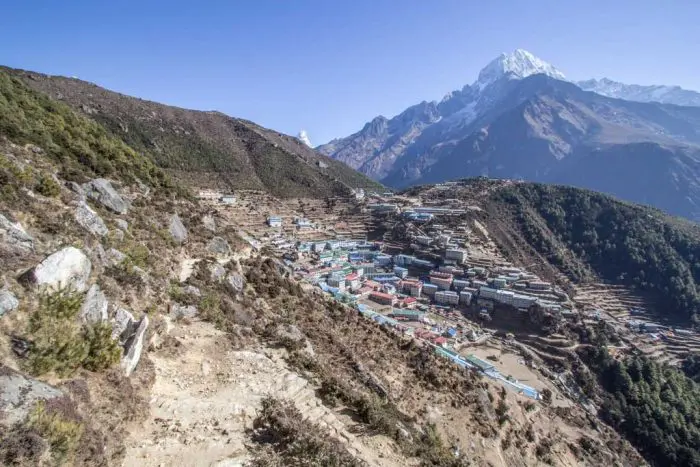
Three Passes Trek Food
Food on the way to Three Passes Trek is far more plentiful than you may imagine. Many lodges have many options, and you could easily eat something different every night (or be like me and stick to Dal Bhat, pizza, and momos). Check out this post for more on food on the Three Passes Trek.
Dal bhat is perhaps the most plentiful dish on the road to the Three Passes Trek and is certainly one that you should be eating to fuel your marathon mountain march. This traditional meal consists of rice, lentil soup (dal), and vegetables (and/or some meat if you’ve opted to eat animals on this trek). In addition to typically being one of the cheaper options on the menu, dal bhat also means refills. You get complimentary refills on your rice, lentil soup, and vegetables. It’s easy to see why this is what the guides and porters usually eat. Remember, “Dal Bhat power, twenty-four hours.”
There’s not a huge debate surrounding the quality of meat on the way up to Base Camp (that I’m aware of), but it’s something trekkers should consider. As much as I love eating roasted animals, I do not eat meat in the Himalayas. Do I have a scientific reason for this decision? No. It’s simply because I don’t know how many days in the sun each meaty meal spent on the back of a porter (and because the meat is generally more expensive). Also, since eating beef isn’t really a thing in Nepal, and since cows are my favorite animals (to eat), it’s not worth the risk.
As with meat, alcohol is something I avoid whilst hiking (upward) in the Himalayas. This is a personal decision, but drinking alcohol (especially in excess) can hinder your acclimatization efforts – and altitude sickness is not something to be taken lightly. A night of partying in Namche is not worth turning your Three Passes Trek adventure into an expensive (but probably awesome) helicopter ride back to Kathmandu.
So now that you’ve sworn off the bottle, it’s time to get serious about hydration. Water should be something you’re constantly ingesting on the Three Passes Trek. Chances are that your body will be in nonstop and desperate need of water to fend off the effects of altitude sickness, dehydration, and the possible fallout from your third helping of dal bhat last night. I bring a SteriPEN with me on my hikes in Nepal and purify water that I get from the tea house’s tap (you usually have to ask for this). Buying plastic water bottles contributes to the garbage problem in the mountains (and we all know plastic bottles are evil).
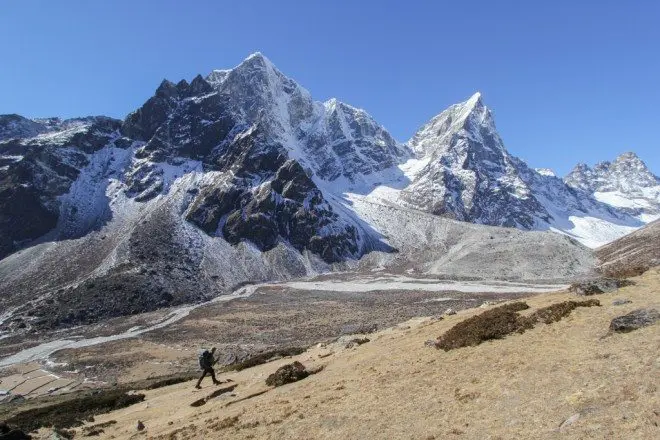
Three Passes Trek Tips & Tricks
Yes, “Winter in the Himalayas” may sound scary, but the truth is that it’s probably the best time to visit (this is based on my having been there twice in winter and once in spring). You may expect the Himalayas’ winter months to bring a ton of snow, but this is not the case. Most days, you can expect clear skies with very little precipitation. Just make sure to bring an extra base layer because it’s cold.
Yes, with the civilization in the Himalayas, you will also find wi-fi. Generally speaking, once you get above Namche Bazaar, getting free wi-fi will be difficult (if not impossible). Generally, you must buy cards from the lodges with passcodes to access the “EVEREST LINK” wi-fi network. These cards are sold in different denominations, the most expensive being 1,000 NPR (~$10 US) for 24 hours of use. These cards may not always be available, and lodges may not always sell them at face value. Also, many lodges turn off the electricity after a certain time (which means no more wi-fi), so be sure to ask beforehand. You will probably get a cell signal in many places if you have a SIM from Kathmandu (Ncell is what you want).

Lukla Flight
I highly recommend taking a bus to Jiri and beginning your hike from there, but if your time is limited, then a flight to Lukla may be your only option. The flight to Lukla is commonly referred to being “the most dangerous flight in the world”. This is largely because of its being placed on under-researched lists of random internet blogs (there have been three fatal accidents involving airplanes at the airport – the most recent of which was in 2010). Yes, the flight to Lukla is an adventure, but it’s certainly not a death sentence. The flight will cost around $150 each way – more on the flight here.
Yes, there are ATMs in the Everest Region. As of writing this, there’s one in Lukla and two in Namche Bazaar. None are guaranteed to work, so I would bring cash from Kathmandu to avoid headaches. Ninety-five percent of places do not accept cards. If the ATMs aren’t working, places in Lukla and Namche offer cash advances with a credit card. Some places in Namche Bazaar accept cards, but few places above Namche will take anything besides cash. Ensure you have enough money for the way up (and back down).
For more on the Three Passes Trek, visit my Three Passes Trek page .
Similar Posts
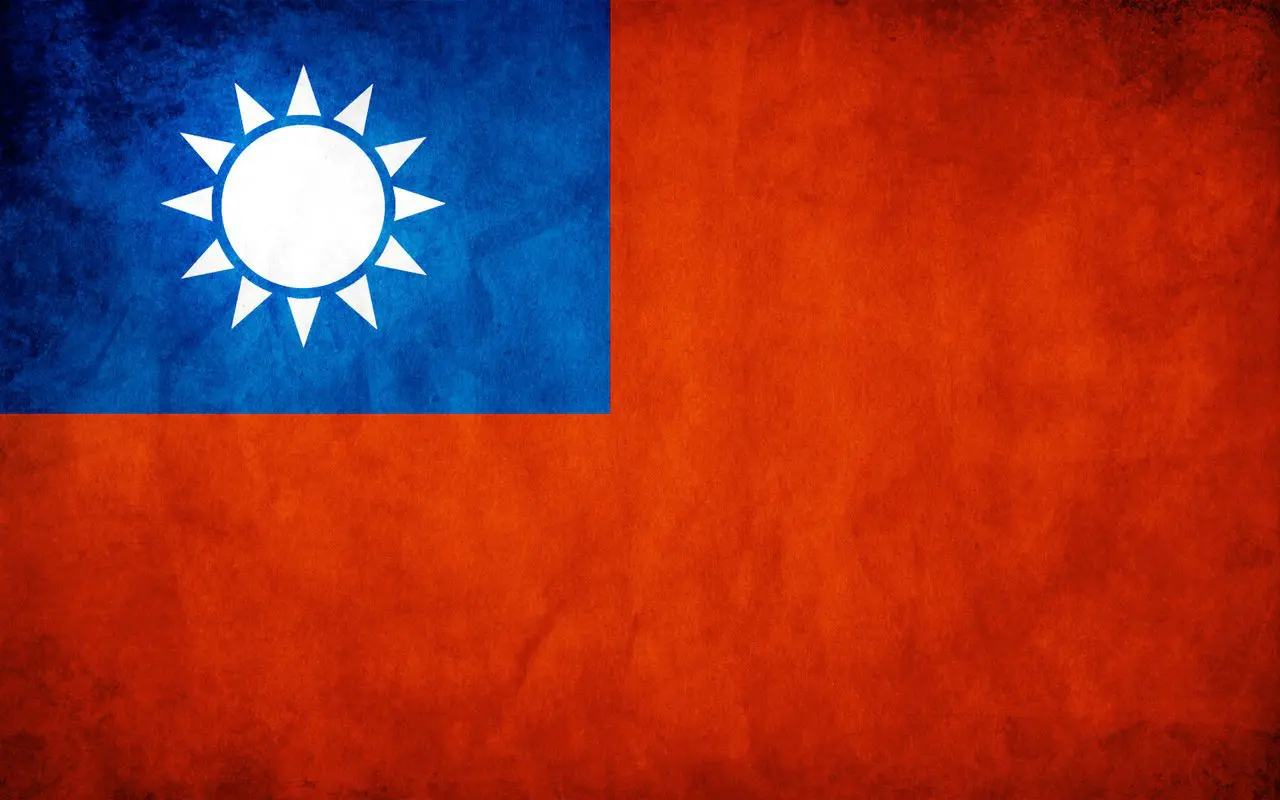
A Beginner’s Guide To Taiwan
Taiwan, or the Republic of China (not to be confused with the People’s Republic of China aka mainland China), is a small island nation in…
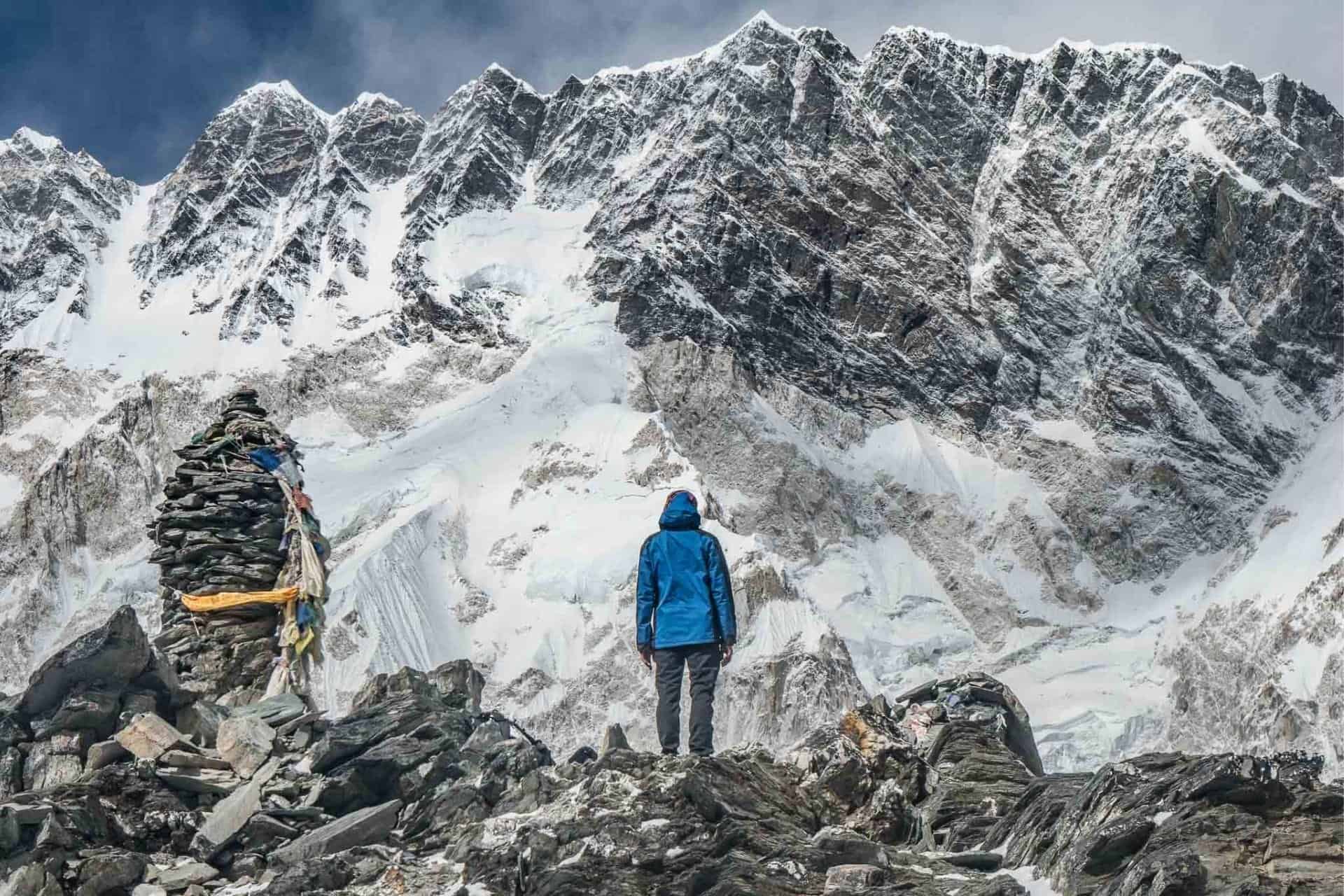
Thru-Hiking Nepal: The Great Himalaya Trail
The Great Himalaya Trail (GHT) is a proposed route stretching the length of the Himalayas through Pakistan, India, Nepal, Bhutan, and Tibet. The GHT’s western…
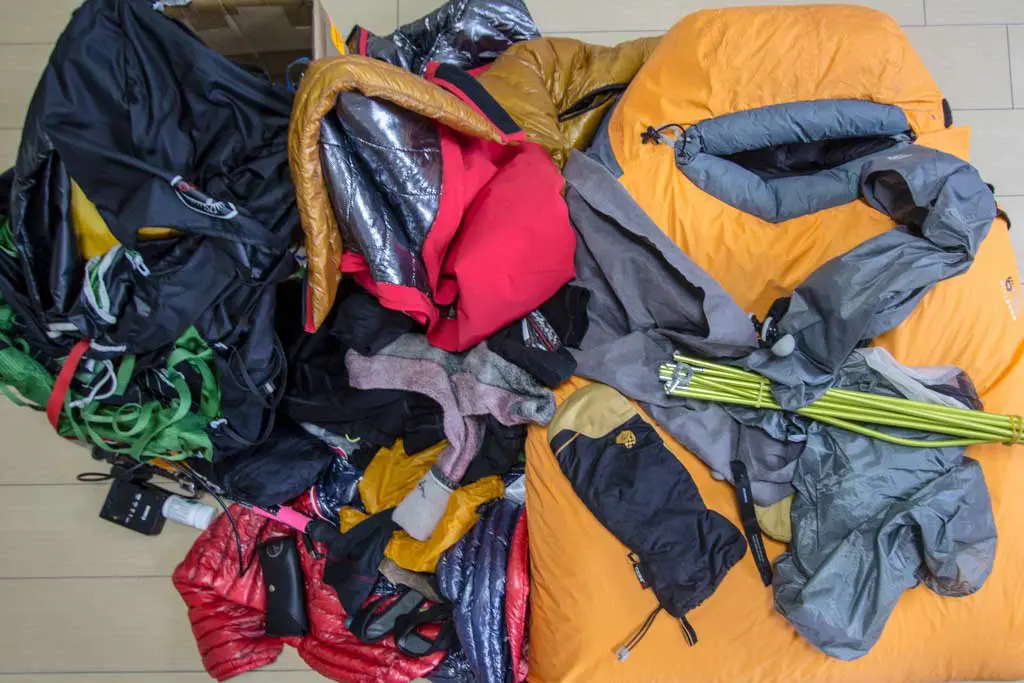
Nepal Three Passes Trek Gear List
Using all I learned last year on my first journey to the Himalayas and up to Everest Base Camp, I have carefully crafted the following…
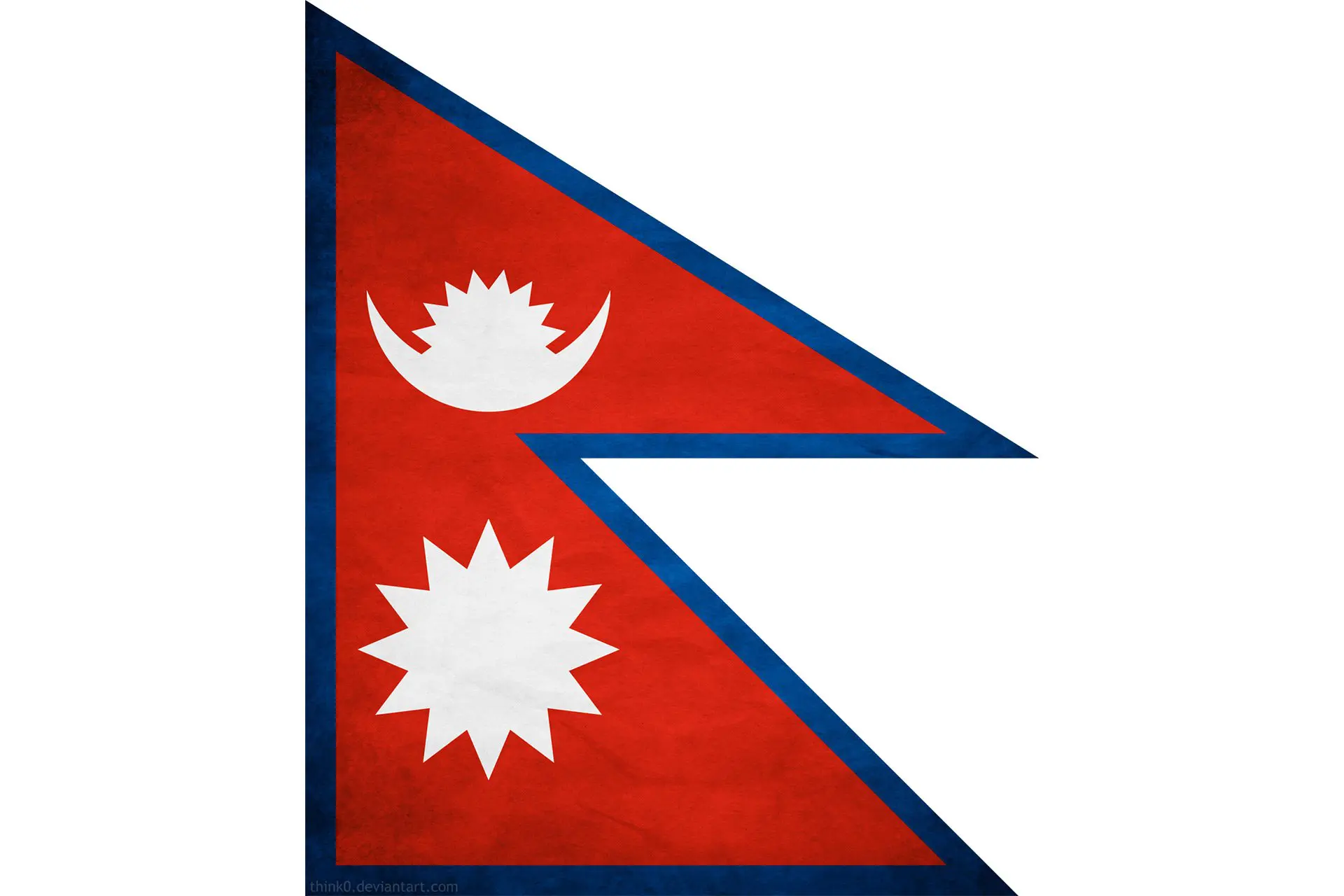
A Beginner’s Guide To Nepal
Nepal is one of those places I long imagined myself going to, but never really thought I would make it to. Thankfully, I managed to…
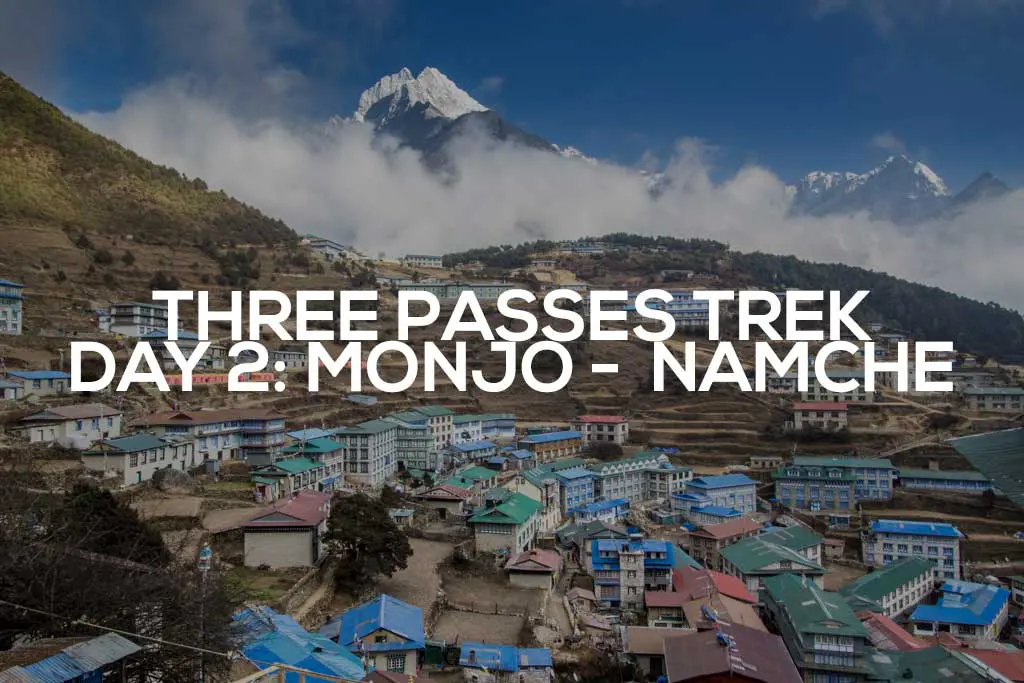
Three Passes Trek Day 2: Monjo to Namche Bazaar
I had forgotten how crazy my dreams are when I sleep at elevation; last night did well to remind me (all I will say is…
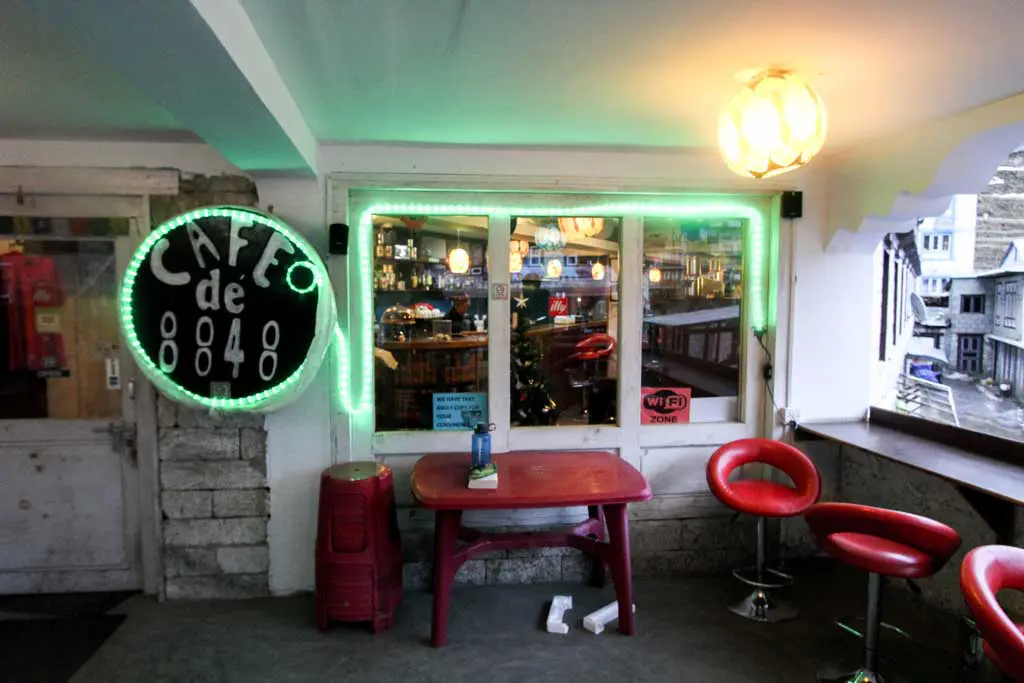
Everest Base Camp Day 12: Day Off In Namche Bazaar
Starting elevation: 11,290 ft / 3,440 m Ending elevation: 11,290 ft / 3,440 m Elevation change: 0 ft / 0 m Starting oxygen: 67% of…

- Everest Three Passes Trek – The Ultimate Trekking Experience
- travels tips
- 03/07/2022 11/07/2023
Trekking in Nepal is one of the best things you can do. The Himalayan range, with its snow-covered peaks, lush valleys, meadows, and forests, is a fantastic place for trekking. Unfortunately, it is among the world’s most popular and expensive treks. But, for those who love the Himalayas, it offers a unique experience they will never forget. You can choose a shorter hike, which takes about five days to complete or take on the 18-day Everest Three Passes Trek .
Everest Three Passes Trek by Himalayan Exploration is an excellent guide to the famous and legendary Everest Base Camp trek. You can find all the essential information every adventurer needs about the famous expedition.
What about the Everest Three Passes Trek makes it so unique? The answer to this question is simple. The combination of three essential factors makes it possible to reach the base camp of Mount Everest. This unique combination of elements has made the Everest Three Pass Trek the most popular Himalayan trek in the world.
The Everest Three Passes Trek is a spectacular and demanding 18-day trek to the magnificent Khumbu region at the foot of Mount Everest. This guide is for those who want to say that they have climbed Everest and for those who want to see what all the fuss is about.
Table of contents
Why go to base camp , the different types of treks, trekking in the everest region, what to bring, where to stay while trekking to everest three passes, how to prepare for an everest three passes trek, accommodation & food, what to expect in the everest three passes trek, what will be an itinerary of the everest three passes trek, when to go, hiking gear , how to go trekking to everest high passes, what to see , what to do , what to do after the trek, everest base camp trek , are there any health risks.
The trip is for both mountaineers and people who love nature. However, we wanted to offer something different, to open up a window to the Himalayas for everyone who hasn’t had the chance yet. While there are many other treks in the region, many are limited to tiny groups of people. In addition, you’ll be able to take your time to get to know the area and its people better than if you were jumping in with thousands of other people.
The trip is an opportunity to share the beauty of the mountains, glaciers, rivers, flora, and fauna with people who would appreciate such natural wonders and feel connected. The journey is about adventure and creating an environment that allows travelers to discover themselves and each other. Our team of experts will prepare you for the trip and teach you how to survive in a harsh environment.
There are lots of reasons why people travel to Nepal. Some love the mountains, some the culture, some the scenery, and others the adventure. But for the majority of people, the main reason for traveling to Nepal is trekking. This may sound simple, but it can be overwhelming if you’re new to the concept. There are three main types of treks: local, guided, and custom. Which one is best for you?
The trek up Mount Everest is no easy task. The sheer physical demands of reaching the top make it the deadliest ascent on the planet. But there are plenty of reasons to head to the world’s highest peak, including the breathtaking views of the Himalayan landscape and the rich culture and history. However, while the trek to Everest Base Camp is undoubtedly the most popular, it’s far from the only one to do.
There are two main reasons why people trek in the Everest region . First, they’re interested in visiting the highest mountain in the world. The trekkers enjoy the physical challenge of walking up and down the hill. They enjoy the accomplishment of standing atop the highest peak on the planet. Other people trek to the Everest region because they want to visit the culture of the Sherpas. They want to experience the breathtaking beauty of the Himalayas and the incredible hospitality and interact with the local culture and economy.
Trekking the Everest region is a challenging task. Many people want to visit the Everest region to look at the sight of Mount Everest. Many people want to go hiking around the Everest region . But, some people want to visit the Sherpas and interact with their culture. This is a big trip, but it can be fun. You will see some breathtaking scenery as you go along. You might want to go hiking to enjoy the beauty of the Mountains.
We’ve compiled some tips for those preparing to head into Nepal for the Everest High Passes Trek . First, make sure you bring the right equipment. If you’re hiking or climbing the mountain, the best chance of success is preparation before going on the trip. This means the right gear, such as a lightweight sleeping bag, hiking boots, and warm clothes, will protect you from high-altitude sicknesses. Also, you don’t get hungry during the journey if you pack plenty of snacks and food.
Many guesthouses, lodges, and campsites are along the trail to the Everest base camp and beyond. In addition, there are many lodges around the Everest region trekking. These lodges are known as the lodges above Namche Bazar. Most of these lodges offer basic amenities at a reasonable price.
Preparation for any climb is vital. If you’re planning for a three-passes trek , there are some basic steps that you should take before you set out on the trail. You need to plan, prepare, pack, and organize. Make sure you do all of these things before you leave. Once you’re away, there’s no turning back. Therefore, the preparation phase is crucial.
Preparing for an Everest three passes trek is similar to things that need to be prepared for multi-day hikes in the Himalayas. You only need to ensure you have the proper gear and plan accordingly. There are two main ways to approach planning for an Everest three passes trek.
First, if you’re planning on hiking up the mountain, you need to ensure that you can physically handle the challenges and dangers of the terrain. For example, many people who trek in the Alps are only caught off guard by a sudden and deadly avalanche. Likewise, if you’re going to the Himalayas, the cold temperatures can make fatal. Secondly, make sure you need to have the right gear and clothes.
The best way to do this trek is to stay at a lodge. This allows you to relax and enjoy the beauty of the mountains while being close to the river. The tea houses offer plenty of food, accommodation, and Wi-Fi.
If you’re going to do the Everest Three Passes Trek , you should consider bringing some snacks. You can buy it in Kathmandu or Thamel, which won’t be expensive.
As the Everest Three Passes Trek takes place across three different mountain valleys. These include the Gokyo Lakes, the Khumbu Glaciers, and the Chhukung Valley.
Each pass offers a different adventure and a unique landscape and view. During the trek, you will cross through many different terrains and landscapes. You will see many stunning views of Mount Everest, Mount Nuptse, Mount Lhotse, Mount Ama Dablam, Mount Makalu, Mount Thamserku, and many other peaks.
It is one of the best treks in the world. No doubt, it is a must-do trekking adventure in Nepa l.
This epic trek will take you to the remote Everest region of Nepal. The journey starts from Lukla and ends at Namche Bazaar, the gateway to the Khumbu region. You will see spectacular scenery, including lush green forests, towering Himalayan mountains, and rivers and streams.
You will also visit the famous Mount Everest Base Camp and the Kalapathar, the last pass before you reach the Everest Base Camp. You can also witness the sunrise over Mount Everest from Kalapatthar.
As the final part of the trek, you will walk across the Everest Base Camp and the Khumbu Icefall. The icefall is the narrowest part of the Khumbu Valley and is known for its frozen glaciers, beautiful lakes, and spectacular view of Mount Everest. The trekking route takes you along the Dudh Koshi River and is an easy walk with many ups and downs.
This question always arises when considering going on the Everest Three Passes Trek . And there is a good reason for that.
As with many of the best treks in the world, the best time to do Everest Three Passes Trek is between September and October. This is because it is around this time of year that the snow melts, and the path is much easier to travel.
It is also around this time of year. There is much less of a chance of bad weather.
However, if you plan on going on a very high-altitude trek, you should note that the higher you go, the colder it gets.
Because of this, the best months to do Everest Three Passes Trek are between April and May and from November to December.
Of course, you need to think about when you want to go. March and April are perfect for this trek if you prefer less crowded. However, October and November are also good months to go to the Everest Base Camp Trek.
You may also want to consider doing this winter trek from January to February.
You need to prepare your body and mind for an adventure. And if you are planning on going on an Everest trekking adventure, you should start by ensuring your body is ready for what’s ahead. This includes ensuring your feet are in good shape and your mind is prepared for the challenge.
For Everest Three Passes Trek , you will need the following items for your body.
Toiletries: No public toilets on the mountain, so you must bring all your toiletries. Pack a toothbrush and paste, shampoo, soap, deodorant, razors, nail clippers, a comb, and a hair dryer.
Laundry: You won’t find a washing machine on the mountain. So pack a small washer for your laundry or ask to lodge owner.
Clothing: Depending on the weather, you may need to change your clothing. It is recommended to bring 2-3 pairs of long pants, 2-3 short pants, 1-2 T-shirts, and 1-2 sweaters. Also, you should bring a jacket and a windbreaker.
Clothes for high altitudes: Pack enough clothes for the altitude. High altitudes mean low oxygen, which means you must wear extra layers of clothes and carry a high-altitude sleeping bag.
Footwear: Footwear is most important when it comes to treks. You have to pack sturdy boots and hiking shoes for your feet.
You can now check your Everest Three Passes Trek packing list , and you’ll know what you need.
We’ve already been told how to trek in Nepal, and now it’s time to find out about the Everest Three Passes Trek.
First, let’s start with the best trek in Nepal, the Everest Three Passes Trek . The reason why the Everest Three Passes Trek is so great. Because of the stunning views of the Himalayas that you get to see during your trek.
You can see the wide range of the Himalayas in the Everest region. From one side of the mountain to the other, you will observe the incredible mountain vistas on this trek. Another thing that makes this trek so unique because it allows you to explore all the valleys, which take about 18 days to complete.
As a result, you need to have good hiking skills, as well as stamina. If you’re on this trek, you should have a lot of patience.
Another thing you need to be aware of is comfort with the weather. It can be cold, it can be wet, and it can be snowy. So, be ready for the altitude, and you should pack accordingly.
If you’re on this trek, you must mentally prepare yourself. You’re going to need to be ready for the challenge, as you’re going to have to climb high mountains and you’re going to have to hike for about six to seven hours a day.
You’re going to need to be in good shape, and you’re going to need to be mentally strong.
A trip to Nepal is incomplete without visiting the Everest Three Passes Trek . This is one of the highest treks in the world, and it offers some of the most amazing views of Mount Everest and its surrounding Himalayan Mountains.
As you travel towards the base camp, you will be greeted by the mighty Mt. Everest. This is one of the most enormous mountains in the world and is the highest peak on Earth. This is a must-visit place during your trek.
The second part of the trek is to visit the Thame and Chhukung villages on the banks of the Dudh Koshi River and Imja River. These are two beautiful towns where you can enjoy the culture of Nepal.
The third part of the trek is to visit Namche Bazaar, a quaint and beautiful town. Here you can buy all the souvenirs and supplies you need.
The fourth and final part of the trek is to visit Everest Base Camp, one of Nepal’s best and most popular places. The view from here is impressive.
First things first, what do you need to pack? Here is what you need:
Pack light: You can pack up to 15 kg per person for a 3-week expedition. So, you must bring clothes, a sleeping bag, and anything else you may need.
Staying safe: Trekking in the Himalayas requires being fully equipped and prepared for eventualities. Therefore, in addition to having the necessary equipment, bring enough supplies and water.
Get ready : Make sure you are fully prepared for this trek before you go. If you are new to trekking, ensure you are fit and well-prepared before you head out. You may also consider getting a backpacking trip with our experienced guides.
Be aware: Keeping your eyes and ears open is essential while trekking. The Himalayas are beautiful, but they also pose a dangerous environment.
Get the best deals : You should save as much money as possible while on the trek. Then, when you arrive at your destination, you can always buy a few extra items if you still have extra cash.
Do the trek : Check the weather conditions before going on this adventure. You will need to plan your route based on the forecast, so ensure you get a weather forecast for your chosen way.
After you’ve completed the Everest Three Passes Trek, you will be excited to continue to other adventures.
Consider the Everest Three Passes Trek if you’re considering a trekking holiday. You can find many different trekking holidays, but the Everest Three Passes Trek is undoubtedly the highest and most challenging.
It is a popular choice because it is so remote, it is relatively easy to reach, and the scenery is spectacular. The views of Mount Everest, Lhotse, Nuptse, and the Khumbu Valley are breathtaking.
The Everest Base Camp Trek is one of the best trekking adventures in Nepal. The stunning landscapes of Mount Everest and the Himalayan mountains provide the perfect backdrop for the tour. It takes you through various high-altitude passes, alpine meadows, lush valleys, and spectacular mountains.
Embarking on trekking to Everest Base Camp presents an incredible opportunity to witness some of the most breathtaking vistas our planet offers. As you ascend to some of the highest altitudes in the world, you will see a thriving ecosystem of flora and fauna that have adapted to survive in these extreme conditions. This unforgettable journey promises to be an adventure of a lifetime.
You should know the health risks involved if you’re interested in participating. As with any trekking, there are various risks to consider. Here are the most common ones and how to prevent or manage them.
Altitude Sickness. Altitude sickness is one of the most common health risks encountered by trekkers. If you are a newbie to trekking, you are much more prone to altitude sickness than someone who has trekked before.
You are also at risk if you are a newbie to trekking. You are more susceptible to altitude sickness than someone who has trekked before because you haven’t acclimatized.
To avoid altitude sickness, it’s recommended that you start trekking 3-4 days before the start of the trek. However, you can reduce your risk if you do the following:
- Avoid caffeine and alcohol, which stimulate your central nervous system and make you more susceptible to altitude sickness.
- Start your trek at a lower altitude, ideally 1,000-3,000m, and gradually work up to 4,000m or higher.
- Take it slow at the start of the trek and build up your fitness level.
- Get yourself to at least 2,500m before the start of the trek.
- Exercise regularly throughout the trek.
- I am staying hydrated. Staying hydrated is the key to avoiding altitude sickness. It will help if you drink plenty of water throughout the trek.
- You can bring your water or buy bottled water at various stations.
- When drinking bottled water, ensure it doesn’t contain added sugar or caffeine.
- You are preventing the cold. However, you may encounter the cold on the Everest Three Passes Trek. You can combat this by wearing a jacket or fleece, keeping your hands warm, wearing gloves, and keeping your feet warm.
Keep yourself safe. You’re more prone to falling off the mountain while trekking. You can protect yourself from this by having a partner, trekking poles, and a helmet.
Hire a guide
You can find local trekking companies and guides in Kathmandu. Hiring local guides will help you get the best experience possible for your trek. In addition, you will benefit from saving a lot of money.
You’ll need a guide if you’re a beginner and have never trekked. A guide is essential because they know how to find the best routes, avoid getting lost, and find water and food.
They’ll also help you with any issues you encounter, whether the weather, your fitness level, or any other obstacles you may face.
A good guide is a priceless asset to have on your trip. However, if you don’t have one, you can contact a local company, which usually charges between US$30 and US$60 per day, depending on your trip duration and the services you need.
As always, you’ll want to look for the best deal. Unfortunately, a good guide will charge much, so you must shop around.
Everest Three Passes Trek is the ultimate trekking experience to conquer Mount Everest. It’s the only three-pass trekking option on the world’s highest peak and the only way to visit Everest Base Camp (5,364m) and Kalapatthar Summit (5,545m).
The trek offers two stunning routes: Clockwise and anti-clockwise. However, many people prefer to hike clockwise because of the overall acclimatization of the expedition.
If you go counterclockwise, on day 6, you must climb up to 5,360 meters on the Renjo La Pass and then sleep at 4,750 meters in Gokyo.
This is contrasted to getting to Dingboche on day five at 4,410 meters, spending two nights there with an acclimatization hike to 5,083 meters on Nangkartshang Peak. So overall, it is just a better acclimatization schedule going counterclockwise versus clockwise.
Both routes offer the same incredible scenery and amazing views. The combination of the ideas and the adventure makes this trek so unique. This is the ultimate Everest trekking experience .
Learn more about the Everest Three Passes Trek at www.himalayanexploration.com/tours/everest-three-pass-trek/ and get the details on their incredible new itinerary, including dates, prices, and availability.
About Author
Leave a reply.
You must be logged in to post a comment.
Ace the Himalaya
Trekking in Nepal, Peak Climbing, Mt Biking and Tours in Nepal, Bhutan and Tibet
- Everest Base Camp Trek - 14 Days
- EBC Trek with Helicopter Return - 12 Days
- Everest Base Camp Luxury Trek - 14 Days
- Everest Base Camp with Island Peak - 19 Days
Everest Three Passes Trek - 20 Days
- Annapurna Base Camp Trek - 13 Days
- Annapurna Circuit Trek - 19 Days
- Ghorepani Poon Hill Trek - 9 Days
- Manaslu Circuit Trek - 15 Days
- Gokyo to Everest Base Camp Trek - 17 Days

Get the chance to cross the three passes of everest region, the Kongma La Pass, Cho La Pass and Renjo La Pass witnessing the remarkable views of Gokyo valley and Khumbu glaciers.
Three Passes Trek Highlights
- Scenic flight to and from Lukla.
- Step inside and experience life as the “mountain people” live, in the heart of Himalayas.
- Everest Base Camp and walking on the Khumbu glacier.
- Encounter the turquoise water of Gokyo Lake.
- Hike up to Kala Patthar and Gokyo Ri, the astounding viewpoints in the Everest Region.
- Witness the remarkable views of super Gokyo valley, massive Ngozumpa glacier and incredible view of Khumbu Himalayas.
- Visit Tengboche Monastery – one of largest Buddhist Monasteries.
- Wonderful staying Experience in remote region.
- Cross the 3 beautiful high elevation passes- Kongma La Pass, Cho La Pass and Renjo La Pass of Everest Region.
Everest Three Passes Trek Overview
Everest Three Passes Trek presents an exceptional chance to witness gigantic Himalayas over 8,000 m. This includes the highest Mt. Everest, Cho Oyu, Lhotse, Makalu, and the Ngozumpa Glacier– the largest glacier in the Nepal Himalayas.
We get to see the sights of Gokyo valley which has a collection of stoned houses and meadows on the shore of a great lake, Dudh Pokhari. Most importantly, we will cross the three high passes in the Everest Region namely Kongma La Pass, Cho La Pass and Renjo La Pass.
The beautiful view from the Everest three passes trek almost knocks everyone off their knees. However, it is equally challenging. This part of the trek is thus one of the most adventurous yet beautiful experiences the trekkers can have.
To begin our trekking from Lukla Airport , we walk down to the Dudh Koshi River. From here we will stick with the major track to Namche Bazaar, the administrative hub of Everest region.
And the remarkable sight of the Khumbu mountains like Ama Dablam (6,856 m), Thamserku (6,608 m) as well as the immense vistas of Everest will spell-bind you. We will also walk on the messy, risky moraines of Ngozumpa Glacier – the main glacier in Nepal.
The varied scenery of the Gokyo Valley including the series of beautiful Gokyo Lakes is enchanting. We will get to observe the first lake Longpongo situated at a height of 4,690 m.
Subsequently, the second lake, Taboche Tsho totally enthralls us with its shiny turquoise blue water alluring in the sun. The Gokyo village set by the third lake and Cho-Oyu peak as a backdrop provides a wonderful sight here.
Short Itinerary
Arrival at Tribhuvan International Airport in Kathmandu (1,400 m) and transfer to hotel. Overnight at a hotel.
Fly to Lukla (2,840 m) from Kathmandu – 35 minutes or drive to Manthali/Ramechhap – 5 to 6 hours and a – 20 minutes flight to Lukla, and then trek to Phakding (2,610 m) – 3 to 4 hours. Overnight at a guesthouse.
Trek to Namche Bazaar (3,440 m) from Phakding – 5 to 6 hours. Overnight at a guesthouse.
Acclimatization Day at Namche Bazaar. Hike to Hotel Everest View (3,880 m) and back – 4 to 5 hours. Overnight at a guesthouse.
Trek to Tengboche (3,860 m) from Namche Bazaar – 5 to 6 hours. Overnight at a guesthouse.
Trek to Dingboche (4,410 m) from Tengboche – 5 to 6 hours. Overnight at a guesthouse.
Acclimatization Day at Dingboche. Hike to Nangkartsang Peak (5,083 m) and back – 4 to 5 hours. Overnight at a guesthouse.
Trek to Chhukung (4,730 m) from Dingboche – 4 to 5 hours. Overnight at a guesthouse.
Trek to Lobuche (4,910 m) via Cross Kongma La pass (5,535 m) – 7 to 8 hours. Overnight at a guesthouse.
Trek to Everest Base Camp (5,364 m) and then back to Gorak Shep (5,164 m) – 8 to 9 hours. Overnight at a guesthouse.
Early morning hike to Kala Patthar (5,555 m) and then, descend to Lobuche (4,910 m) – 8 to 9 hours. Overnight at a guesthouse.
Trek to Dzongla (4,830 m) from Lobuche – 4 to 5 hours. Overnight at a guesthouse.
Trek to Gokyo (4,800 m) from Dzongla via Crossing Cho La Pass (5,368 m) – 8 to 9 hours. Overnight at a guesthouse.
Climb Gokyo Ri (5,483 m) and return back to Gokyo – 3 to 4 hours. Overnight at a guesthouse.
Trek to Lunden (4,300 m) via Crossing Renjo La Pass (5,340 m) – 7 to 8 hours. Overnight at a guesthouse.
Trek to Thame (3,800 m) from Lunden – 4 to 5 hours. Overnight at a Guesthouse.
Trek to Namche Bazar (3,440 m) from Thame – 4 to 5 hours. Overnight at a guesthouse.
Trek to Lukla (2,840 m) from Namche Bazaar – 6 to 7 hours. Overnight at a guesthouse.
Fly to Kathmandu – 35 minutes or Manthali/Ramechhap – 20 minutes from Lukla (2,840 m) and same-day drive to Kathmandu – 5 to 6 hours. Overnight at a hotel.
Transfer to the International Airport for Your Final Departure.
Our standard itinerary might differ slightly due to unpredictable happenings and events out of our control. Factors such as flight cancellation/delay, unfavorable weather, natural calamities, newly implemented government rules, political affairs, trekkers’ health condition, etc., are possible. Evaluating the situation’s possible solutions allow the trekking to resume as much as possible based on the best alternatives. In these times, we look for your cooperation and flexibility.
It is advised you arrive a day before the trip start date so you can rest and it also gives you time to buy clothing equipment and gear required for the trek. Also, it is best if you book your international flights with spare days in Nepal before and after your trek in case of any flight delays or cancellations due to weather. Moreover, you have options to customize this trip where you can add on a sightseeing tour in Kathmandu, other adventure sports or day trips around the country before or after the trek.
Lukla flight information
We would like to inform you regarding the Lukla flight details which may affect your itinerary. During peak seasons, (including March, April, May, October and November) the flight to Lukla will be operated from Ramechhap/Manthali due to air traffic expansion, which is about a 5 to 6-hour drive from Kathmandu. Whereas, during nonpeak seasons, (including January, February, June, July, August, September and December) the flight is operated from Kathmandu.
Please be aware that the decision regarding the operation of flights solely depends on the airline and is influenced by the volume of travelers during the specific month.
Unpleasant weather conditions, congested traffic in the Airport, unmanaged runway, topographical difficulties, etc., are the significant reasons for Lukla flight delay/cancellation. Therefore, if you intend on trekking in the land of Everest region, arranging additional one or two days in your trip is highly preferable. This will help in case of flight delay/cancellation and thus board on the pre-planned international flight.
Departures & Availability
Our groups are small with maximum 14 people. We create groups of independent travelers, friends and families which maintains close interpersonal connection, engage more and get into depth of the journey. Choose a date from the calendar to reserve your spot.
Looking for personalized experience? We organize privately guided journey which is mainly designed to fit your taste and interest. Please fill out the form below to get started.
Departure Date
- Lead Traveler's Full Name *
- No. of Travellers * No. of Travellers 1 2 3 4 5 6 7 8 9 10 11 12 13 14 15 16 17 18 19 20 20+
- Country Country Afghanistan Albania Algeria American Samoa Andorra Angola Antigua and Barbuda Argentina Armenia Australia Austria Azerbaijan Bahamas Bahrain Bangladesh Barbados Belarus Belgium Belize Benin Bermuda Bhutan Bolivia Bosnia and Herzegovina Botswana Brazil Brunei Bulgaria Burkina Faso Burundi Cambodia Cameroon Canada Cape Verde Cayman Islands Central African Republic Chad Chile China Colombia Comoros Congo, Democratic Republic of the Congo, Republic of the Costa Rica Côte d'Ivoire Croatia Cuba Cyprus Czech Republic Denmark Djibouti Dominica Dominican Republic East Timor Ecuador Egypt El Salvador Equatorial Guinea Eritrea Estonia Ethiopia Faroe Islands Fiji Finland France French Polynesia Gabon Gambia Georgia Germany Ghana Greece Greenland Grenada Guam Guatemala Guinea Guinea-Bissau Guyana Haiti Honduras Hong Kong Hungary Iceland India Indonesia Iran Iraq Ireland Israel Italy Jamaica Japan Jordan Kazakhstan Kenya Kiribati North Korea South Korea Kosovo Kuwait Kyrgyzstan Laos Latvia Lebanon Lesotho Liberia Libya Liechtenstein Lithuania Luxembourg Macedonia Madagascar Malawi Malaysia Maldives Mali Malta Marshall Islands Mauritania Mauritius Mexico Micronesia Moldova Monaco Mongolia Montenegro Morocco Mozambique Myanmar Namibia Nauru Nepal Netherlands New Zealand Nicaragua Niger Nigeria Northern Mariana Islands Norway Oman Pakistan Palau Palestine, State of Panama Papua New Guinea Paraguay Peru Philippines Poland Portugal Puerto Rico Qatar Romania Russia Rwanda Saint Kitts and Nevis Saint Lucia Saint Vincent and the Grenadines Samoa San Marino Sao Tome and Principe Saudi Arabia Senegal Serbia Seychelles Sierra Leone Singapore Sint Maarten Slovakia Slovenia Solomon Islands Somalia South Africa Spain Sri Lanka Sudan Sudan, South Suriname Swaziland Sweden Switzerland Syria Taiwan Tajikistan Tanzania Thailand Togo Tonga Trinidad and Tobago Tunisia Turkey Turkmenistan Tuvalu Uganda Ukraine United Arab Emirates United Kingdom United States Uruguay Uzbekistan Vanuatu Vatican City Venezuela Vietnam Virgin Islands, British Virgin Islands, U.S. Yemen Zambia Zimbabwe
- How did you find Ace the Himalaya? * How did you find Ace the Himalaya? Google Search Yahoo Other Search Engine Facebook Twitter Newsletter Ace Blog I m a Previous Client Friend Recommendation Lonely planet Trip Advisor Magazine Advertisement Brochures/flyers I met you in Trade shows I am your Trade partners From North American Representative From European Representative From Australian Representative The Clymb Groupon Travel Zoo Scoupon From Other Deal Sites Others
- I agree to Ace the Himalaya Terms and Conditions
- Prove your humanity : thirteen + two =
- Comments This field is for validation purposes and should be left unchanged.
Price Includes
- All (international and domestic) airport transfers on a tourist vehicle
Standard twin-sharing/double accommodation in a 3-star hotel for 2 nights in Kathmandu including breakfast (Private room accommodation can be organized at an extra cost)
Twin-sharing guesthouse accommodation during the trek for 17 nights in the Everest region with attached toilets in Lukla, Phakding & Namche
- All your standard meals during the trek (Breakfast, Lunch, and Dinner) including one hot drink and seasonal fruits
- Experienced, first-aid trained, government licensed, English-speaking Ace the Himalaya's trekking guide
- Permits for Sagarmatha/Everest National Park and TIMS (Trekkers' Information Management System)
- Porters during the trek for carrying luggage (1 porter for every 2 clients)
- Wages, accommodation, meals, gear, insurance, and medications for all staff
- Filtered water in the trails using Water Filter or using water purification tablets
- Round-trip airfare between Kathmandu/Manthali and Lukla
- 1 Ace the Himalaya’s duffel/kit bag, trekking map, sun hat, Buff (Neck Gaiter) and trip completion certificate
- A farewell dinner on the last night in Nepal
- All administrative expenses and government taxes
Price Excludes
- Meals (lunch and dinner) in Kathmandu
- International flight fare and airport departure tax
- Any beverages including bottled and boiled water
- Travel insurance along with high-altitude emergency evacuation coverage
- Tips to trekking staff and driver
- Nepal Entry Visa (Visa can be acquired easily after your arrival at Tribhuvan International Airport in Kathmandu with a fee of USD 50 for 30 days visa and USD 125 for 90 days visa)
- Personal Trekking gear and equipment
- Any expenses other than the Price Include section
Everest Three Passes Trek Itinerary
Day 01: arrival at tribhuvan international airport in kathmandu and transfer to hotel.
One of our officials will greet you at the Tribhuvan International Airport, Kathmandu, upon your arrival. We will take you to the hotel in our private tourist vehicle. Pre-trip meeting will be done and you will meet with your trip guide. Make sure to confirm your queries about trekking in the mountains.
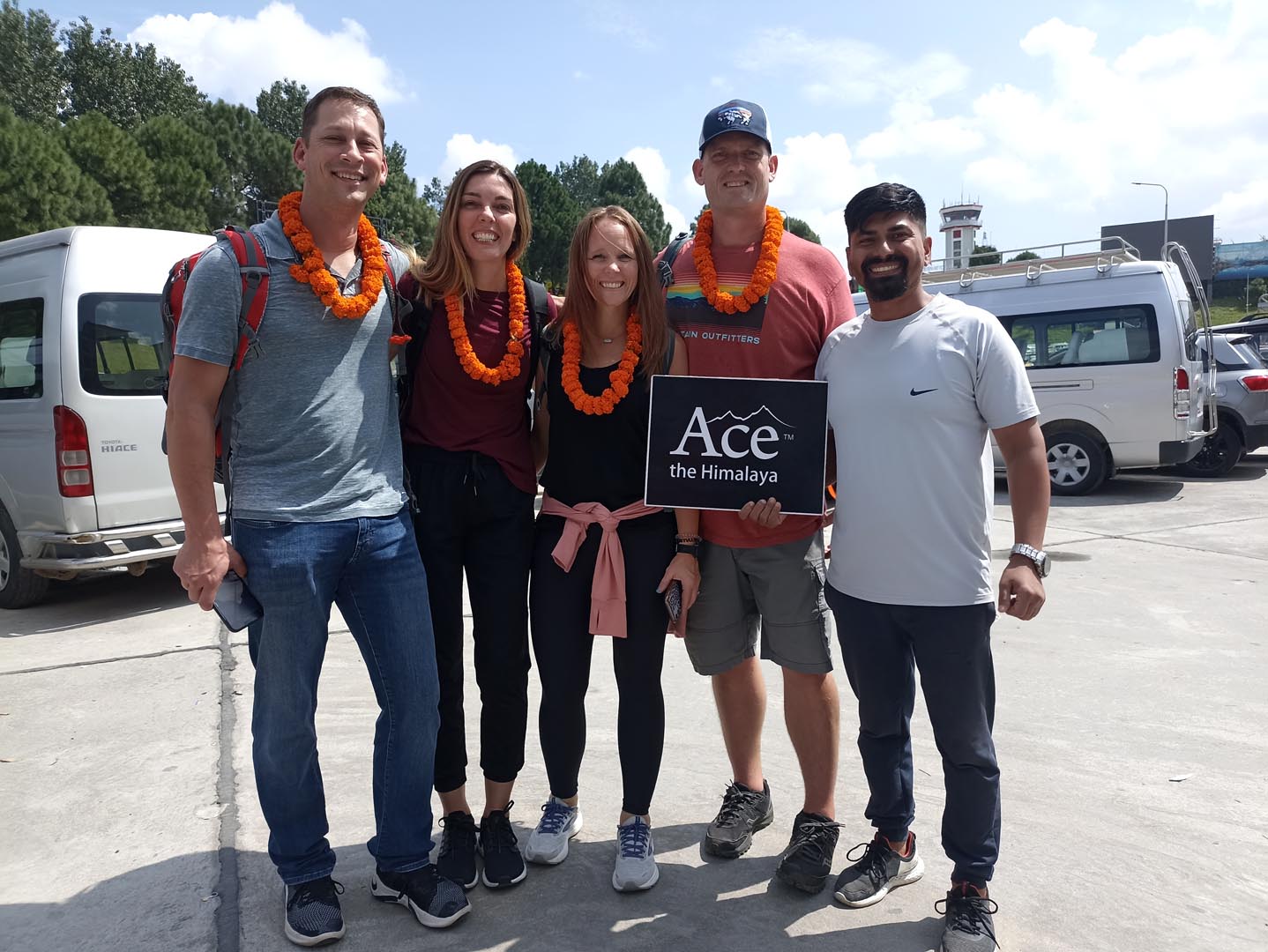
Note : Pre-trip meeting will be done at the office if you arrive before 4 pm and in your hotel itself if you arrive later in the evening. Be sure to bring two copies of passport-sized photos and a readable copy of your travel insurance policy to the meeting. These documents help to acquire trekking permits and related documentation during the trek. Pay the remaining balance of your invoice and sign in the legally binding trip form and non-liability disclaimer.
Day 02: Fly to Lukla from Kathmandu or drive to Manthali (Ramechhap) & flight to Lukla and then, trek to Phakding
Manthali to Lukla Flight (March, April, May, October, and November) During peak seasons, such as March, April, May, October, and November, the flight to Lukla will be operated from Ramechhap/Manthali due to air traffic expansion. The Manthali/Ramechhap airport is about a 5 to 6 hours drive away from Kathmandu. On this day we wake up at 1:30 to 2:30 am and take an escorted shuttle to Manthali airport on a shared tourist vehicle and board a 20-minute flight to Lukla.
Kathmandu to Lukla Flight (January, February, June, July, August, September, and December) The flight to Lukla is typically operated from Kathmandu during nonpeak seasons, which include January, February, June, July, August, September, and December . Please be aware that the decision regarding the operation of flights solely depends on the airline and is influenced by the volume of travelers during a specific month. On this day we wake up at 5 to 6 am. Our staff will escort you to the domestic airport terminal in Kathmandu and board a 35-minute flight to Lukla.
Helicopter Option
You have the option to book a direct helicopter flight from Kathmandu to Lukla for an extra charge of USD 550 per person. This price is quoted on a 5-people sharing basis. This is the best alternative to avoid the long drive to Manthali airport during peak season (March, April, May, October, and November).
Flight to Tenzing-Hillary Airport usually takes place early in the morning. We suggest you make all the sorting and packing the day before, so there is no rush on Day 2. Once you reach Lukla, have your breakfast while our guide will make an arrangement for porters. We assign one porter to every two clients. Begin the trek by descending towards the Dudh Kosi River where you join the main trail to Namche Bazaar, located just above Chaunikharka (2,713 m/8,900 ft). The walking is easy and after passing through the small village of Ghat (2,550 m/8,366 ft), it is a short walk to Phakding.
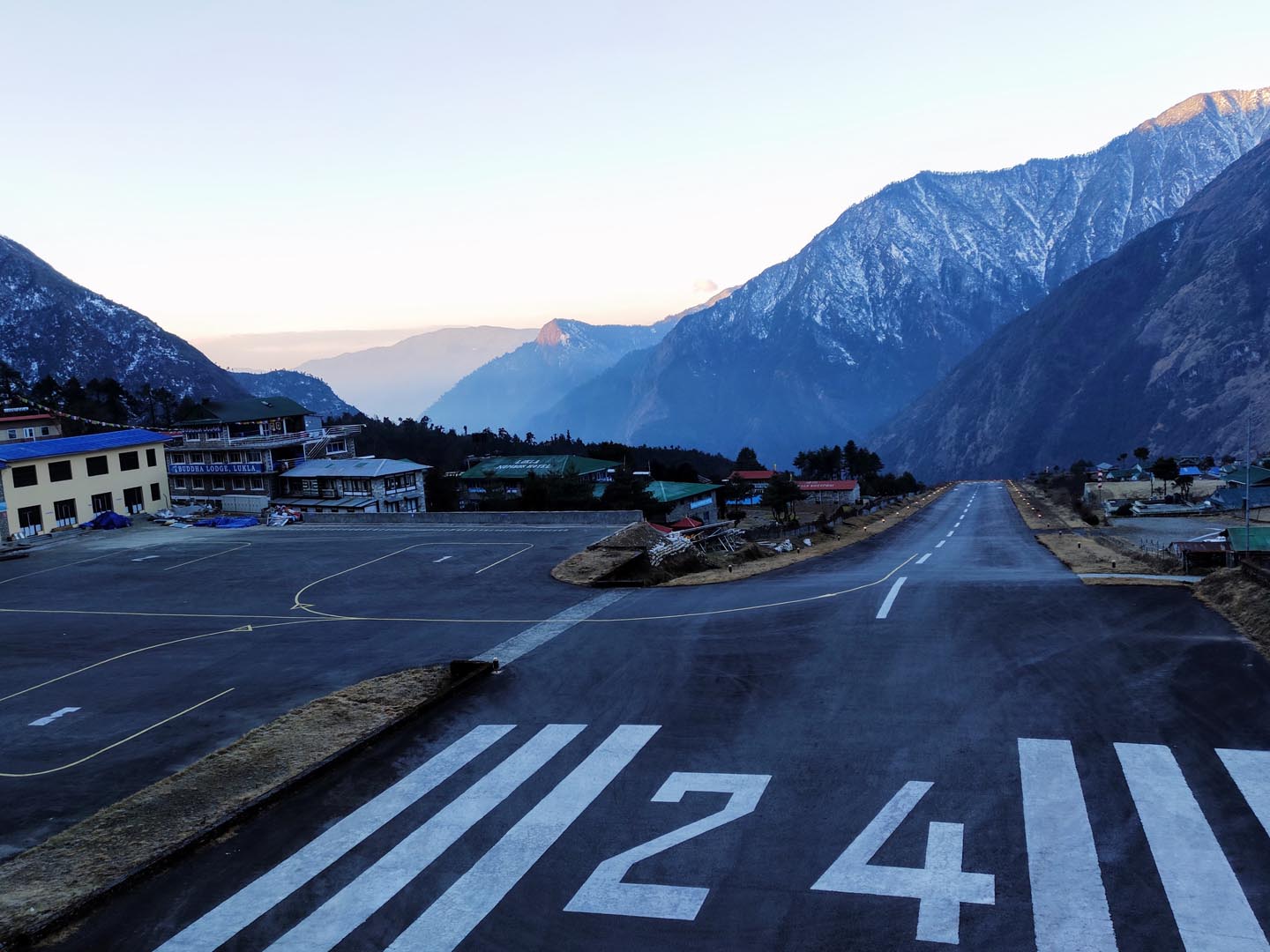
Day 03: Trek to Namche Bazaar from Phakding
There are many suspension bridges laden with prayer flag where Dudh Koshi River is following our way up to Namche Bazaar. Namche Bazaar is the main trading center in Khumbu region.
It is also known as Gateway to Everest. There are many good facility hotels and restaurant along with proper pubs and cyber cafés.
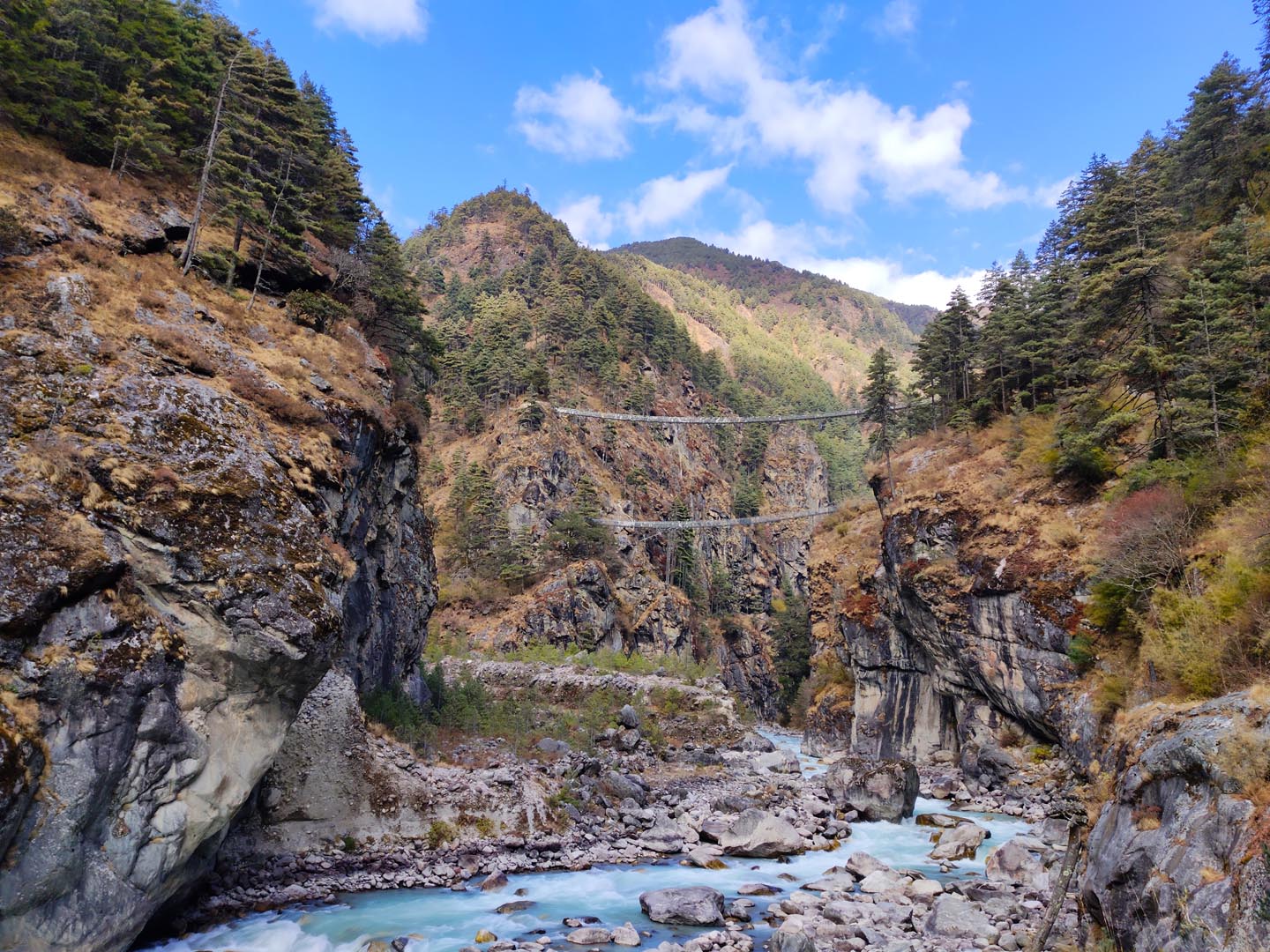
Day 04: Acclimatization Day at Namche Bazaar. Hike to Hotel Everest View and back
We will spend a day in Namche Bazaar in order to acclimatize and adjust to the thinning air. We will trek a short distance to a museum that is celebrated for its exhibits of the traditional customs of the Sherpa people.
We will also hike up the Syangboche Airport and the Everest View Hotel, one of the highest-placed hotels in the world. From this point, we can see rewarding views of the Himalayas including Mt Everest.
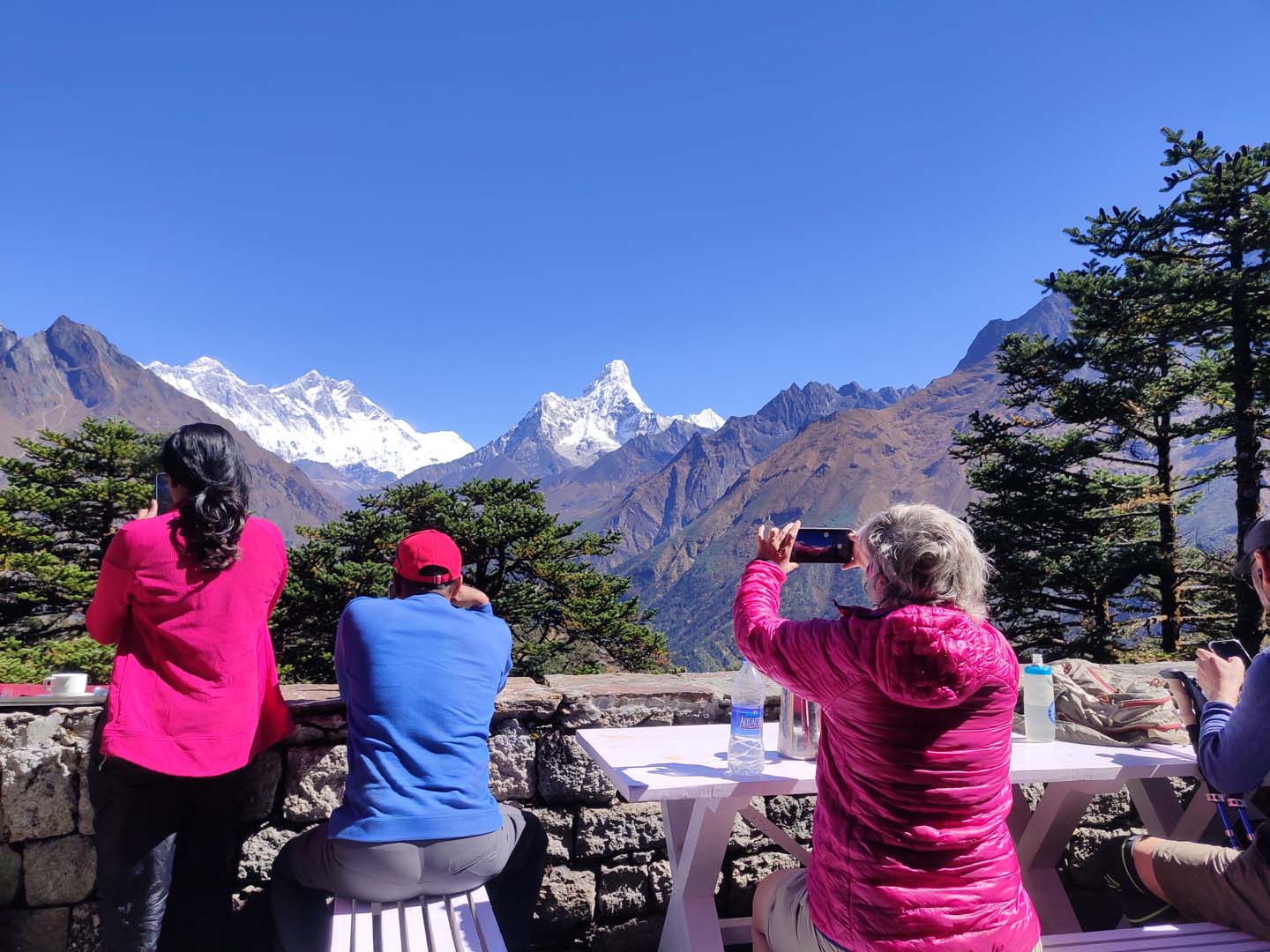
Day 05: Trek to Tengboche from Namche Bazaar
The views of Khumbi La and Taboche are magnificent throughout the day. We should dress warmly because cold wind blows throughout the trail. In the middle of the trek, there are two trails which divides into lower and upper trail. To continue our journey, we take left.
In Phorste Thanga there are few houses and lodges. After some hours of walking we reach our today’s destination Tengboche. It is inhabited by Sherpa’s where their main source of income comes from tourism.
There is an important and largest Buddhist Monastery, Tengboche Monastery where Ama Dablan lies behind.
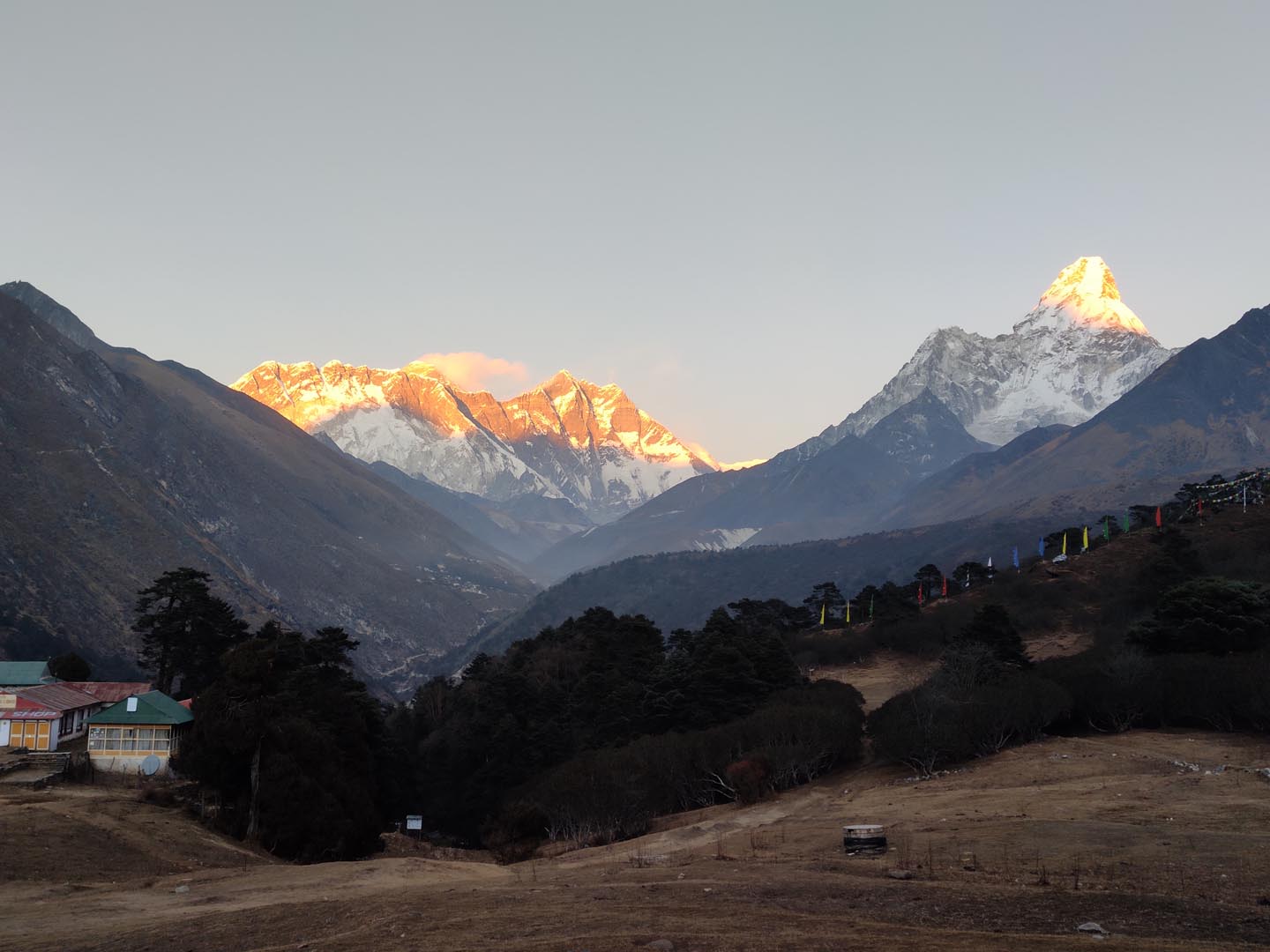
Day 06: Trek to Dingboche from Tengboche
After breakfast we start our trek towards Dingboche. Today’s trek covers 9.1Km and its easy trail with going downhill on a fairly wide path covered with beautiful rhododendron trees.
After few hours of walk and crossing bridge over Imja River, it takes us to Pangboche. In the whole trek, we can see wide open areas where trekkers can view more beautiful landscapes.
Walking trail above Pangboche, we get a magnificent view of Himalayas and Pangboche Monastery. We move ahead towards the Imja valley and finally we reach Dingboche.
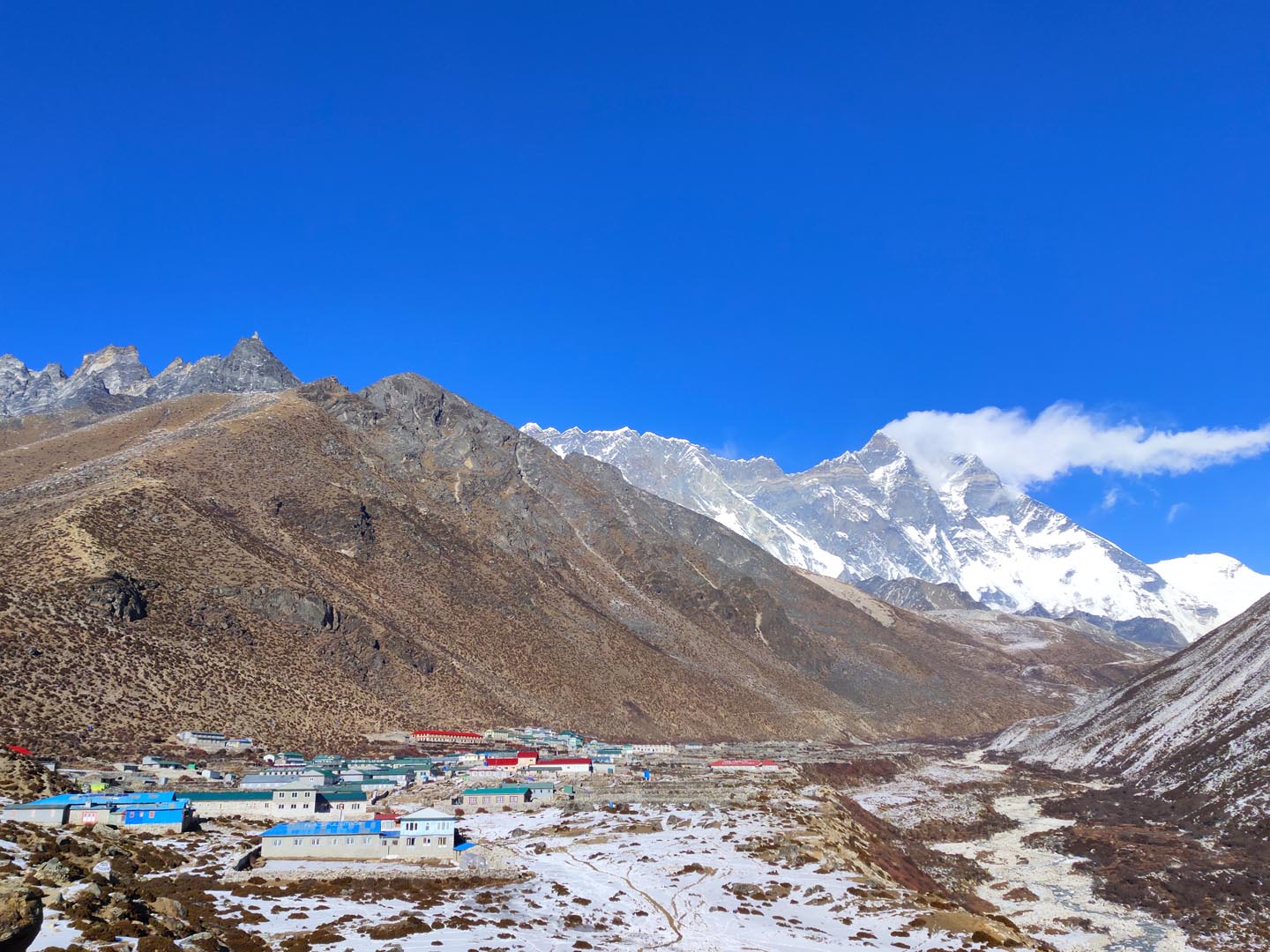
Day 07: Acclimatization Day at Dingboche. Hike to Nangkartsang Peak and back
Dingboche is a popular stop for trekkers and climbers headed to Mt. Everest, Ama Dablam and Imja Tse. It is a Sherpa village. According to the 2011 census, its population was around 200. There is also a helicopter landing pad with internet café (using satellite technology) and one of the world’s highest billiard parlors.
One can see great view of many Himalayas from Nagarjung Hill which may take some hour of hike from Dingboche.
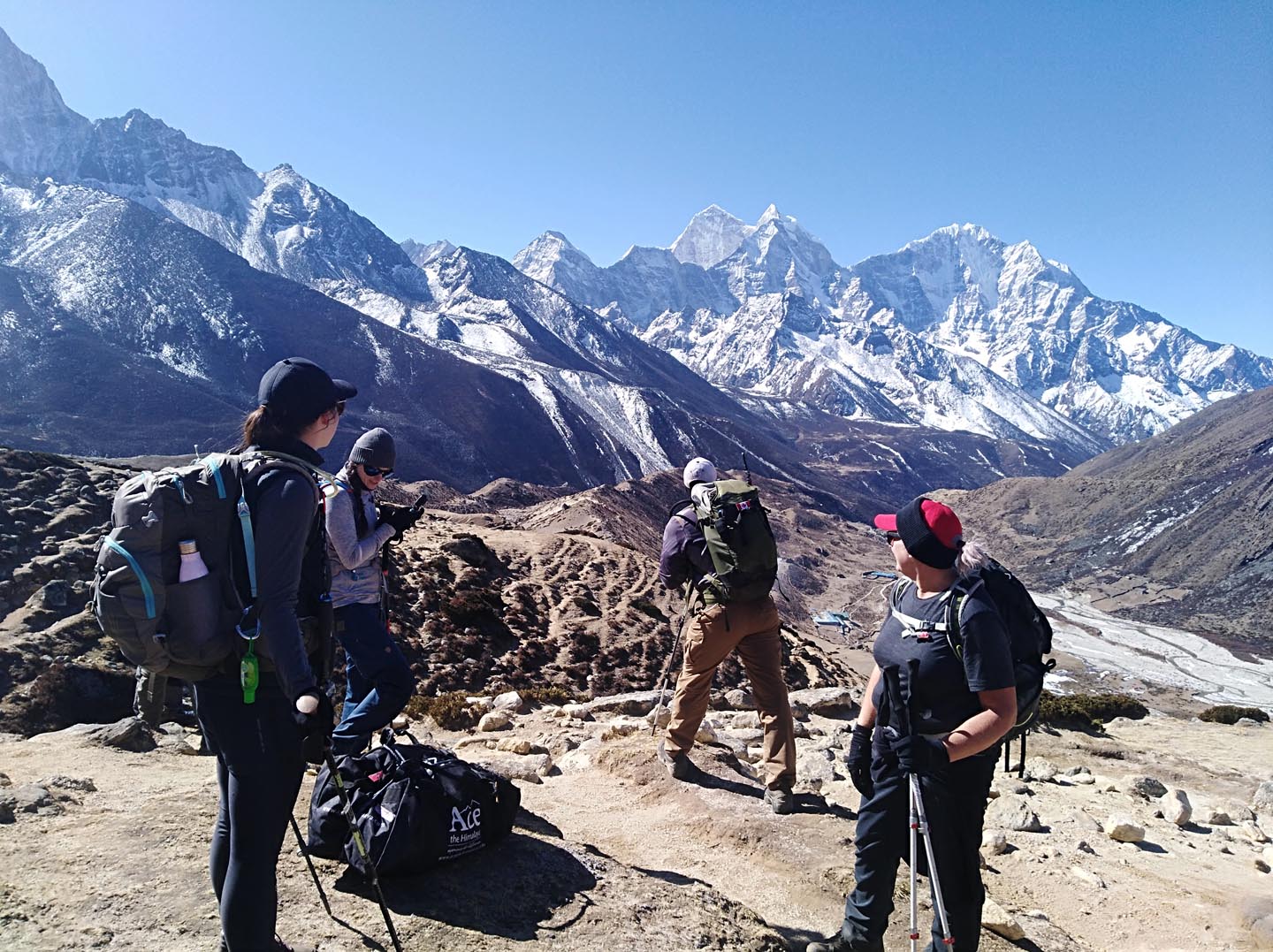
Day 08: Trek to Chhukung from Dingboche
Today, the trail is combined with some uphill and downhill climbs. After breakfast in Dingboche, we move towards Chhukung and have our lunch over there. As our last destination is Chhukung for the day you can slowly and steadily walk on the trails.
Along the trail, you can see several traditional farms and fences built from local stones. And then pass through Imja Khola valley, Bibre (which is a yak herdsman place). After half an 4 to 5 hours of walking, we reach to Chhukung where we will have lunch and stay overnight.
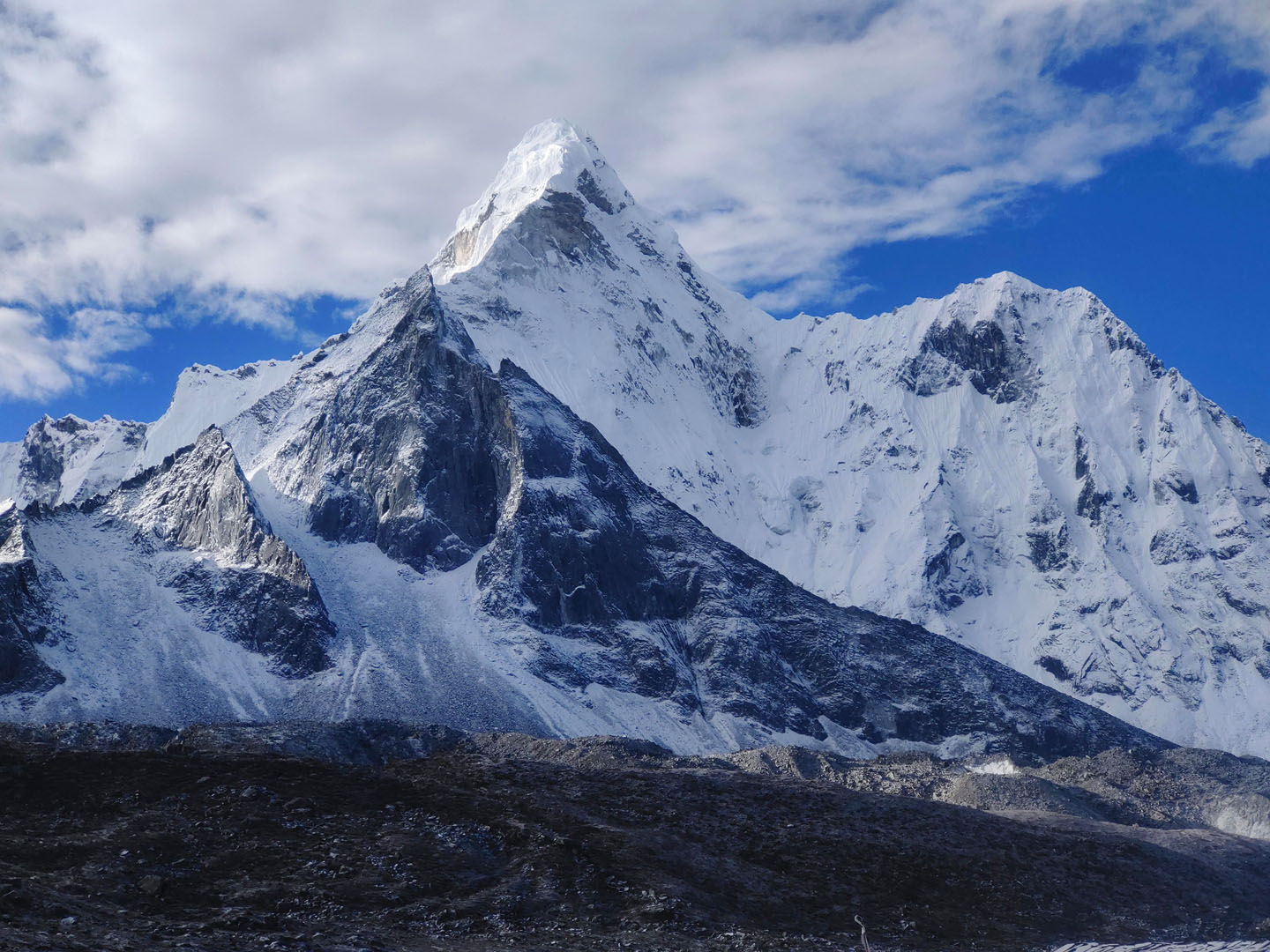
Day 09: Trek to Lobuche via Crossing Kongma La Pass
Today we climb for about 8-9 hours to reach the top of Kongma La pass. There are two trails for Kongma La pass; one is to the northwest of Chhukung over the Nuptse Glacier moraines and another one is back to Bibre and trek on the trail above the Niyang Khola.
As there aren’t any hotels, shops and tea houses, we carry our own packed foods and water. At the top of Kongma La pass, we can see beautiful Buddhist prayer flags. By turning north of Khumbu Glacier, we reach Lobuche.
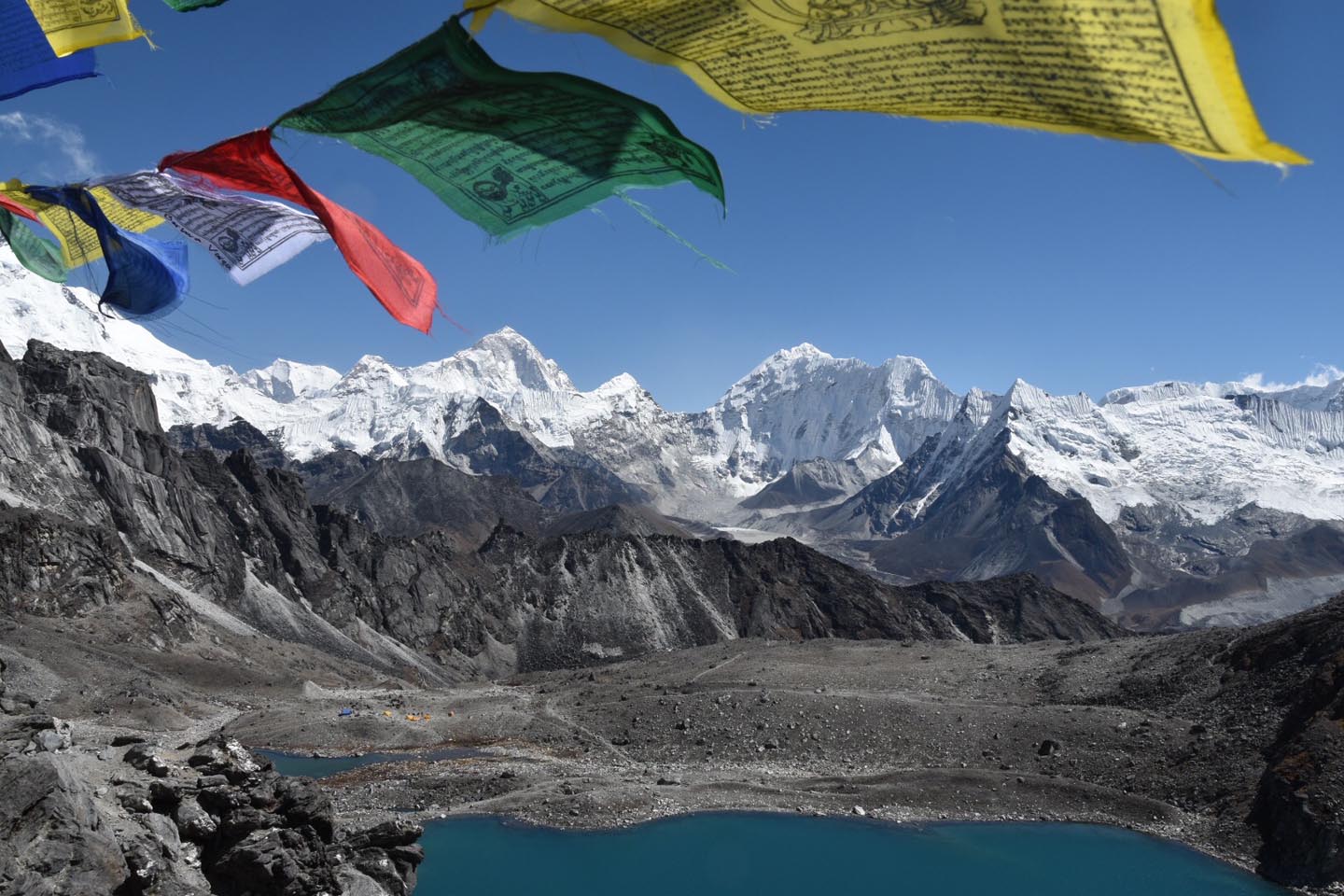
Day 10: Trek to Everest Base Camp and then back to Gorak Shep
Today the trail is of average level up to Gorak Shep. Before heading off to Everest Base Camp, we take lunch and rest at Gorak Shep which takes around 2 hours.
If the weather is good, we will be able to see beautiful Himalaya’s all-round. Then we head towards Everest Base Camp. Everest Base Camp is the closest you can get to Mt. Everest without mountaineering equipment and also highest altitude that most will reach without a climbing permit.
The view of the Khumbu Icefall from Base Camp is spectacular. The earthquake which occurred on 25 th April 2015 caused some damage on the route of the Everest Base Camp. We return back to Gorak Shep for the night.
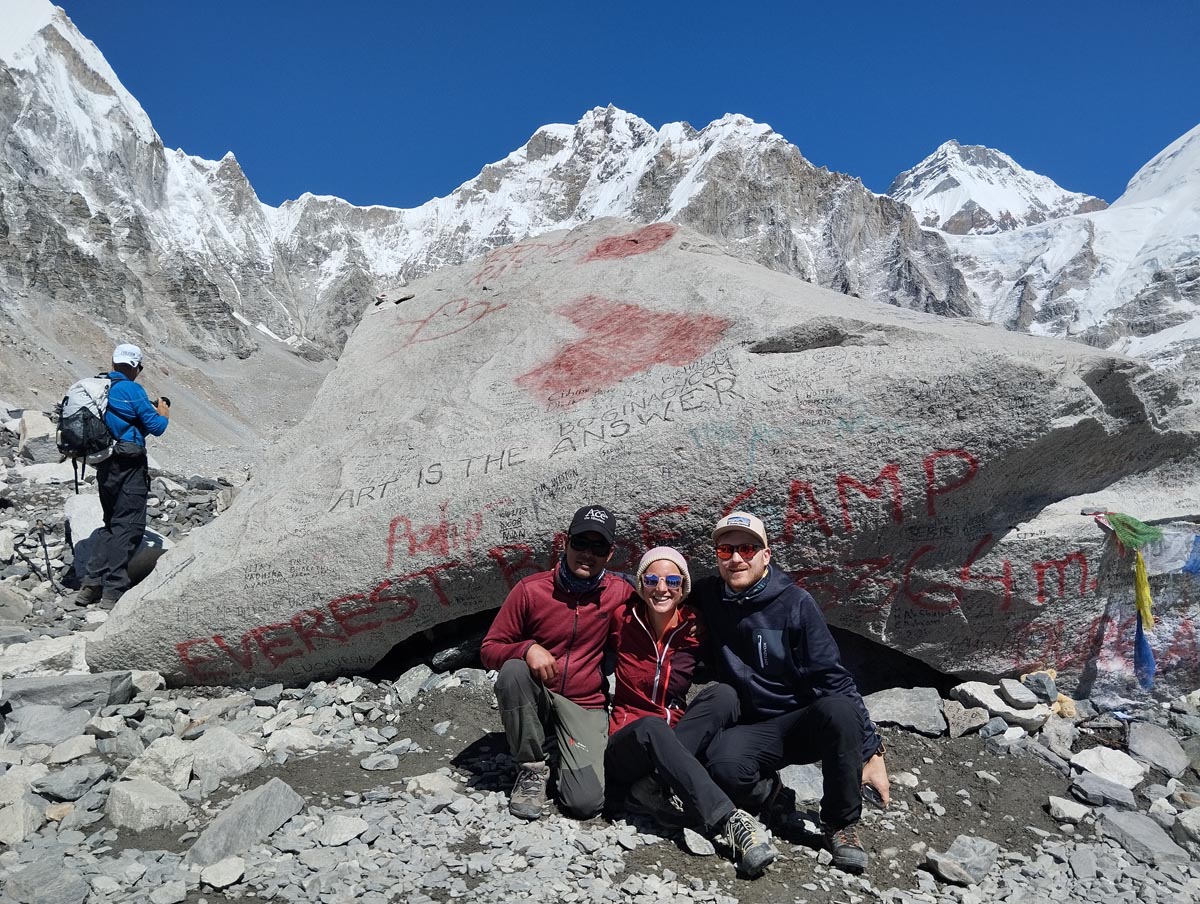
Day 11: Early morning hike to Kala Patthar and then, descend to Lobuche
This will be one of the most difficult yet rewarding days of the trek. Most of this day is spent climbing Mt. Kala Patthar at 5,555 m. From Mt. Kala Patthar one can see the superlative views of Everest.
After spending some time in Kala Patthar we move downwards toward Lobuche. It is a small village surrounded by the Rocky Mountains and the Himalayas. There is a mostly old ancient types of lodges but in recent years more facilitated lodges have been opened where some of them provide internet as well as oxygen serves.
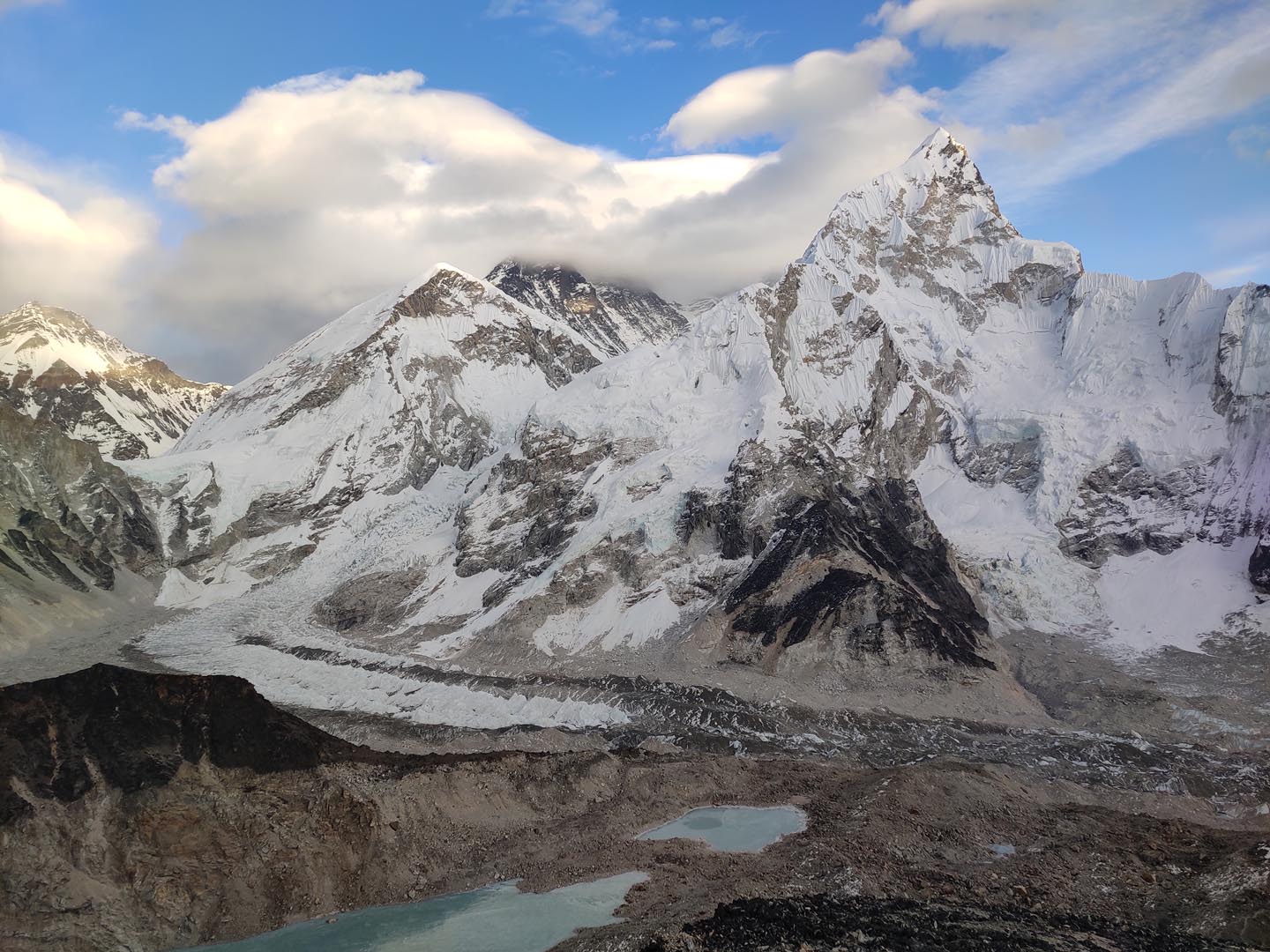
Day 12: Trek to Dzongla from Lobuche
From Lobuche we start to walk downwards where after few hours, trail divides into two and we take right side for Dzongla. We can see stupa and tombstones in the distance. After that we trek upwards where we can see Chola Tsho Lake nearby. We continue to trek by crossing Chola Khola on a bridge before reaching Dzongla.
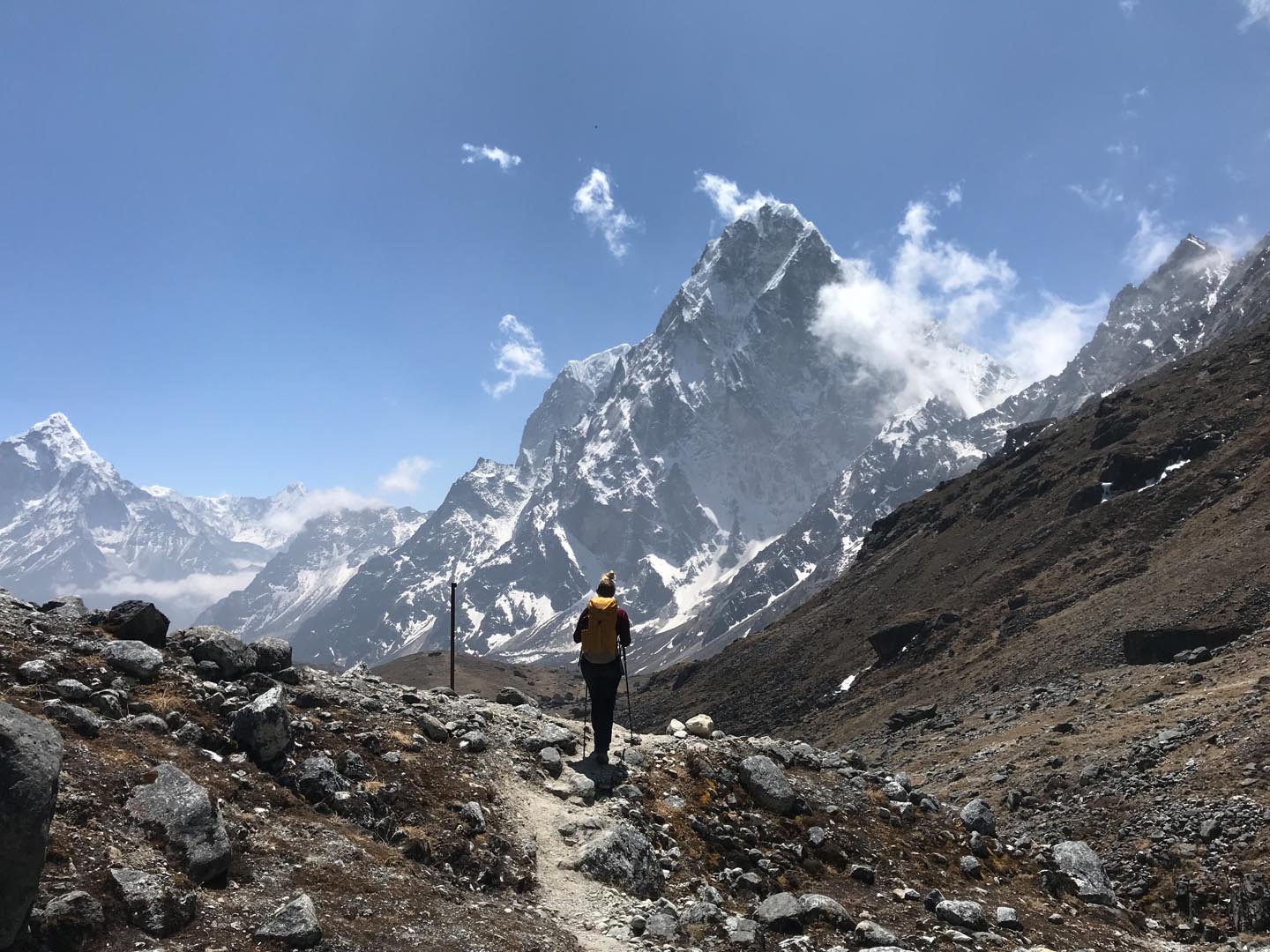
Day 13: Trek to Gokyo from Dzongla via Crossing Cho La Pass
Today we have to start our trek before 4-5 am so we can cross Cho La pass before mid-day and re-assess the hike when the weather turns bad. Today the route maybe little difficult due to high altitude and steeply loose rock.
Snow may cause some problem while crossing Cho La pass and rock fall can also be the problem although weather is good. As a result you can see magnificent view from the top of Cho La Pass then we will descend to our destination, Gokyo (4,800 m).
We have to cross Khara, Pangka, and Ngozumpa glacier (which is the longest glacier in Nepal). We can see the beautiful view of Kantaga and big Mountain Cho-oyu. There are series of six lakes where third one is the Gokyo Lake.
There is a small village near the Gokyo Lake where we will stay 2 nights as we will have sightseeing and hiking trip around Gokyo.
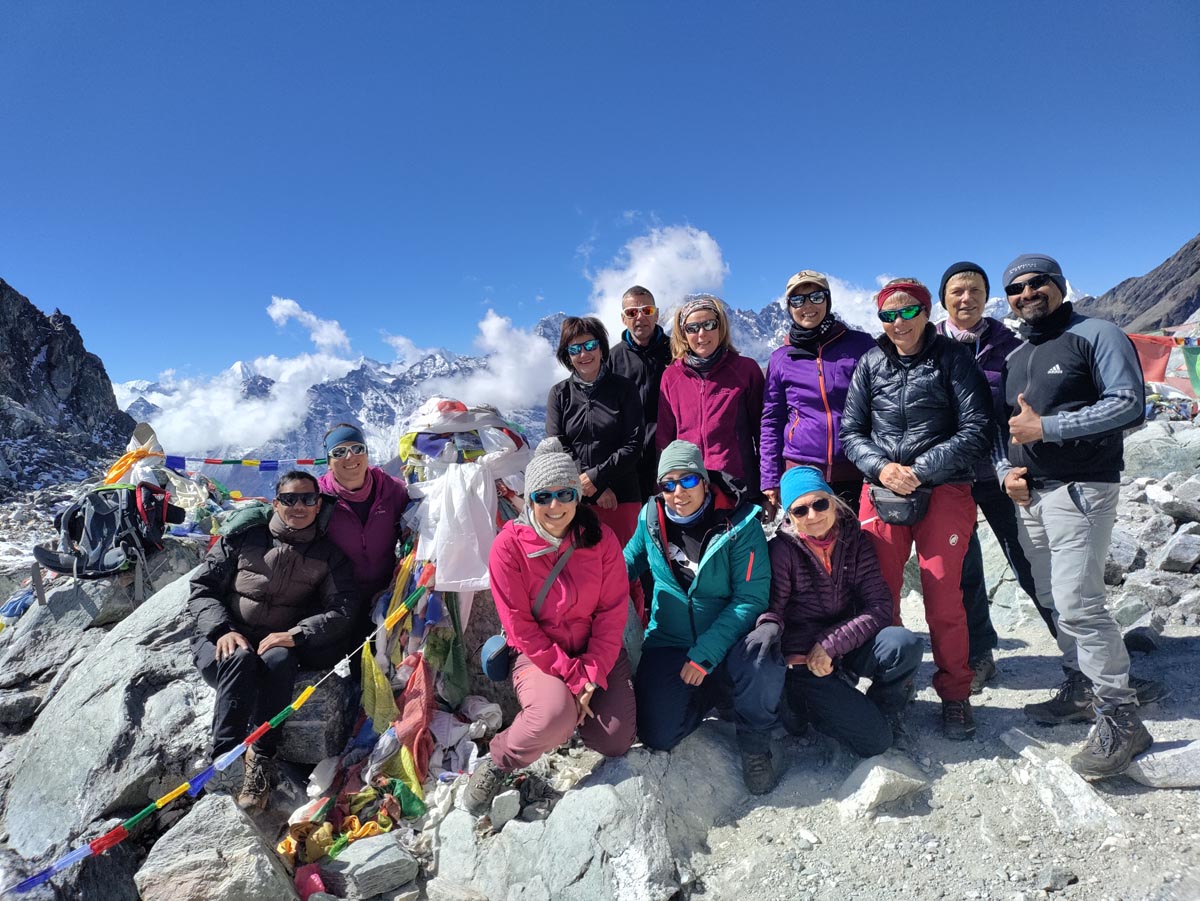
Day 14: Climb Gokyo Ri and return back to Gokyo
Early in the morning, we have a steep climb up to the top of Gokyo Ri at an elevation of 5,483 m. There are ample rewards for those who attempt this trip. You get stunning views of the super Gokyo valley, the massive Ngozumpa glacier and an incredible panoramic view of the whole Khumbu Himalayas, including the giants; Everest, Lhotse, Nuptse, Makalu, Cho-Oyu and Gychung Kang.

Day 15: Trek to Lunden from Gokyo via Crossing Renjo La Pass
Today we start our trek in the morning. Our trek for today is long but on the normal trail. We can see amazing view of Mt. Everest from the top of the Renjo pass. Then we descend down to Lunden for our today’s final destination.
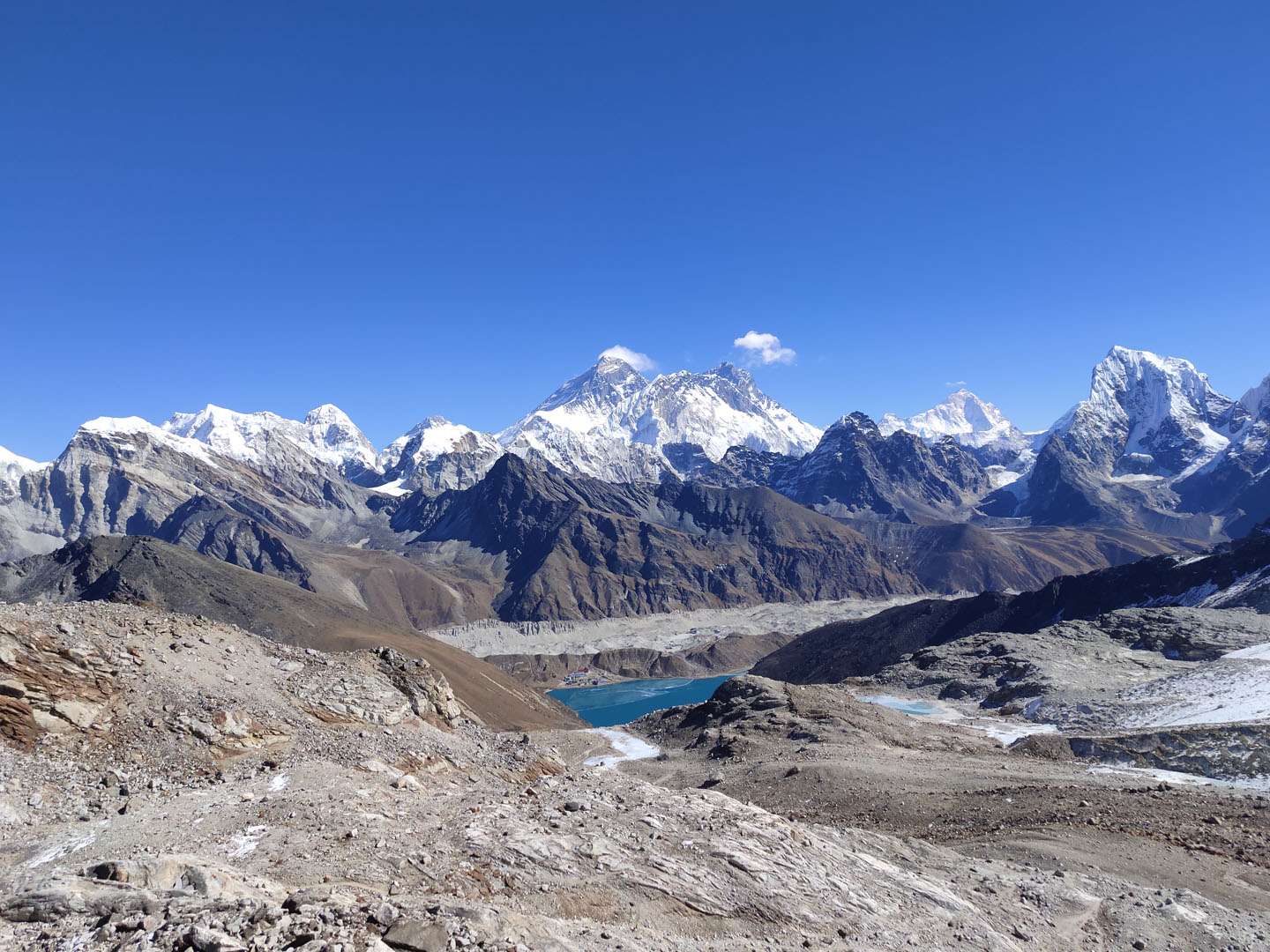
Day 16: Trek to Thame from Lunden
We start our trek after breakfast. Today, the trail will mostly descend down to to Thame.
While on the trail we can see amazing snow peaks. About 150 meters above Thame, there is a Thame Monastery, a picturesque monastery set among the many homes of monks and lay people.
It resides on the side of a hill overlooking the valley. This is the site for the spring celebration of the Mani Rimdu festival, held about the middle of May each year.
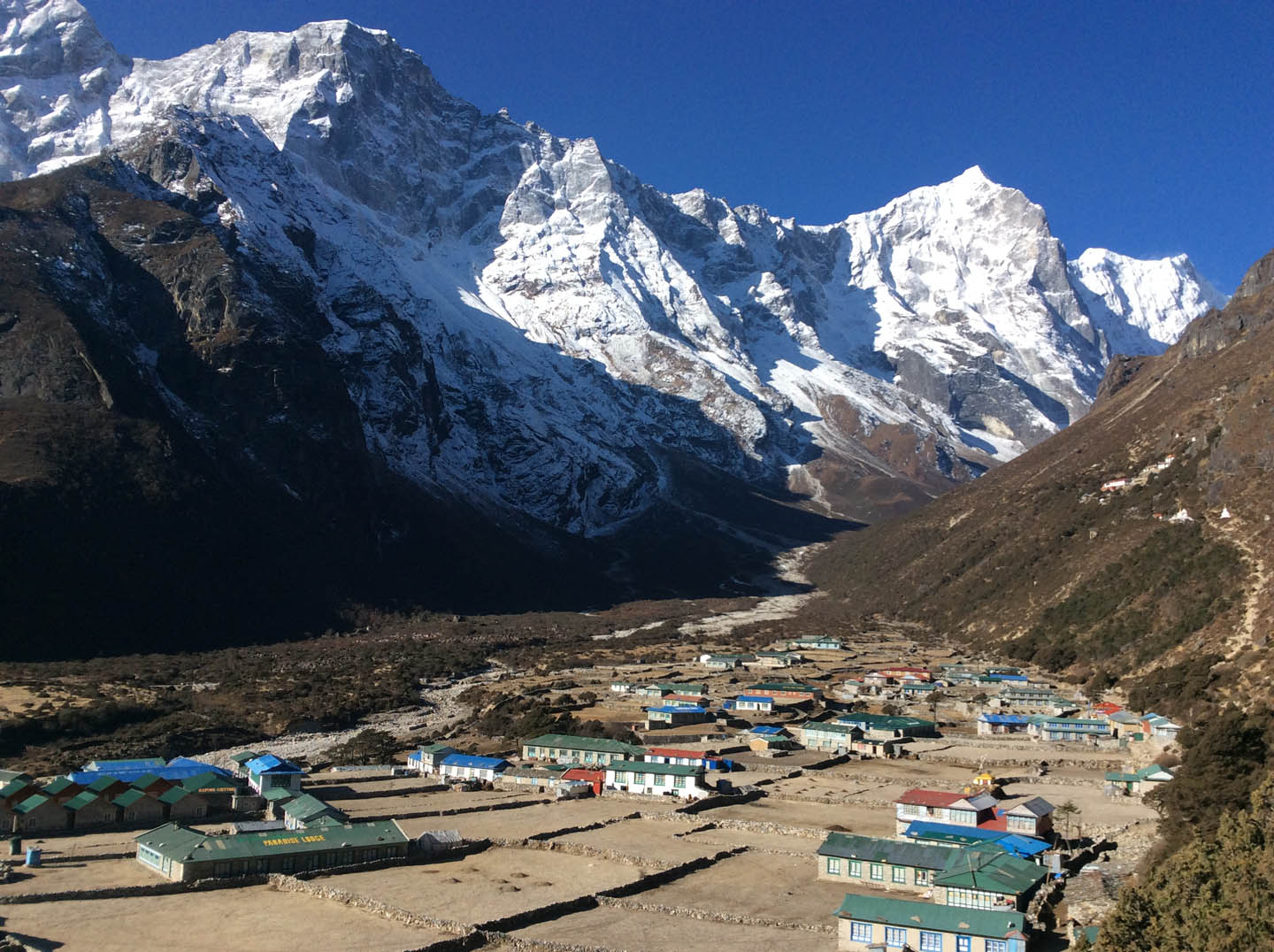
Day 17: Trek to Namche Bazar from Thame
Thame is a traditional Sherpa village that has escaped the crowds trekking to Everest and has one of the oldest monasteries in the region. The village is notably the hometown of Apa Sherpa who has made it to the summit of Everest 21 times!
The walk itself is peaceful with excellent views of the mountains as it winds in and out of the forest on the side of the canyon. This day, we continue our journey walking down the hill from Thame.
The trek will be easy and short and the final destination for the day and the trip will be at Namche Bazar.

Day 18: Trek to Lukla from Namche Bazaar
Finally we return back to Lukla where the trek began, which will seem like ages ago. It will give you time to reflect on the trek also giving you time to explore the town.
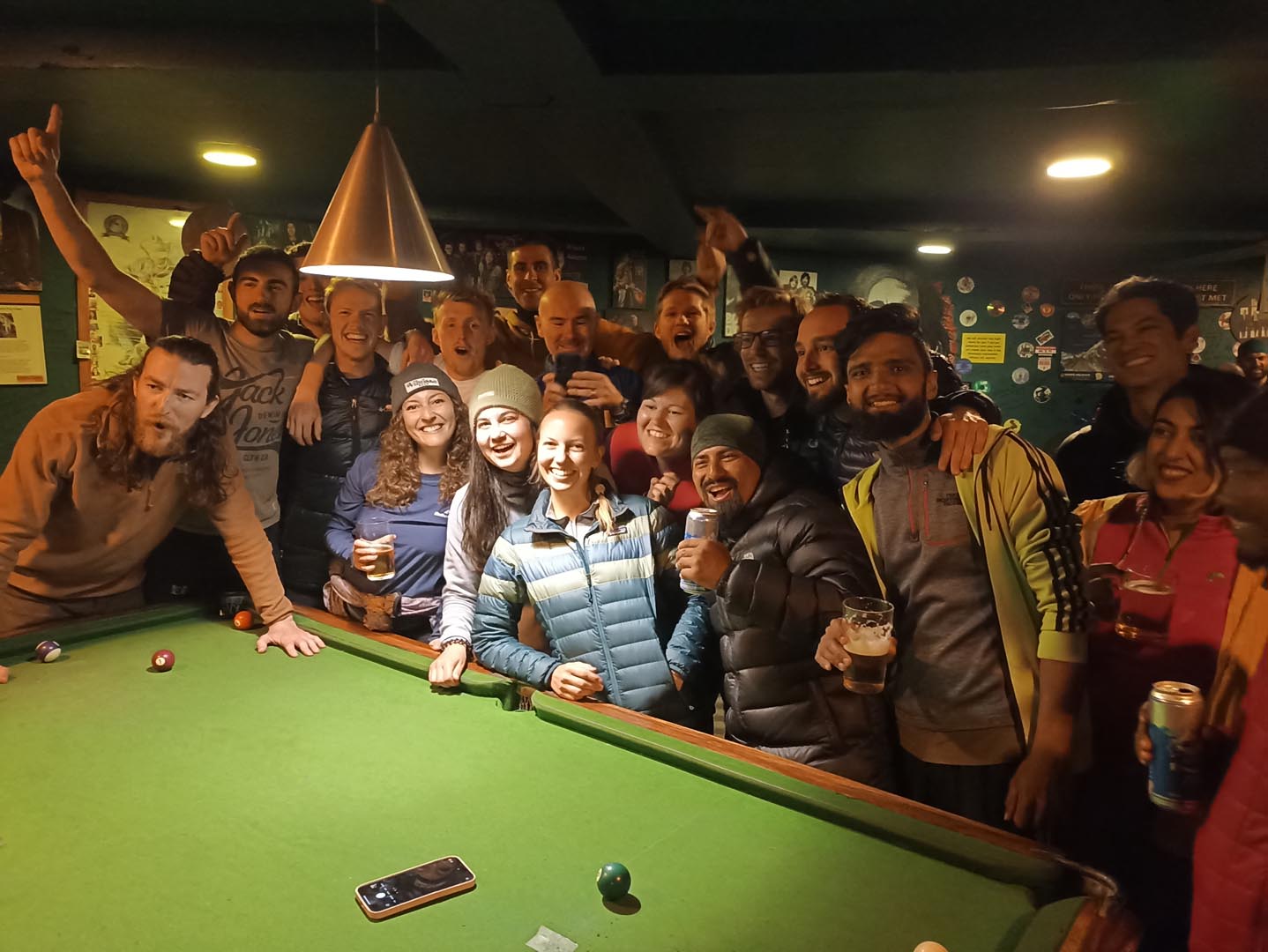
Day 19: Fly back to Kathmandu or Manthali from Lukla and same day drive to Kathmandu
Lukla to Manthali Flight (March, April, May, October, and November) The flight from Lukla to Manthali is a 20-minute flight. After that, it is about a 5 to 6 hour drive to Kathmandu. Please note that the driving hours may vary according to the highway traffic condition. You’ll be transferred to the hotel in Kathmandu on a shared tourist vehicle.
Lukla to Kathmandu Flight (January, February, June, July, August, September, and December) The flight from Lukla takes about 35 minutes. After arriving at the airport, you will be transferred to the hotel in Kathmandu via a shared tourist vehicle. Please be aware that the decision regarding the operation of flights solely depends on the airline and is influenced by the volume of travelers during a specific month.
You have the option to book a direct helicopter flight from Lukla to Kathmandu for an extra charge of USD 550 per person. This price is quoted on a 5-people sharing basis. This is the best alternative to avoid the long drive to from Manthali airport to Kathmandu during peak season (March, April, May, October and November).
You might want to stay a little more in Nepal. If you are looking for extending your trip, there are options such as a visit to Chitwan National Park, known for wildlife viewing, and to Pokhara, considered one of the most beautiful cities in Nepal. You can also extend your trip to Tibet, India, or Bhutan.
You will be served a farewell dinner in a fine restaurant.
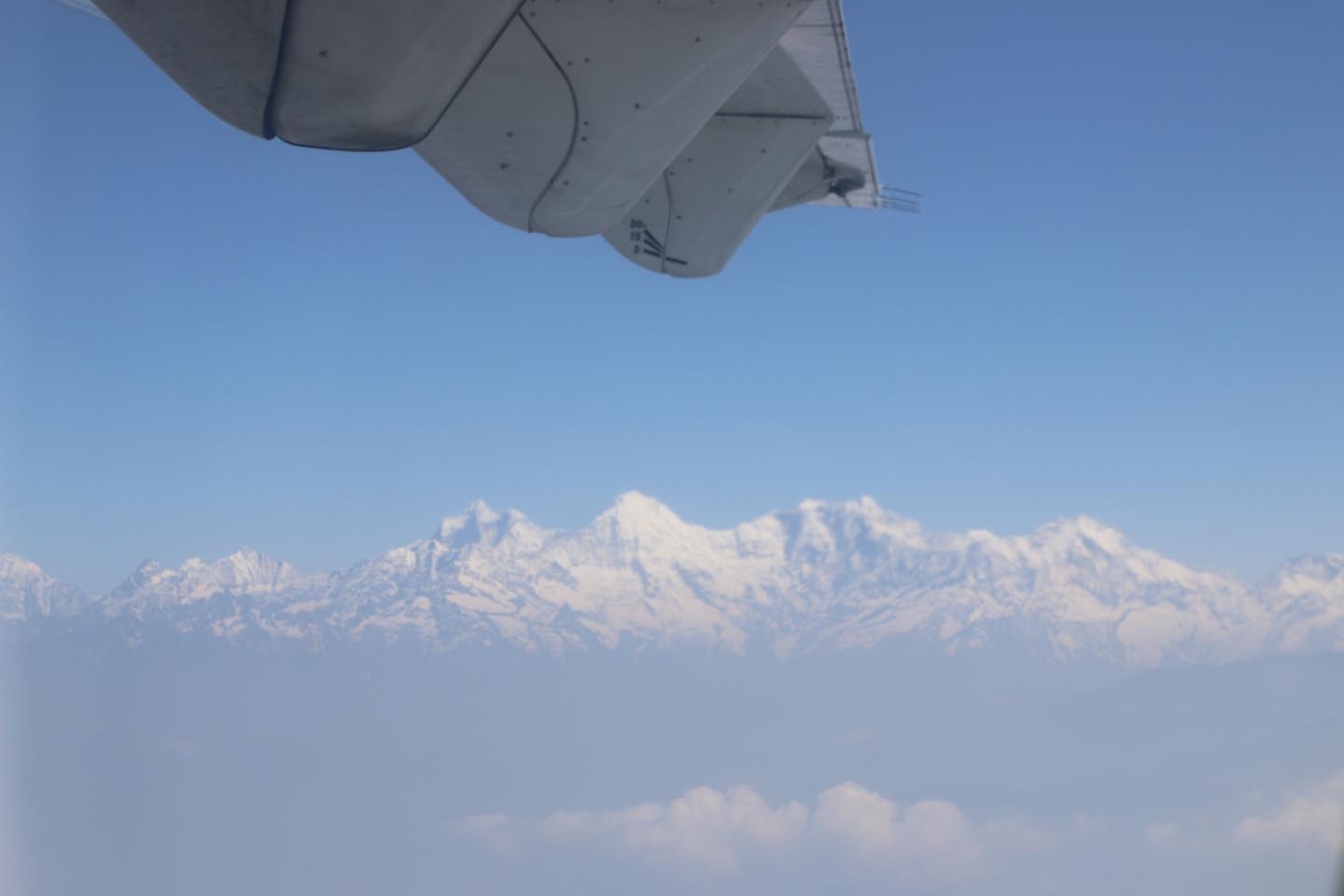
Day 20: Transfer to the International Airport for Your Final Departure
The trip concludes – our airport representative will drop you to Kathmandu’s Tribhuwan International Airport for your flight departure from Nepal.
Packing list for Everest three passes trekking
Here is a list of what you might want to pack for the hike. Please take this as a starting point. You’ll need layers of warmer clothing during the winter. We provide a 75 liter duffel bag for you to use for the trek.
It will be given to you during your pre-trip meeting in Kathmandu. The duffle bag is yours to keep. Also, you can rent sleeping bag and down jacket with us at the additional fee of USD 35 for each once you are in Kathmandu.
- Four-season (zero degree) sleeping bag (We have rental sleeping bags available for an additional USD 35)
- Puffy down jacket ( We have rental jackets available for an additional USD 35)
- Daypack (35-45 liters recommended) with rain cover
- Sleeping bag liner
- Sun hat or cap (We'll provide you with a free Ace the Himalaya baseball cap.)
- Knitted hat/Beanie
- Technical fabric base layer (light for warmer months, heavy for colder months)
- Technical fabric short (2) and long sleeve (2) shirts
- Waterproof, windproof shell
- Fleece jacket or pullover
- Hiking pants (2)
- Comfortable pants for inside the teahouses
- Hiking shorts
- Wool or technical fabric liner gloves
- Hard-shell outer gloves (insulated for colder months)
- Wool or technical fabric warm socks
- Hiking socks
- Liner socks (optional such as silk)
- Trekking/hiking boots (waterproof recommended)
- Ice Cleats /Micro Spikes (For trekking from November to March, it's recommended to include Ice Cleats/ Micro Spikes to prevent slipping on icy or wet surfaces.)
- Casual shoes
- Gaiters (lightweight for dust or heavy for snow in colder months)
Undergarments
Note: The quantity of each article of clothing can be adjusted to suit the preferences of each participant.
- Technical fabric/quick drying is best for underwear (opportunities to launder during the trip)
- Sports bras (women)
- Pajamas or sleeping clothes
First Aid Kits and Medications
- ( Note : Guides carry medications and first aid kits during the trip. However, personal kits and medications are highly recommended.)
Other Essentials
- Extra copies of passport-sized photos
- Reusable water bottle
- Toiletry kits
- Water purification tablets or UV water purifier (if you plan to treat water)
- Hydration bladder
- Toilet paper (2 rolls)
- High protein snacks (such as protein bars or nuts)
- Waterproof/dry bags for carrying important documents and money
- Airline tickets (Please leave a copy at our office in Kathmandu. This can be useful if there is a change in the date of the flight.)
Once in Nepal, if you have the time, you can purchase supplies and gear for hiking. Thamel, Kathmandu’s tourist hub, is home to many shops where you can get a variety of reasonably priced trekking equipment.
- Power bank or extra batteries
- Cameras and mobile phone
- Trekking poles
- Thermos for hot water
Important Information
- We give you a free duffel bag and baseball cap during your pre-trip meeting in Kathmandu. The duffel bag will be used to pack your trekking supplies.
- For every two participants, we assign one porter. The duffel bag, which should weigh around10 kg/22 lbs, will be carried by the porter throughout the walk.
- To carry your daily necessities like cash, crucial papers, a water bottle or bladder, a camera, toiletries, sunscreen, a notebook, clothing, etc., you must have your own daypack (with a waterproof cover).
- You can store your luggage (non- trekking items) at the hotel in Kathmandu.
- Total luggage allotment allowance for Kathmandu-Lukla flight is 15 Kg/33 lbs including both duffel (10 Kg/22 lbs.) and backpack (5Kg/11 lbs.)
- Down jacket with a hood is a must for altitudes above 4,000 m to keep warm. You can rent a down jacket for USD 35. Please note that in case of loss or damage, you need to reimburse the cost of USD 100 per item.
- You can rent a 4-season sleeping bag for USD 35. Please note that in case of loss or damage, you need to reimburse the cost of USD 100 per item.
Note: Some clothing, especially form-fitting, figure-hugging items made of elastic material (like yoga pants), may offend locals. Therefore, if you choose to wear these clothes for comfort, please make sure to wear something over them.
Everest High Passes Trek Map & Elevation
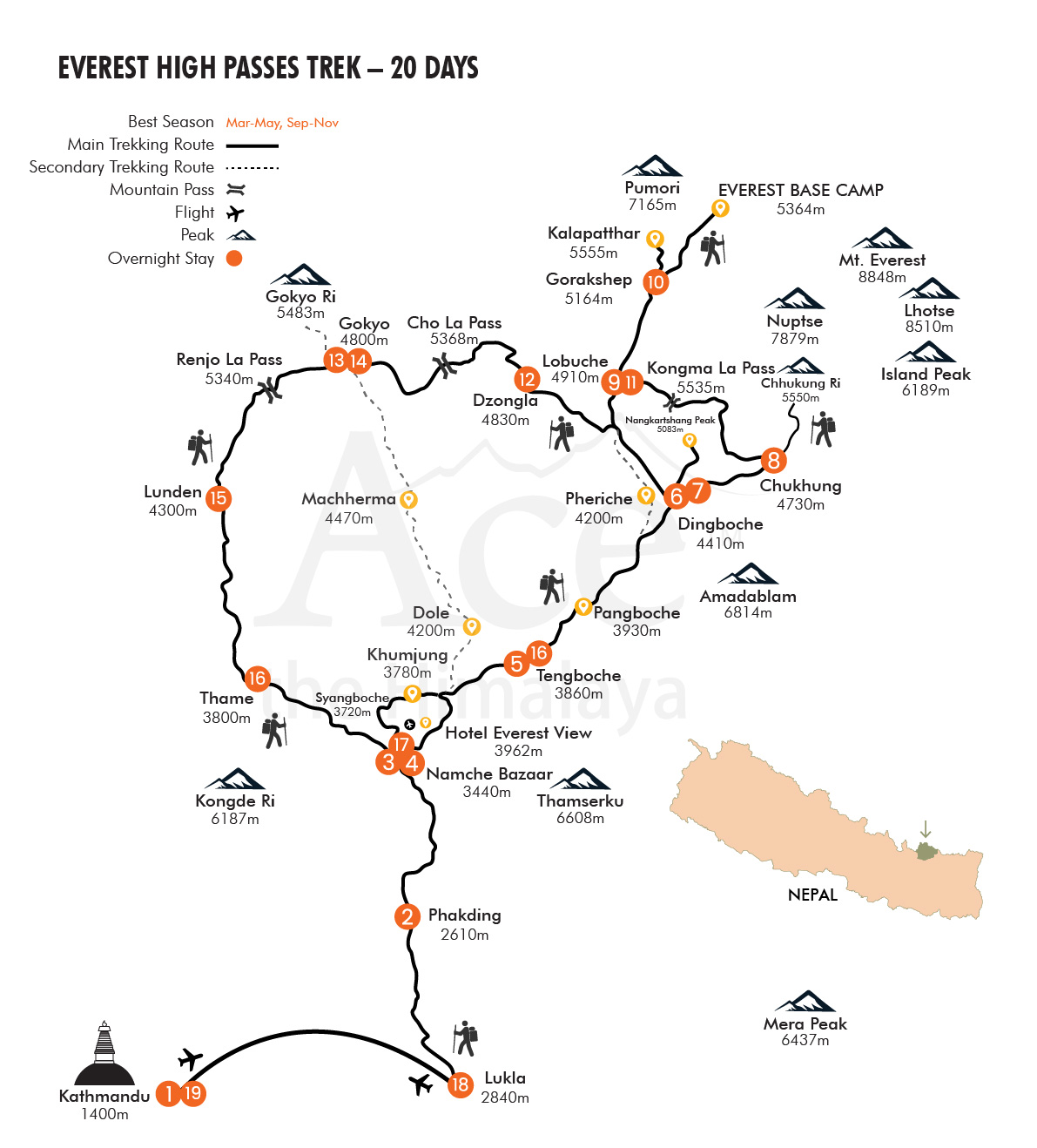
FAQs for Everest Three Passes Trek
Why trek with ace the himalaya.
Ace has a reputation for successfully leading treks with knowledgeable leaders and staff taking care of all your travel needs. We are a certified sustainable travel company that also endorses the idea of giving back to the community by participating in various philanthropic activities. Here are 17 reasons why you should choose Ace the Himalaya for your next adventure!
Is Nepal open to travelers following the Covid-19 pandemic?
Indeed, Nepal is entirely open. Travelers are welcome in Nepal without any restrictions. Arriving travelers can obtain a visa on arrival at the Kathmandu airport as well.
What are the conditions to travel to Nepal post Covid-19?
Traveling to Nepal is now hassle-free. You don’t need a vaccination certificate or negative PCR test, but check with your airlines and transit countries for any specific requirements.
We suggest you look at the Nepal immigration site https://www.immigration.gov.np for the most up-to-date information.
What additional documents do I need?
- Two passport-sized photos (2×2 inch) to give to our office staff
- A copy of your international flight ticket to give to our office staff
- A copy of travel insurance to give to our office staff
What should I know about booking my flights to/from Nepal? Do I need to plan extra days in case of delays?
The best course of action is to add a day or two before and after your intended trek days in case of flight delays or cancellations. It also gives you time to buy clothing equipment and gear required before your trip.
Please be aware that Ace the Himalaya is not responsible for any inconveniences or missed international flights resulting from unforeseen events like airport changes, flight delays or cancellations, etc.
Is hiring a guide necessary even if I have trekking experience?
You can hike in Everest Region without a guide. A guide is there to assist you in going forward and making alternative plans and arrangements when unanticipated occurrences happen or when things get difficult.
Our hiking leaders are qualified experts. When talking about their trip, our guests frequently remark on how much fun they had and how crucial their guide was to make it successful.
Can the guide speak English?
Our guides are fluent in English. All the guides that we assign speak and understand English. They’ll share with you the fascinating stories, traditions, and folklore of the mountains. The guides will also help you communicate with the locals since many shopkeepers and hosts of teahouses don’t speak English.
Weather and Temperature
What is the best season for this trek.
The best seasons to hike Everest high passes trek are autumn (Mid-September to November) and spring (March to early June). This trek is possible year-round, and we can organize it when it suits your schedule.
However, we generally suggest doing this trek in the favorable seasons and keep away from rainstorm season (July and August). In cold months of January and February, the temperature can be a little harsh in the mountains.
However, some prefer to travel during these months as it is less crowded given that you are well prepared with appropriate winter wear and other gears.
What kind of weather and temperature can I expect while trekking?
Due to its tendency to be localized, the weather in the Everest region is challenging to forecast. You could see rain, fog, cold, or hot and sunny weather while trekking. It is best to be equipped to handle various weather situations. In the Everest region, nighttime temperatures are significantly lower than midday temperatures. In less than a day, the temperature can change from a high of 25°C (77°F) to a low of – 20°C (-4°F). The weather and temperature ranges are typically predictable based on the month and season, even though it might be challenging to predict what each day in the mountains will bring.
Spring – March/April/May/June
Despite being the busiest season, spring is perhaps the best time to visit the Everest region. Activities assisting the expedition teams take place in Everest Base Camp. The many varieties of blossoming trees should be visible, and the sky should be clear with stunning vistas. During springtime, the average temperature is 20°C (68°F), with a high of 25°C (77°F) during clear days and a low of – 15°C (5°F) overnight above 4000 meters.
Monsoon season – July/August through Mid-September
Since it rains heavily at elevations below 3500 meters, this season isn’t exactly ideal for travel in the Everest region. While it can occasionally be dry in areas above 4000 meters, it frequently rains so therefore not many people travel during this season. Trekking during the monsoon season has some advantages, such as a greater possibility of seeing waterfalls and the best opportunity to escape crowds. During the monsoon, the average temperature is 22°C (71.6°F), with a high of 30°C (86°F) during clear days and a low of- 5°C (23°F) overnight above 4000 meters.
Autumn – End of September/October/November
In the Everest region, autumn is equally as busy as spring. It is one of the best times to go, too. While the plants and trees are not in bloom, the sky is often clear, offering breathtaking vistas from almost every viewpoint. The average temperature in autumn is 17°C (62.6°F), with a high of 20°C (68°F) during clear days and a low of – 15°C (5°F) overnight above 4000 meters.
Winter – December/January/February
Due to fewer tourists, some people like winter travel. Even while the views are still beautiful, it can be cloudy, thus adding extra days is highly advised during this time. The average temperature is 10°C (50°F), with a high of 17°C (62.6°F) during clear days and a low of – 20°C (- 4°F) overnight above 4000 meters. The teahouses provide extra blankets for warmth at night.
What is the temperature rating of the sleeping bag that you lend to trekkers?
The temperature rating of the sleeping bags that we rent to trekkers is about -10°C (14°F). Also, our guides can obtain extra blankets if needed at the teahouses.
Arrival and Visas
Is it possible to obtain a visa for nepal upon arrival at the airport.
Yes, you can obtain a Nepal visa upon your arrival at the airport. There are kiosks in the arrival hall that you use to complete the necessary forms. The cost is USD 30 for a 15-day tourist visa, including numerous entries, or USD 50 and USD 125 for a 30-day or 90-day tourist visa including numerous entries respectively. You should carry cash (USD) with you to pay your visa fees quickly and easily, as digital payments are frequently unavailable.
Who will come to pick me up at the airport upon my arrival?
Our staff will be waiting for you outside the airport terminal with our signboard (Ace the Himalaya). You will be accompanied to a hotel in a private tourist vehicle.
Everest three passes trek cost
How much additional money do i need per day.
Typically, USD 15 to 20 per person per day will be sufficient. This is to purchase water, tea/espresso, snacks, and hot showers in the mountains and for lunch or dinner in Kathmandu. Additionally, if you want to buy souvenirs or native Nepali goods, you can bring extra cash with you.
Is it possible to use credit cards in the places I visit during the trek?
Nepalese Rupees cash is preferred to a credit card while trekking in the mountain region. Exchanging your cash into Nepali Rupees in Kathmandu before the beginning of the trek is ideal. This can be accomplished at the airport, at banks, or at your hotel. Please note the hotels will exchange up to about USD 100 for each transaction only. There are ATMs up to Namche Bazaar but can be unreliable. The currency exchange rate is better in Kathmandu.
Is it possible to reserve a trip now and pay a deposit later, or do I have to pay a deposit at booking/reservation?
When you book, you must pay a 30% deposit to secure your itinerary. The remaining balance can be paid upon your arrival at Kathmandu or before arrival. US Dollars cash and credit cards (Visa, Master, and American Express) are accepted once in Nepal. Please note a 4% transaction fee will be added for all credit card transactions.
How do I pay the remainder of my balance upon arrival in Kathmandu? US Dollars cash or credit card?
You can make payments via US Dollars cash or credit card (Visa, Master, and American Express). A 4% transaction fee is added if paying with a credit card. Thus, we encourage you to pay with USD cash if you are planning to pay upon your arrival in Kathmandu.
We prefer you pay with larger bills (USD 50 or 100). Please note that the cash should not be older than 2009 and in good condition, as banks do not accept worn, torn, or crumpled bills.
How are the ATM and money exchange facilities in Kathmandu?
There are ATM and money exchange facilities almost every few meters in Thamel, where you will be staying in Kathmandu. So, you can easily use your cards to cash out limited sum of money to which a minimum charge is deducted by the ATM facility itself. You can easily exchange your foreign currencies in currency exchange centers for an exact rate.
Who Can Trek?
Do i need prior trekking experience.
Previous trekking experience is not required if you are physically healthy and have enough enthusiasm for the trek.
Are there any age requirements for mountain trekking?
Our treks have no age restrictions if members are healthy and willing. We have had families with kids as young as 5 years do the treks along this region, and our oldest adventurers have been in their late 70s.
Is trekking to mountain regions safe for solo female travelers?
It is safe for a female to trek alone in Nepal. Nepal is usually regarded as a safe nation for female visitors traveling alone. It is entirely safe for a solo woman to trek with Ace the Himalaya on any of our treks.
Physical Fitness
How challenging is the trek.
The Everest high passes trek is somewhat challenging due to the higher elevation and long duration of the trek . It is a very strenuous journey that comprises walking 5 to 8 hours a day.
How quickly do you walk on the trail?
The average walking speed for a reasonably fit person is 4 kilometers per hour. At higher elevations, it is highly recommended that you walk slowly to help with acclimatization.
What kind of physical training is necessary for trek preparation?
For trekking, you must prepare your body to walk over uneven, hilly landscapes while carrying a backpack. Walking at an incline, jogging, cycling, and going for long-distance hikes are all good ways to exercise. You should work out for at least one hour four to five times a week for at least two months before trekking.
What are the physical standards that I need for the trek?
Participants in good physical condition should be able to complete this trek. If you are not physically active, we advise starting an exercise regimen two months before the trek that includes at least an hour of walking at an incline, running, or biking four to five times a week.
Incorporating hiking into your workouts is ideal. It is advised to speak with a doctor before making travel arrangements if you have any health conditions that could affect your ability to complete the trek.
Trek Preparation and Packing
What is the weight limit for the lukla flight.
The weight limit for the Lukla flight is 15 kg (33 pounds), including your duffel bag and daypack. If your daypack weighs more than the allowed weight, you can pay an extra USD 2 to USD 5 per kilogram. Despite the extra pay, the baggage allowance is occasionally withheld. Therefore, we recommend you pack within the 15 kg weight limit.
What are the procedures after I make my deposit?
After making the deposit, one of our staff will email you for further information. We will require a copy of your passport photo page and your arrival/departure flight details. We will also provide you with additional trip information.
What sort of insurance do I need? How can I obtain a policy?
Travel insurance is mandatory for our hiking itineraries. We require your policy have medical evacuation coverage for the maximum elevation of your itinerary. Insurance may also cover additional costs in the event of a flight delay or cancellation caused by bad weather, medical costs, theft, loss, and damage to your items while traveling.
Travel insurance can be obtained online by one of several travel insurance companies. Please note that insurance obtained from an airline at the time of booking your flight may not cover medical evacuation coverage.
What are the necessary items that I should pack for my trip?
You can find the necessary items to pack for the trek on the Equipment Section of this trek. Gear and equipment can be bought or rented upon your arrival in Kathmandu. If you plan on buying or renting gear in Kathmandu, please allow extra time.
Do you provide sleeping bags or down jackets for rent?
Yes, we do provide sleeping bags or down jackets for rental costs of USD 35 each. Do let us know before initiating the trek and we shall provide items.
What type of bag will the porters carry?
We provide you with a free duffel bag of 70 to 80-liter capacity that our porters will carry. The maximum weight that porters can safely carry is 30kg, and each porter is assigned to two people.
What type of daypack should I bring?
We suggest a 30 to 40-liter capacity daypack. Wider straps and hip belts are recommended to assist you in carrying weight evenly and reduce pain.
What about my passport, medications, and belongings?
Bring copies of your passport, insurance papers, and other essential items in your carry-on during your flight. If you need to take medications daily, keep them in your daypack with your other essential possessions. You can store other non-trekking essentials in the office of Ace the Himalaya or at the hotel in Kathmandu.
Accommodation
What kind of lodging is available on this trip.
In Kathmandu, we use three-star hotels including breakfast. We use Hotel Thamel House, Gaju Suite Hotel, Hotel Jampa, or comparable-class lodging in Kathmandu. Teahouses with clean rooms are used during the trek. For further information see Teahouses in the Everest region trek
Is it possible to have private rooms while trekking in the Everest region or while in Kathmandu?
A private room in the teahouses and in Kathmandu can be guaranteed for an additional cost.
Do the rooms at the teahouse have a private attached toilet or do we have to use a common toilet?
Yes, we provide you with attached toilets in the teahouse in some places like Lukla, Phakding, and Namche only. You will have a shared toilet available in the teahouse for the rest of the places.
What happens if I end up staying an extra night/s in Kathmandu due to an unforeseen delay or cancelation?
In case of unforeseen circumstances such as flight cancellation, your health, or for any reason you decide to discontinue the trip and arrive early in Kathmandu then you will need extra accommodations in Kathmandu.
The cost of the teahouses in the mountains is not equivalent to the cost of a hotel in Kathmandu. In such cases, we will arrange your accommodations, but you will need to pay a supplemental charge.
Is it necessary to bring toilet paper for the trek?
You can buy toilet paper in the guesthouses during the trek, but it can be expensive, so we suggest you bring some with you. You also need to bring personal items such as towels, soap, hand sanitizers, and so on.
Are there restrooms along the trail?
There are toilet facilities in the teahouses/lodges during the trek. Trekkers can also find private areas along the trail for emergencies.
What sort of food can I expect in trekking?
Multiple food choices are available in the guesthouses. Options include daal bhat (rice and lentil), bread, eggs, potatoes, noodles, soup, pasta, and pastries. We suggest eating vegetarian during the trip.
You will find a great deal of garlic on the menu since it helps with acclimatization. Each meal includes one hot drink. Hot drinks include coffee, hot chocolate, tea, and hot lemon drinks. You can purchase an additional hot drink or sometimes soda at your own expense. You can also purchase candy or cookies (crisps) at your own expense.
Is the food in the mountains prepared to international standards in terms of safety?
Indeed, the guesthouses follow international guidelines while setting up the food and serve you clean, protected, and warm meals .
I'm a vegetarian. Is that a problem?
Most of the teahouses in the mountains offer vegetarian meals. So, being a vegetarian is not a problem. Vegetarian meals are preferable to avoid food poisoning and indigestion.
Is the water okay to drink? Do I need to bring purifying tablets or filters?
Natural spring water or tap water can be found along the trek and in guesthouses but must be treated. We use Katadyn filters to purify the natural water sources to make them safe to drink. This way, it is sustainable and pocket friendly as you need not buy bottled mineral water. You must carry a water bottle that can hold both hot and cold water and a hydration pack.
If the temperature drops too low for the Katadyn filter to function properly or if any technical issues occur, it is recommended to buy boiled water from the teahouse to ensure safe drinking water as an alternative.
Can we get hot or boiled drinking water? Does it cost extra?
Yes, teahouses do provide hot boiled water for an extra charge of USD 2 to 5 per liter. The cost varies and increases at higher altitudes.
Can I shower/bathe during the trek?
Yes, hot showers are available from Lukla upto Namche Bazaar for an additional cost. Some villages at higher elevation too might have shower availability. However, you can purchase a pail of warm water at higher elevations to bathe with.
It is not recommended to take showers above the village of Dingboche to avoid sickness. Depending on the location, it will cost an additional USD 5 to USD 8 for each shower during the trip.
Are there any laundry services available on Everest Region?
Some teahouses provide laundry services in the Everest region for an extra charge. However, it’s not guaranteed that your clothes will dry on the same day.
There is a possibility that you can wash your clothes yourself during acclimatization days in Namche and Dingboche. However, we recommend you pack enough clothes for your trek and do not rely on laundry services.
Can I charge my electronic equipment during the trek?
Yes, you can charge your equipment during the trek for an additional cost. The cost will vary but is around USD 1-5 per charge. Two pins (type C) and three pins (type D) adaptors are highly recommended. Bring these adaptors or purchase them while you are in Kathmandu.
Health and Safety
Do your guides have the trekking guide certificates from the hotel management and tourism center have they received first aid training for high altitudes.
We provide licensed trekking guides with fluent English. Our guides are certified by the Hotel Management and Tourism Center after receiving 45 days of training. Similarly, the guides receive high-altitude training from Kathmandu Environmental Education Project (KEEP).
What are safety measures in place? What safety equipment do your guides carry on the trek to deal with sickness/accidents?
Our guides are well trained and certified in first aid. Throughout the journey, our guides will evaluate your condition and your oxygen level using an oximeter. Our head office receives continuous updates on your condition and location through the guides. In places without a phone signal, your situation will be updated through a satellite phone during emergencies.
How do you allocate guides and porters in a group?
We allocate one guide for groups of up to 8 participants. For groups of over 8 participants, we allot an associate guide. As per the size of the group, we may add more guides or divide them into sub-groups.
We provide one porter for every two clients. Two clients’ duffel bags will be carried by one porter. The weight limit is 30kg or 15kg for each client. For an additional cost, we can arrange for one porter to carry one participant’s duffel.
Is Ace the Himalaya's staff insured?
Our company insures all our trekking staff members, including guides, cooks, Sherpa, and porters. Please browse through our legal docment page to view insurance details.
What vaccinations will I need?
- Typhoid vaccination is recommended but not required
We suggest you have a dental checkup before your trip and know your blood type. It is helpful if you inform us of any medical condition that is relevant so we may convey this information in the event of an emergency. Ace the Himalaya keeps your medical condition confidential unless treatment is necessary.
What if I am very sick in the mountain?
Our guides are 24 hours available for the services during the trek. They are trained to use first aid kit and have knowledge to use Oxy meter. They are very much aware that higher the altitude the oxygen level gets lesser so to get updated on the oxygen level of our client and to know whether they are fit enough or needs extra precautions to continue.
Guides carry local sim cards both Nepal Telecom and Ncell in order to update whereabouts and situation of our every client. During the time of emergency our guides are alert and keeps updated to head office in Kathmandu that is available 24 /7 to arranging from horse to mules or helicopters in the must needed cases especially when client is seriously sick in the mountain and needed to be hospitalized.
Do you guys have a PAC (Portable Altitude Chamber)?
Yes, we have access to a portable altitude chamber in case of an emergency. It is not essential to carry during the trek. Though, we can use arrange it upon request for an extra cost of USD 200.
Do you provide oxygen supply if needed?
Yes. Guesthouses at higher elevations such as Lobuche and Gorak Shep offer oxygen at an extra cost if needed. The cost of oxygen can be high so we recommend having travel insurance so they can reimburse you.
We can also provide pre-booked oxygen for an extra cost of USD 150 for 1 tank that can be carried along with you during the trek starting from Namche to higher elevations.
How are acclimatization and altitude related?
Altitude sickness is a possibility during the Everest Region. Air at higher elevations has less oxygen available. To avoid altitude sickness, acclimatization days and slow climbs are recommended at higher elevations.
Along the trek, you’ll be assisted by our professional guides in recognizing and preventing altitude sickness.
What kind of trekking boot would be best for the trek?
An important piece of equipment is your trekking boots. Invest in a durable and comfortable pair, preferably with water-proof lining. Boots that provide ankle support on rough ground and have stiff soles are recommended.
What is necessary for sun protection during the trek?
Even when the sun isn’t shining, sun protection is essential. UV rays are reflected by the snow and the harshness of the sun will damage your skin before you notice it at high elevations. Therefore, proper clothing and sunblock are necessary. Hat, sunscreen, sunglasses, clothes, etc. are vital for sun protection.
Practical Matters
What is your cancellation policy.
Notice should be provided 20 days before the trip start date in case of cancellation. The trip can be canceled for justifiable reasons. Once the trip is canceled, a fee of 30% of the trip cost is retained for administrative costs.
However, the trip amount is entirely non-refundable if the cancellation is not made before the 20 days as per our terms and conditions. For submitting a claim to your insurance company after the cancellation, we can assist with documentation such as a receipt of monies paid. Refund will not be provided for unused accommodation in case of trip cancellation caused by personal reasons/sickness/weather.
More information about our cancellation policy can be found here in Terms and Conditions page.
Do I need to tip my guide and porter? How much would that be?
Tipping is expected and appreciated. You can tip your trekking guides and porters based on your satisfaction and enjoyment. We suggest you spend at least 10% of your total trek cost for tipping staff. You’ll learn more about how much to tip your group’s guides and porters during our pre-trip briefing in Kathmandu.
Is there any communication while we are trekking?
Yes. The guides carry local cell phones, so you can use their cell phones if necessary and reimburse them. Assuming you have brought your cell phone, you can obtain a local SIM card and use it. Our guides or representatives can help you get a local SIM card after your arrival. There is the availability of Wi-Fi at most teahouses for an additional cost. We utilize satellite telephones for emergencies.
What is the Internet availability in the Everest region?
For internet usage, the Everest region has a network “Everest Link” which can be bought for around NPR 600-800(USD 5-7) for 6GB that can be used at one destination, or you can pay NPR 2500(USD 21) for 10GB data that can be used in the regions that have access to Everest link.
The purchase is valid for one device only. Some teahouses will have internet access and offer Wi-Fi hotspots for a charge. These are usually unreliable and not all teahouses will have connections, so it is recommended you purchase Everest Link or a 3G/4G SIM card to use for the duration of your trek.
Does it cost an extra amount if I am a solo traveler?
If you are a solo traveler and book one of our published dates, there is no additional fee. If you sign up for a private trip or change the trip date from one of our published trip dates, you will be charged an additional fee.
Is there a provision for a refund policy if I don't accomplish the trek?
Trekkers occasionally fail to complete the journey for medical or personal reasons. In this situation, be aware that we do not issue any refunds for products purchased or unused trek days. We must pay our administration staffs, guides, and porters, purchase trekking permits, and all other booked accommodations in advance, so our expenses remain the same.
Who else will be joining my trekking group?
If there are any, you will be allocated to a trekking group. The details of the personal data of your group members cannot be disclosed. However, feel free to contact us if you have queries about other trekkers in the group and we shall give you a general idea of the ages, nationality, and sex of your group members. Chances are you will be trekking with others unless you have booked a private trip.
Can I add extra days to my trekking trip?
You can extend your trekking trip for an additional cost. Potential arrangements will be made if we get a request from your guide. This is applicable for private or solo trips as the itinerary can be easily adjusted. The addition of extra days is bound by time when you are in a group. Therefore, discuss with your group and guide, what changes can possibly be made.
I want to extend my holiday, any recommendations?
Yes, you can extend your holiday. Ace the Himalaya offers many options and alternatives for your holiday extension. For more information, you can visit our Day trips pages.
Transportation and Flights
Do i need to book my international flights for the travel to nepal.
Yes, you must book your international flights. We are a local agency and do not make international flight arrangements. You can easily browse through flight tickets in airlines sites to book ones most feasible for you.
What form of transportation do you utilize?
We utilize private tourist vehicles for touring, city visits, and airport pickups. Based on the group size, we use cars, minibuses, or vans. We use 4WD when necessary.
Can we fly by plane to Lukla directly from the Kathmandu airport?
The flight to Lukla depends on the trekking season. During peak trekking seasons (March, April, May, October and November), the traffic in Kathmandu airport is congested so, the flight to Lukla may be from Manthali airport in the Ramechhap district. However, during the off-season, you can take a flight to Lukla directly from Kathmandu airport.
How can I reach Manthali Airport, Ramechhap? Do the airlines provide shuttle services to get to Manthali from Kathmandu?
You can reach Manthali airport by traveling in a vehicle. The journey is about 4 to 5 hours (depending upon traffic) by road.
Usually, the airline companies provide shuttle services at 3 am to get to Manthali airport, Ramechhap from Kathmandu (depending upon flight time). If airlines’ shuttle services are not available, Ace the Himalaya will arrange for a vehicle to Manthali airport.
To catch your Lukla flights, you will travel to Manthali early in the morning around 2 to 3 am from Kathmandu. If your departure time is early in the morning, you must arrive in Manthali the day before and spend the night there. More information will be shared 2 to 3 weeks before you arrive in Kathmandu.
The return journey from Manthali to Kathmandu will remain like your outward journey.
What sort of bus services can I expect to reach Manthali Airport from Kathmandu?
Generally, vehicles such as Toyota HiAce, Mahindra Scorpio, etc. are used for shuttle services between Kathmandu and Manthali. Even though the roads leading to Manthali are bumpy, sloping, and winding, the transportation options offered will be comfortable during the trip.
Is there a possibility of flying to Kathmandu from Lukla by plane directly after the trek?
The flight to Kathmandu from Lukla depends on the trekking season. Direct flight may not be possible during peak trekking season (March, April, May, October, and November) due to heavy air traffic in Kathmandu. Therefore, the flight arrives at the Manthali airport, Ramechhap.
What are the main reasons for Lukla flight delay or cancellation?
Bad weather conditions are the major reason for Lukla flight delay and cancellation. Other reasons can include congested air traffic at the Kathmandu Airport, staffing shortages, and other difficulties cause flight delays/cancellations.
Is there any alternative option if my flight to and from Lukla is canceled or delayed?
For an additional cost, a helicopter flight is an option in the event of delay or cancellation. This assists with getting you to your planned international flight.
Is it possible to book a helicopter flight instead of regular flight between Lukla and Kathmandu?
Yes, you have the option to book a seat on a helicopter between Kathmandu and Lukla for an extra charge of USD 550 per person for a one-way flight. This price is quoted on a 5-people sharing basis.
How much should I pay for a private Helicopter charter?
A private helicopter can be reserved for an additional cost of USD 3,500 for one way in addition to the flight cost between Kathmandu and Lukla. Similarly, a helicopter charter from Manthali to Lukla costs an extra USD 2,500 for a one-way flight. The seat limit is five. Meaning you will be sharing the cost with your fellow passengers. Sometimes, if you are lucky, the cost can get cheaper if there are passengers from Ace the Himalaya sharing the cost for both ways. We can give more information at the time of booking.
What is the weight limit in a helicopter?
Assuming the five-passenger weight limit of 80kg and a baggage limit of 15kg each, with a captain on board, the helicopter carries 475 to 575 kg on a single helicopter flight.
Traveler Reviews
These full and frank reviews are from travelers who have traveled with Ace the Himalaya previously. The reviews and experiences shown here are from reputable travel websites like TripAdvisor, Google, Facebook, and Trust Pilot, etc.
Google Reviews

What makes this trip different ?
Our csr with sambhav nepal.
- Ace the Himalaya believes in giving back to the communities that surround and support tourism in Nepal. Ace provides logistical support and, if needed, cash donations to the projects of Sambhav Nepal (a local NGO).
- Sambhav Nepal and Ace work together to plan volunteer programs that will bring in foreign volunteers and make use of their enthusiasm, time, and talents in a variety of projects.
Sustainability and Responsible Tourism
- Of the few Travelife Partners in Nepal, Ace the Himalaya is one. We respect the procedures for sustainable tourism. Our excursions are socially and environmentally conscious, leaving the lowest possible impact in the Himalayas.
- About 80% of Ace the Himalaya’s staff members are natives of the regions where our trips are organized. It is one of our sustainable and responsible efforts to help local communities, support small businesses, and promote regional culture and way of life.
Other Treks like Everest High Passes
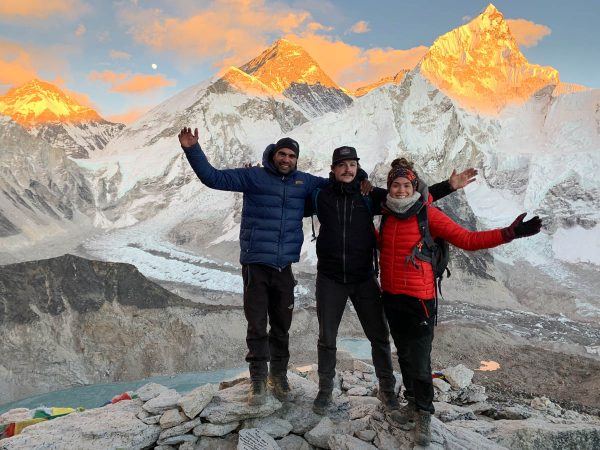
Everest Base Camp Trek
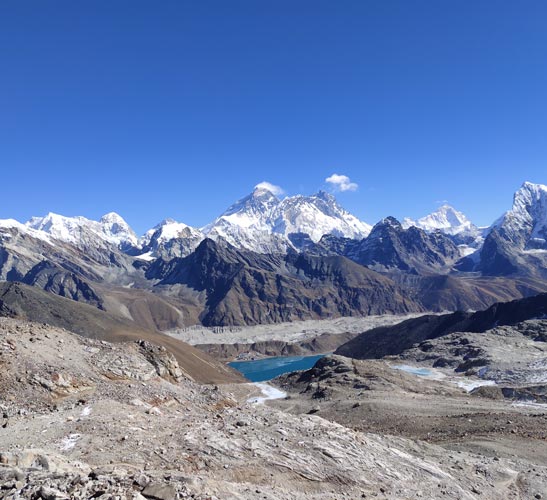
Gokyo and Renjo La Pass Trek
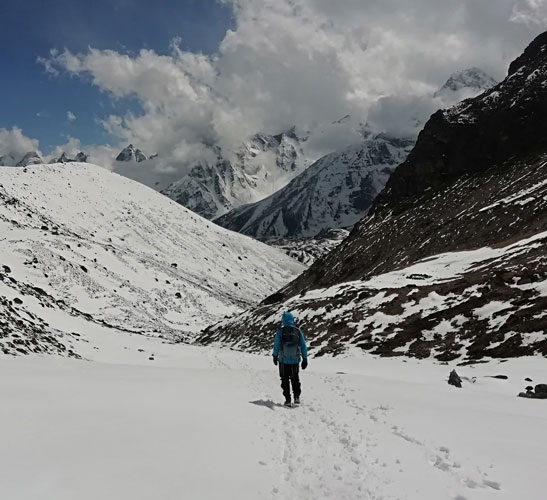
Everest High Passes and Island Peak
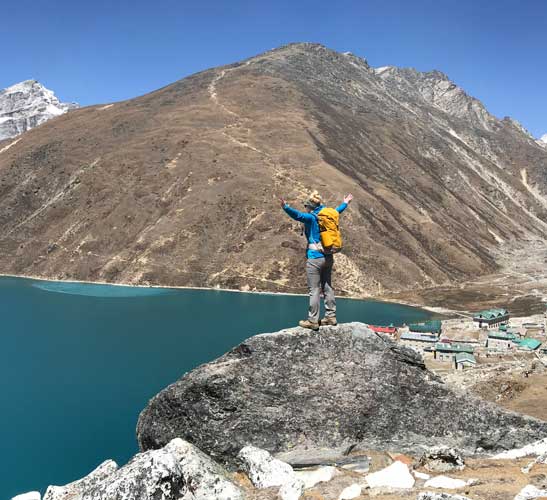
Gokyo to Everest Base Camp Trek
Speak to an expert.
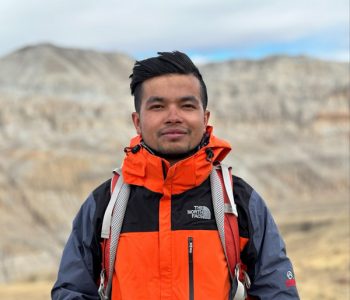
- Availability
Make An Inquiry for
- Full Name *
- Nationality * Nationality Afghanistan Albania Algeria American Samoa Andorra Angola Antigua and Barbuda Argentina Armenia Australia Austria Azerbaijan Bahamas Bahrain Bangladesh Barbados Belarus Belgium Belize Benin Bermuda Bhutan Bolivia Bosnia and Herzegovina Botswana Brazil Brunei Bulgaria Burkina Faso Burundi Cambodia Cameroon Canada Cape Verde Cayman Islands Central African Republic Chad Chile China Colombia Comoros Congo, Democratic Republic of the Congo, Republic of the Costa Rica Côte d'Ivoire Croatia Cuba Cyprus Czech Republic Denmark Djibouti Dominica Dominican Republic East Timor Ecuador Egypt El Salvador Equatorial Guinea Eritrea Estonia Ethiopia Faroe Islands Fiji Finland France French Polynesia Gabon Gambia Georgia Germany Ghana Greece Greenland Grenada Guam Guatemala Guinea Guinea-Bissau Guyana Haiti Honduras Hong Kong Hungary Iceland India Indonesia Iran Iraq Ireland Israel Italy Jamaica Japan Jordan Kazakhstan Kenya Kiribati North Korea South Korea Kosovo Kuwait Kyrgyzstan Laos Latvia Lebanon Lesotho Liberia Libya Liechtenstein Lithuania Luxembourg Macedonia Madagascar Malawi Malaysia Maldives Mali Malta Marshall Islands Mauritania Mauritius Mexico Micronesia Moldova Monaco Mongolia Montenegro Morocco Mozambique Myanmar Namibia Nauru Nepal Netherlands New Zealand Nicaragua Niger Nigeria Northern Mariana Islands Norway Oman Pakistan Palau Palestine, State of Panama Papua New Guinea Paraguay Peru Philippines Poland Portugal Puerto Rico Qatar Romania Russia Rwanda Saint Kitts and Nevis Saint Lucia Saint Vincent and the Grenadines Samoa San Marino Sao Tome and Principe Saudi Arabia Senegal Serbia Seychelles Sierra Leone Singapore Sint Maarten Slovakia Slovenia Solomon Islands Somalia South Africa Spain Sri Lanka Sudan Sudan, South Suriname Swaziland Sweden Switzerland Syria Taiwan Tajikistan Tanzania Thailand Togo Tonga Trinidad and Tobago Tunisia Turkey Turkmenistan Tuvalu Uganda Ukraine United Arab Emirates United Kingdom United States Uruguay Uzbekistan Vanuatu Vatican City Venezuela Vietnam Virgin Islands, British Virgin Islands, U.S. Yemen Zambia Zimbabwe
- Phone Number *
- Email Address *
- Prove your humanity : 10 minus five =

- Name This field is for validation purposes and should be left unchanged.
Trekking in Nepal
Climbing and expedition, cultural tour and sightseeing, cycling and mountain biking, luxury treks, luxury tours, multi country tours, voluntourism trips, extend your trip.
- Everest Panorama Trek – 9 Days
- EBC Trek with Helicopter Return – 12 Days
- Everest Base Camp Trek – 14 Days
- Gokyo Lake Trek – 13 Days
- Gokyo and Renjo La Pass Trek – 14 Days
- Everest Base Camp Trek without Lukla Flight – 17 Days
- Gokyo to Everest Base Camp Trek – 17 Days
- Everest Base Camp with Island Peak – 19 Days
- Everest Three Passes Trek – 20 Days
- Everest High Passes and Island Peak – 23 Days
- Classical Everest Base Camp Trek – 21 Days
- Langtang Valley Trek – 10 Days
- Langtang Valley Ganja La Pass Trek – 14 Days
- Langtang Helambu Trek – 17 Days
- Ghorepani Poon Hill Trek – 9 Days
- Mardi Himal Trek – 10 Days
- Annapurna Base Camp Trek – 13 Days
- Himalayan Highlights – 13 Days
- Nar Phu Valley Trek with Annapurna Circuit – 18 Days
- Annapurna Circuit Trek – 19 Days
- Tilicho Lake Trek With Thorong La Pass – 19 Days
- Khopra Danda Trek – 11 Days
- Shivapuri-Chisapani Trek – 4 Days
- Upper Mustang Trek (Drive & Trek) – 16 Days
- Tsum Valley Trek – 16 Days
- Manaslu Circuit Trek – 15 Days
- Dhaulagiri Circuit Trek – 21 Days
- Upper Dolpo Trek – 25 Days
- Kanchenjunga Base Camp Trek – 29 Days
- Yala Peak Climbing – 13 Days
- Island Peak Climbing – 15 Days
- Mera Peak Climbing – 19 Days
- Everest Base Camp and Lobuche East – 18 Days
- Tent Peak Climbing with Annapurna Base Camp – 18 Days
- Pisang Peak and Thorung La Pass – 21 Days
- Ama Dablam Expedition – 29 Days
- Kathmandu Cultural Heritage Tour – 3 Days
- Kathmandu Heritage – 3 Days
- Inheritances of Kathmandu – 4 Days
- Glimpses of Kathmandu & Nagarkot – 5 Days
- Kathmandu and Pokhara Unveiled – 5 Days
- Explore Kathmandu – 6 Days
- Glimpse of Nepal – 8 Days
- Nepal Heritage Tour – 10 Days
- Nepal Adventure Tour – 11 Days
- Nepal Multi Sports Adventure – 11 Days
- Nepal Vista – 10 Days
- Nepal Highlights – 14 Days
- Experience Nepal – 15 Days
- One Day Biking Trip – Kathmandu – 1 Day
- Annapurna Circuit Biking – 14 Days
- Upper Mustang Biking – 16 Days
- Kathmandu Valley Rim Biking – 8 Days
- Annapurna in Luxury – 9 Days
- VVIP Everest Base Camp Trek – 10 Days
- Everest View Luxury Trek – 11 Days
- Everest Base Camp Luxury Trek – 14 Days
- Everest Base Camp Deluxe Trek – 16 Days
- Mt Everest Base Camp to Gokyo Trek – 19 Days
- Kathmandu Luxury Tour – 3 Days
- Kathmandu and Pokhara Luxury Tour – 5 Days
- Nepal Multi Sport Luxury Adventure – 11 Days
- Best of Nepal – 14 Days
- Trishuli River Rafting – 1 Day
- Everest Base Camp Helicopter Tour – 1 Day
- Everest Base Camp Heli Tour with Gokyo Extension – 1 Day
- Langtang Heli Sightseeing – 1 Day
- Pokhara and Annapurna Heli Sightseeing – 1 Day
- Paragliding in Nepal (Pokhara) – 1 Day
- Scenic Mountain Flight (Everest Flight) – 1 Day
- Ultra Light Flight – 1 Day
- Jamacho Day Hike-One day hiking trip – 1 Day
- Kathmandu Uncovered with Nagarkot – 1 Day
- Day Tour to UNESCO Heritage Sites – 1 Day
- Nepal and Tibet – 15 Days
- Nepal and Bhutan – 15 Days
- India, Nepal and Bhutan – 19 Days
- Nepal, Tibet and Bhutan – 20 Days
- Arupokhari School Volunteer Program – 14 Days
- Rebuild Home Volunteer Program – 9 Days
- Bardiya Jungle Safari – 4 Days
- Chitwan Jungle Safari – 3 Days
Trekking in Bhutan
Festival tours, motorcycling.
- Druk Path Trek – 8 Days
- Chomalhari Trek – 12 Days
- Laya Ghasa Trek – 18 Days
- Bhutan Vistas Tour – 5 Days
- Cultural Heartland Tour – 10 Days
- Hidden Valley – 11 Days
- Bhutan Multi Sports Tour – 11 Days
- Paro Tshechu Festival – 8 Days
- Punakha Tsechu – 9 Days
- Trongsa Lhuntse Tshechu – 9 Days
- Bumthang Tangbi – 11 Days
- Bhutan Ura Yakchoe – 12 Days
- Tamshingphala Choepa – 12 Days
- Mongar and Trashigang – 16 Days
- Bhutan Biking – 8 Days
- Bhutan Motorcycle Tour – 12 Days
Trekking in Tibet
- Tibet Advance Everest Base Camp – 21 Days
- Cho Oyu Expedition – 45 Days
- Shishapangma Expedition – 47 Days
- Everest Expedition via North Side – 63 Days
- Kathmandu and Lhasa Tour – 7 Days
- Tibet Heritage Tour – 8 Days
- Overland Tour to Everest Base Camp – 10 Days
- Mount Kailash Mansarovar Lake Tour – 15 Days
- Everest Base Camp Biking Tour – 21 Days

- Annapurna Base Camp Trek
- Everest Base Camp Trek
- Annapurna Circuit Trek
- Langtang Valley Trek
- Everest View Trek
- Manaslu Trek
- Gokyo Lakes Trek
- Nar Phu Valley Trek
- Indigenous People Trail trek
- Tsum Valley Trek
- Upper Mustang trek
- Kanchenjunga Trek
- Pikey Peak Trek
- Mohare Danda Khopra Trek
- Everest Three Passes Trek
- Island Peak Climbing
- Mera Peak climbing
- Paldor Peak Climbing
- Pisang Peak Climbing
- Tashi Lapcha Pass Trek
- Upper Dolpo Trek
- Poon Hill Trek
- Mardi Himal Trek
- Chisapani Nagarkot Trek
- Sarangkot Australian Camp Dhampus Trek
- Chisapani Nagarkot Dhulikhel Trek
- Helambu Trek
- Khumai Danda Trek
- Nagarkot Sunrise Hike
- Australian Camp Trek
- Everest Base Camp Helicopter tour
- Annapurna Base Camp Helicopter tour
- Mountain Flight Nepal
- Paragliding in Sarangkot Pokhara
- Kathmandu Tour
- Chitwan Jungle Safari
- Kathmandu Nagarkot Bandipur Pokhara Sarangkot Tour
- Kathmandu Pokhara Tansen Lumbini Chitwan tour
- 5 nights /6 days Bhutan Tour
- Nepal, Tibet, and Bhutan Tour
- Tibet Lhasa tour with EBC
- Company Profile
- Legal Documents
- Himalaya Trip Responsible
- Travel Blog
- Customize a Trip
- Online Booking
Everest Three Passes Trek Guide

20 Nov 2023 Himalaya Trip
Everest Three Passes Trek guide will help you all the information of three passes trek. Everest Three Passes Trek in Nepal is one of the adventurous treks in the vicinity of the Everest region. An exhilarating flight from Lukla commences this trek. This trek takes past trekkers through beautiful Sagarmatha National Park and its varied flora and fauna. Pass through attractive Sherpa villages and immerse in their culture and lifestyle. The warm hospitality of Sherpas is one of a kind and delightful experience for trekkers.
Following the itinerary schedule, trek on rugged trails adoring the beautiful landscapes and majestic mountain vistas. Traversing challenging Three Passes Cho La (5,420m), Kongma La (5,535m), and Renjo La (5,360m) is a great achievement. Alongside this, ascending Gokyo Ri and Chhukhung Ri, Everest Base Camp (5,364m), and Kalapatthar (5,550m) is cherry on the top. Witness close-up views of Everest, Lhotse, Makalu, Cho Oyu, and other Himalayas from Kalapatthar. It is truly a rewarding experience.

Also, visit Mane Walls, and Buddhist monasteries, and do not miss the largest Tengboche monastery in the region. The trek to Gokyo Valley and an excursion to turquoise Gokyo Lake, 4 th , and 5 th Lake are mesmerizing. This 17-day Everest Three Passes trek is truly fulfilling and it ensures an unforgettable experience for the trekkers seeking a challenging trek in the Everest region.
Table of Contents
Highlights of the Everest Three Passes trek
- Sagarmatha National Park and its varied flora and fauna
- Beautiful Sherpa villages and their lifestyle, culture, and hospitality
- Tengboche Monastery, Buddhist Monasteries, stupas, Mane Walls
- Turquoise Gokyo Lakes, 4 th and 5 th Lakes
- Ascend Gokyo Ri and Chhukhung Ri witness marvelous snow-capped peaks
- Majestic Everest Base Camp and its surroundings
- Kalapatthar (5,550 m) trek and Close-up views of Everest, Lhotse, Makalu, Cho Oyu and other Himalayas
- Traversing Three Passes Cho La (5,420m), Kongma La (5,535m), and Renjo La (5,360m)
Everest Three Passes Trek Video
Everest Three Passes Trek Map

Everest Three Passes Trek Outline itinerary
Day 01: Fly to Lukla and Trek to Phakding
Day 02: Trek Phakding – Namche Bazar
Day 03: Acclimatization day
Day 04: Trek Namche – Tengboche
Day 05: Trek Tengboche – Dingboche
Day 06: Trek Dingboche – Chhukhung
Day 07: Acclimatization day (Hike to Chhukhung Ri or Island Peak Base Camp
Day 08: Chhukhung -Kongma La Pass (5535m) – Lobuche
Day 09: Trek Lobuche – Gorak Shep and Hike to Everest Base Camp (5380m)
Day 10: Gorak Shep – Climb up to Kalapatthar (5550m) close view of Mt. Everest – Dzongla
Day 11: Trek Dzongla – Chola Pass (5420m) – Thannak
Day 12: Trek Thannak – Gokyo
Day 13: Climb up to Gokyo Ri (5330m) and 5th Lake
Day 14: Trek Gokyo – Renjo La pass (5368m) – Lungdhen
Day 15: Trek Lungdhen – Thame – Namche
Day 16: Trek Namche – Lukla
Day 17: Fly back to Kathmandu
Everest Three Passes Trek Difficulty level
Grade level 5 is designated for Everest Three Passes Trek which can be considered the hardest in terms of the difficulty level.
Everest Three Passes Trek Duration
The trek duration for the Everest Three Passes Trek varies but a standard duration is 17-day including ground transfers to and from Lukla and Kathmandu.
Note: There is a flexibility to customize the itinerary.
Guide for Everest Three Passes Trek
Guide and porters are a quintessential part of trekking in the mountains. They are the one who makes the trekking experience comfortable, effective, and memorable. Himalaya Trip guides are licensed, experienced, and well-versed in the Everest region. They can speak English well. They have in-depth knowledge of mountains and can tackle easily obstacles. Our porters can carry a maximum of 20-25 kg luggage of two trekkers, enhancing your comfort. If you have language preferences, arrangements can be made to meet your needs.
Everest Three Passes Trek route
Phakding – Namche – Tengboche – Dingboche – Chhukhung – Kong Ma La – Lobuche – Gorakshep – Everest Base Camp – Gorakshep – Kalapatthar – Dzongla – Cho La Pass – Thannak – Gokyo – Renjo La Pass – Lungdhen – Thame – Namche -Lukla
Note: The trek commences with an amazing Lukla flight from Kathmandu and ends at Lukla after traversing Everest Three Passes, Everest Base Camp, and Kalapatthar.
Everest Three Passes Trekking permit
1. khumbu rural municipality permit.
For Foreigners: NPR 2000 (Approx. USD 20)
For SAARC Nationals: NPR 1000 (Approx. USD 10)
2. Sagarmatha National Park (SNP)
For Foreigners: NPR 3000 (Approx. USD 30)
For SAARC Nationals: NPR 1500 (Approx. USD 15)
3. Trekkers’ Information Management System (TIMS)
For Foreigners: NRS. 2000 (Approx. USD 20)
For SAARC Nationals: NRS. 1000 (Approx. USD 10)
Best time to visit Everest Three Passes Trek
Spring (march-may):.
- Perfect season
- Moderate Temperature
- Awesome stable weather
- Panoramic Vistas
- Lush Greenery
- Comfortable Trails
- Blooming Seasonal Flowers
- Availability of Teahouses
Autumn (September-November):
- Second-best season
- Clear weather and skies
- Warm temperature
- Comfy trekking trails
- Wonderful scenic views
- Availability of teahouses
Winter (December-February):
- Not favorable
- Extreme cold
- Unpredictable weather and temperature
- Snowy and slippery trails
- Not clear views
- High chances of flight cancelations
- Less availability of teahouses with limited amenities
Summer (June-August):
- Unfavorable as it is Monsoon season in Nepal
- Heavy rainfall
- Cloudy and cold weather
- Unstable temperatures
- Slippery trails
- Less availability of teahouses with limited facilities
Preparation and fitness
For Everest Three Passes trek, preparation, and fitness are key factors. The most demanding trek includes traversing multiple high elevations above 5,000 m. The maximum elevation gain during the trek is Kalapatthar at an elevation of 5,550 m. Trekkers must be prepared for long daily hours of walking, high elevations, traversing high passes, uneven trails, altitude sickness, and unpredictable weather. They should be both physically and mentally fit. Hence, we suggest participating in physical exercises, necessary health check-ups, short hikes, and doctor consultations (if necessary) before embarking on this trekking journey.
Accommodation and Internet facilities Three Passes Trek
The appealing teahouses throughout the trek are means of accommodation. These locally operated teahouses are basic with limited facilities. It features rooms accommodating 2-6 people including quilts, mattresses, and pillows. At an additional charge, get facilities like Wi-Fi, hot shower, boiled water, laundry, and charging devices. Internet connections are stable mostly in the lower regions and higher regions it varies.
Foods during Everest Three Passes Trek
Throughout the trek, full course 3-time meals are provided. Breakfast and Dinner are mostly at the teahouses where you stayed and lunch is at stop-over places. To stay healthy and energetic, we recommend vegetable foods and avoiding meat. The foods served are healthy and hygienic. Some food options are Dal Bhat, pasta, noodles, eggs, pies, etc. Feel free to inquire for more details.
Drinking water Three Passes Trek
Drinking water available during the treks is natural spring water, mineral water, or boiled water at teahouses (paying some cash). For health safety, we advise carrying a water bottle and water-purifying filter, or iodine tablets. Stay hydrated to prevent altitude sickness.
How to get to Everest Three Passes Trek?
The quick and easy option to get to Everest Three Passes Trek is the Lukla flight from Kathmandu. From Lukla, begin the trek onward following the itinerary schedule.
Note: In the months of April, May, October, and November due to air traffic in Kathmandu, flight schedules are operated from Ramechhap. Take a 4-hour drive from Kathmandu to Ramechhap and then take a flight to Lukla during peak seasons.
What to do in case of Flight cancelations?
Trekking in the mountains in Nepal is full of challenges. One such challenge is unpredictable weather causing flight cancelations. If planning to trek in the mountains, we recommend scheduling 1 or 2 extra days in the itinerary. There is an alternative option of sharing a helicopter flight from Kathmandu to Lukla or Lukla to Kathmandu. It costs around USD 500 per person (one-way).
How hard is the Everest Three Passes Trek?
Everest Three Passes Trek is a Grade 5 trek that indicates it is the hardest trek. Throughout this trek, trekkers traverse through numerous high-elevation such as Kong Ma La (5,535m), Cho La Pass (5,420m), Renjo La (5,360m), Everest Base Camp (5,364m), and Kalapatthar (5,550m). Alongside this, trekking on rugged trails at high elevations, daily long hours of walking, steep high and low trails, unpredictable weather, temperature, limited availability of accommodation, and altitude sickness can be challenging factors. Despite all the challenges, this trek is achievable with proper planning and preparations.
Packing List For Three Passes Trek
- Trekking boots (If new boots are purchased, “break them in” to avoid blisters) and spare laces
- Hat (Warm), scarf and gloves
- Trousers (Warm trousers are useful higher up in the mountains in the morning and at night.
- Running shoes, sandals, or thongs (To wear in the camp at night or when your boots are wet).
- Shorts and trousers
- Wool-blend socks, liner socks, and underwear (three pairs)
- Thermal underwear
- Fleece jacket
- T-shirts (two or three) and a long-sleeved shirt with a collar (a long-sleeved – shirt is particularly suitable for avoiding sunburn.)
- Laundry soap powder or bar
- Toilet paper
- Sunscreen (SPF 20+) and lip balm
- Pocket knife
- Iodine, water-purification tablets, or filter
- Insect repellent (for lower elevation)
- Stuff sacks
- Sleeping back and silk liner
- Water bottle
- Torch (flashlight), spare batteries and bulbs
- Down jacket or down vest
- Camera, memory card, and battery charger (spare batteries)
- Books and magazines
- Trekking poles
- Quick-drying camp towel
- Day pack (This is a small rucksack to carry personal requirements for the day e.g. toilet items, cameras, towel, soap, chocolate bar, etc.)
- 2-4 large plastic bags: to separate clean clothes from dirty ones
- Personal medical supplies
The Everest Three Passes trek is a lifetime experience for trekkers seeking a thrilling adventure in the Everest region. Traversing high passes above an elevation of 5,000m along with peaks ascending like Gokyo and Chhukhung Ri, coupled with the trek to Everest Base Camp, and Kalapatthar all at once is a bonanza. An amazing delight for adventure-seeking trekkers that should not be missed. This 17-day trek ensures natural, cultural, and adventurous treats to the trekkers in the lap of the majestic Everest Base Camp and its beautiful surroundings.
Everest Three passes trek FAQs
Is prior trekking experience necessary.
Everest Three Passes Trek is a Graded 5 trek and very challenging. Therefore, prior trekking experience is vital for a fruitful and comfortable trekking experience.
Is there an age restriction for Three Passes trek?
No, there is not any age restriction. Everest Three Passes Trek is one of the hardest treks and we recommend to be fully prepared both physically and mentally beforehand for a better trekking experience.
Is 3 Passes trek suitable for you?
Traversing through Three passes above an elevation of 5,000 m is demanding. But if you have strong determination, previous trekking experience, good physical and mental fitness, and can adjust to the high altitudes, then this trek is suitable for you.
Recommended & Associated with


Nepal Trek Routes
Your Guide to Trekking and Hiking in Nepal
Nepal Trekking Packing List – What to Pack for Your Trek
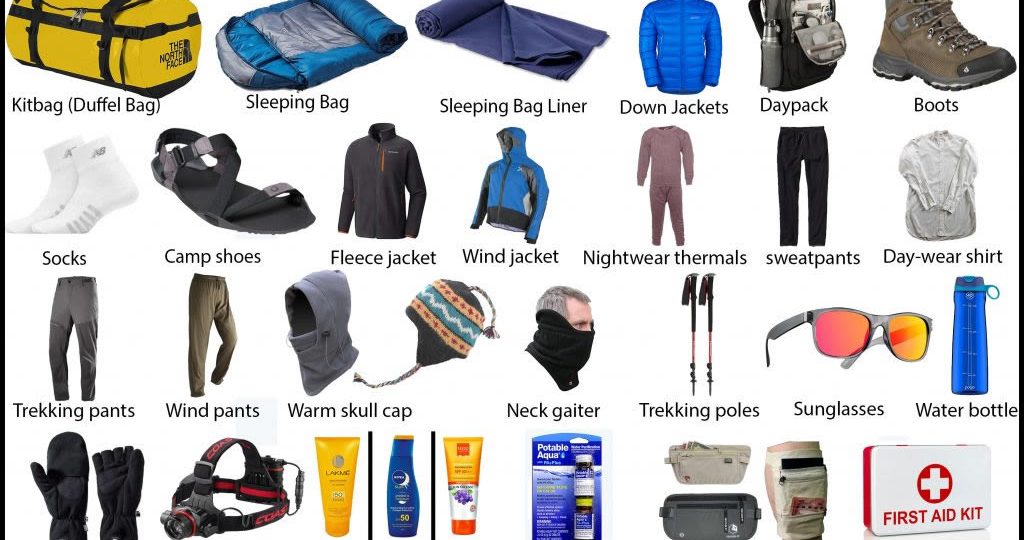
When you plan a trek to Nepal, the time of year you trek will impact your Nepal trekking packing list. Why is it important to pack only the essential items? You may be tempted to pack for all eventualities, but our advice is to pack light. Carting a heavy luggage along steep mountain trails would ruin your holiday, even though your porter may be carrying most of the weight.
What to Pack for Trekking in Nepal: Packing list for Trekking
Packing to go trekking in Nepal can be a daunting task and even more so if this will be your first trek in Nepal, and so you really don’t have much idea what to expect. When packing to go trekking in Nepal the tendency can be to pack for all eventualities. In an ideal world this would be the right approach. However, there’s one key aspect that means that packing everything you might need and the kitchen sink is probably not a wise idea.
You or a porter will have to carry all that dead weight up and down steep mountain trails for days on end. And nothing will ruin a Nepalese trek like carting an overloaded, heavy pack around. So, the number one rule to keep in mind when making a packing list for a Nepalese trek is: pack light!
When you make your Nepalese trek packing list there are a few things you should consider:
Are you on an organised or fully independent trek?
On an organised group trek there might be a per person weight/baggage limit. On a fully independent trek things boil down to what you can comfortably carry. Our suggestion is to keep your bag to a maximum weight of 15kg. Also, if you’re going to fly to a trail head be aware that most internal flights in Nepal have strict baggage weight limits and these can be as little as 15kg for hold luggage.
Will you hire a porter?
We would always suggest hiring a porter. Not just does it provide income to the local community, but it means that you can skip daintily over the Alpine flower meadows carrying just the minimum of gear for the day ahead (water, a jumper and rain jacket, a snack and a camera) while a porter shoulders the load.
There’s no doubt about it, porters are tough and you will likely see porters carrying a couple of large, heavy gas canisters and a big bag of other supplies heading to remote trekking lodges with nothing on their feet but a pair of flip-flops. However, tough as they are, there’s normally a baggage weight limit per porter of 30kg.
You should also ensure that each porter is well-kitted out clothing wise – and provided with adequate food and accommodation. Porters have died after being left out in the elements with insufficient clothing and food.
Where will you be Trekking?
Where you go trekking will have a big impact on what – and how much – you have to pack for your trek in Nepal. If you’re doing a popular, lower altitude (and therefore warmer) trek with good trekking lodges (teahouses) all along the route then you can get away with carrying much less than if you’re doing a higher altitude, longer and remote trek with far fewer facilities.
On a lower altitude trek with plenty of trekking lodges you can bring a thinner, lighter jacket and sleeping bag and you could leave your gloves, woolly hat and thermals at home.
If you’re on a remoter, higher trek, then you will need to carry a lot more equipment and, because many Nepalese treks take you into both hot and steamy lowland valleys and over cold, bleak high altitude passes, you’ll need clothing and equipment for a far greater array of conditions.
You might also need full camping and cooking equipment. This will be considerably more than you can carry alone and so you will need one or more porters, plus all the equipment and food that they might require.
When will you be Trekking?
Whether you’re doing a lower altitude trek or blazing across high altitude passes, the time of year you trek will likely impact your Nepalese trekking packing list.
Put simply, trekking in December through to February is going to be cold no matter where you trek and you will need thicker, heavier clothes to cope. Trekking in May and early June, when temperatures in Nepal are at their highest, means that even at 5,000m it doesn’t get quite as cold as you might imagine (Though don’t bother to pack a bikini. You’ll still need a thick mountain jacket, thermals, fleece, gloves and hat. It’s just that you won’t need to wear several fleeces at the same time!). In the main October-November and March-April trekking season then you’ll need to be prepared for serious cold up high and hot days at lower altitudes.
No matter where, when or how you’re going to trek there are a few items that are near enough essential to pack for a Nepalese trek.
1. Hiking boots: You’ll need boots and not hiking or trail running boots. Make sure they’re waterproof, very sturdy and above all, comfortable.
Don’t buy a cheap pair and make sure you break them in at home before travelling to Nepal. It’s possible to rent (or buy) hiking boots in Kathmandu and Pokhara, but we’d advise against this because the quality might not be up to scratch and poor fitting boots will give you blisters.
And few things can ruin a trek like a big fat blister or three. Also, while we are on the subject of boots and blisters. Bring a roll of Second Skin which is a thin sticking plaster like material that helps prevent and heal blisters.
2. Winter jacket: A thick, warm, waterproof, breathable, but lightweight jacket is another must. It should keep you toasty in sub-zero temperatures. These can easily be rented in Nepal but most are inferior quality knock-offs of respected mountain brands. Even so, if this is your first high altitude trek then you can probably get away with using one of these rented jackets.
If you’re likely to do a lot of mountain trekking then it makes sense to buy a high quality jacket.
3. Sleeping bag: It gets bitterly cold at night, even at low altitudes in winter (don’t be surprised if the hills surrounding Kathmandu receive a dusting of snow in December and January), and the thin, gap riddled walls of trekking lodge bedrooms provide little protection.
As with jackets, get the warmest yet lightest one you can afford. Remember that when a bag manufacturer says a sleeping bag can be used down to minus ten degrees the reality is you won’t be comfortable in it below about plus five.
If you’re going to be sleeping at high altitude then aim for one that says it will keep you warm down to minus twenty or lower. A really good sleeping bag is an expensive bit of kit and bags can be rented in Nepal.
As with jackets they’re very rarely of good quality, but they will be sufficient for lodge based treks at warmer times of year or at lower altitudes.
4. Water bottle: Take two bottles of at least a litre each and refill whenever possible. Don’t rely on bottles of mineral water. It’s often not available and at the best of times it’s environmentally unfriendly, but up in the mountains where there’s little chance of recycling it’s even worse.
5. Water purification system: You can either use water purification tablets (get enough to treat at least three litres of water a day) or, better, invest in one of the growing number of water purification systems. We strongly recommend the LifeStraw system (get the straw and the corresponding bottle), which allows you to drink water instantly and is very effective at cleaning the water.
On more popular trekking routes some lodges provide pre-treated water but don’t rely on always getting this.
6. Thermals: Two or three thermal tops of different thickness and even a pair of thermal under trousers are worth their weight in gold for colder routes and even on lower altitude treks you’ll probably find yourself using a thermal top at night.
7. Fleeces: Two fleeces, one thin and one thick, are a vital bit of kit for a Nepalese trek.
8. Walking trousers: Don’t try and skip round the Annapurna Circuit in a pair of jeans (yes, we’ve seen trekkers try). Get some comfortable walking trousers. Two pairs should be sufficient for the longest treks.
9. T-shirts/shirts: Many people recommend specialist quick dry shirts designed for trekking. Don’t go overboard with the number of them that you pack because the truth is you likely won’t change your shirt more than once in a two week trek (or perhaps that’s just us…)!
10. Socks: Specialist hiking socks are supposed to reduce blisters and are worth purchasing. However, you should always change your socks frequently (even if you don’t change your t-shirt!) as this seems to reduce blisters as much as any clever equipment. Take at least 3 pairs for a two week trek. Also pack a thick, warm pair of ski socks to keep your toes warm when you arrive at camp.
11. Sandals: Most people appreciate being able to remove their boots at the end of the day and put on some sandals (with or without thick ski socks depending on how cold it is).
12. Hats: A sun hat is vital for hotter, lower elevations and a winter hat or balaclava for up high.
13. Gloves: Take a thick warm pair of skiing gloves and a thin, cotton pair of under gloves. You won’t be able to press the shutter button on your camera or eat properly wearing a pair of thick gloves, but you can with the thin gloves and they’ll still keep your hands warm for a few minutes.
14. Sunglasses: An essential bit of kit at all elevations. The sun reflecting off the snow can quickly frazzle your eyes.
15. Sunscreen and sunblock: Slather lots of sun cream on no matter what the weather or elevation. Use total sun block on lips, nose and ears.
16. Trekking Poles: You might think that a set of trekking poles are the domain of creaky old people, but creaky old people are often wise old people and they know that a set of poles can be a god send. You can use them to help haul yourself up a steep slope and they ease the pain and chance of stumbling on sharp descents. Plus, when you’re not using them, you can wave them around like a sword while pretending to be a knight in armour.
17. Wash kit: Keep this minimal. You won’t get much chance to wash. A little light weight travel towel isn’t a bad idea.
18. Torch: A head torch and spare batteries is a must.
19. Book to read: The evenings can be long. Bring a good book (and not a tablet or Kindle as power sources can be erratic and batteries drain very fast at altitude).
20. Camera: Even non-photographers will want a memory of the stunning Nepalese scenery.
21. Spare batteries: Bring spare torch, camera and phone batteries. Below a certain temperature and above a certain altitude (all of which varies on the product) batteries drain very fast or simply don’t work at all.
Above about 3,000m put the batteries in your sleeping bag at night to keep them warm as this helps to reduce drainage.
22. Snacks: A few biscuits and chocolate bars might help give you that energy boost you need to get over that pass.
23. Backpack: To carry all this you will need a decent, comfortable trekking backpack (don’t contemplate trying to bring any other kind of bag). If you’re using a porter then you will need a small backpack for your day gear and you’ll have to provide a bag (a hold-all is best) for the porter to carry everything in.
24. Insurance: Easily forgotten, but perhaps the most important item of all is a decent, comprehensive travel insurance policy that covers trekking at altitude and in Nepal.
You should check these last two points carefully because many travel insurance policies do not cover trekking above 2,000-3,000m which is problematic in Nepal and some no longer insure people travelling to Nepal at all.
Things not to bother taking on a trek are computers, tablets and such like. They get easily broken on the trail and batteries tend not to work above a given altitude. And more to the point, most other people don’t want to see their fellow trekkers glued to their tablets in a trekking lodge at night.
Altitude and Temperature in Nepal
Naba Raj Amgai
Naba Raj Amgai, stepped into the world of travel and tourism in 1996.
Beginning his journey in the tourism industry as a humble Porter Guide to founding hospitality establishments and an adventure travel company, he has come a long way.
In a career spanning more than two decades he has achieved more than anybody dreams of achieving. Along with his professional achievements, his selfless contribution towards his community and society has won him a lot of accolades and praises.
Having dedicated more than two decades in the tourism and hospitality sector, he has amassed a wealth of experience.
After passing high school, he began helping out some trekking guides and was soon recruited as a porter guide at a reputed trekking agency. Within a short period of time he was individually guiding clients across the well-known trails of the Himalayas.
He went on to lead tour groups on multi-country tours to Nepal, Tibet, Bhutan and India. Being a part of mountain climbing expeditions familiarised him with expedition logistics and operations. Later on he went to become the Executive Director and took over the reins of Operations, Sales and Marketing departments. Spending several years in the tourism field has made Naba Raj Amgai a destination expert.
Travelling is his passion and he has been to many countries across the world – USA, Canada, Australia, Japan, Holland, Germany, Austria and many parts of Asia.
His journeys to different parts of the world have enriched his travel experience and knowledge. This experience has been instrumental in planning and organising successful trips for several clients.
As of today many reputed trekking agencies, hotels and restaurants are under his leadership. A dynamic and proactive leader, he continues to inspire and motivate people from all walks of life.
You may also like...
Everest base camp trek permit, 5 best mardi himal trek routes, best time to visit everest base camp trek, leave a reply cancel reply.
Your email address will not be published. Required fields are marked *
Save my name, email, and website in this browser for the next time I comment.
No recent searches!

- Quick Questions? Email Us
- Certificate of Excellence 2022
Everest Region Trekking
- Everest Base Camp Trek
- Everest Base Camp Trek with Helicopter Return
- Everest Base Camp Trekking
- Everest Base Camp Trek 14 Days
- Pikey Peak Trek
- Everest Panorama Trekking
- Gokyo Lakes Trek
- Everest Three Passes Trek
- Cheap Everest Base Camp Trek
- Short Everest Base Camp Trek
- Everest Base Camp Luxury Trek
Annapurna Region Trekking
- Annapurna Base Camp Heli Trek
- Annapurna Base Camp Trek
- Short Annapurna Base Camp Trek
- Poon Hill Trek
- Poon Hill trekking
- Mardi Himal Trek
- Annapurna Circuit Trekking
- Mohare Danda Trek
- Poon Hill Trek 4 Days
- Annapurna Base Camp Trek via Poon Hill
- Khopra Ridge Trekking
Langtang Region Trekking
- Langtang Valley Trekking
- Tamang Heritage Trekking
- Langtang Gosainkunda Trekking
Other Region Trekking
- Short Manaslu Circuit Trek
- Tiji Festival Trek
- Around Manaslu Circuit Trekking
- Manaslu Circuit Trekking
- Manaslu Circuit with Tsum Valley Trek
- Upper Mustang Trek
- Kalinchowk Trek
- Makalu High Pass Trek
- Balthali to Namobuddha Trekking
- Kanchenjunga Base Camp Trekking
- Kathmandu Valley Rim Trekking
- Everest Mountain Flight
- Luxury Tour in Nepal
- Jomsom Muktinath Photography Tour
- Best Tour in Nepal
- Everest Base Camp Private Helicopter Tour
- Jomsom Muktinath Tour
- Upper Mustang Photography Tour
- Langtang Heli Tour
- Everest Base Camp Helicopter Tour - Group Sharing
- Nepal Luxury Tour 9 Days
- Nepal Photography Tour
- Honeymoon Tour in Nepal
- Kathmandu Nepal Tour
- Rara Lake Helicopter Tour
- Patan and Bhaktapur Day Tour
- Namobuddha Hiking
- Kathmandu City Tour
- Nagarkot Hiking
- Dhampus Day Hiking
- Sarangkot Day Hiking
- Nagarkot Sunrise Day Tour
- Shivapuri Day Hiking
- Phulchowki Day Hiking
- Chandragiri Hills Day Tour
- Champadevi Hiking
- Family Holidays to Nepal
- Honeymoon Holidays to Nepal
- Luxury Holidays to Nepal
- Pilgrimage Holidays to Nepal
- Island Peak Climbing
- Mera Peak Climbing
- Chulu East Peak Climbing
- Dhampus Peak Climbing
- Lobuche East Peak Climbing
- Mardi Himal Climbing
- Pisang Peak Climbing
- Yala Peak Climbing
- Tour in Tibet
- Shishapangma Base Camp Trek
- Best Bhutan Tour
- Bhutan Cultural Tour
- Bhutan Short Cultural Tour
- Jomolhari Trekking
- Geography of Nepal
- Foods and Cuisines
- People Language and Culture
- Vehicle Hiring and Airline Ticketing
- Embassies and Consulates
- Altitude Sickness
- Trekking Equipment
- Trekking Guide and Porter
- Trekking Seasons in Nepal
- Responsible Tourism
- Translator on Hire
- Tourist Visa In Nepal
- Our Services
- How Can I Book
- Why Travel With Us
- Terms and Conditions
- Data of European citizen and GDPR
- Media Partners
Three Passes Trek Packing List
- Feb 6th 2024
- Nepal Travel Blog
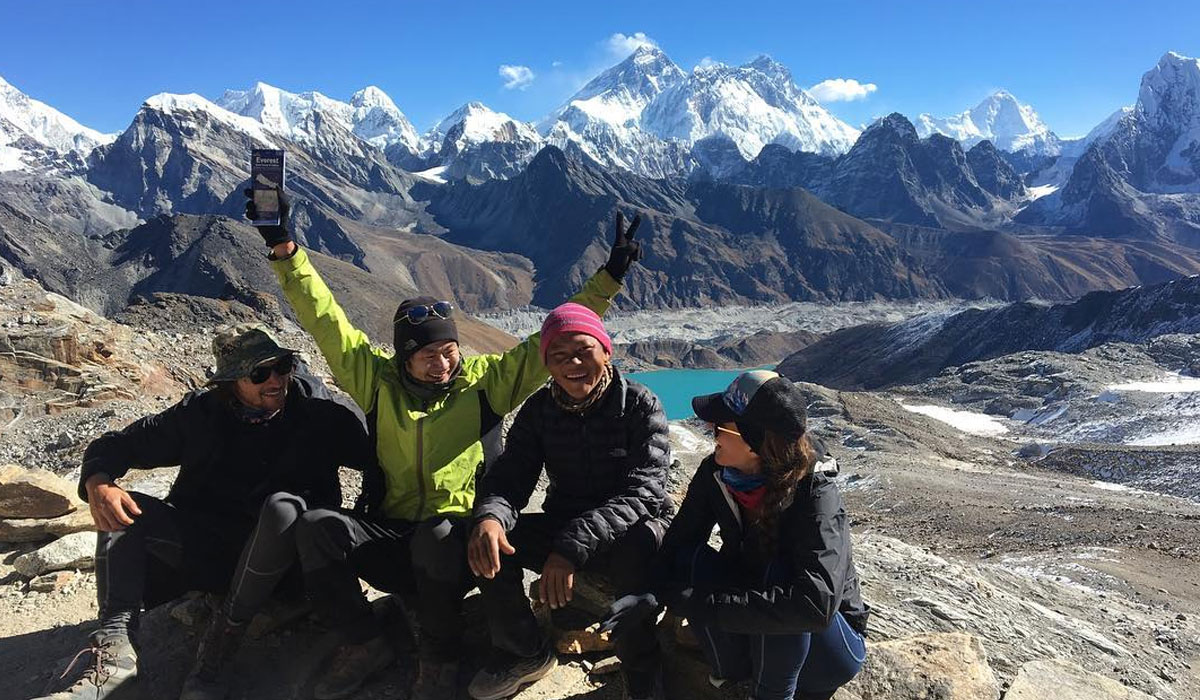
Everest Three Pass Trek is undoubtedly one of the most thrilling trekking experiences in the Khumbu region. This incredible trekking adventure explores three of the highest passes in the Himalayas: Kongma La Pass [5,535 meters/ 18,159 feet], Cho La Pass [5,420 meters/ 17,782 feet], and Renjo La Pass [5,340 meters/ 17,520 feet].
Designed especially for trekking enthusiasts who are looking for a bit of more challenging Himalayan adventure distinctive to the regular base camp and circuit treks, this exploration takes you over the three of the most iconic passes of the Himalayas in 5,000-meter class.
Although, these passes are in th e 5,000-meter class, all of them are situated over the altitude of 5,300 meters from the sea level. Taking on these Himalayan isn’t any less exciting than an alpine mountain expedition.
So, if you are taking on such high-altitude passes of the Himalayas that are situated in the alpine altitudes, what should you pack for the journey? The Three Passes Trek packing list is slightly more comprehensive than other regular explorations in the Himalayas.
As you will trek across diverse climatic regions from tropical, subtropical, temperate, sub-alpine, and alpine, you will need to pack appropriate layers and gear to enjoy a comfortable trekking experience.
Here, we have created an appropriate Three Passes Trek packing list that covers the packing suggestions from clothing, and footwear to personal hygiene and most essential gear.
Essential Three Passes Trek Packing List

Generally, the clothing can be distributed into three layers: base layers, mid-layer, and outer/protective layer. You can take reference from the same layer packing suggestion and decide on the appropriate wear for your adventure.
Base Layer Clothing
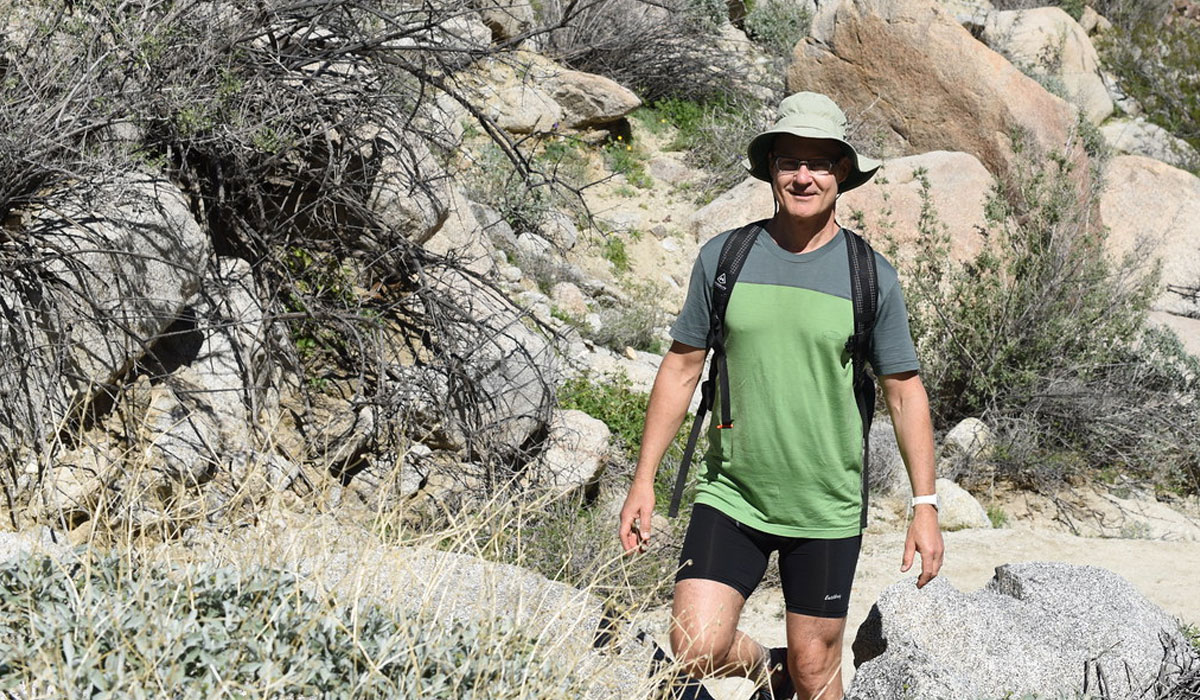
The base layers are the closest clothes to your skin and pretty much of second skin of your body. These layers are very significant components of your packing list as they act as the insulating layer against the cold and moisture-wicking elements in hot temperatures.
So, you should consider packing the right base layers for every type of climatic condition that you have to face during your trek. Packing light moisture-wicking layers for the lower trekking regions and warmer-insulated layers for the alpine altitudes is the most efficient way to manage the Three Passes Trek packing list.
Base Layer Packing Suggestions
- Short sleeve t-shirt
- Long sleeve t-shirt
- Sleeveless t-shirt
- Moisture wicking layers
- Lightweight base layer top
- Thermal vest
- Different layers of undergarments
- Lightweight socks
- Thermal socks, woolen socks
- Cowls, scarf
Mid-Layer Clothing
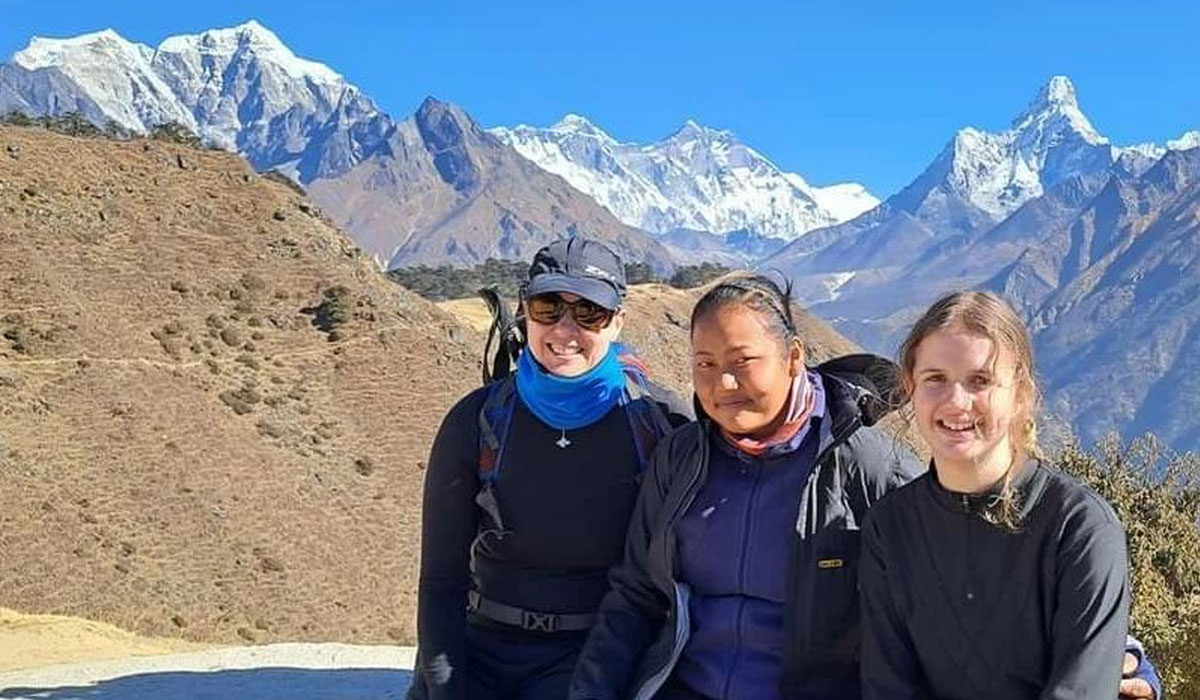
Mid-layer clothes are the second layers that you wear above the base layer. These layers provide additional insulation between your outer layer and base layer. Mid-layers are very important during outdoor adventures, especially for high-altitude treks.
You will be able to regulate your body temperature with the help of the mid-layers. These layers will easily adapt to the different climatic zones, and you can adjust the appropriate level of warmth when needed and enhance the breathability when the temperatures are warmer.
You can’t simply miss these layers in your Three Passes Trek packing list, as the mid-layer provides optimum balance between the base layers and outer layers. Missing out these layers will mean that you will struggle to find a balance between base layers and heavy outer layers.
Mid-Layer Packing Suggestions
- Fleece jacket
- Insulated vest
- Wool sweater
- Fleece neck warmer
- Insulated flannel shirt
- Insulated leggings or pants
- Battery-powered heating clothes
- Softshell hoodie
- Hybrid softshell jacket
- Hand warmer
- Insulated gaiters
Outer/ Protective Layer

Outer layers are one of the significant layers that shelter your body from external elements. These layers act as protective layers to shelter your body from different unfavorable elements that could affect your body, like snow, rain, wind, and cold temperatures.
This is one of the significant layers in your Three Passes Trek packing list, as you will be traversing across three of the major Himalayan passes in alpine altitudes. So, you will need the appropriate outer layers to protect your body from cold and freezing high-altitude temperatures.
Worn over the mid-layers, these protective layers serve as the first line of defense against any unfavorable climatic conditions that could do harm to your body. If you have a reliable outer layer, then you can immerse in this iconic experience without worrying about the climatic conditions.
- Waterproof/windproof jacket
- Softshell jacket
- Windbreaker
- Rain poncho
- Waterproof gaiters
- Waterproof/windproof trousers
- Down jacket (for minus degree)
- Insulated parka
- Waterproof breathable hat
- Shell gloves

After discussing the appropriate layers of clothing for the Three Passes Trek packing list, let’s move on to what footwear you should bring during your trek.
Trekking Boots
This is one of the most crucial elements of your packing list for this high-altitude trek. As you will trek across the diverse landscapes on rugged trails and also take on the high Himalayan passes at the alpine altitudes, you should get the most comfortable trekking boots.
While searching for the boots, look for the features like insulation, waterproofing, traction, and breathability. You should look for all-in-one features, as carrying multiple boots makes your luggage heavier. After buying, make sure to break-in first before taking it for the trek.
Sport Shoes or Trainer Shoes
Besides the trekking boos, you should also a pair of sports or trainer shoes. Trekking boots are heavier in nature and are not that convenient when you have to take them off often. So, include a pair of sports shoes in your packing list, and you will be able to walk around more comfortably during your acclimatization days or while doing short hikes around the region.
Make sure your shoes have ankle support; it will be best if the shoes have excellent grip and traction. Then, you will be able to easily maneuver around even the steep and rugged sections along the trekking trails.
Sandals or Crocs
After a long day of tiring journey, you definitely want to get a comfortable rest at the stop points along your trekking route. But, the relaxation won’t be that much of comfort in your sports or trekking boots, so in order to give your feet a breather after a long day walk, you should also include sandals or crocs, whichever you are comfortable with in your Three Passes Trek packing list.
These comfortable footwears will come in handy during the acclimatization points and when you have to cross the streams along your exploration route. By giving your feet a chance to dry and breathe, you will also be able to prevent fungal infections and bad foot odor.
Ankle Support
During the long haul of trekking, ankle support can be a very beneficial element as it enhances stability and prevents any kind of ankle injury. This is a must-have, especially when you are trekking on uneven rugged trails.
This efficient footwear will evenly distribute the weight and pressure so you can enjoy an overall stable trekking experience with confidence.
You may also like:
- Three Passes Trek Difficulty
- Packing List For Everest Base Camp Trek
- The Ultimate Packing List for Trekking in Nepal
Personal Hygiene

This exciting Himalayan exploration will take you on an incredible journey to the remote and isolated part of the Himalayas. Although the Everest region is a mainstream trekking hub, you may often struggle to find the hygiene products that you prefer at the teahouses en route.
So, the best thing you can do to prevent discomfort during the trek is to pack all the hygiene products that you need and, of course, at sufficient volume.
Basic Hygiene Products
In this category, you should pack all the basic hygiene products that you use pretty much in your daily life. For instance, toothbrushes, toothpaste, soap, shampoo, etc. should be in limited quantities so they can last throughout the trek.
Hand Sanitizer and Insect Repellent
When you are on a long journey, your hygiene should be your top priority, especially when you are trekking in remote regions with a limited number of health facilities. If you don’t take care of your basic sanitation, there are risks of you getting sick along the trekking route.
So, you should follow proper sanitization procedures before meals and after using the bathroom. Insect repellents, on the other hand, make your trekking experience more enjoyable as they keep the annoying bugs away if you are trekking in the warmer seasons.
Sunscreen and Lip Balm
Your Three Pass Trek will take you to the high elevation points above 5,000 meters. Thus, you need to take proper care of your skin as you rise to the higher altitudes. The high-altitude regions in this trek have high exposure to the sun, which puts you at risk of sunburn if you don’t take care of your skin.
As you ascend to the alpine altitudes, which are generally cold, you might expect that you may not require sunscreen cream. However, it is the exact opposite; as you ascend higher, the rays of the sun are harsher, despite being the alpine altitudes.
You also need to pack body lotion and lip balm to protect your skin from cold. So, make sure you are totally prepared in the self-care department for this trip.
Toilet Paper
During your trek to the remote high-altitude points of the Himalayas, what you need to understand is that the bathroom facilities are not as developed as in the Western world. Although the teahouses in the lower regions do have modern-style bathrooms, the teahouses in higher regions use traditional bathrooms.
That means the flush system, as well as the toilet paper, are not available in the bathrooms at the higher points. You can buy toilet paper at the teahouses along the route; just make sure to restock enough when you enter the areas with less developed teahouses.
First Aid and Personal Medication
It is important to have basic first aid knowledge when you are taking part in a long adventure. You should familiarize yourself with the basic medications and their functions so you can take care of yourself or anyone in your group in case of injury or sickness.
Even though your guide will carry the first-aid box, it will be wise if you carry a small kit box by yourself as well. Also, if you are using any kind of personal medications, you should bring them in quantities that will last throughout the trek.
It is also a good idea to include medicines in your Three Passes Trek packing list to prevent altitude sickness , as you will take on three of the major passes in the Himalayan region.
Equipment/Gear for Three passes trek
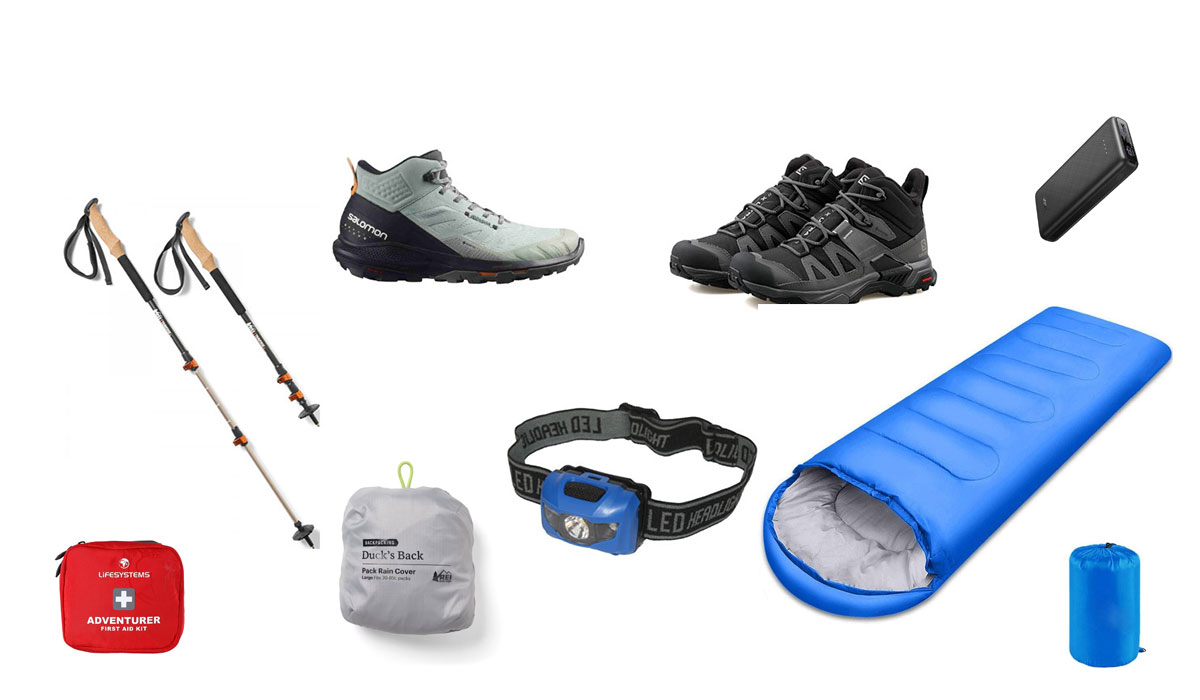
Packing the right gear for your high-altitude adventures will ensure comfort and safety. You should consider packing the appropriate gear and gadgets that enhance this Three Pass Trekking experience.
Trekking Poles
Trekking poles are a must when it comes to long trekking adventures; these stable poles improve your stability and help you find balance as you move across rough and rugged terrains. Using the trekking poles is also known to distribute the workload evenly across your upper body, so you will be able to trek longer distances with less effort.
Their versatility, especially at ascending and descending trails, will enhance the safety of the trekkers and make it easier to maneuver around the obstacles along the route. Another major benefit of using trekking poles during high-altitude treks is that it reduce the impact on the joints, so you can enjoy an immersive experience.
Sleeping Bag
The trekking adventures in Nepal are teahouses-based, it means that the teahouses/lodges along the trekking trail will take care of your food and accommodation facilities. Although, you will stay in warm, cozy rooms and receive pillows, mattresses, and blankets, you are still recommended to pack sleeping bags or sleeping pads.
You are recommended to bring a sleeping bag rated for 0°F (-18°C) or lower in order to ensure warmth and comfort during the cold nights. This gear will insulate you from the cold, and you can get a good rest even at the alpine altitudes.
Your Everest Three Pass trek will take you to the secluded high-altitude regions where the hydroelectricity line doesn’t reach. So, most part of the high altitude regions in this trek are solar-power reliant. That means, you will have to pay extra cost for charging gadgets at the higher points.
It will be best if you bring a power bank and solar charger with you. This way, you won’t have to pay a high cost for charging all your devices, and neither will you have to wait for your turn to charge.
Basic Adventurer Kit
As you embark on a remarkable journey, you should carry the appropriate equipment that will make your exploration exciting and enjoyable. For instance, you shouldn’t miss the cameras, which will help you to capture the iconic sighting and memories.
Similarly, binoculars will enhance the overall adventurer spirit, especially when there is an opportunity for rare sightseeing of the Himalayan wildlife and birdlife. But, what you really shouldn’t miss out on is the navigational adventurer gear like a map, compass, and GPS.
These navigational gears will make it easy for you to pinpoint your location and understand the geography. Also, add the guidebook to the list; you will have enough time to learn more about your destinations during each day of your trip.
Rain Cover and Packing Sack
It is important to protect your luggage while trekking in a region where the climatic conditions can be unpredictable. So, you should get quality protective rain covers to cover your luggage during the trek.
You should also adhere to the packing sack technique for your Three Passes Trek packing list. By organizing the luggage in different sacks, you will be able to optimize the available space and will be able to easily identify the content inside the sacks thanks to different color coding.
But What About Cash?
Although the Three Pass Trek takes place in one of the mainstream trekking regions in Nepal, we recommend you to bring enough cash converted to local currency. There are only a few numbers of ATMs available on this trekking route, and they are not always reliable.
So, to avoid any kind of inconvenience, you should consider carrying enough cash for the trek and converting it to local currencies in the city areas. If you plan to change the currency as you move along the trail, you might not always get a fair exchange rate.
Although your trekking package will take care of all standard fooding and lodging facilities, you will have to pay for the personal natured expenses by yourself. For instance, the cost of snacks, refreshments, laundry, hot shower, charging, etc, are not included in your package.
You might also want to buy authentic souvenirs along your trekking route, so consider that, too, when carrying the money. In an average estimation, you will spend approximately US$ 30 to US$ 50 during each day of your trek.
Can You Buy Trekking Gear in Kathmandu?

If you want to buy trekking gear in Kathmandu, you will have various options to choose from. In Kathmandu, especially in Thamel, where most of the travel agencies are based on, you will find every kind of trekking gear and clothing.
The best thing about getting the equipment from Kathmandu is that you don’t have to particularly buy it. There are also several rental shops that will provide you with all sorts of gear and trekking clothes necessary for the adventure.
You will have to pay around US$ 2 to US$ 5 per day for renting the gear or trekking clothes at these shops. In case, if you want to buy, make sure that you are buying authentic products and not high copies. You will be able to get the basic level of clothes to trekking layers for about US$ 10 to US$ 80 . However, gears can be slightly expensive and cost upto US$ 300 depending on the build and brand.
Share this article
- Manaslu Round Trek
- How Hard is the Gokyo Lake Trek?
Drop us a message
US House passes $95 billion Ukraine, Israel aid package, sends to Senate
- Medium Text
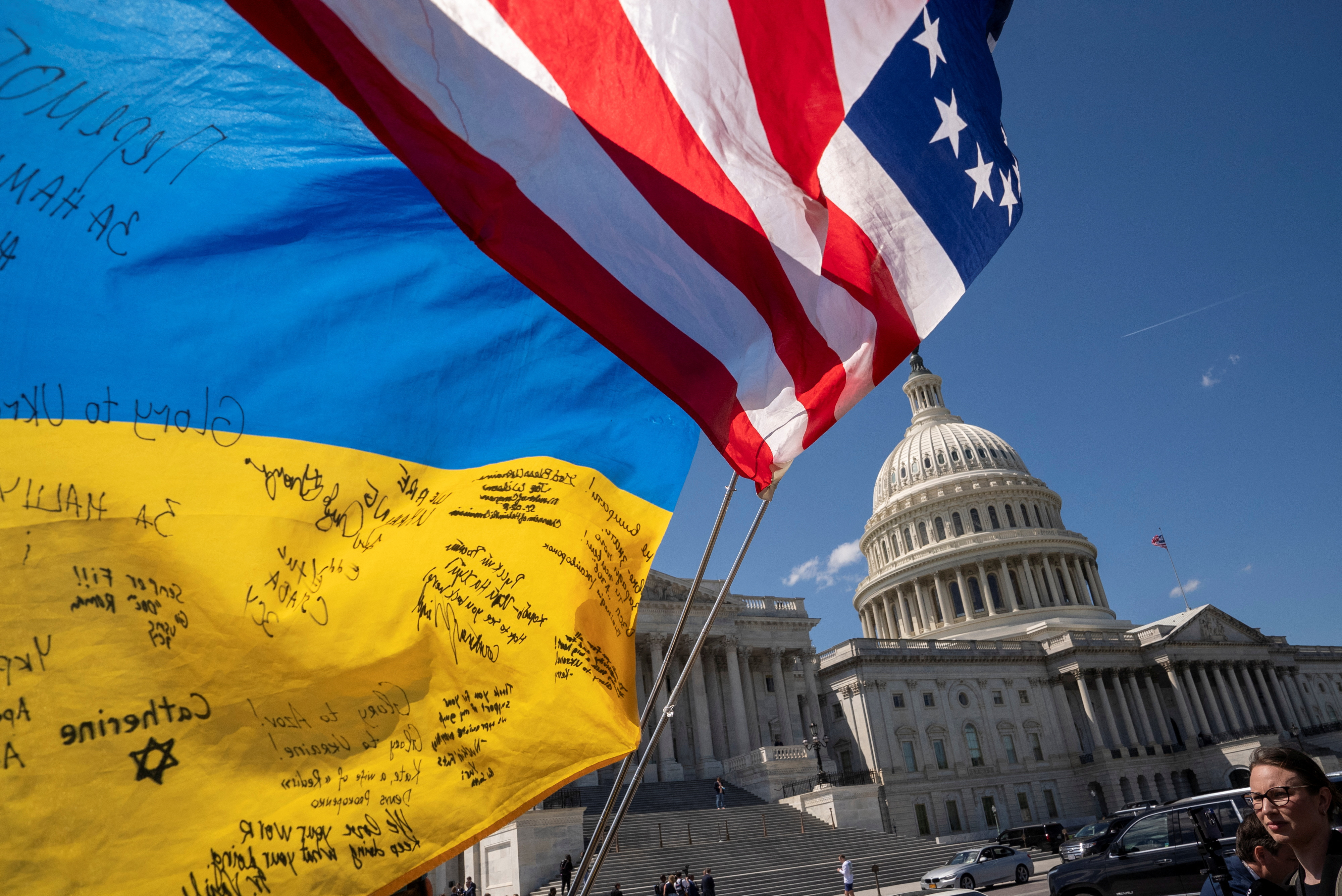
Sign up here.
Reporting by Patricia Zengerle and Richard Cowan; Additional reporting by Moira Warburton and Andrea Shalal in Wilmington; Editing by Scott Malone, Jonathan Oatis, Daniel Wallis and Michael Perry
Our Standards: The Thomson Reuters Trust Principles. New Tab , opens new tab

Thomson Reuters
Patricia Zengerle has reported from more than 20 countries, including Afghanistan, Iraq, Pakistan, Saudi Arabia and China. An award-winning Washington-based national security and foreign policy reporter who also has worked as an editor, Patricia has appeared on NPR, C-Span and other programs, spoken at the National Press Club and attended the Hoover Institution Media Roundtable. She is a recipient of the Edwin M. Hood Award for Diplomatic Correspondence.
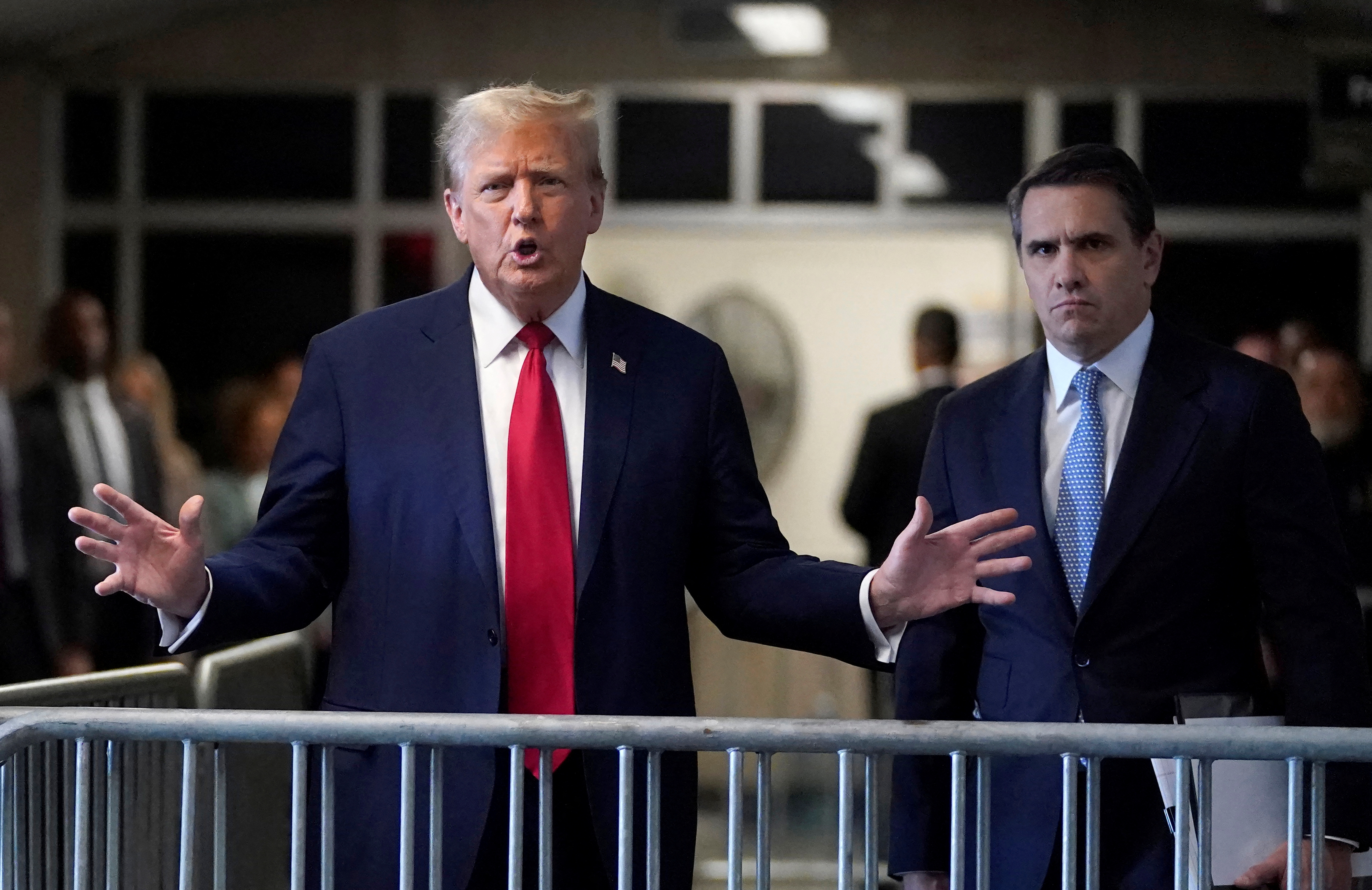
World Chevron

Argentina's Milei faces biggest protest yet as students march over budget cuts
Hundreds of thousands of Argentines took to the streets of Buenos Aires on Tuesday in an anti-government march against budget cuts to public universities, the biggest protest yet against President Javier Milei's painful austerity measures.
The United States has preliminarily discussed sanctions on some Chinese banks but does not yet have a plan to implement such measures, a U.S. official told Reuters on Tuesday, as Washington seeks ways to curb Beijing's support for Russia.
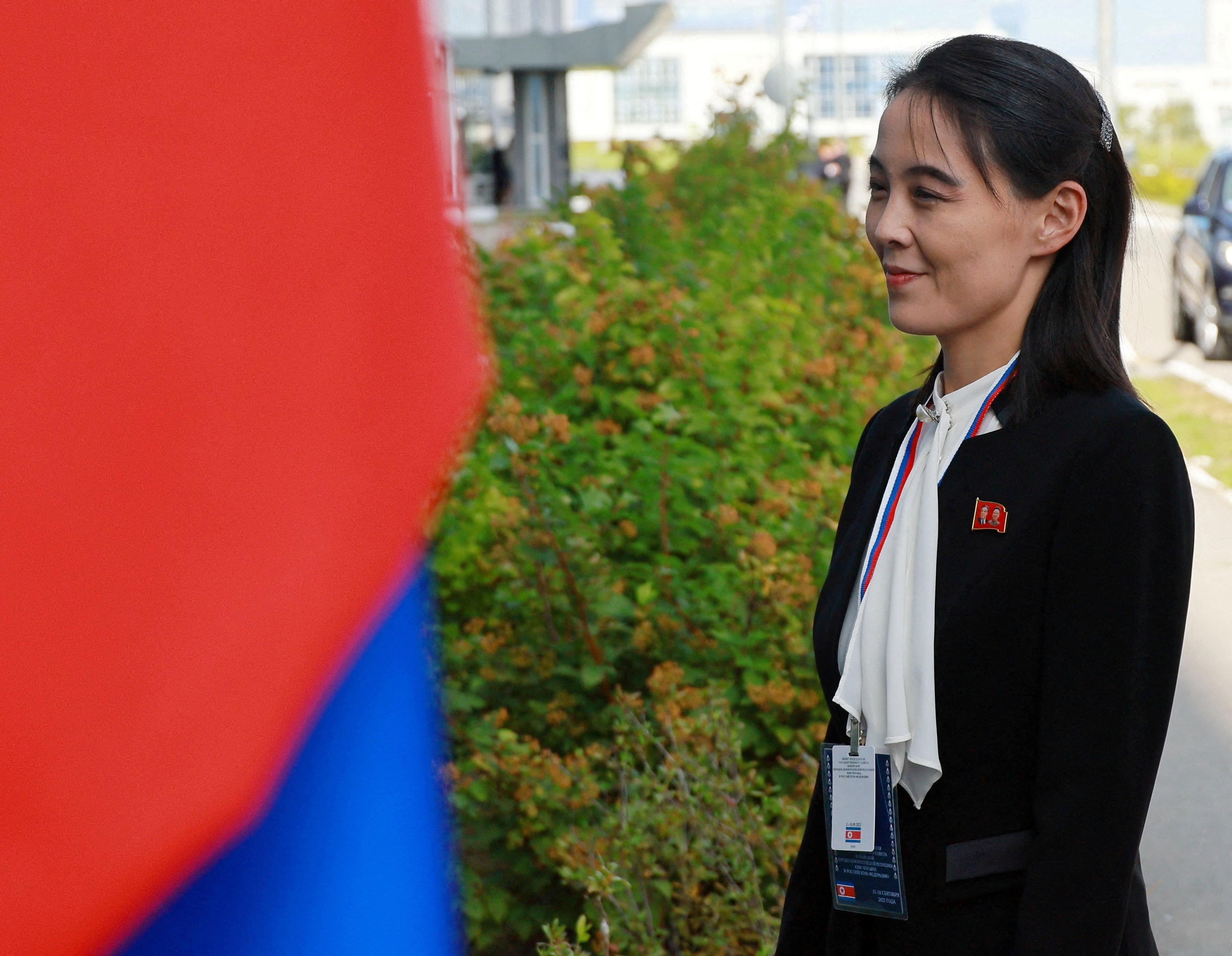
Advertisement
Supported by
House Approves $95 Billion Aid Bill for Ukraine, Israel and Taiwan
After months of delay at the hands of a bloc of ultraconservative Republicans, the package drew overwhelming bipartisan support, reflecting broad consensus.
- Share full article

By Catie Edmondson
Reporting from the Capitol
The House voted resoundingly on Saturday to approve $95 billion in foreign aid for Ukraine, Israel and Taiwan, as Speaker Mike Johnson put his job on the line to advance the long-stalled aid package by marshaling support from mainstream Republicans and Democrats.
In four back-to-back votes, overwhelming bipartisan coalitions of lawmakers approved fresh rounds of funding for the three U.S. allies, as well as another bill meant to sweeten the deal for conservatives that could result in a nationwide ban of TikTok.
The scene on the House floor reflected both the broad support in Congress for continuing to help the Ukrainian military beat back Russia, and the extraordinary political risk taken by Mr. Johnson to defy the anti-interventionist wing of his party who had sought to thwart the measure. Minutes before the vote on assistance for Kyiv, Democrats began to wave small Ukrainian flags on the House floor, as hard-right Republicans jeered.
The legislation includes $60 billion for Kyiv; $26 billion for Israel and humanitarian aid for civilians in conflict zones, including Gaza; and $8 billion for the Indo-Pacific region. It would direct the president to seek repayment from the Ukrainian government of $10 billion in economic assistance, a concept supported by former President Donald J. Trump, who had pushed for any aid to Kyiv to be in the form of a loan. But it also would allow the president to forgive those loans starting in 2026.
It also contained a measure to help pave the way to selling off frozen Russian sovereign assets to help fund the Ukrainian war effort, and a new round of sanctions on Iran. The Senate is expected to pass the legislation as early as Tuesday and send it to President Biden’s desk, capping its tortured journey through Congress.
“Our adversaries are working together to undermine our Western values and demean our democracy,” Representative Michael McCaul, Republican of Texas and the chairman of the Foreign Affairs Committee, said Saturday as the House debated the measure. “We cannot be afraid at this moment. We have to do what’s right. Evil is on the march. History is calling and now is the time to act.”
“History will judge us by our actions here today,” he continued. “As we deliberate on this vote, you have to ask yourself this question: ‘Am I Chamberlain or Churchill?’”
The vote was 311 to 112 in favor of the aid to Ukraine, with a majority of Republicans — 112 — voting against it and one, Representative Dan Meuser of Pennsylvania, voting “present.” The House approved assistance to Israel 366 to 58; and to Taiwan 385 to 34, with Representative Rashida Tlaib, Democrat of Michigan, voting “present.” The bill to impose sanctions on Iran and require the sale of TikTok by its Chinese owner or ban the app in the United States passed 360 to 58.
“Today, members of both parties in the House voted to advance our national security interests and send a clear message about the power of American leadership on the world stage,” Mr. Biden said. “At this critical inflection point, they came together to answer history’s call, passing urgently needed national security legislation that I have fought for months to secure.”
Minutes after the vote, President Volodymyr Zelensky of Ukraine thanked lawmakers, singling out Mr. Johnson by name “for the decision that keeps history on the right track.”
“Democracy and freedom will always have global significance and will never fail as long as America helps to protect it,” he wrote on social media. “The vital U.S. aid bill passed today by the House will keep the war from expanding, save thousands and thousands of lives, and help both of our nations to become stronger.”
Outside the Capitol, a jubilant crowd waved Ukrainian flags and chanted, “Thank you U.S.A.” as exiting lawmakers gave them a thumbs-up and waved smaller flags of their own.
For months, it had been uncertain whether Congress would approve new funding for Ukraine, even as momentum shifted in Moscow’s favor. That prompted a wave of anxiety in Kyiv and in Europe that the United States, the single biggest provider of military aid to Ukraine, would turn its back on the young democracy.
And it raised questions about whether the political turmoil that has roiled the United States had effectively destroyed what has long been a strong bipartisan consensus in favor of projecting American values around the world. The last time the Congress approved a major tranche of funding to Ukraine was in 2022, before Republicans took control of the House.
With an “America First” sentiment gripping the party’s voter base, led by Mr. Trump, Republicans dug in last year against another aid package for Kyiv, saying the matter should not even be considered unless Mr. Biden agreed to stringent anti-immigration measures. When Senate Democrats agreed earlier this year to legislation that paired the aid with stiffer border enforcement provisions, Mr. Trump denounced it and Republicans rejected it out of hand.
But after the Senate passed its own $95 billion emergency aid legislation for Ukraine, Israel and Taiwan without any immigration measures, Mr. Johnson began — first privately, then loudly — telling allies that he would ensure the U.S. would send aid to Kyiv.
In the end, even in the face of an ouster threat from ultraconservative members, he circumvented the hard-line contingent of lawmakers that once was his political home and relied on Democrats to push the measure through. It was a remarkable turnabout for a right-wing lawmaker who voted repeatedly against aid to Ukraine as a rank-and-file member, and as recently as a couple of months ago declared he would never allow the matter to come to a vote until his party’s border demands were met.
In the days leading up to the vote, Mr. Johnson began forcefully making the case that it was Congress’s role to help Ukraine fend off the advances of an authoritarian. Warning that Russian forces could march through the Baltics and Poland if Ukraine falls, Mr. Johnson said he had made the decision to advance aid to Kyiv because he “would rather send bullets to Ukraine than American boys.”
“I think this is an important moment and important opportunity to make that decision,” Mr. Johnson told reporters at the Capitol after the votes. “I think we did our work here and I think history will judge it well.”
Mr. Johnson structured the measures, which were sent to the Senate as one bill, to capture different coalitions of support without allowing opposition to any one element to defeat the whole thing.
“I’m going to allow an opportunity for every single member of the House to vote their conscience and their will,” he had said.
In a nod to right-wing demands, Mr. Johnson allowed a vote just before the foreign aid bills on a stringent border enforcement measure, but it was defeated after failing to reach the two-thirds majority needed for passage. And the speaker refused to link the immigration bill to the foreign aid package, knowing that would effectively kill the spending plan.
His decision to advance the package infuriated the ultraconservatives in his conference who accused Mr. Johnson of reneging on his promise not to allow a vote on foreign aid without first securing sweeping policy concessions on the southern border. It prompted two Republicans, Representatives Thomas Massie of Kentucky and Paul Gosar of Arizona to join a bid by Representative Marjorie Taylor Greene of Georgia to oust Mr. Johnson from the top job.
Ms. Greene claimed the Ukraine aid bill supported “a business model built on blood and murder and war in foreign countries.”
“We should be funding to build up our weapons and ammunition, not to send it over to foreign countries,” she said before her proposal to zero out the money for Kyiv failed on a vote of 351 to 71.
Much of the funding for Ukraine is earmarked to replenish U.S. stockpiles after shipping supplies to Kyiv.
Since Russia’s invasion in 2022, Congress has appropriated $113 billion in funding to support Ukraine’s war effort. $75 billion was directly allocated to the country for humanitarian, financial and military support, and another $38 billion in security assistance-related funding was spent largely in the United States, according to the Institute for Study of War , a Washington-based research group.
Hard-right Republican opposition to the legislation — both on the House floor and in the critical Rules panel — forced Mr. Johnson to rely on Democrats to push the legislation across the finish line.
“If Ukraine does not receive this support that it requires to defeat Russia’s outrageous assault on its sovereign territory, the legacy of this Congress will be the appeasement of a dictator, the destruction of an allied nation and a fractured Europe,” said Representative Rosa DeLauro of Connecticut, the top Democrat on the Appropriations Committee. “Gone will be our credibility, in the eyes of our allies and of our adversaries. And gone will be the America that promised to stand up for freedom, democracy, and human rights, wherever they are threatened or wherever they are under attack.”
Thirty-seven liberal Democrats opposed the $26 billion aid package for Israel because the legislation placed no conditions on how Israel could use American funding, as the death toll in Gaza has reached more than 33,000 and the threat of famine looms. That showed a notable dent in the longstanding ironclad bipartisan backing for Israel in Congress, but was a relatively small bloc of opposition given that left-wing lawmakers had pressed for a large “no” vote on the bill to send a message to Mr. Biden about the depth of opposition within his political coalition to his backing for Israel’s tactics in the war.
“Sending more weapons to the Netanyahu government will make the U.S. even more responsible for atrocities and the horrific humanitarian crisis in Gaza which is now in a season of famine,” said Representative Jonathan L. Jackson, Democrat of Illinois.
Carl Hulse , Annie Karni , and Kayla Guo contributed reporting from Washington and Marc Santora from Kyiv.
Catie Edmondson covers Congress for The Times. More about Catie Edmondson
Our Coverage of the War in Ukraine
News and Analysis
The authorities in Poland and Germany have arrested at least five of their citizens and accused them of spying for Russia or of offering to help Moscow commit violence on European soil, including a “possible attack” on the president of Ukraine, Volodymyr Zelensky.
The drone combat in Ukraine that is transforming modern warfare has begun taking a deadly toll on one of the most powerful symbols of American military might — the tank — and threatening to rewrite how it will be used in future conflicts.
At least 17 people were killed and scores more injured when three Russian missiles struck a busy downtown district of Chernihiv , north of Kyiv, Ukrainian officials said.
World Military Spending: The world spent more on military costs and weapons in 2023 than it had in 35 years, driven in part by the war in Ukraine and the threat of an expanded Russian invasion, according to an independent analysis.
New American Technology: Project Maven was meant to revolutionize modern warfare. But the conflict in Ukraine has underscored how difficult it is to get 21st-century data into 19th-century trenches.
Resuming U.S. Military Aid: Much-needed munitions like artillery shells could start arriving relatively quickly , but experts say it could take weeks before U.S. assistance has a direct impact on the war . What would $60 billion buy ?
How We Verify Our Reporting
Our team of visual journalists analyzes satellite images, photographs , videos and radio transmissions to independently confirm troop movements and other details.
We monitor and authenticate reports on social media, corroborating these with eyewitness accounts and interviews. Read more about our reporting efforts .

IMAGES
VIDEO
COMMENTS
Here are the list of footwears required for the trek: 3 Lightweight inner socks. 1 pair of Hiking boots with spare laces. 2 Heavy poly or wool socks. 3 pair of thin woolen lightweight socks. 2 pairs of heavy woolen socks. 1 pair of lightweight hiking boots (must get broken-in and water-resistant) A pair of sandals.
For all the items that you'll want to bring for the tea houses along the Three High Passes Trek. 1x Sleeping bag - you'll want at least a minus 15 Celcius rating. They sell very warm and lightweight down sleeping bags in Thamel cheaply. 1x Head Lamp. 1x Set of lightweight, fleece sleeping pants and top.
Personal care items are essential for maintaining hygiene and comfort during the Three Passes and Everest Base Camp trek. Here are some personal care items to include in your packing list: Toiletries: Pack travel-sized essentials such as toothbrush, toothpaste, soap, shampoo, and a small towel or washcloth.
We completed the EBC, Kalapathar, and the three passes trek without any guide or porter. We carried our belongings for the 16-day journey and managed to keep the backpack weighing about 5 Kg without water. So, if you plan to do the Everest Base Camp and the three passes trek, here's the complete packing list of items that you must carry ...
The packing list for the 3 Passes Trek should be dependent on the seasons of the journey. Autumn and spring are when trekking is most popular. The best part of the walk during these seasons is the consistent weather and clear skies. In addition, the area experiences moderate daytime temperatures and much less rainfall. So, you should bring the ...
THE ESSENTIAL GUIDE. In this guide we cover everything you need to know about the Everest Three Passes Trek in Nepal. This includes a suggested itinerary and practical information about accommodation, costs, what to pack, independent vs. guided treks, transport, and more. We also offer a route map with GPX download for use on the trek.
EVEREST THREE PASSES TREK ITINERARY. We have outlined below what we feel is an ideal itinerary for the Everest Three Passes trekking route. This is a 19 day itinerary which includes flying to and from Lukla. We have noted the trekking distance and an approximate trekking time for each day (excluding lunch stops, breaks, etc), as well as stats ...
Most tour operators will list the Three Passes Trek as an 18/19-day trek. Of these days, usually 15 will be spent trekking with a further 1 or 2 acclimatization days, meaning 14 days of actual trekking can be expected. ... The packing list for a trek of this length can look quite long! For this reason, we have dedicated an article to help you ...
Difficulty. Very Challenging. Accommodation. Teahouse. The Everest Region is one of Nepal's top trekking destinations, and the Three Passes Trek is its ultimate trekking adventure, crossing three passes over 5,000m, each offering amazing scenery and views. This trek was ranked the number 2 on kimkim's list of the best treks in Nepal .
CONTACT. Everest 3 Passes Trek Gear List. Nov 21. Written By Shawn. All the gear you need to solo hike the Everest 3 Passes Trek. You do not need to pack a lot of specialized gear to hike the Everest 3 Passes Trek. In fact if you're a regular in the outdoors, most of what you need you probably have lying around your house already.
Without further ado, let us explore the beauty of the three passes trek. Let us know everything there is to know about the three passes trek packing list. Let us embrace nature and what she has to offer. Trek details: Duration: 17 days. Start/end: Kathmandu/Kathmandu. Max altitude: 5643 (Kala Patthar) Difficulty: Challenging
Learn everything you need to know to prepare for the Three Passes Trek. Discover the basics, see the difficulty rating and use our list of tips.
Pro Tip:Go out and hike above the Bazaar for excellent views of Everest. Day 4. Namche Bazaar to Tengboche. Approximate Trek Time: 3 ½ - 4 ½ hrs. Distance: 9.2k / 5.7 miles. Overnight Elevation: 3870m / 12,696ft. Pro tip:The Tengboche monastery has open prayer sessions at 3pm that are worth going to.
Elevation Gain of the 3 Passes Trek: 35,771 feet / 10,900 meters (including day hikes) Duration: 4 - 10 hours per day (depending on fitness level) ... Himalayas Packing List. To have a successful Three Passes trek, you will need to come prepared with the right gear. Remember, this is an 18 day trek and it will very likely include some cold ...
THE THREE PASSES TREK & EBC INFORMATION GUIDE. INCLUDES PACKING LIST AND 12 HR JEEP RIDE FROM KATHMANDU TO SALLERIThe Three Passes Trek differs from the stan...
Home › Nepal › Everest Three Passes Trek. Nepal's Three Passes Trek is perhaps the greatest trekking adventure you can have in the Khumbu (Everest) region of Nepal. Also known as the Three High Passes, this loop trek wraps around Sagarmatha National Park, leading trekkers over the Khumbu passes of Kongma La at 5,550 m (18,209 ft), Cho La at 5,420 m (17,782 ft), and Renjo La at 5,360 m ...
The Three Passes Trek in Nepal is in the Everest Region (Sagarmatha National Park) and takes trekkers across three high passes, Kongma La (18,209 ft / 5,550 m), Cho La (17,782 ft / 5,420 m), and Renjo La (17,560 ft / 5,360 m) - hence, the Three Passes Trek. It's a lollipop loop that can be done starting at Lukla (that scary mountain airport ...
Everest Three Passes Trek is the ultimate trekking experience to conquer Mount Everest. It's the only three-pass trekking option on the world's highest peak and the only way to visit Everest Base Camp (5,364m) and Kalapatthar Summit (5,545m). The trek offers two stunning routes: Clockwise and anti-clockwise.
Day 08 : Trek to Chhukung (4,730 m) from Dingboche - 4 to 5 hours. Overnight at a guesthouse. Day 09 : Trek to Lobuche (4,910 m) via Cross Kongma La pass (5,535 m) - 7 to 8 hours. Overnight at a guesthouse. Day 10 : Trek to Everest Base Camp (5,364 m) and then back to Gorak Shep (5,164 m) - 8 to 9 hours.
1x Roll of toilet paper (bought another roll in Gokyo) 1x Disinfectant gel, 25ml. 2x Sunscreen Piz Buin SPF50, 50ml (one tube would have been enough) 1x Deodorant Borotalco, 45ml. 1x Body lotion Kneipp, 75ml. 1x Earplugs (Very important. The walls are extremely thin) various blister plasters Compeed.
Packing List For Three Passes Trek. Trekking boots (If new boots are purchased, "break them in" to avoid blisters) and spare laces; Hat (Warm), scarf and gloves; ... Is 3 Passes trek suitable for you? Traversing through Three passes above an elevation of 5,000 m is demanding. But if you have strong determination, previous trekking ...
Take at least 3 pairs for a two week trek. Also pack a thick, warm pair of ski socks to keep your toes warm when you arrive at camp. 11. Sandals: Most people appreciate being able to remove their boots at the end of the day and put on some sandals (with or without thick ski socks depending on how cold it is). 12.
Everest Three Pass Trek is undoubtedly one of the most thrilling trekking experiences in the Khumbu region. This incredible trekking adventure explores three of the highest passes in the Himalayas: Kongma La Pass [5,535 meters/ 18,159 feet], Cho La Pass [5,420 meters/ 17,782 feet], and Renjo La Pass [5,340 meters/ 17,520 feet]. Designed especially for trekking enthusiasts who are looking for a ...
The Clothes HD - Kids mod remasters all the clothing for children in both Fallout 3, and New Vegas, making use of 2K and 4K textures. Don't worry, other textures, like weapons, environments, and ...
US House passes $95 billion Ukraine, Israel aid package, sends to Senate. WASHINGTON, April 20 (Reuters) - The U.S. House of Representatives on Saturday with broad bipartisan support passed a $95 ...
Reporting from the Capitol. Published April 20, 2024 Updated April 21, 2024, 3:06 p.m. ET. The House voted resoundingly on Saturday to approve $95 billion in foreign aid for Ukraine, Israel and ...